

Montmartre Walking Tour: Self-Guided Walk of the 18th
By: Author Sophie Nadeau
Posted on Last updated: 23rd May 2023
Categories Paris , walking tour
Last Updated on 23rd May 2023 by Sophie Nadeau
Quirky architecture, rich history, and the fact that Montmartre has been a muse for artists, poets and writers alike for centuries make it the perfect spot to get lost in, perhaps even for a few hours. Here’s a Montmartre Walking tour ; a self-guided walk full of quirky activities and sites.
Montmartre. If there’s one arrondissement I could return to again, and again, it’s this time-warp in central Paris. The sights, the smells, and of course, all of the cobbled lanes come together to form a little piece of quirky France that’s best explored on foot.
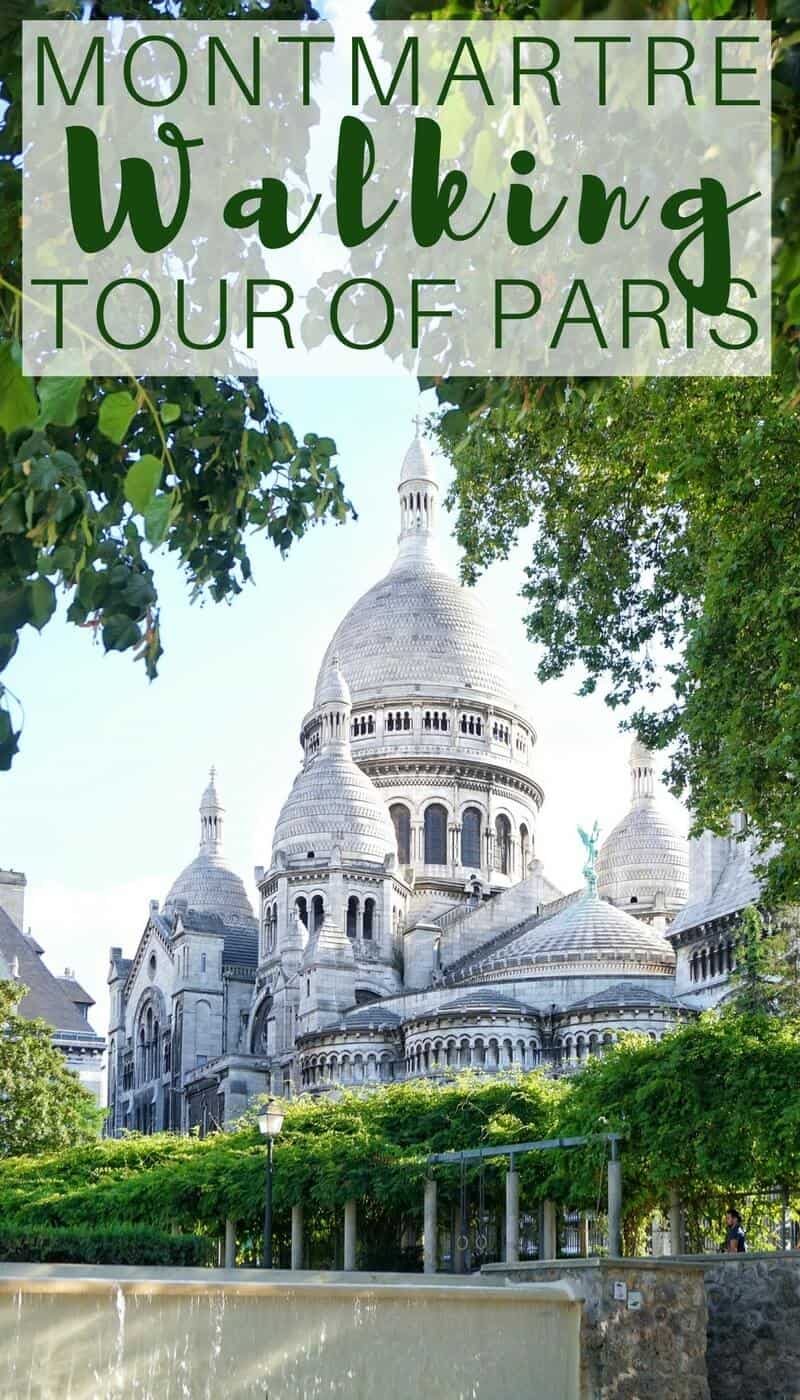
Psst. If you’re planning to visit Paris, then we’ve created a gorgeous 100+ page eBook full of beautiful photos and insider tips by a local. Included you’ll find hidden gems, arrondissement guides, walking tours, suggested itineraries, and more. Find more information here.
Montmartre Walking Tour: Practical Advice, Tricks & Tips
Parvis du sacré coeur, sacré coeur, musee de montmartre, clos montmartre, la maison rose, rue l’abreuvoir, place dalida, moulin de la galette, picasso’s paris studio, le consulat café, place du tertre, le refuge des fondus, le mur des je t’aime, l’objet qui parle, enjoyed following this free and self-guided montmartre walking tour of the 18th arrondissement pin it now, read it again later:.
Before you head out on your Montmartre Walking Tour, there are certain things you should know. Firstly, make sure that you wear suitable walking shoes: this is one area of Paris where there really are plenty of cobbled lanes.
Though the walking time is just 26 minutes, allow yourself at least a couple of hours to ensure that you have enough time to see all the sites and attractions along the way (after all, there are plenty of museums, small streets, and eateries you may want to spend a while in along the way) .
If you’re considering stopping for lunch, and perhaps also an afternoon tea, then allocate yourself an entire half day of your time in Paris to complete this tour, especially if you’re planning to explore the museum.
Walking time: 26 minutes
Distance Covered: 2km
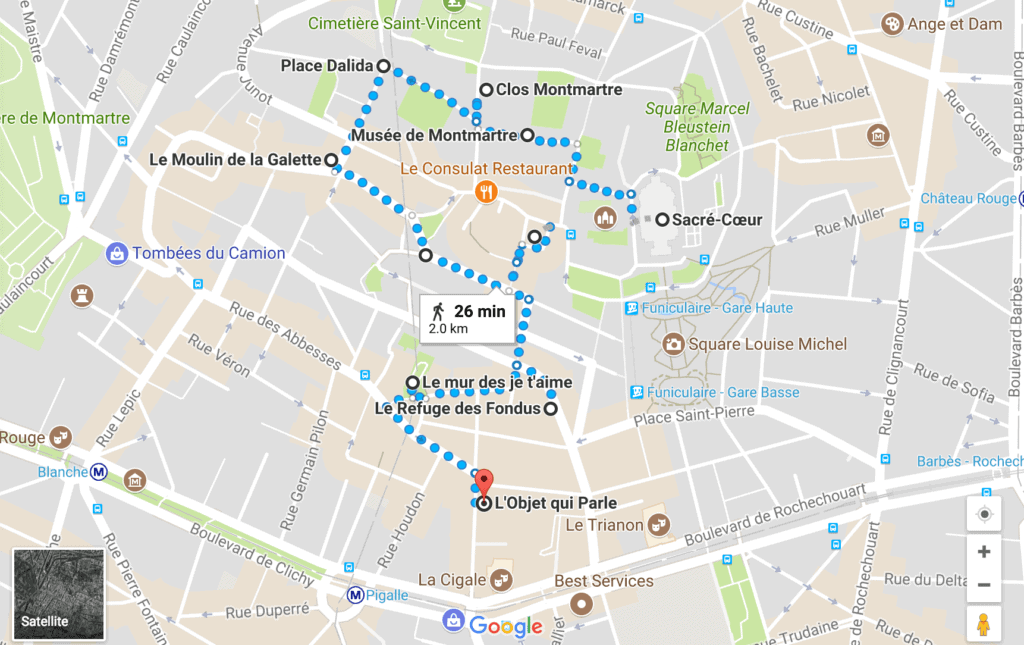
Places to see on this Montmartre walking tour
Begin your self-guided walking tour of Paris at the Parvis du Sacré-Coeur, the gateway to Montmartre. You can reach the Parvis du Sacré-Coeur via a number of different routes.
The nearest metro station is Anvers (line 2 blue) and you can walk up the numerous steps from the Carousel, up to the Sacré-Coeur. Just be sure to bring some water and snacks if it’s a hot day as it’s a pretty steep climb up!
If you approach the Basilica from this direction, you’ll pass the Sinking house of Montmartre along the way. Alternatively, you can reach the Parvis via the funiculaire de Montmartre (Montmartre funicular) . Opened in 1900, the journey lasts a minute and a half and costs the same as one metro ticket.
Once at the top, take a moment to admire the landscape, and the city of Paris sprawling out below you. This is your first glimpse of Montmartre and a portal into another time zone…
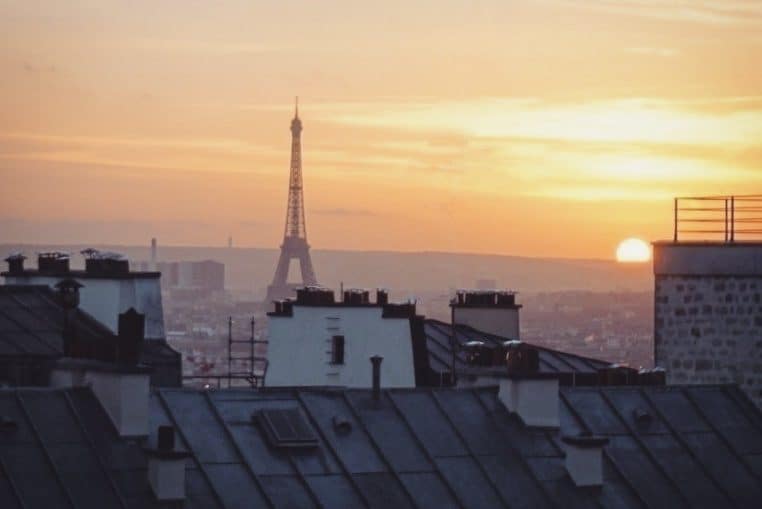
The iconic Basilica of the Sacré-Coeur has been a place of worship for thousands of years (during Roman times, it was even used as a pagan place of worship) . And, let’s face it, you predominantly visit Montmartre to catch at least a quick glimpse of the iconic Basilica.
Entry to the church is free, though no photographs are allowed inside (though I’m sure you’ll see plenty of people trying to take photos during your visit!). If you so wish, you can also pay a fee to go inside the interior top dome of the basilica to get an even better view of Paris from above.
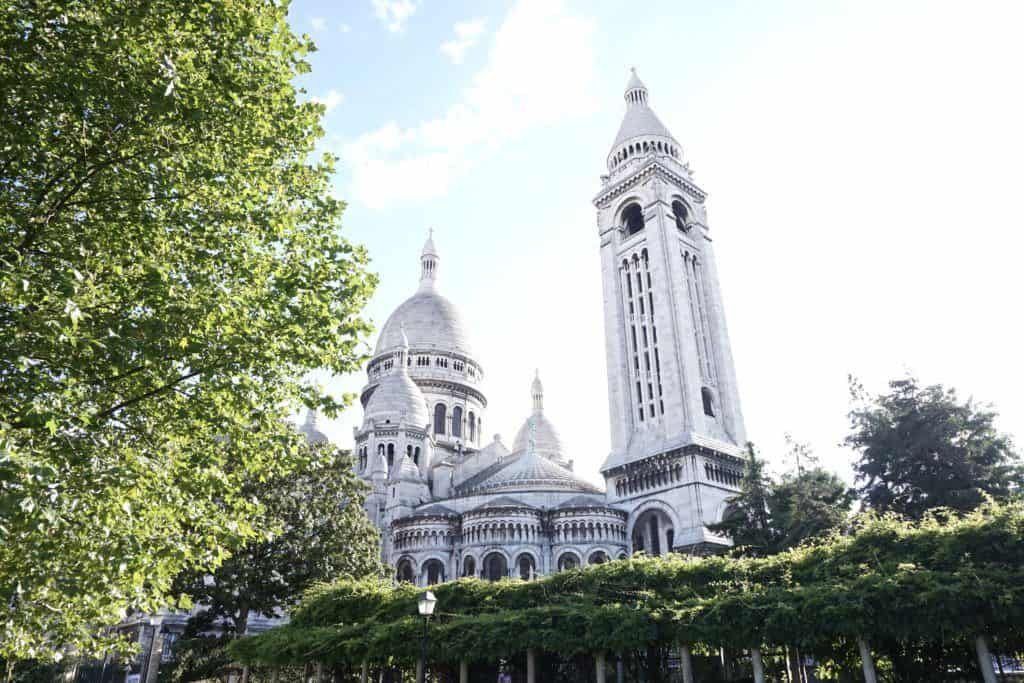
Pretty in pink, and complete with a set of gardens dedicated to Renoir, Musée de Montmartre is the perfect introduction to life in Montmartre, and the culture which has grown up around the area.
Located at 8-14 Rue de Cortot, here you’ll find a selection of artworks by many a famous resident of the area, as well as a brief history of Montmartre itself.
Purchase your Musée de Montmartre ticket here.

If you really want to get an understanding of Montmartre, and the history of the area, then no Montmartre Walking Tour would be complete without a visit to the Clos Montmartre , one of the last working vineyards in the middle of Paris. Situated just to the rear of Musée de Montmartre, the vineyard produces just a few bottles of wine annually.
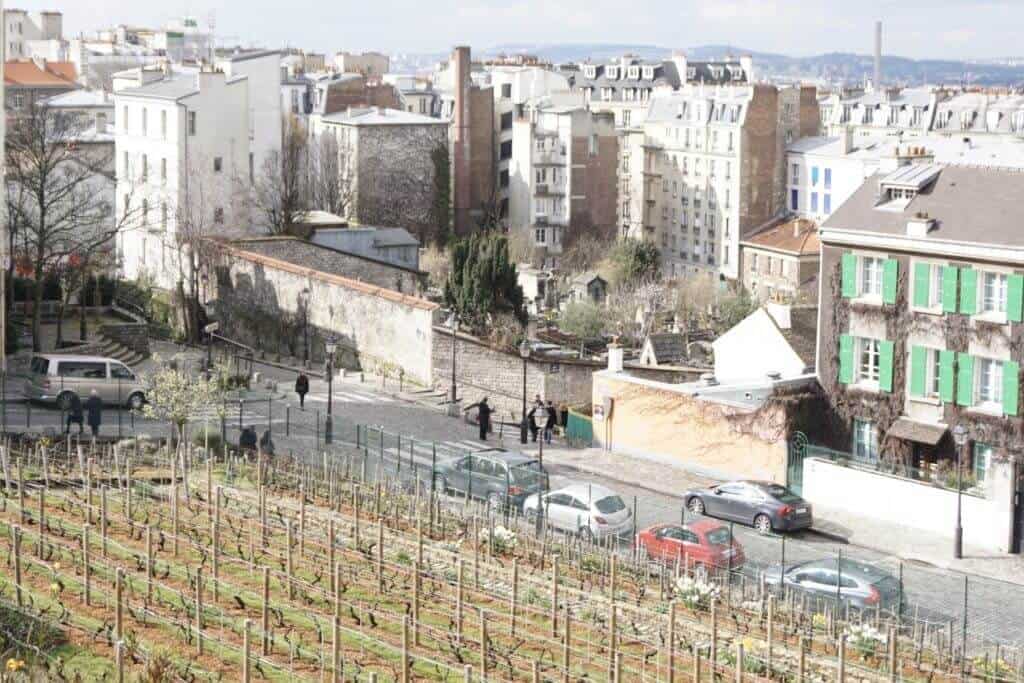
Incredibly famous since the rise of Instagram, La Maison Rose stands at the end of one of the prettiest roads in Paris and is surrounded by cobbled streets. The restaurant/ café is open daily for food and drinks and is pretty much as cute as you can imagine (from the photo) .
There has been a coffee shop at La Petite Maison Rose for well over a hundred years, and this small bar on the side of Montmartre was once a boarding house where writers would come to enjoy their lunchtime meals for a modest price.
Today you can still enjoy traditional French fare on the little chairs and tables outside of the Parisian café. However, you should note that the café gets incredibly busy and so be sure to head here mid-week and earlier in the day if possible!

The pretty little road of rue de l’Abreuvoir overlooks the Sacré-Coeur and some of the prettiest architecture Montmartre has to offer. Many of the houses are covered in ivy.
Rue de l’Abreuvoir also happens to be one of the best places to see Wisteria in the city come wisteria season in April/ May. The street takes its name from an ancient watering trough situated in its centre, and dates back all the way to the 14th-century.

Perhaps the prettiest square in Paris, Place Dalida is well worth a stroll around, and perhaps a quick stop to snap a photo or two. The square is named after the iconic singer Dalida, an Egyptian/ Italian who called Paris home during her most famous years.

Once upon a time, the hill of Montmartre and its surrounding countryside was home to a whole multitude of windmills. Though this is no longer the case, a few still survive to this day. Moulin de la Galette is a testament to the history of Montmartre, as well as its enduring culture.
Today, the Moulin (windmill) operates as a restaurant and is open on a daily basis for lunch and dinner. A windmill has stood here, in this spot, since at least the 17th-century.

As you will have already seen from your time at the Montmartre Museum, the area has inspired countless artists, writers, and poets for centuries. One of the most famous of these was Picasso, who spent a lot of time in Montmartre when he was starting out.
As a result, he set up shop in Montmartre, Le Bateau-Lavoir to be precise. Though much of the building was sadly destroyed by fire in the 1970s, the façade survived and the building was reconstructed.

Perhaps the cutest cafeé in Paris (if one coffee house is even allowed to claim that title) , Le Consulat is well worth a look when you’re in Montmartre. Situated at 18 Rue Norvins, this little café is overlooked by the Sacré-Coeur, a cobbled street and is the perfect place to stop off for a quick coffee. For exactly how to order a coffee in Paris, I’ve written a short guide here !

If you want to see where the artists spend their time in Paris nowadays, then you need to look no further than Place du Tertre. Filled with little artists’ stalls, here you’ll find painters painting en plein air .
There’s even the chance to purchase some of their artworks (if you’re looking for a particularly unusual souvenir from France to bring home with you).
Surrounding the Place du Tertre square, you’ll find a large selection of cafés and shops selling ice cream, snacks, and larger meals- though I don’t recommend actually eating around here.

If you’re looking for traditional French cuisine, as well as a convivial dining experience, then Le Refuge Des Fondus is the place to head to. Enjoy wine, by the [baby] bottle- yes, the wine quite literally is served in baby bottles. Here, you’ll also find more fondu than you could possibly eat (and it’s oh so delicious!)

A wall dedicated to all things love, the wall has ‘ Je T’aime ‘, (or I love you for all my English speaking readers) in over 250 languages, with over 300 declarations of love listed in total!
Spend the penultimate stop on your Montmartre Walking Tour celebrating love, and stop to admire the wall for a short moment. The I love you wall is at the base of the Butte Montmartre and comprises 612 tiles of enamelled lava. All in all, it’s well worth a look!

Finish off your Montmartre walking tour by indulging in a typically Parisian- and more specifically Montmartre- pastime. That’s right, try vintage shopping a la Parisienne in L’Objet Qui Parle (the talking object).
This vintage shop in Paris stocks quite literally everything; from drawings to ceramics, to the bizarre. It offers you the chance to purchase a particularly unique souvenir from your time in Montmartre, and Paris in general…

Sophie Nadeau loves dogs, books, travel, pizza, and history. A Francophile at heart, she runs solosophie.com when she’s not chasing after the next sunset shot or consuming something sweet. She splits her time between Paris and London and travels as much as she can! Subscribe to Sophie’s YouTube Channel.
This site uses Akismet to reduce spam. Learn how your comment data is processed .
Wednesday 5th of February 2020
Hello! This is great post, thank you for it! I personally love Montmartre and looking forward to visit Paris and especially this place again very soon. If I follow your suggestion, it could be quite different experience than previously. I love your website, keep great work! Bye Renata
Wednesday 4th of September 2019
We enjoyed following your tour and seeing some of the sights of Montmartre. However please include that the Fondu shop is only open at night. A big disappointment for us hoping to enjoy its fare!
Oh Paris, My Paris -> 5 “Off-The-Beaten-Track” Things To Do & See In the City Of Love – Wheeling It
Tuesday 23rd of October 2018
[…] you get there is to go outside the tourist zones and explore around. The walking tour described in THIS post is an excellent place to start, but otherwise just let your artists nose lead […]
Fleming Leigh Ware
Friday 12th of October 2018
How long would you allow for this walking tour?
Paris: A Solo Traveller's Guide to Where To Stay and the Best Things To Do
Thursday 2nd of August 2018
[…] Montmartre meander. I followed this excellent Montmartre Walking Tour guide from fellow travel blogger, Solo Sophie. I saved the stops on my offline Google map. Some of them […]
- Skip to primary navigation
- Skip to main content
- Skip to primary sidebar

Secret Montmartre: a free self-guided Montmartre walking tour
April 12, 2018 by Karen Turner 14 Comments
Planning your visit to Montmartre and tired of the crowds of Paris? This guide to one of Paris’ most famous arrondissements covers secret locations that you won’t read about on most other travel blogs with a complete self-guided walking tour of Montmartre with map.
I lived only a stone’s throw away from Montmartre during my part of my time in Paris, so I often wandered up to Pigalle and Montmartre. In this guide to Montmartre, I cover the history as well as the little villages/streets that make Montmartre truly special. The walking tour of Montmartre should take about 2 hours. The total distance covered is 4 kilometers (2.5 miles).
Warning : Not all of these locations are public property, so ask permission before you go inside. Enter at your own risk. (I will warn you when you can’t fully enter, so don’t worry!)
Pickpockets are an issue near Sacre Coeur and the Moulin Rouge. I’ve tried to route you away from the most touristic parts of Montmartre, but some bits are unavoidable. Click for tips on avoiding pickpockets in Paris.
You’ll find a map of this Montmartre walking tour at the bottom with step by step directions that you can print (or save on your phone).
- 0.1 A brief history of Montmartre before the walking tour
- 0.2 Your self guided walking tour of Montmartre
- 0.3 Start off at Pigalle
- 0.4 Cité du Midi
- 0.5 Villa des Platanes
- 0.6 Moulin Rouge
- 0.7 Cité Véron
- 0.8 Café des Deux Moulins
- 0.9 Maison de Van Gogh
- 0.10 45 Rue Lepic
- 0.11 Rue Durantin
- 0.12 Bateau Lavoire
- 0.13 Rue d’Orchampt
- 0.14 Le Moulin de la Galette
- 0.15 Villa Léandre
- 0.16 Place Dalida
- 0.17 Rue de l’Abreuvoir
- 0.18 La Maison Rose
- 0.19 Clos Montmartre
- 0.20 Rue de la Bonne
- 0.21 Sacre Coeur
- 0.22.1 Optional: Biscuiterie de Montmartre for macarons
- 0.23 Le mur des je t’aime
- 0.24 End: Abbesses Metro
- 0.25.1 Click for the downloadable PDF directions of the MontmartreWalkingTour.
- 1.0.1 Anything else that you’d add? Feedback on this walking tour/route appreciated!
A brief history of Montmartre before the walking tour
The name of Montmartre was named for the namesake hill from Roman times (Mount Mars). In the medieval ages, most of Montmartre was an abbey, however this abbey was destroyed during the French Revolution. For many years, this area was distinct from Paris, only a commune on the outskirts.
During the time of the impressionists, Montmartre gained a reputation for cafes, dance halls, and cabarets, which attracted many artists to the area. This included Vincent Van Gogh, a favorite painter of mine whose roots I traced in Belgium , and Picasso. If you can imagine many windmills in Montmartre, there were dozens in Van Gogh’s time.

The Belle Époque ended and many of the artists who came to the former village for cheap rent ended up being pushed out. Despite many tourists and increasing housing prices in this arrondissement, Montmartre still has some working artist studios remaining.
This walking tour will bring you to one of these hidden art studios if you’re lucky enough to get inside. (Art is one of my favorite mementos from traveling although I’ve only recently started collecting it.) Montparnasse proved to be the next bohemian area in Paris.
Your self guided walking tour of Montmartre
This walking tour is intended for people who are fine with uphill/downhill walks as well as stairs. Without stopping, the total walking tour should take about one hour, so give yourself two hours if you intend to enjoy your morning or afternoon in Montmartre.
The distance covered on the walking tour is 4 kilometers or 2.5 miles. Be sure to reward yourself with French macrons at a bakery after your long walk.
Start off at Pigalle
Pigalle is rapidly changing from its slightly sketchy past as the home of the red-light district in Paris. (We’ll discuss this another day!). However, start your journey at the Pigalle Metro station, along lines 2 and 12.
Cité du Midi

From here, you’ll need to cross the road towards Cité du Midi, which was made famous in the namesake film (“Cité du Midi”). Down this street, you’ll find a charming street filled with ivy away from the loud crowds and tourists in Paris.

Here, you’ll find white-washed doors with a hint of exclusivity. Similarly, you’ll find the former Pigalle Baths as well as the former Pigalle Theatre. At the time that I visited, a gate was about to be constructed near the back area, so be sure to appreciate this stunning little village of Paris before it’s closed off to the public.
Villa des Platanes

This private villa constructed in 1896 is a blend of architecture styles. Although the imposing gate keeps most curious passerby’s out, my friend Emily and I were lucky enough to be invited in by a resident.
Outsiders are not allowed inside Villa des Platanes, so you’ll have to make do with viewing it from the exterior unless a resident invites you in. My photos might be the closest that you get to entering, but it’s still beautiful through the fence.

Moulin Rouge

How can you miss the The Moulin Rouge? I personally think that it’s best seen at night or around dusk. The Moulin Rouge is the birthplace of the can-can dance and you can still go to (touristy) shows at the Moulin Rouge. You’ll be away from the crowds soon, but keep an eye on your stuff here.

This narrow street has been perfectly preserved from the 1920s, which you can find from its iconic post marking the entrance. This was the home of Montmartre’s longtime mayor and its greenery is a breath of fresh air compared to the rest of Paris.
Towards the end of the alley, you’ll find a stunning 1920s house stuck in time although it might not be viewable once the gate goes up again.
Café des Deux Moulins
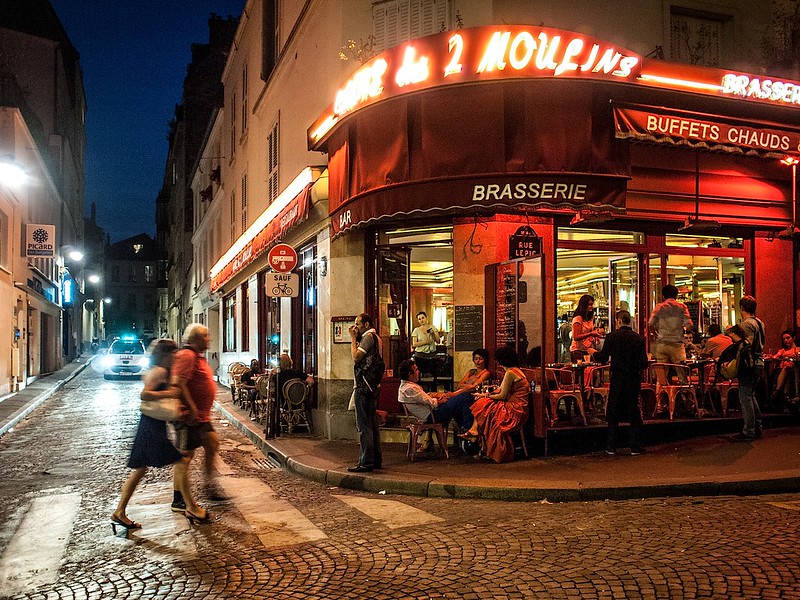
Any Amélie fans here? This iconic cafe was her place of work in the film. You can still sit in this cozy French cafe, which has a poster of Audrey Tautou in case you forgot which movie that I’m talking about. I’m a sucker for movie locations, so I had to pass by here.
Maison de Van Gogh
As a Van Gogh fan, I had to pass this landmark, which was Van Gogh’s home in Paris. Vincent Van Gogh and his brother Theo lived on the fourth floor of this building (42 Rue Lepic).
Van Gogh painted on the streets of Montmartre for two years using this home as his home base until he moved to the South of France. You cannot enter unless you’re having a function, but you can admire its exterior at least.
45 Rue Lepic
This functional studio is one of the few artist studios in Montmartre that you can still enter today. During weekdays (typically between 9-5pm), you’ll be able to enter this partially-open covered passage that still is home to artisans.
Please be quiet and polite as it’s a privilege for the public to enter this area and this policy might change if people are inconsiderate. For those looking for a true masterpiece to bring home, consider stopping by the studio of Véronique Darcon Cazes , a famous French artist who produces stunning mosaics.
Rue Durantin
I just enjoy walking down this cute street. Although I have never gotten beyond the entry again, the “Cour aux Juifs” is viewable from number 40’s entry gate.
Bateau Lavoire
This building was once used as Picasso’s studio. It’s not open to the public, however it’s still rented to artists and writers from all the over the world for minimal rent. The original building is not there, but you’ll know you found it if you find the green doors.
Rue d’Orchampt

For graffiti, you’ll want to walk down this short street to admire the local and foreign graffiti artists who have left their mark. Although it’s illegal to do so, this is one of the most coveted streets in Paris and you’ll likely see completely different street art than what I saw.
Look for the iconic Space Invaders graffiti that you’ll spot all around Paris, made by a French graffiti artist.
Le Moulin de la Galette

Le Moulin de la Galette is certainly a tourist attraction, however it’s worth stopping to see one of the last remaining windmills in Montmartre. At one time, Montmartre was covered in windmills as they were commonly used to grind materials.
This windmill, a favorite of Vincent Van Gogh, was used for grinding flour. The owners of the windmill created a brown bread (Galette) that was so popular that the windmill got its name from it. The building underneath has had many purposes over the years, however it’s now a restaurant.
Villa Léandre
From here, make a left onto Avenue Junot prior to making another left to reach Villa Léandre, which is widely considered to be one of the most beautiful streets of Paris.
There used to be a mill here, however this street built in the 1920s is one of Paris’ most exclusive streets where the homes sell in the millions. The houses have colorful accents and raised roofs. (I’m kicking myself for not getting a good photo. Thank you to Lucie for this beautiful photo!)
Place Dalida

This stunning location, named for the famous singer is one of the best viewpoints in Paris of Montmartre. Say hit to the bust of Dalida and continue up the stunning Rue de l’Abreuvoir, one of the most beautiful streets in Paris. Some say that Paris in the rain is enchanting, but you can judge for yourself if you prefer it in the rain compared to a clear night right after a downpour.
Rue de l’Abreuvoir

This winding street was named for the water trough that used to exist at 15 Girardon Street. It’s definitely a lovely street to walk along. Even my husband wandered off to admire the details on the ornate buildings.
La Maison Rose

The house was purchased in the early 1900s by Germaine Gargallo, the wife of a well known painter. The house become a famous gathering place for artists. However, it truly became famous after painter Utrillo created a painting of it. It’s lovely to view and photograph from the exterior.
Clos Montmartre

Ever since the Romans conquered Paris, there has been a vineyard in Montmartre and it is the oldest vineyard in Paris. Now sponsored by the city government, the vineyard at Clos Montmartre creates a small number of bottles per year that are sold for charity. (Tours are free although you must pay for a tasting.) It’s just really cool to see a vineyard in the middle of the city.
Rue de la Bonne

For the best views of Sacre Coeur without the crowds, walk around the other side of Rue de la Bonne for epic views of the Sacre Coeur. Despite the crowds near the front of Sacre Coeur, there’s almost nobody else here.
Sacre Coeur

Basilica of the Sacred Heart of Paris, Sacre Coeur, is one of the most famous churches in Paris. Built in the late 1800s, this impressive church is actually best seen from quite a bit below as the crowds and height make it difficult to get the perfect photo.
This is one of the best spots in Paris to sit to enjoy the sunset over the city although I caution to be aware of your stuff as it’s also a favorite of pickpockets. You can climb the tower for the highest views in Paris!
Place du Tertre

Place du Tertre is quite touristy, but if you love watching street artists work, this is one of the best places to sit outside. After seeing a real atelier, this might not appeal to you,.
The alleyways around here are particularly pretty (especially once you get far away from the Starbucks). I’ve not included a photo of the main square, but you can find some gorgeous alleyways and stairways off of it.
Optional: Biscuiterie de Montmartre for macarons
If you’re feeling a bit hungry at the end of this walking tour of Montmartre, consider stopping off at this well-known bakery in Montmartre for macarons. (You’re almost done!) You’ll find many cafes in the areas as well as picturesque stairways.
Le mur des je t’aime

This world-famous mural of love written in many languages is a favorite among instagrammers and couples in love.
End: Abbesses Metro

Your little tour of Montmartre ends at one of the cutest Paris metro entrances (in my opinion). The entrance is one of the only remaining glass covered Guimard original Metro entrances in Paris. Abbesses is the deepest metro station in Paris and part of line 12. Expect stairs.
Map of the self-guided walking tour of Montmartre

Click for the downloadable PDF directions of the MontmartreWalkingTour .
Have you been to montmartre, anything else that you’d add feedback on this walking tour/route appreciated.
Click for a walking tour of the Paris covered passages, my guide to the 14th arrondissement , tips for visiting France on a budget , an one day itinerary for off the beaten path Paris , and tips for avoiding pickpockets in Paris .
Save this post for later!

About Karen Turner
New Yorker–born and raised. Currently living in the Hague, the Netherlands after stints in Paris and Amsterdam. Lover of travel, adventure, nature, city, dresses, and cats.
Reader Interactions
April 14, 2018 at 3:32 am
You found some of the cutest spots! I am so sad I missed these spots when I went last summer, Great post!
April 14, 2018 at 5:34 am
Haven’t been to Montmartre yet but definitely taking advice from your walking tour the next time I’m in France! I notice there’s barely any people in your photos, which would make a lovely environment for taking in all the details in the surroundings =)
April 14, 2018 at 10:20 am
I wish I had this guide when I stayed in Montmartre during my trip to Paris last winter. I LOVED the area. Stumbled upon a great view of the Eiffel Tower up the road from Sacre Coeur. Great memories <3
April 14, 2018 at 11:36 am
Thanks for such a wonderfully detailed guide! There’s so much to know about this beautiful corner of France. You’ve captured this area stunningly in your words and pictures!
April 14, 2018 at 12:46 pm
Love this guide! I really liked Montmartre but hardly had any time to explore it when I was there so this is perfect for when I get back to Paris! Love all your walking tour guides. 🙂
April 14, 2018 at 1:33 pm
I think my last comment didnt go thru 🙁 I love Paris and pretty much want to go right now after reading this. This is the best way to see a city!
April 14, 2018 at 5:16 pm
I love self-guided walking tours! It’s my favourite way to experience a city. Thanks for sharing your secret places to check out 🙂 Montmartre looks so charming indeed.
April 19, 2018 at 5:41 am
Merci Beaucoup for this detailed guide. We’re visiting Paris in May. Looking forward to exploring Montmartre.
May 15, 2018 at 12:50 am
After literally hours of Pinterest searching over time. Found your so perfect for us guide to Montmartre. Staying there 10 days from May 29 on Rue Orsel. All other guides are tourist destinations. We want to wander, be delighted and enjoy just being there. Not my first trip. Thank for this inspiring walking guide. Will be taking it and reporting back when we return to Canada. Cheers.
May 15, 2018 at 6:02 pm
Hi Angela, Thank you so much for your kind comment and glad that you found what you were looking for! I really hope you enjoy it and please let me know if you have any feedback, so I can tweak it if needed.
Best, Karen
July 6, 2019 at 8:26 am
We did this tour in reverse with the family. Staring around 7pm on a warm sunny evening, we stopped and ate at Le Moulin de la Galette and watched the sun go down. Finished at Moulin Rouge around midnight. For two artist who have only read about these places, it was a real treat and your guide made for one of our most memorable nights in Paris. Thank you!
July 30, 2019 at 7:38 pm
I was there in August 2018 and did the off the beaten path self walking tour. I was rewarded with some of the nicest spots in Paris. Highly recommended to every one who don’t like the crowds and touristy spots. I got off the Lamarck Metro station and made my way down Montmarte. It was an amazing day.
February 11, 2020 at 12:18 am
This is such an amazing list. Thank you for sharing!!
May 3, 2022 at 5:08 pm
This was such a great tour to take! I also appreciate that if you follow the order you don’t have to climb many stairs, haha. I really enjoyed this, thank you for sharing! 🙂
Leave a Reply Cancel reply
Your email address will not be published. Required fields are marked *
- The Netherlands
- New York State
- Other European destinations
- Work With Me
- Disclosure and Privacy Policy
- Jeju SEO Tool: Free SEO Writing Tool
You can unsubscribe anytime. For more details, review our Privacy Policy.
You have successfully joined our subscriber list.
TreasureHunter USA Inc. 251 Little Falls Drive Wilmington, Delaware 19808 +1 (915) 4632387 EIN 88-2174128
www.wanderlustingk.com is a participant in the Amazon Services LLC Associates Program, an affiliate advertising program designed to provide a means for sites to earn advertising fees by advertising and linking to amazon.com. As an Amazon Associate, we earn from qualifying purchases. We also participate in other affiliate programs
www.wanderlustingk.com all rights reserved © 2023 | Privacy Policy | Cookie Policy |
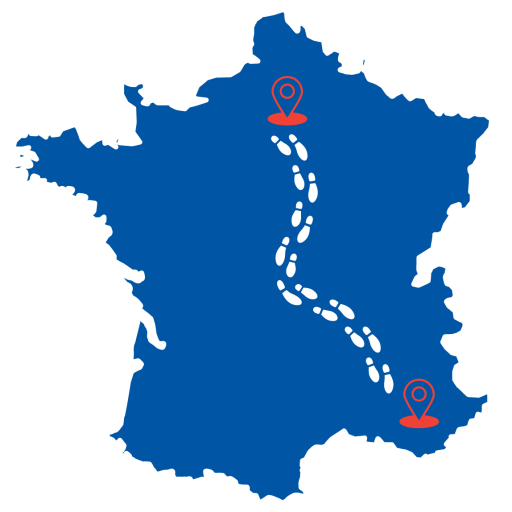
France Adventurer
How to Spend a Day in Montmartre (Self-Guided Walking Tour)
Are you trying to figure out what to do with a day in Montmartre? Read on for my recommendations – I have a great self-guided walking tour Montmartre itinerary for you!

With its cobblestone streets and artistic legacy, Montmartre, the hilltop neighborhood in the north part of Paris, almost feels like an escape from the city hustle and bustle. Known for its village-like atmosphere, Montmartre has a great vibe and an intriguing history.
For a long time, Montmartre wasn’t even in Paris city limits and was quite rural, filled with windmills, vineyards, and gypsum quarries. However, in 1860, Montmartre was incorporated into Paris, and it quickly became a bohemian hotspot, popular with singers, dancers, writers, and artists.
I love how remnants of all of this history can still be seen throughout the neighborhood today. Today, Montmartre is most well-known for its bohemian past, the gleaming white Sacré Coeur Basilica, and the panoramic views of Paris.
And while Sacré Coeur is a gorgeous site in Paris, there is so much more to the 18th arrondissement (aka neighborhood) of Paris.
Over my 7 visits to Paris (including a 3-month stint living in the city), I’ve made a point to really explore and wander around Montmartre, walking up and down the charming streets and discovering its hidden corners.
This guide covers the best things to do with a day in Montmartre and essentially works as a self-guided walking tour of the neighborhood.

Spending One Day in Montmartre – The Logistics
Arriving in montmartre.
If you’re arriving via metro, I’d recommend Abbesses on Line 12, Anvers on Line 2, or Chateau Rouge on Line 4.
When To Start
Montmartre is a great place, but Sacré Coeur gets crazy busy during the day, enough so that the high crowds start to diminish the experience at the basilica.
I would highly, highly recommend starting your day in Montmartre fairly early. You don’t have to be here at sunrise, but if you can be at Sacré Coeur by 9am, you’re going to have a much better time than if you get here a few hours later.
How Long Do You Need?
Depending on how fast you walk and how long you linger at spots, you could spend anywhere from a half day to a full day in Montmartre, especially if you enjoy a relaxing lunch here. Of course, you can also stay in the Montmartre area and spread out these sites over a few days.
Which brings me to my next point…
Want to Stay in Montmartre?
Montmartre is a great area to stay in Paris, and although it is farther away from the city center, it is well-connected to the rest of Paris by multiple metro lines. I’d recommend the following three hotels in the 18th arrondissement:
Hotel Terrass : The views over Paris from the guest rooms and the rooftop terrace are truly spectacular – some rooms even have an Eiffel Tower view! The decor throughout the property is a trendy, modern style.
Hotel Monsieur Aristide : The Aristide is a newer boutique hotel, and they really show attention to detail with the furnishings around the property. The garden terrace is particularly gorgeous.
Hotel Litteraire: This is a great budget option in Montmartre and has nice, comfortable rooms. It’s still in a great location in the neighborhood and the design centers around renowned French writer, Marcel Ayme.
Can’t Climb the Steps to Sacré Coeur?
There is a funicular that starts at the “ground level”, not far from the carousel at Square Louise Michel. This funicular takes you almost all the way up to the basilica, you’ll just have to do the final steps.
Riding the funicular takes a standard metro ticket, and there are machines to buy tickets outside the entrance.
Best Places to Visit and Best Things to Do in Montmartre
Okay, let’s get into the best things to do with your day in Montmartre. I’ve tried to list the places to visit in an order that can be easily walked through the village, essentially functioning as a self-guided walking tour of Montmartre.
1. Square Louise Michel

Square Louise Michel is the square and lovely greenspace in front of and leading up to the Sacré Coeur basilica. There are walking paths, staircases, and this charming carousel.
This is a common spot for the “Bracelet Scam” – if anyone approaches you and asks if you want a bracelet (or asks if you will sign a petition), just respond with a firm no and keep walking.
2. Tilted House

Have you heard of this fairly well-known “tilted” house near Sacré Coeur? The house is, of course, not actually tilted, but is just a matter of shifting the perspective of the camera.
There is a perfectly slanted hill right in front of it, so if you rotate the picture so the hill is “flat” and the house appears slanted. You can find this at the bottom of the top staircase in front of Sacré Coeur, on the right side of the basilica. This is the exact location for this view.
3. Staircase on Rue Chappe
Montmartre is full of staircases (38 to be exact!) and the staircase on Rue Chappe, just to the left of Square Louise Michel, is the longest one in Montmartre, with 222 steps!
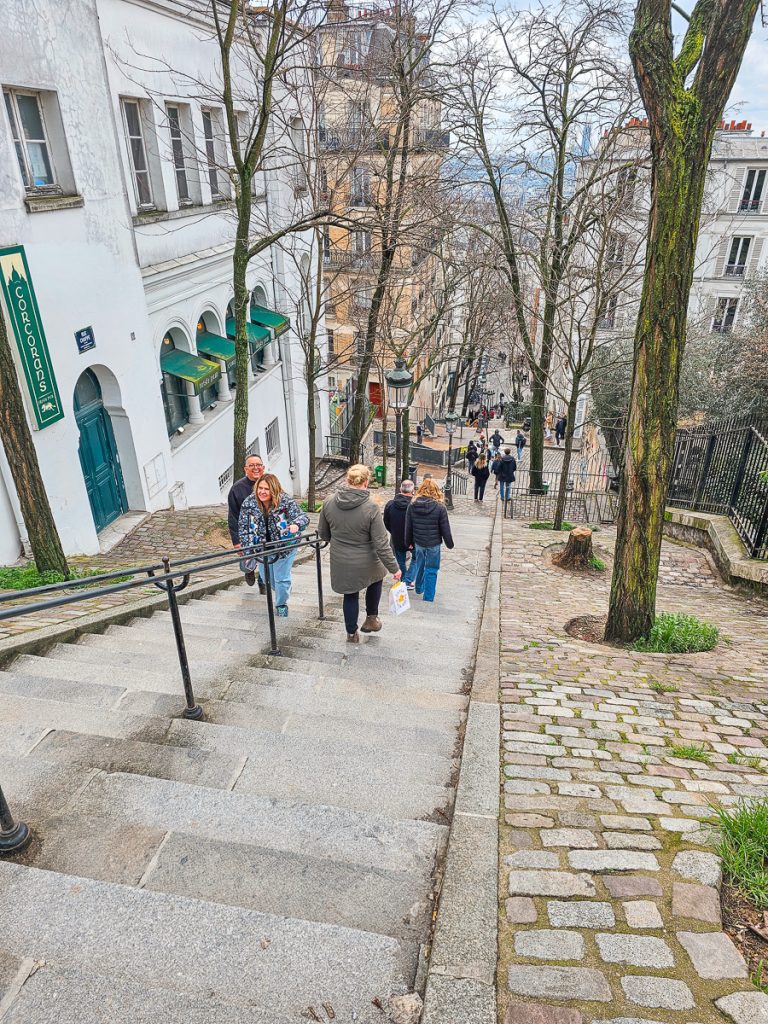
4. Sacré Coeur Basilica

Sacré Coeur is the shining jewel of Montmartre, and is an impressive basilica with shockingly white domes. Thanks to the particular travertine stone used in construction, the basilica stays an impressive white year after year.
And thanks to being set on a hill (Montmartre means “Mountain of the Martyrs”), it towers over the surrounding neighborhoods, creating one of the more dramatic views you’ll find in Paris.
I’d definitely recommend walking through the basilica – it is filled with soaring domes, stained glass windows, and colorful murals. No photos are allowed inside, so you’ll just have to go and experience it for yourself!
- Cost : Free
- Hours : 6am-10:30pm
5. Domes of Sacré Coeur
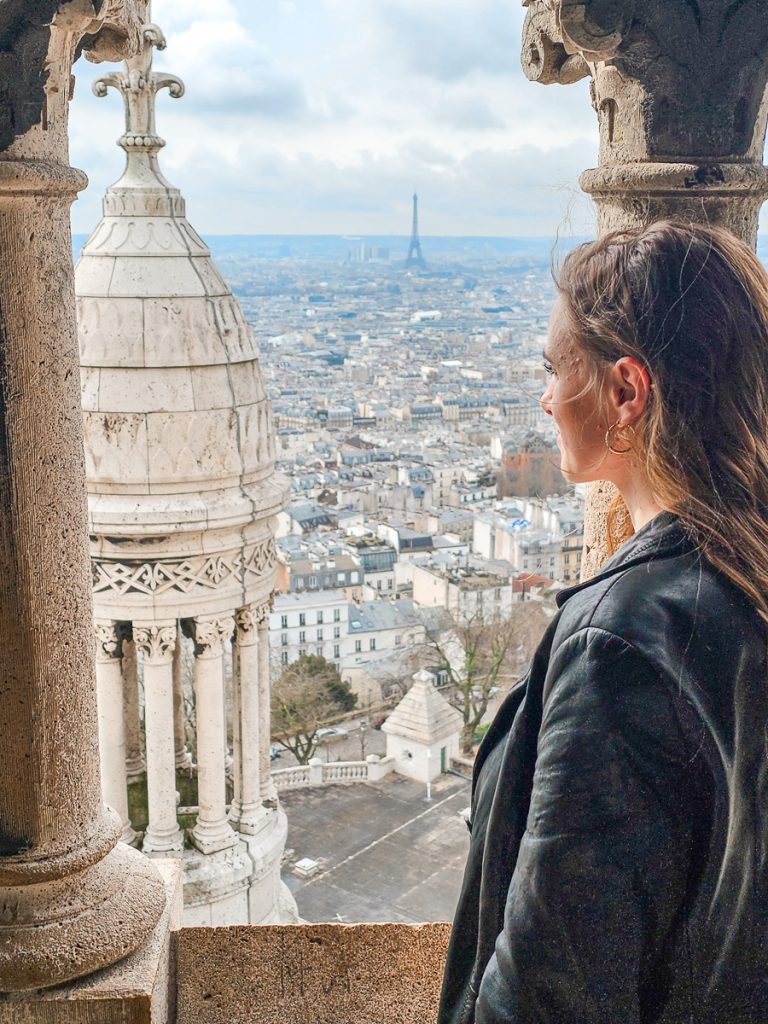
Very few people realize this, but you can climb up Sacré Coeur’s towers and into the main basilica dome.
Right before you enter the basilica, look for the sign for the panoramic viewpoint that leads you down and to the left. Here, you’ll pay the entrance fee and then start climbing the 292 steps of the spiral staircase up to the rooftop.
When you reach the rooftop, you’ll walk a short pathway between the different domes and spires along the roof – a super cool part of the experience.
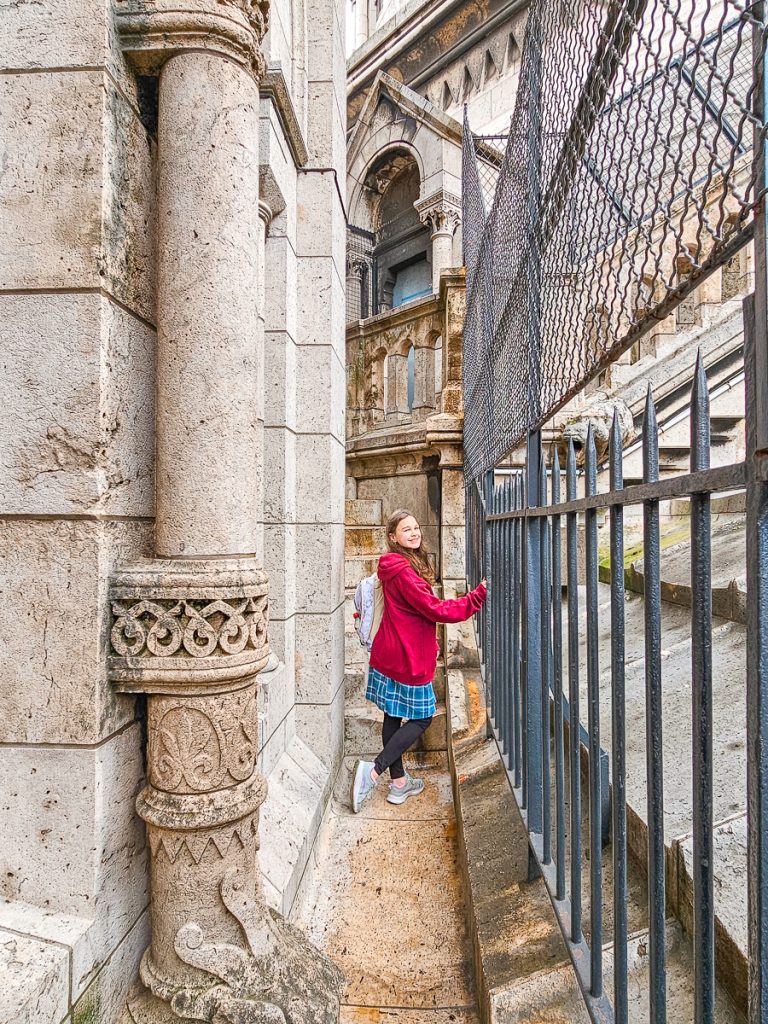
Then up another short staircase and then you’re in the dome! There’s a little walkway inside the columns and you can walk around, enjoying the incredible 360° views over Paris.

And while you can’t see the Eiffel Tower from the base of Sacré Coeur, up in the domes, you can enjoy one of the best Eiffel Tower viewpoints in the city. This is an incredible hidden gem in Paris to experience.
6. Back of Sacré Coeur
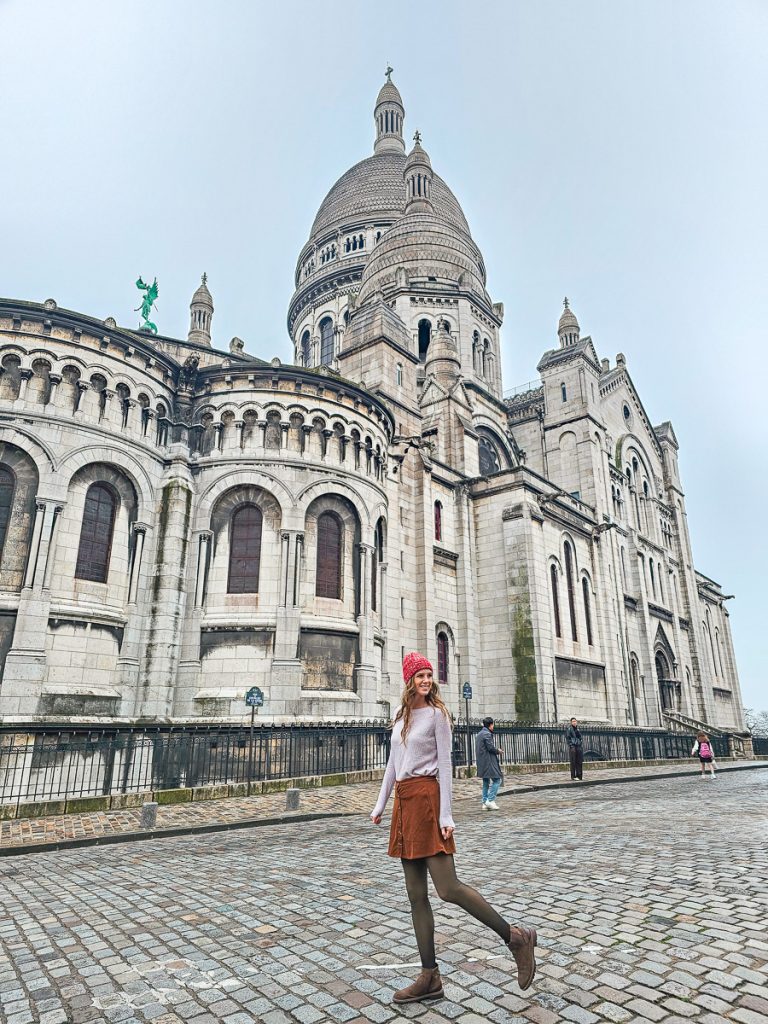
While the front of Sacré Coeur is iconic, I love walking around the back to admire the unique view (and lack of crowds) from behind. Certainly, the front of the basilica is the more photographed angle, but I think the back still qualifies as one of the most Instagrammable places in Paris .
The above picture was taken on the northwest (left) side of the basilica, and the below picture was taken in Square de la Turlure , a quiet and pretty garden on the northeast corner (right side) of the basilica.
The very back corner of the Square gives you the best angle of the entire church.

7. Staircases of Montmartre

Delightful little staircases are scattered around Montmartre hill and are a well-known feature of the neighborhood. Finding cute little staircases is one of the most enjoyable parts of exploring Montmartre, in my opinion.

I mentioned one staircase earlier (Rue Foyatier), and you’ll certainly come across quite a few of them naturally as you wander around. However, these are a few of my favorite staircases (and they all definitely make for a great photo spot ):
- Rue de Mont-Cenis (just behind Sacré Coeur)
- Lamarck-Calaincourt metro station (charming with the metro sign)
- Rue Juste Metivier (super pretty)
- Rue Girardon (by the Buste de Dalida, shorter)

8. Place du Tertre
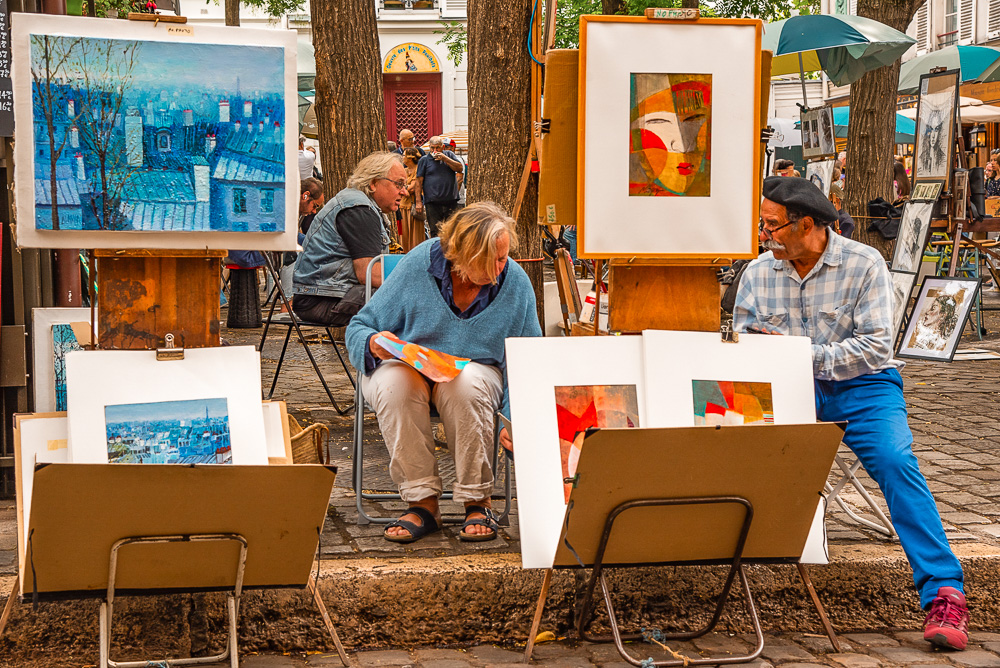
Place du Tertre is a café-lined square in the heart of Montmartre, where artists are out drawing, painting, and selling their pieces underneath leafy trees. This is a popular place to pick up a unique and beautiful artwork souvenir as a memory of Paris.
9. Le Consulat

Le Consulat is a well-known cafe with a charming facade and sidewalk terrace and is famous for its prestigious clientele during the 1800’s and early 1900’s. These patrons included famous artists, writers, and philosophers, including Van Gogh, Monet, and Picasso.
Van Gogh in particular was a frequent visitor to the cafe, and today, you can do as Van Gogh did and linger over a coffee or a traditional Parisian bistro meal, or just admire the view as you walk by.
10. La Maison Rose
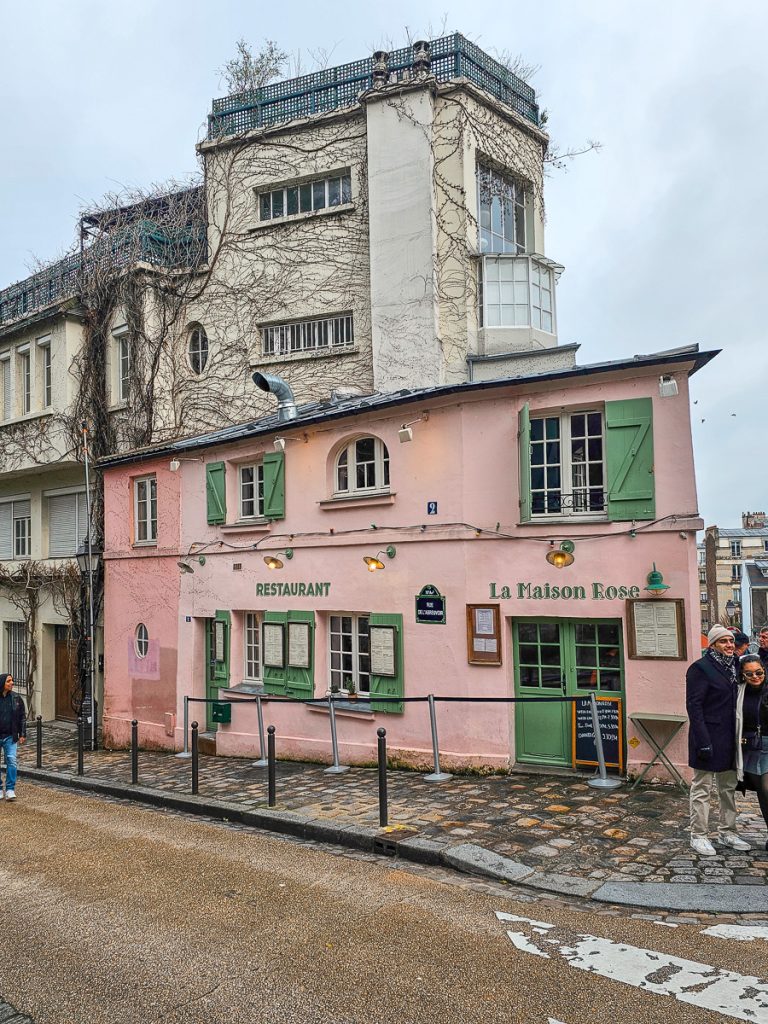
La Maison Rose has become a very famous restaurant in Montmartre (possibly even more so than Le Consulat), located at the top of Rue de l’Abreuvoir. Founded in 1908, the restaurant is painted an adorable pink color, and used to host singers and artists who lived and worked in Montmartre and Pigalle.
Today, it’s a very popular photo spot and continues to be a working cafe serving traditional French dishes.
11. Vigne du Clos Montmartre (Vineyard of Montmartre)

While Montmartre used to have multiple vineyards, the only remaining one in Paris city limits is the Vigne du Clos Montmartre. Established in 1933, this vineyard is not open to the public, but you can walk by and admire it from the street.
The best view of it is from the corner of Rue Saint-Vincent and Rue des Saules.

12. Rue de l’Abreuvoir

Rue de L’Abreuvoir is one of the prettiest, quaintest little streets in Paris. This short street starts by La Maison Rose café, and then curves down to the Place Dalida.
The view from the bottom of the street looking up lets you appreciate the curve of the street, and you can also see the tops of the Sacré Coeur domes peaking out behind the buildings.
Ivy climbs the sides of several buildings on this street, and in fall turns a fiery red, making the area even more beautiful.
13. Place de Dalida

Place de Dalida is located at the bottom of Rue de l’Abreuvoir. Here you can find a bust of Dalida, a French singer who sold millions of albums through the mid-1900’s. She is widely considered to be one of the most famous French singers of all time.
Tradition holds that it is good luck to rub her breasts, and as you can see, a lot of people have tried their hand at good luck.
From this square, you can also access the small staircase down Rue Girardon (mentioned in the Staircase section a few sections up).
14. Boris Lumé Bakery

On the back edge of the Montmartre neighborhood, the popular children’s TV show “Miraculous” is based on this adorable, charming bakery. This is a French animated show that has been dubbed into English (and my kids love it).

We came for the TV show association but stayed for the delicious food. I can highly recommend the kouign-amann croissant and their baguettes were incredible!
15. Le Passe-Muraille
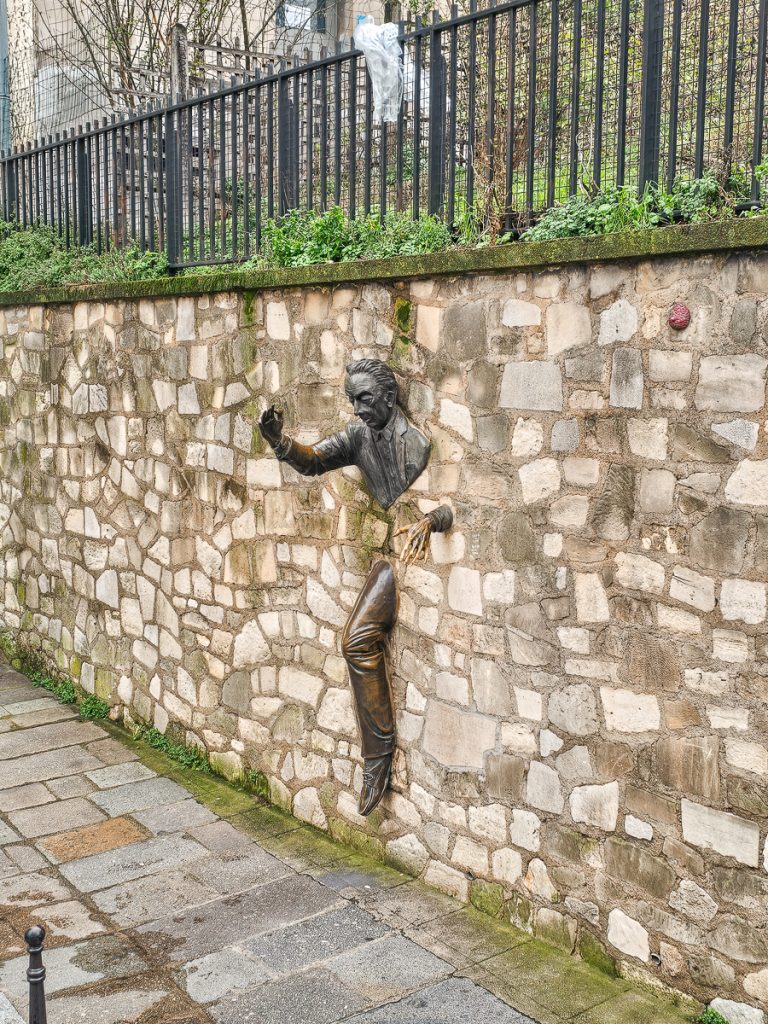
The Passe-Muraille is rather odd attraction in Montmartre, and is a giant bronze sculpture of a man walking out of the wall. The statue is based on a famous French book of the same name, by Marcel Ayme, a famous French author.
In the book, a man realizes he has the power to walk through walls, and uses his ability to commit crime and have an affair. However, his power suddenly stops one wall while passing through a wall, and he becomes trapped – the moment that is immortalized in this sculpture.
16. Square Suzanne Buisson

Square Suzanne Buisson is a a small, quiet garden in the heart of Montmartre, notable for its statue of Saint Denis. Denis was the first bishop of Paris, and was executed by beheading in Montmartre in 250AD.
Legend says he picked up his head and walked to what today is a northern suburb of Paris, where he finally died. Today, the Basilica of Saint Denis stands where he died, and is the burial place for the kings and queens of France.
Saint Denis is always depicted in artwork holding his head in his hands.
17. Rue Lepic

Rue Lepic is also in Montmartre and is a long street that does a dramatic curve as it slopes down the hill, and then finally ends at the famous Moulin Rouge cabaret.
This is the perfect Parisian walking street – generally few cars, a cobblestoned road, and beautiful buildings with stately doors. You’ll also pass Moulin Radet (more on this below) on Rue Lepic.

The section of Rue Lepic between Rue des Abbesses and Blvd Clichy is a great market-like street. You can find a great fromagerie (cheese shop), chocolaterie (A La Mère de Famille), bakery and pastry shops, and numerous cafes, including Café des Deux Moulins (one of the best cafes in Montmartre), where scenes in the movie Amélie were set.
18. Moulin du Radet

Historically, Montmartre used to have over 30 windmills, as the elevation on the hill was favorable for catching the wind. Moulin Radet, built in 1717, is one of two remaining windmills in Paris, and is today associated with the Moulin de la Galette restaurant. (In French, “moulin” means windmill).
The other windmill in Montmartre – Moulin Blutte-Fin, is privately owned and not accessible.
Fun fact: One of Pierre-Auguste Renoir’s most famous paintings was inspired by these windmills – the piece being named “ Le Bal de Moulin de la Galette. “
19. Gilles Marchal

The Gilles Marchal Patisserie is a neighborhood pastry shop that specializes in madeleines. They make a huge variety of madeleines daily – I opted to try triy the plain and the pistachio.
Now, I’ll be honest and say that madeleines are generally not my favorite French pastry, but the Gilles Marchal ones are the exception – the pistachio had a perfectly tender crumb and a lightly sweetened pistachio cream in the center. Delicious
Closed Mon-Tues.
20. Mur des Je t’Aime
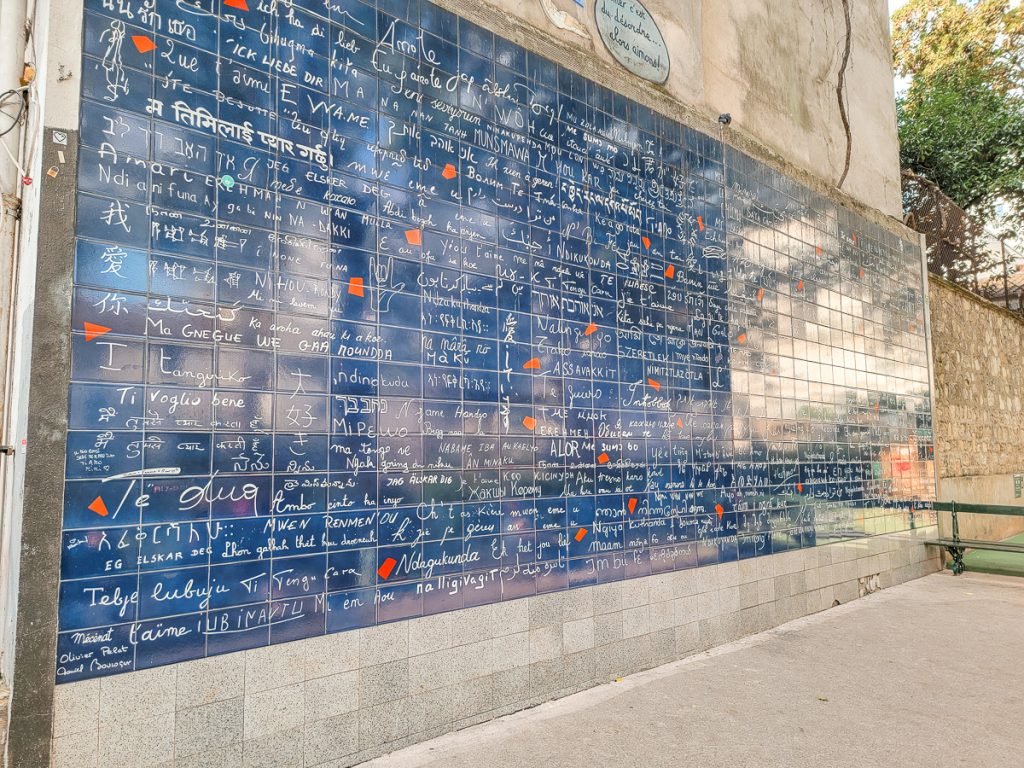
The ‘I love you’ Wall is a cute fixture in Montmartre, tucked away in a little garden at Place des Abbesses. The phrase “I love you” is written in 250 languages, and snapping a picture in front of the wall is a cute, romantic thing to do in Paris.
21 . Creperie Brocéliande

Wrapping up our walking tour of Montmartre is a stop at one of my favorite Parisian restaurants that serves up galettes, which are buckwheat crepes from the Normandy region.
You can order both sweet and savory galettes, and the flavor combinations are really interesting and delightful. I recommend ordering a savory galette for yourself and a sweet galette to share!
22. Moulin Rouge

Speaking of moulins, the Moulin Rouge cabaret is one of the most iconic features of the Montmartre area. This Red Windmill is entirely decorative and was never a functioning part of the windmills of Montmartre, but of course is a well-known fixture in the neighborhood today.
Attending a show is certainly a popular activity in Paris and you can grab a ticket here (although make sure you are aware that this is a cabaret where many of the women are topless).
Leaving Montmartre
If you end your day in Montmartre at Moulin Rouge, you can easily hop on the metro station Blanche, which is just adjacent to the cabaret, making it easy to get to your next destination in Paris.
Map of the Attractions in Montmartre
If you click on this map (or click on the star to the right of the title), the map should save to your Google Maps account. Then, when you’re in Montmartre, you can pull up this map on your phone and use it to help navigate around the city.
From your phone, open Google Maps, then click the Saved button at the bottom of the screen. Scroll all the way down and click on the Maps icon on the bottom right. You can see all your saved maps, select this map, and open it directly on your regular Google Maps. It’s super helpful for on-the-ground navigation!
For this Montmartre self-guided walking tour, I’d for sure keep the map handy – I have the places on the map listed in recommended walking order, with all the staircases listed in order of when you’ll see them (instead of just listed in one heading like I do in this post).
Is Montmartre Worth Visiting?
Absolutely! Montmartre is absolutely delightful and there are so many charming little spots to discover in the neighborhood.
Many people just visit Sacré Coeur and don’t venture farther in – but if you follow the walking tour laid out in this Montmartre guide, you’ll get to enjoy a deep exploration of some of the best spots in the village.
Stephanie is obsessed with everything having to do with France, and she's visited the country 10 times (including a 3 month stint when she lived in Paris). She draws on her extensive knowledge of the country to bring you detailed and helpful guides, from the perspective of a fellow traveler.

Free self-guided walking tour of Montmartre, Paris (with map)
Posted on Last updated: March 7, 2024
Explore Paris’ bohemian, artistic neighbourhood with this free walking tour of Montmartre’s artistic history, beautiful architecture, pavement cafés and scenic views – map and directions included.
* This site contains affiliate links , where I get a small commission from purchases at no extra cost to you.
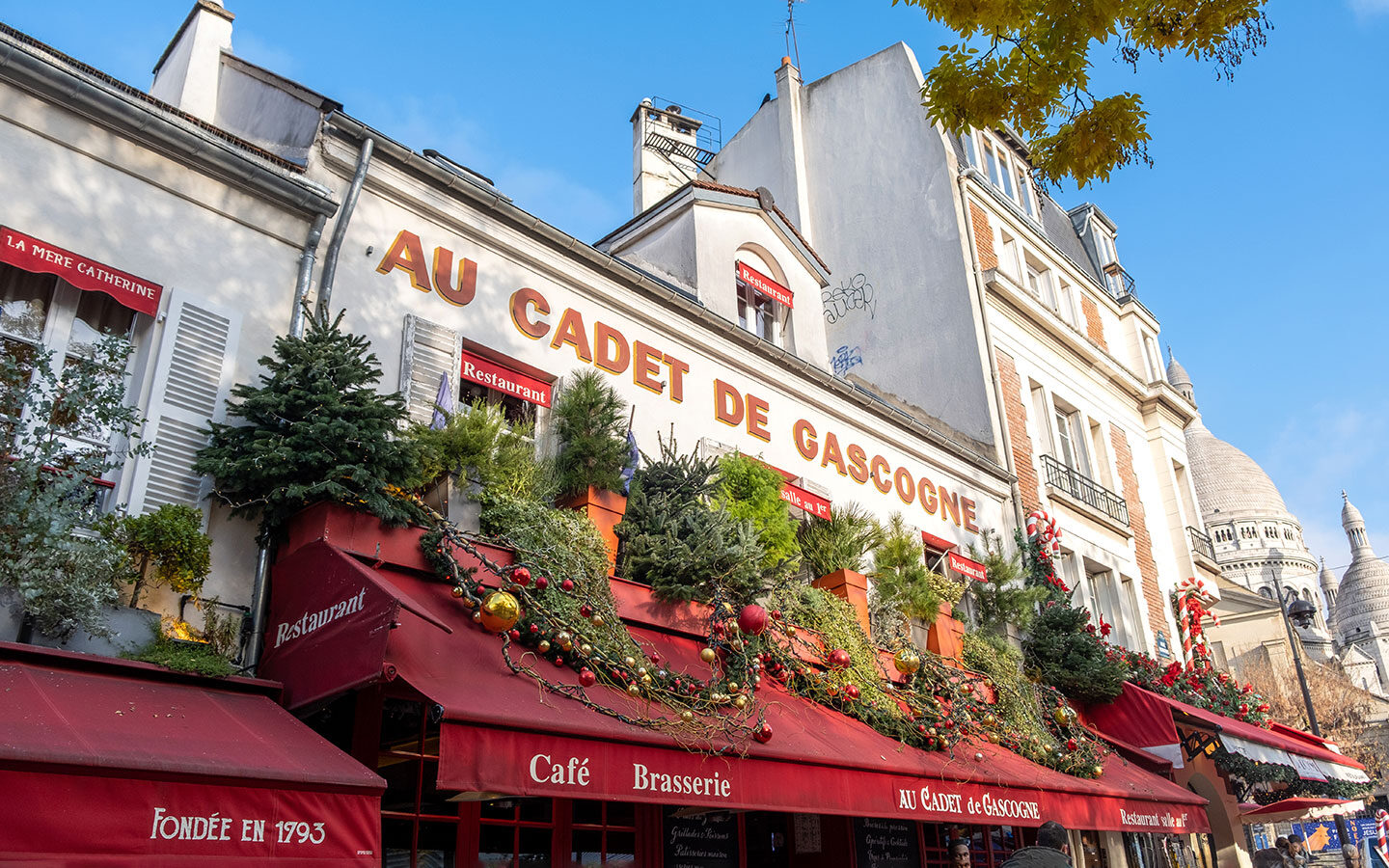
The hilltop neighbourhood of Montmartre, Paris , is one of the city’s most popular tourist spots. But not too long ago it was synonymous with drinking, dancing and debauchery. In the mid-19th century, Montmartre was just outside Paris’ city limits so it was free of the city’s taxes and controls and evolved into a bohemian, artistic enclave.
The artists you’ll see now are more likely to be caricaturists and painters capturing tourists in the Place du Tertre than Impressionists drinking absinthe in their atelier. But the area still has the feel of a charming small village within a big city, and this self-guided walking tour of Montmartre takes you through its historic and artistic highlights.
A self-guided walking tour of Montmartre
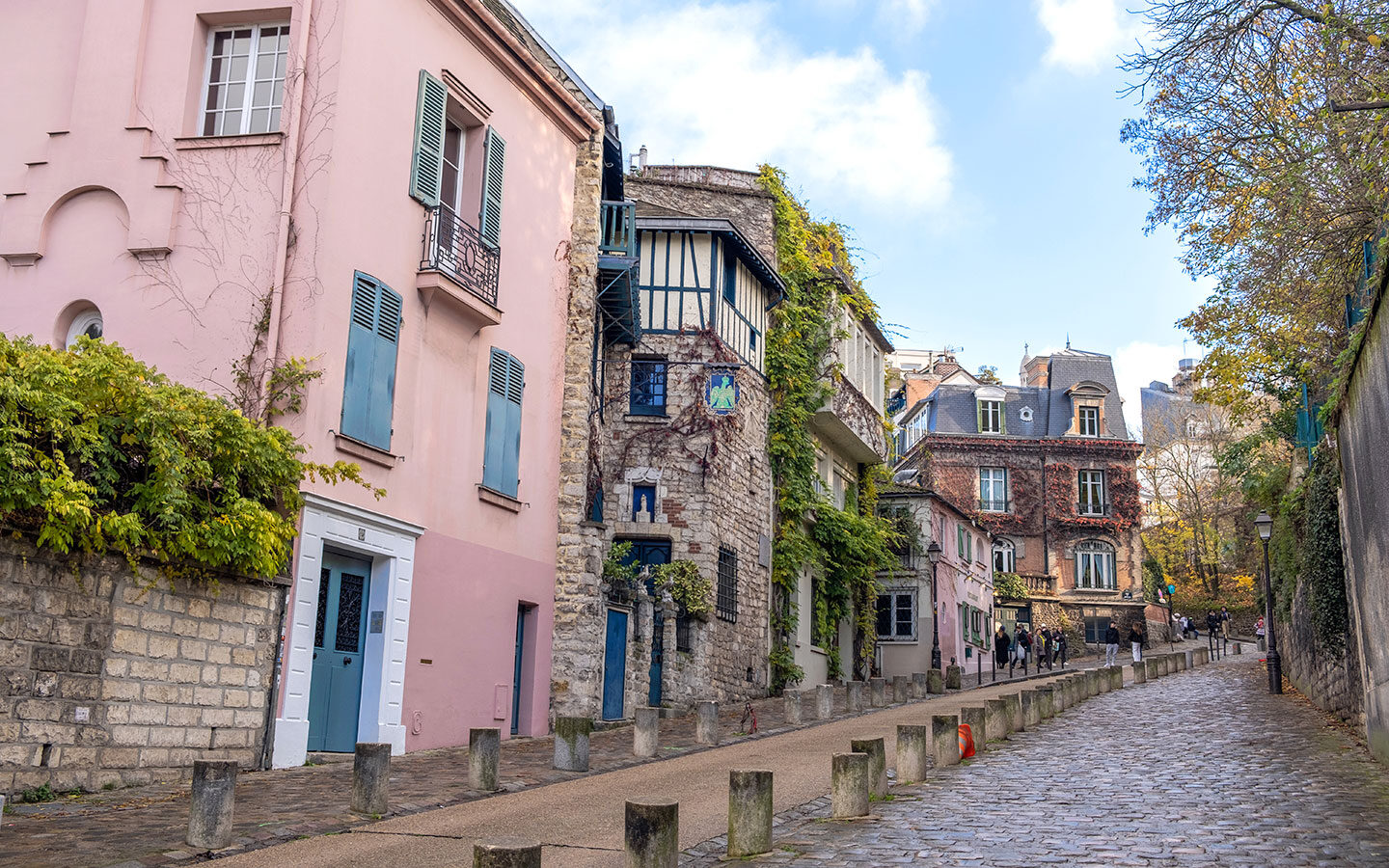
Start your Montmartre self-guided walking tour at Blanche Métro station, which is on Line 2 (or you could also take the Métro to nearby Pigalle on Line 12 which is only a five-minute walk along the Boulevard de Clichy). From there, walk up Rue Lepic – you’ll see the colourful Moulin Rouge cabaret hall on your left, home of the can-can.
Café des Deux Moulins
If you’ve seen the film Amélie then you might recognise a few of the shops along Rue Lepic, including the Café des Deux Moulins on the corner of Rue Cauchois. In the film, the main character Amélie Poulain, played by Audrey Tautou, worked here as a waitress.
The tobacco counter that featured in the film might not be there any more, but the café still has that classic Parisian bistro feel with its dark woodwork, red booths and zinc counters. There are a few nods to the film too, with a poster of Amélie on the wall and a tasty crème brulée d’Amélie on the menu if you’re in need of a sugar hit.
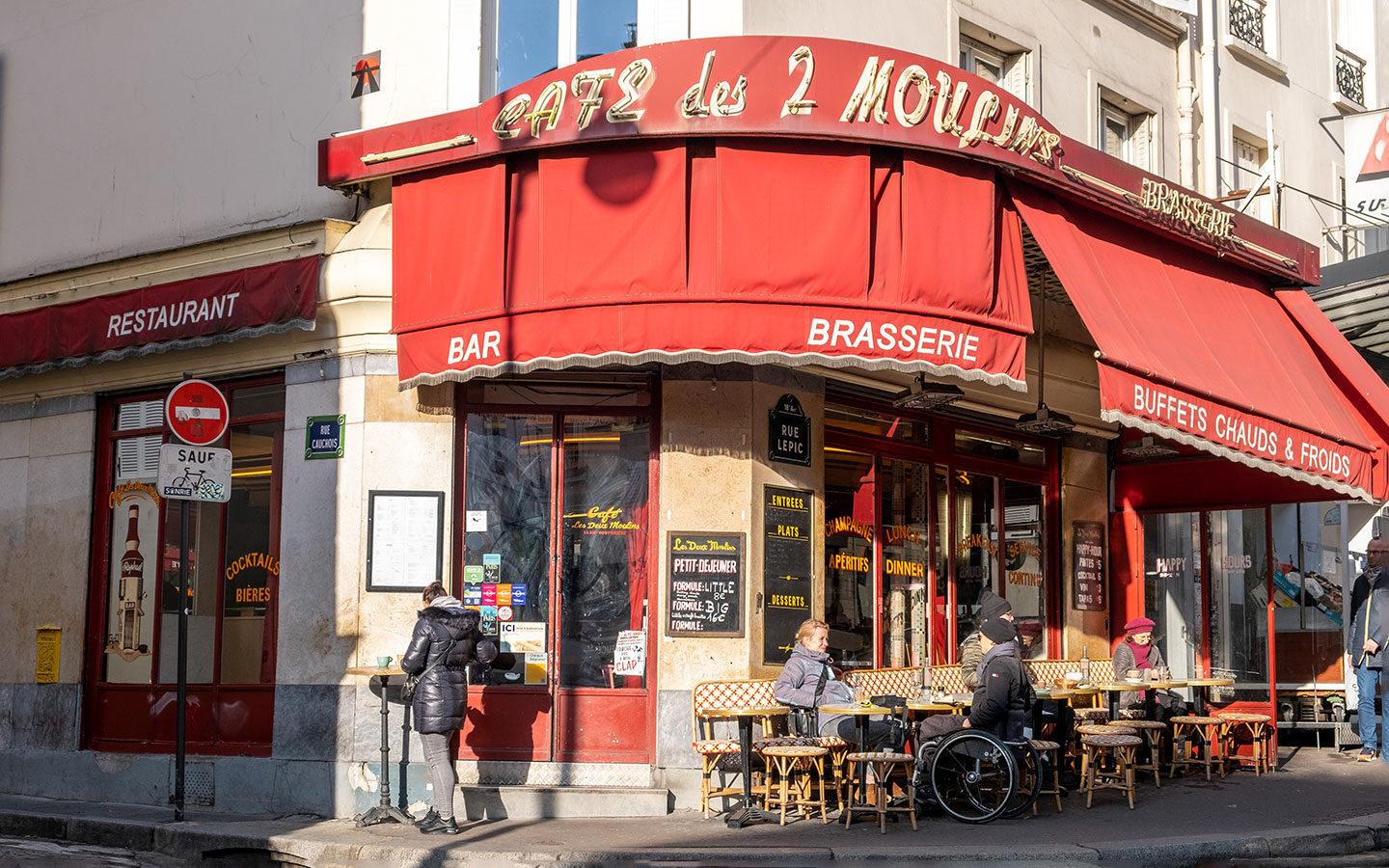
Carry on along Rue Lepic, then when you come to the junction at the end, take a short diversion to the left to see the exterior of number 54 Rue Lepic. This was where Vincent Van Gogh lived with his brother Theo from 1886 to 1888, and he did several paintings of the view of Paris from the window of their third-floor apartment.
Then retrace your steps back to the junction and continue on down Rue des Abbesses. Turn left into Rue Ravignon and follow it to Place Émile Goudeau.
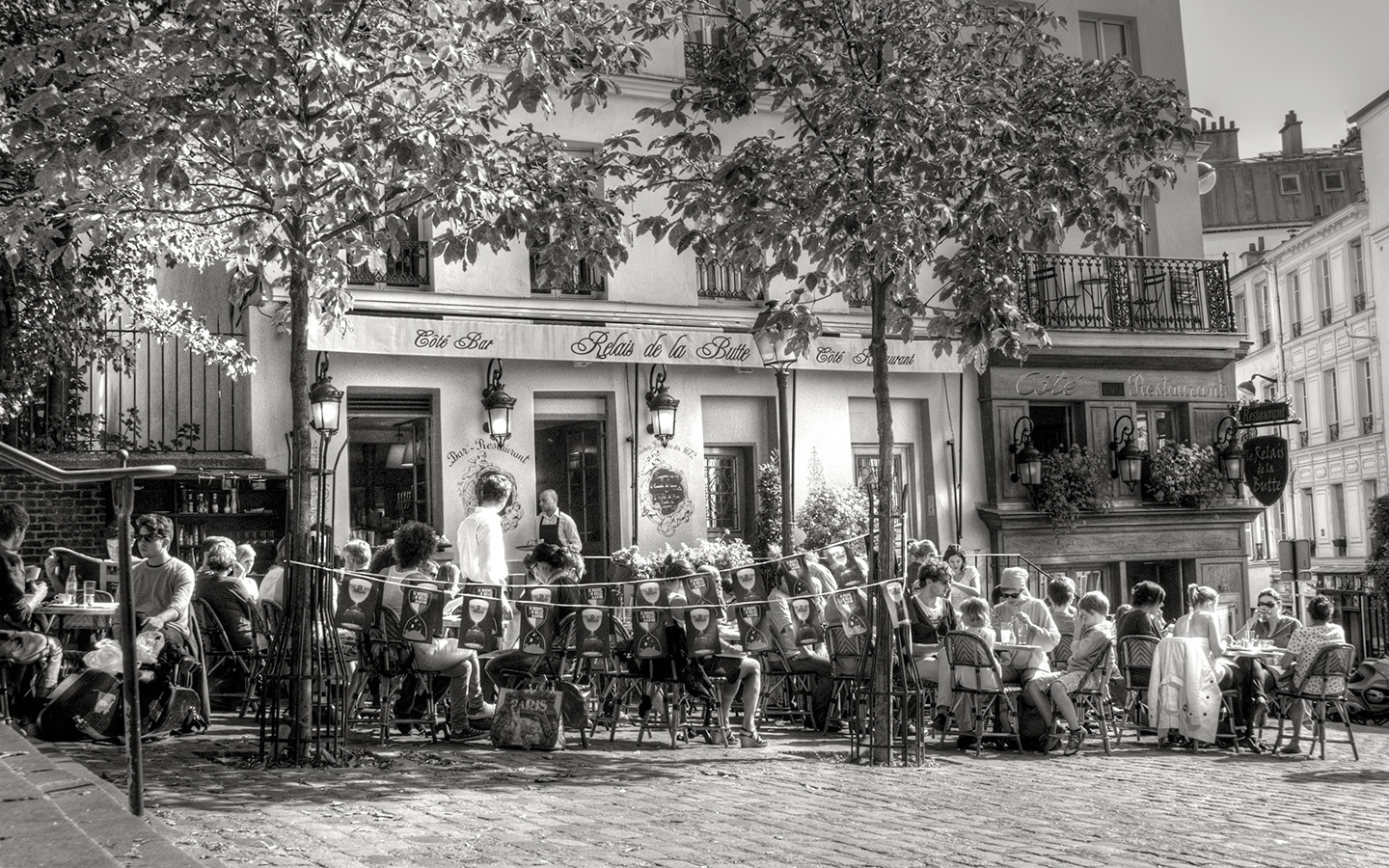
The Bateau-Lavoir
Place Émile Goudeau was at the heart of Montmartre’s art scene in 1889 as the home of the Bateau-Lavoir artists’ commune. This former factory was divided into 20 small studios. It was dark and dirty, had no heating and was so unstable it creaked and swayed on stormy days just like the laundry boats on the Seine that gave it its nickname.
But the Bateau-Lavoir was also was a hotbed of talent. Artists like Picasso, Matisse and Modigliani passed through its doors as well as composers, writers, actors and art dealers. They started moving out after the First World War and most of the original building was destroyed in a fire in 1970, but you can see its frontage at 13 Rue Ravignan.
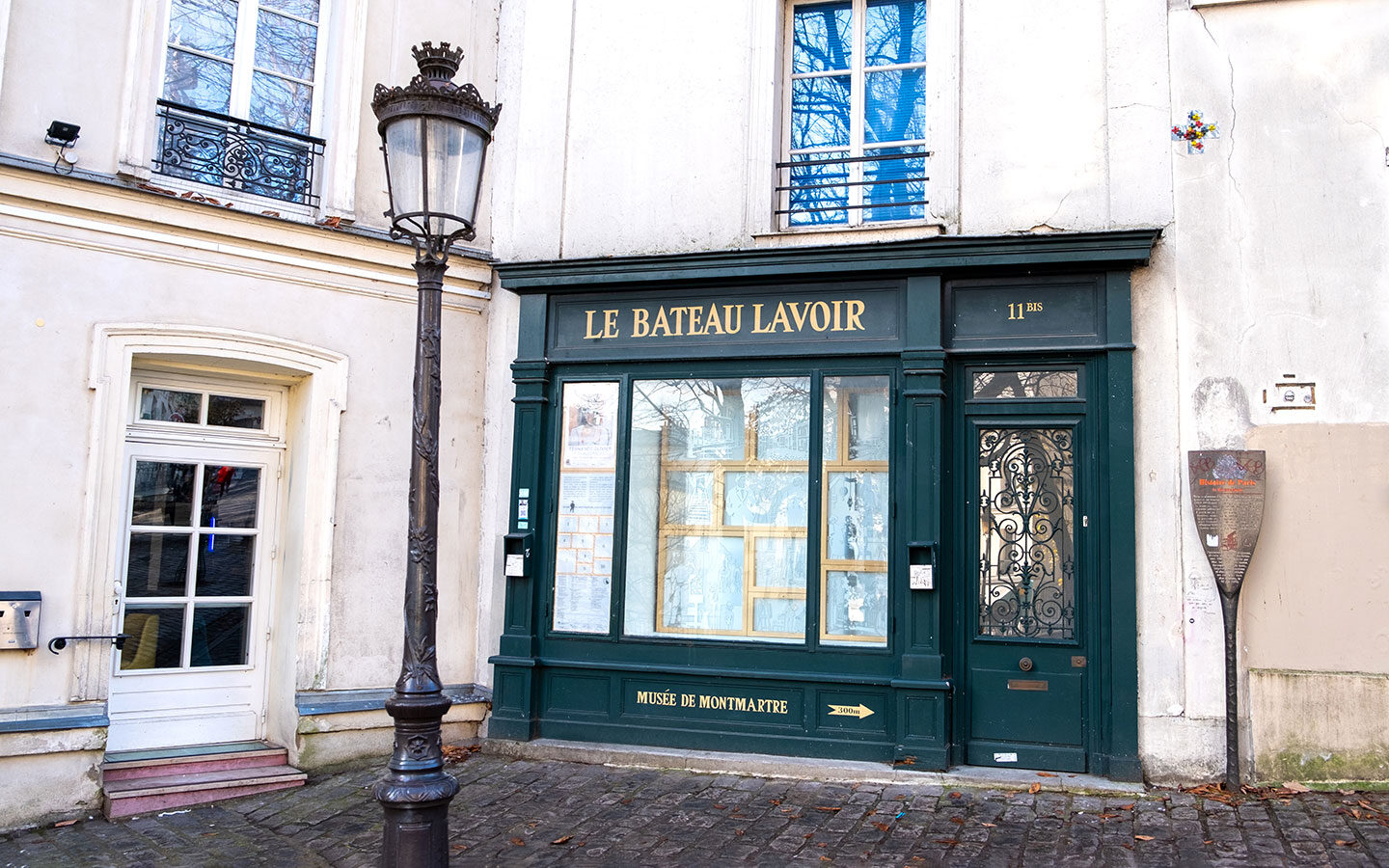
At the end of the square, take a left up Rue d’Orchampt and follow it until you reach the junction with Rue Lepic and Rue Girardon, where you’ll see a windmill in front of you.
The Moulin de la Galette
Montmartre’s 17th-century windmills originally ground grains to make the bread which gave the Moulin de la Galette its name. But they were later turned into cafés and dance halls where people could socialise with a glass of local wine and bread from the mill.
Parties at the Moulin de la Galette were popular with local artists, including Renoir whose painting Dance at Le Moulin de la Gallette is on show in the Musee d’Orsay. A smaller version sold for $78 million in 1990, making it one of the world’s most expensive paintings. The Moulin was also captured on canvas by Van Gogh and Picasso.
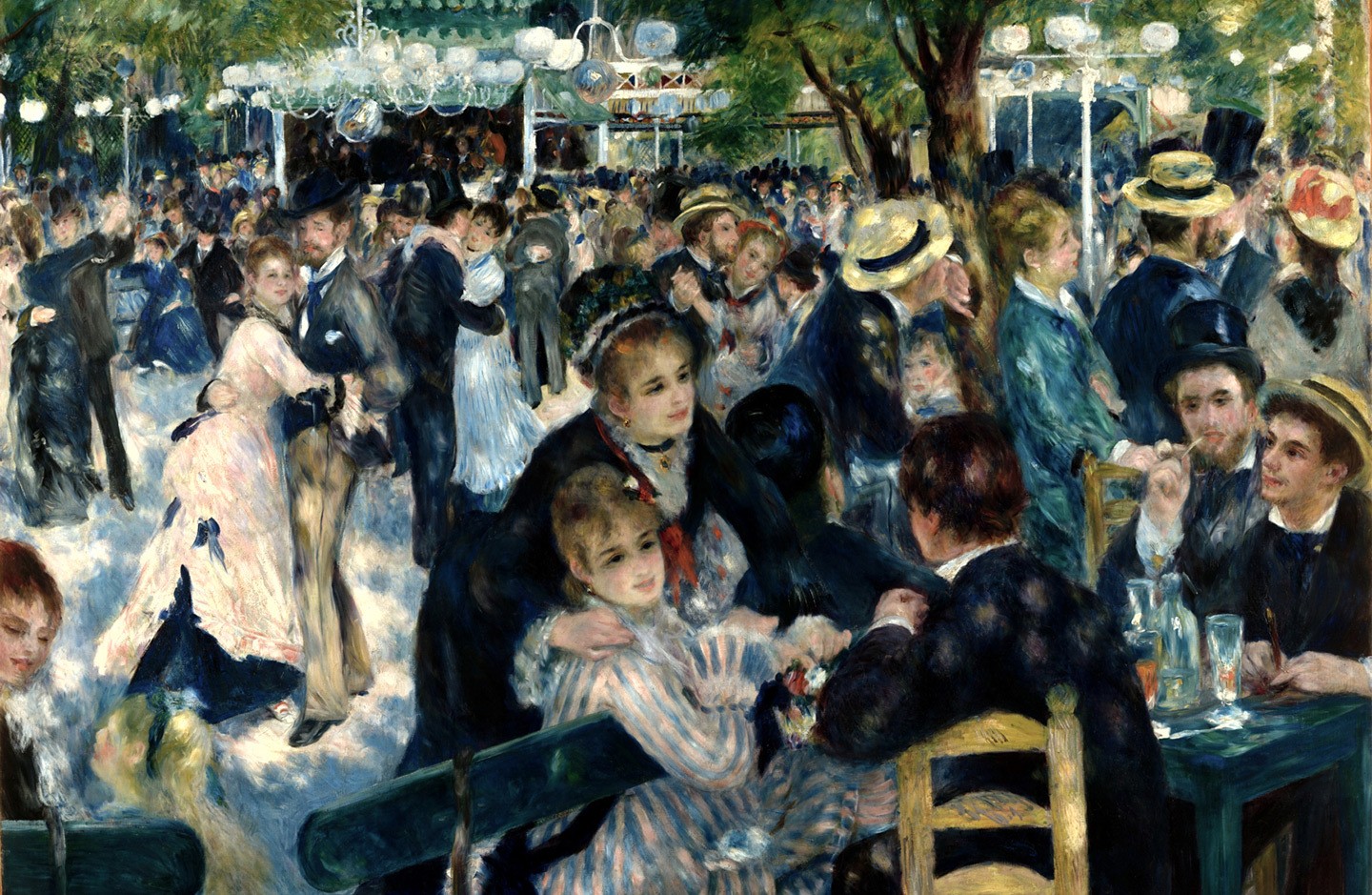
There were originally up to 30 windmills covering the hills around Montmartre, but only two are left now. The original Moulin de la Gallette (which is marked on maps as the Moulin de Blute-Fin, as that was its original name) is now private property so you can’t take a look around. But you can get a glimpse of it from Rue Lepic or Avenue Junot.
And in front of it is Montmartre’s other surviving windmill – the Moulin Radet, which was built slightly later in 1717. Today it sits on top of a restaurant (slightly confusingly) called the Moulin de la Galette , which has a terrace underneath the windmill.
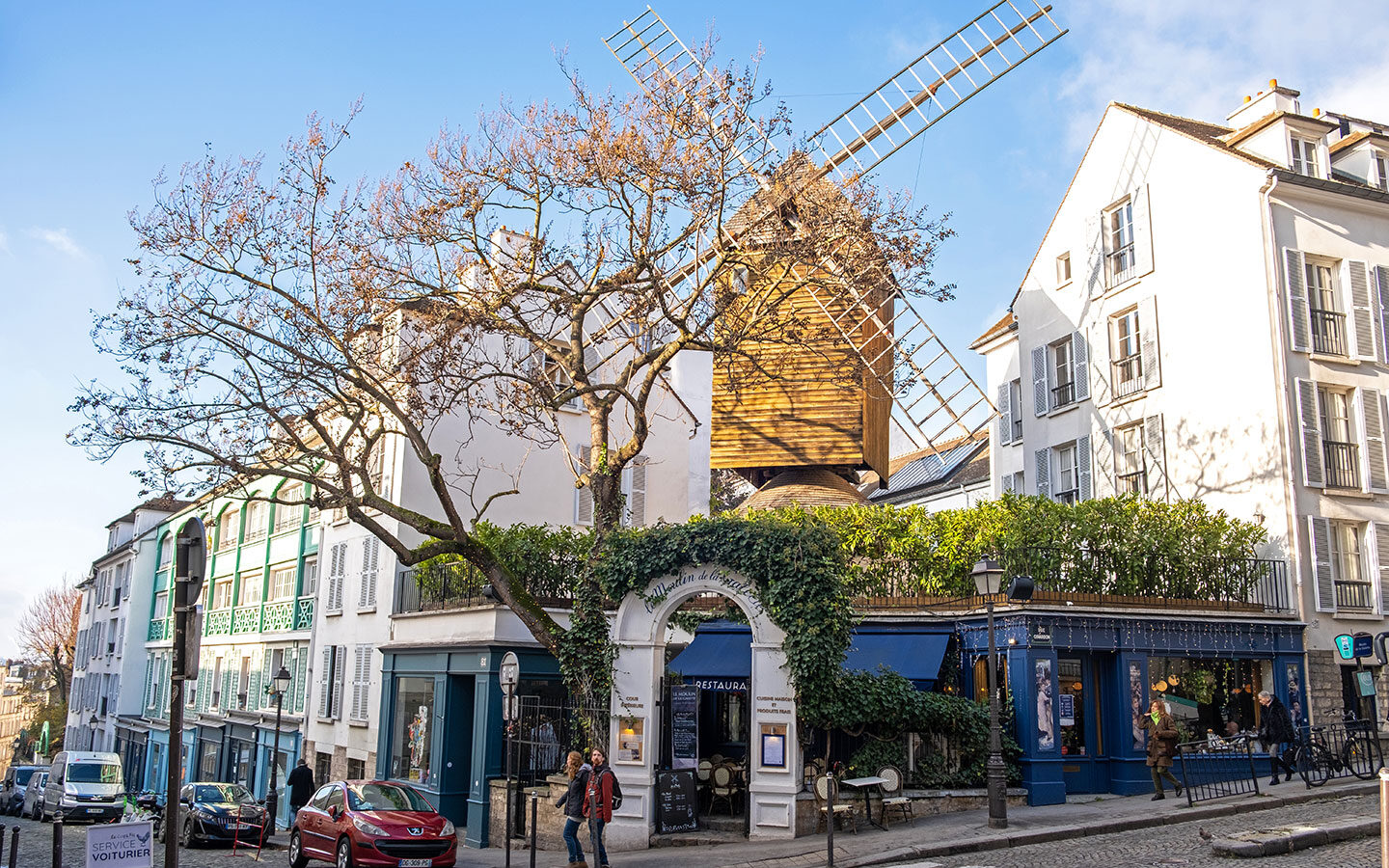
Next walk up Rue Girardon until it turns the corner into Rue de l’Abreuvoir, where you’ll see a small square with a bronze bust of a woman on your left.
Place Dalida
This tiny square is named after an Egyptian-born singer who became a huge star in France during the 1960s and 70s. Dalida – originally named Iolanda Cristina Gigliotti – lived on Rue de l’Abreuvoir and is commemorated with a bronze statue in the square.
She sold millions of records, but her life was full of tragedy, and after she lost several lovers and friends to suicide she eventually killed herself with an overdose in 1987 at her house in Montmartre. Dalida is buried in Montmartre cemetery nearby. And she’s still a cultural icon in France, with films, documentaries and over 50 biographies written about her.
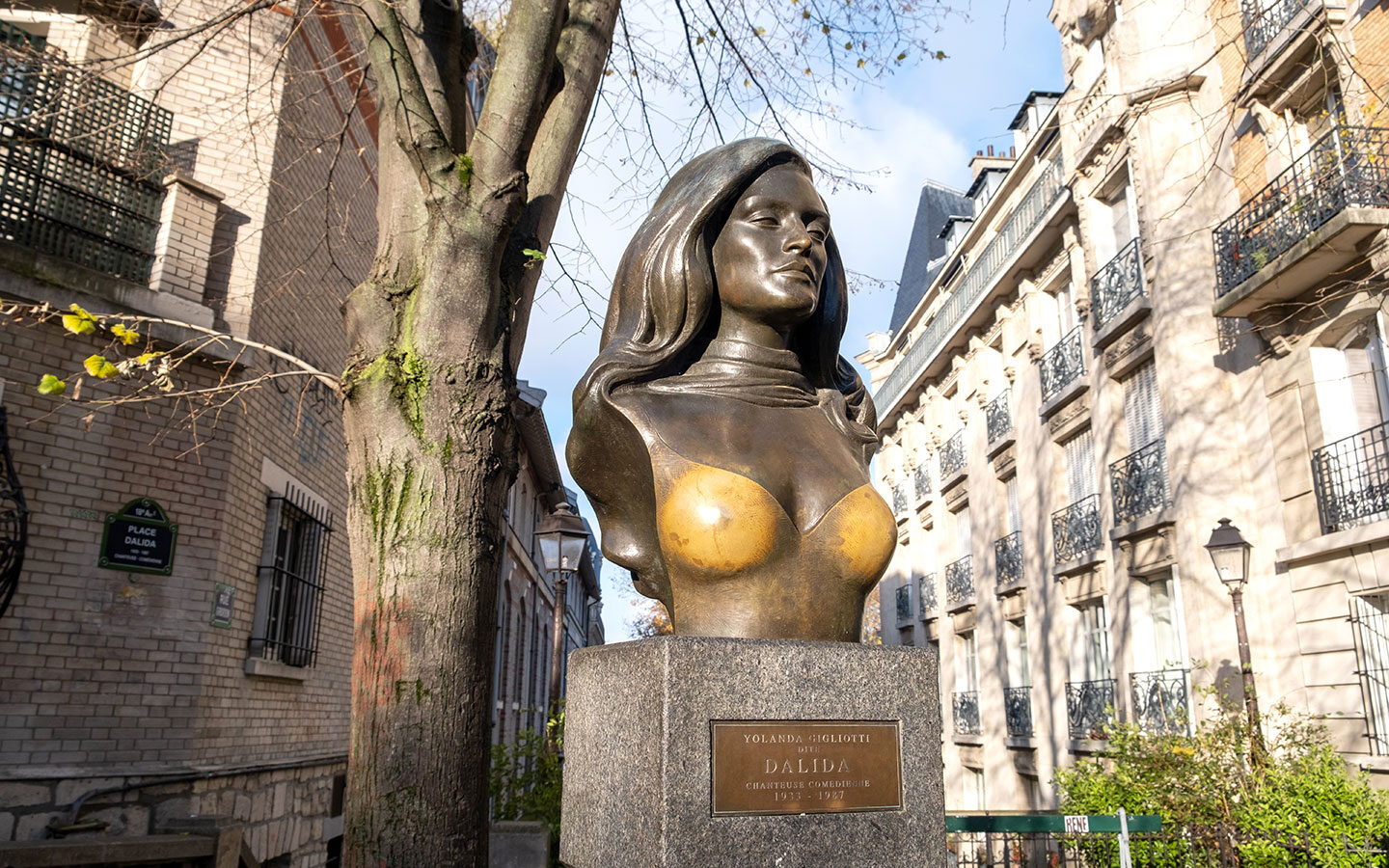
Carry on walking along picturesque Rue de l’Abreuvoir, which has great views of the white dome of Sacré-Cœur Basilica rising up behind the buildings.
Rue de l’Abreuvoir
With its ivy-covered houses, Rue de l’Abreuvoir is one of Montmartre’s prettiest streets. It’s though to be one of the oldest streets in Paris too, dating from the 14th century. Though the name (from the French for a watering trough used by livestock) came much later.
At the top of the street is La Maison Rose , a candy pink café and restaurant. It was once the home of Catalan painter Ramon Pichot, who turned it into a restaurant which hosted his friends Salvador Dali and Picasso. It was also painted by artist Maurice Utrillo. Today it’s a favourite for Instagrammers and a filming location for TV series Emily in Paris .
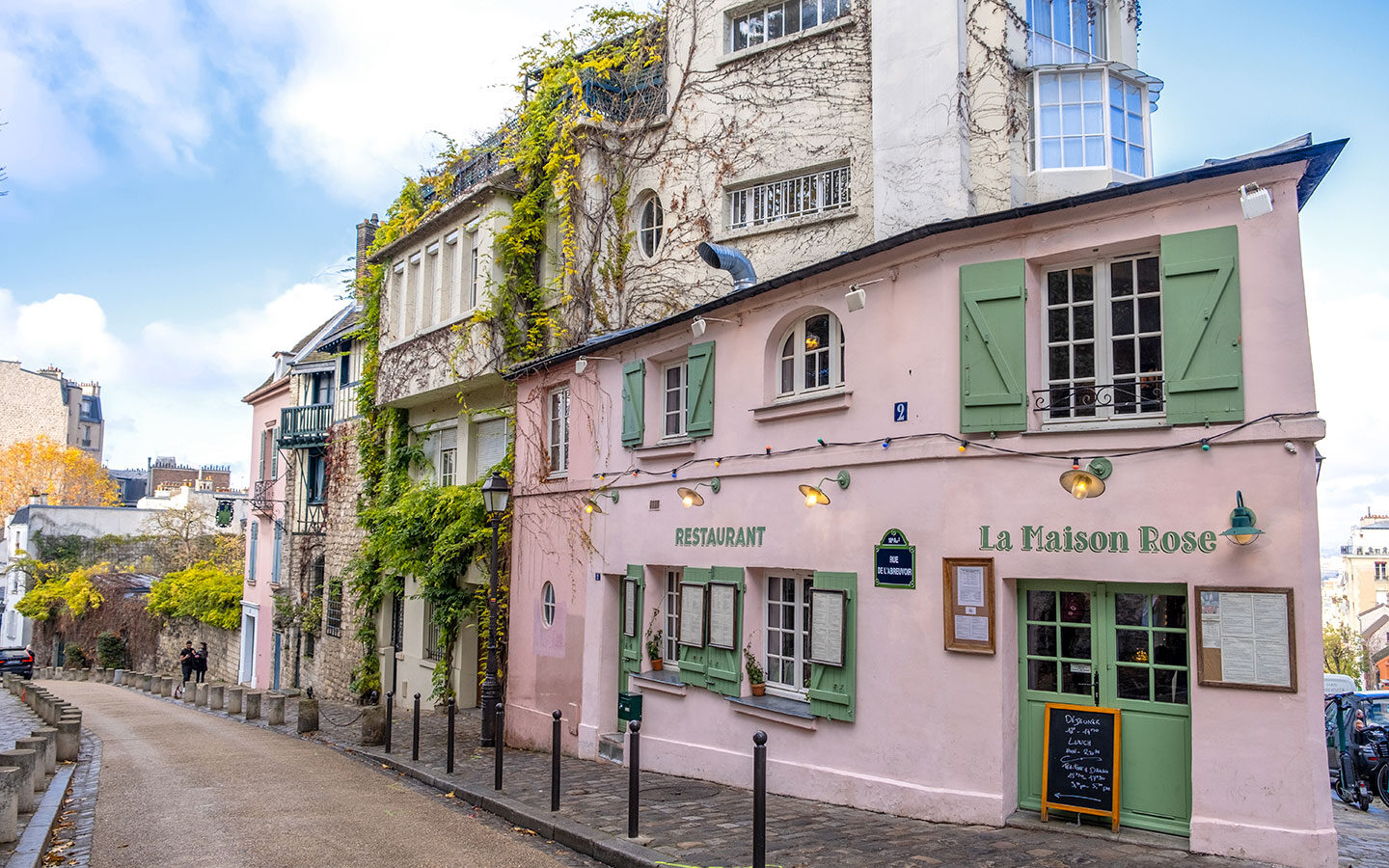
Once you reach the end of Rue de l’Abreuvoir, turn left and take a short diversion down Rue des Saules to see Paris’ last remaining vineyard.
Clos Montmartre
Vines have been grown in Montmartre since the Romans, who built a temple here dedicated to Bacchus, the god of wine. Most of the vineyards were sold off for development over the years, but 1500m² of vines were saved by a group of artists in the 1930s.
The Clos Montmartre vineyard produces 1500 half-litre bottles of wine each year, which are auctioned off for charity. They’re not France’s finest wine, but get snapped up for the novelty value. You can visit the vineyard during the Fête des Vendanges , a five-day celebration of French food and wine each October with stalls, parades and fireworks.
Just past the vineyard you’ll see the orange building of the Lapin Agile . This has been a cabaret since the mid-19th century and got its name from their speciality sautéed rabbit. Past regulars included local artists Picasso, Modigliani and Utrillo.
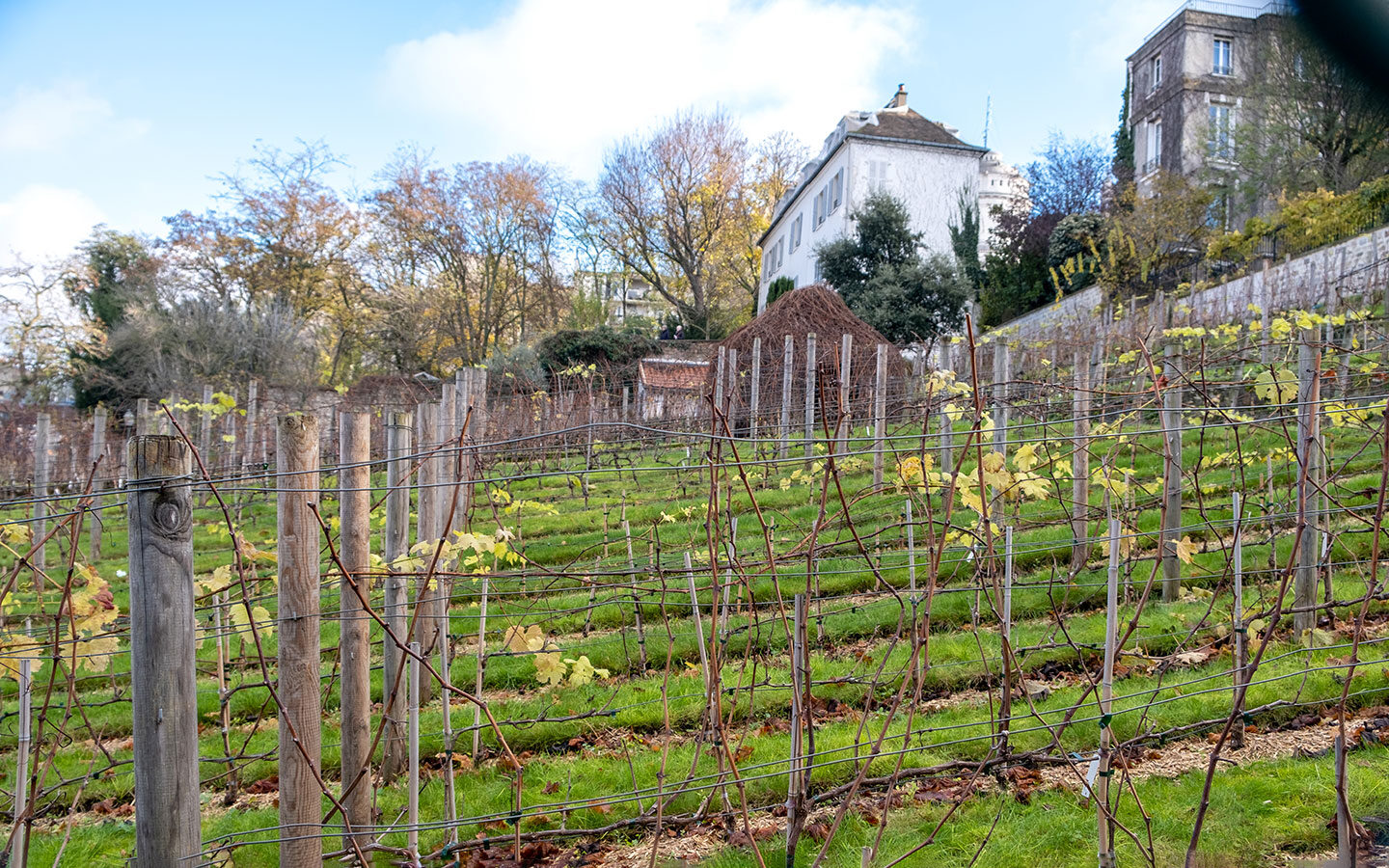
Backtrack to La Maison Rouge, where you can turn left into Rue Cortot to visit the Musée de Montmartre * if you want to find out more about the area’s history. Otherwise head south down Rue des Saules and left along Rue Norvins past the pretty Le Consultat café – another Montmartre Instagram hotspot – to the Place du Tertre.
Place du Tertre
The Place du Tertre was once the centre of Montmartre village, located on the site of an old Benedictine Abbey. Singers, musicians and artists would gather there, and it’s still one of the city’s artistic hubs. You can wander around and watch the artists in action painting a mix of Parisian street scenes, portraits, caricatures and silhouettes.
Competition for a pitch in the square is so fierce that there’s a 10-year waiting list. Each artist only gets a tiny one-square-metre space to work in, and you don’t even get it to yourself – each spot is shared between two different artists who use it on alternate days. It’s a good spot for people watching, with café terraces all around the square.
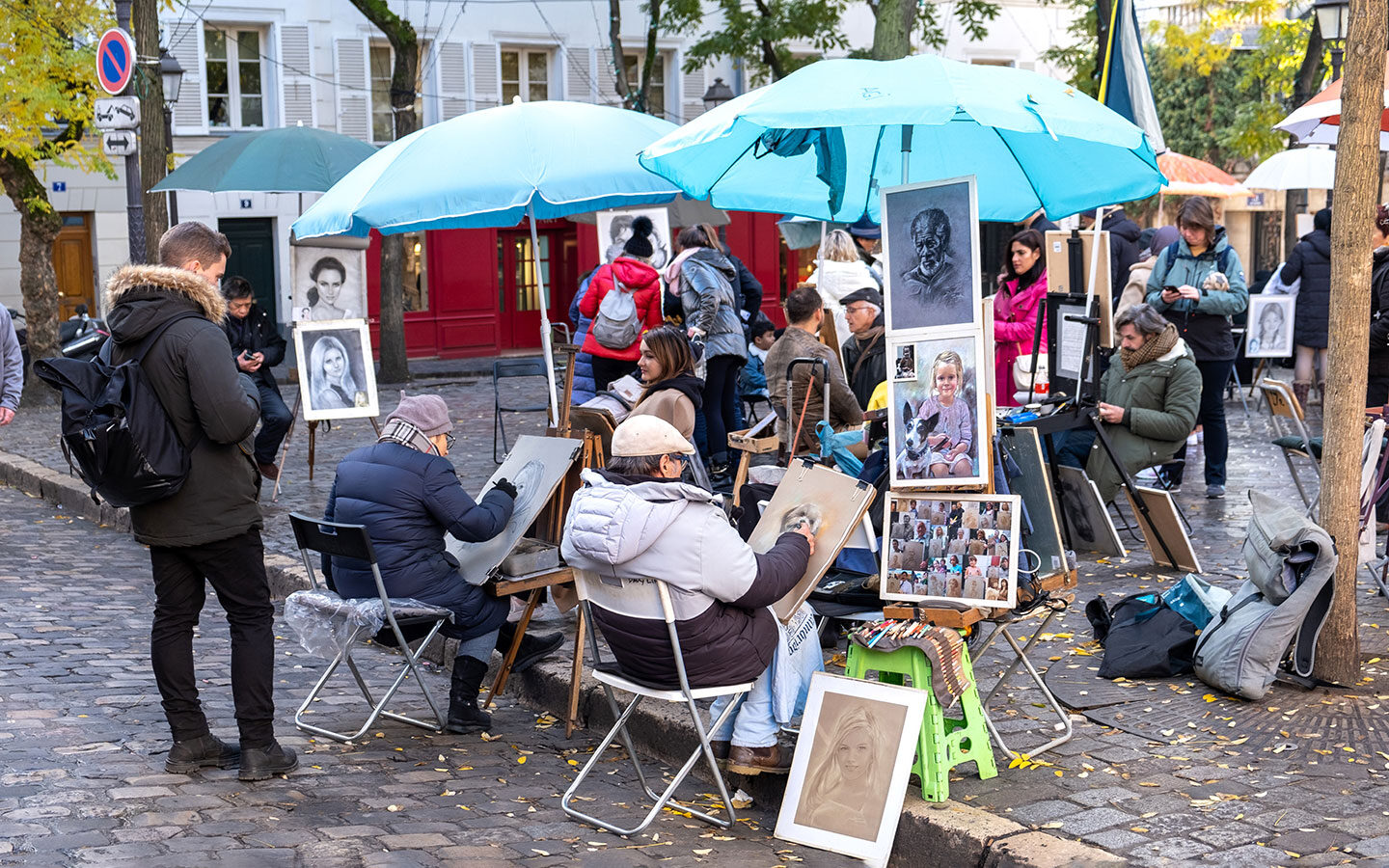
Leaving the Place du Tetre behind you, take the Rue du Mont Cernis then turn left into Rue Azais and follow it along the edge of the park to Sacré-Cœur Basilica.
Sacré-Cœur Basilica
Sacré-Cœur was built between 1876 and 1912 to honour the victims of the Franco-Prussian war, using travertine limestone that’s designed to get whiter as it ages. It’s a real mix of architectural styles which was a bit controversial at the time – some people described it like a gaudy giant wedding cake – but it’s grown on Parisians as time’s gone by.
The steps outside the front of Sacré-Cœur are one of Paris’ best viewpoints , with the city stretching out in front of you. You can climb up 300 spiralling stairs to the top of the basilica’s tower for an even higher view. There also a huge golden mosaic of ‘Christ in Majesty’ behind the alter inside, and a crypt which allegedly contains Christ’s heart.
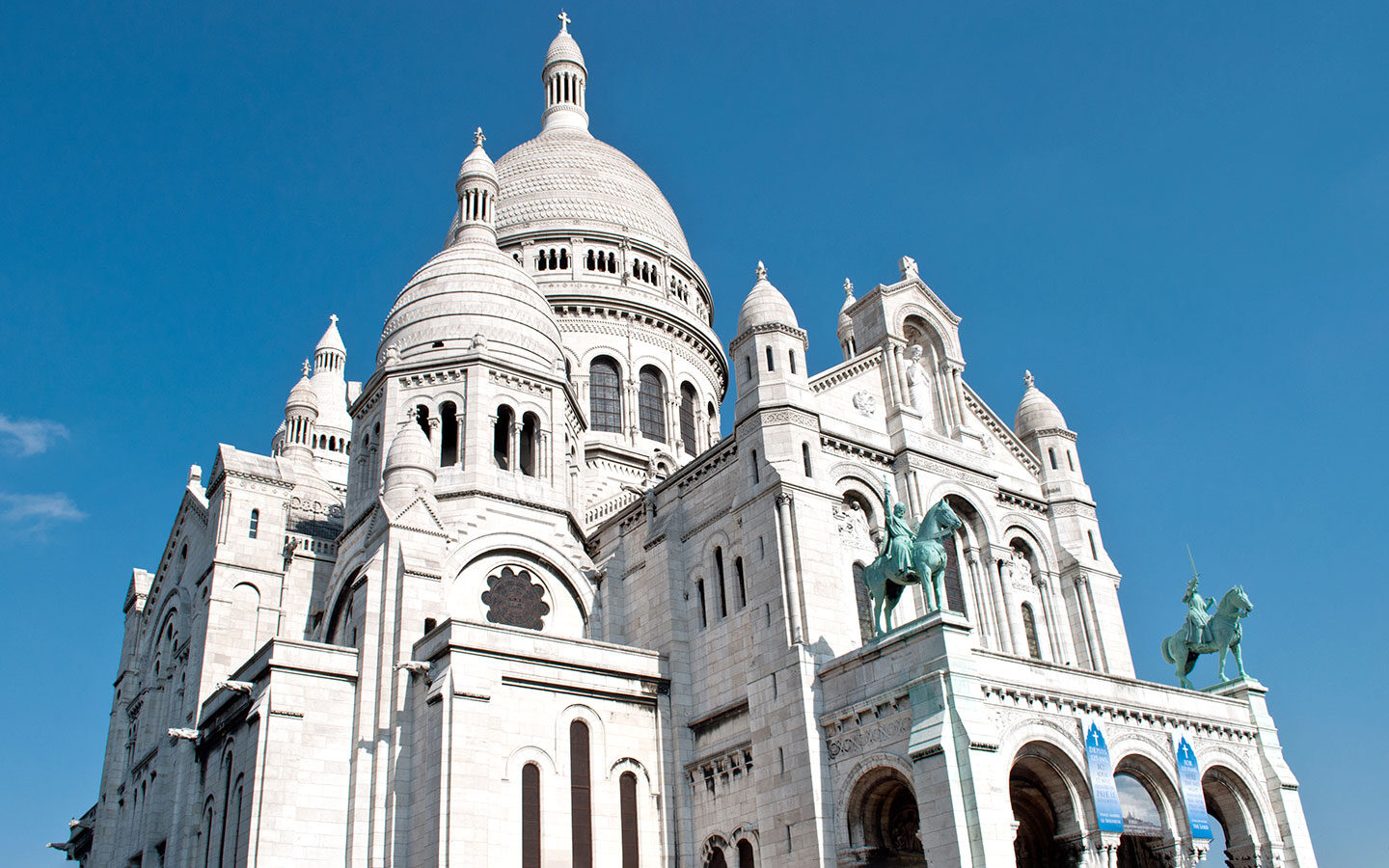
Walk down the steep lawned area in front of Sacré-Cœur, which is packed full of sunbathers, picnickers and street performers on sunny days. Then turn right at the bottom of the hill into Rue Tardieu and go straight on to Abbesses Métro station.
Mur des je t’aime
Finish your self-guided walking tour of Montmartre at the Le mur des je t’aime (Wall of Love) in Square Jehan Rictus, just behind the entrance to Abbesses Métro station. The wall is made up of 612 tiles which say ‘I love you’ in 250 different languages. It’s a favourite selfie spot for loved-up couples, honeymooners and wedding photoshoots.
From there you can catch the Métro Line 12 on around Paris. Or find a café or bar to finish off your walk with a drink – GCD Montmartre is a good wine bar on Rue Durantin or Marlusse et Lapin on Rue Germain Pilon is a quirky cocktail bar.
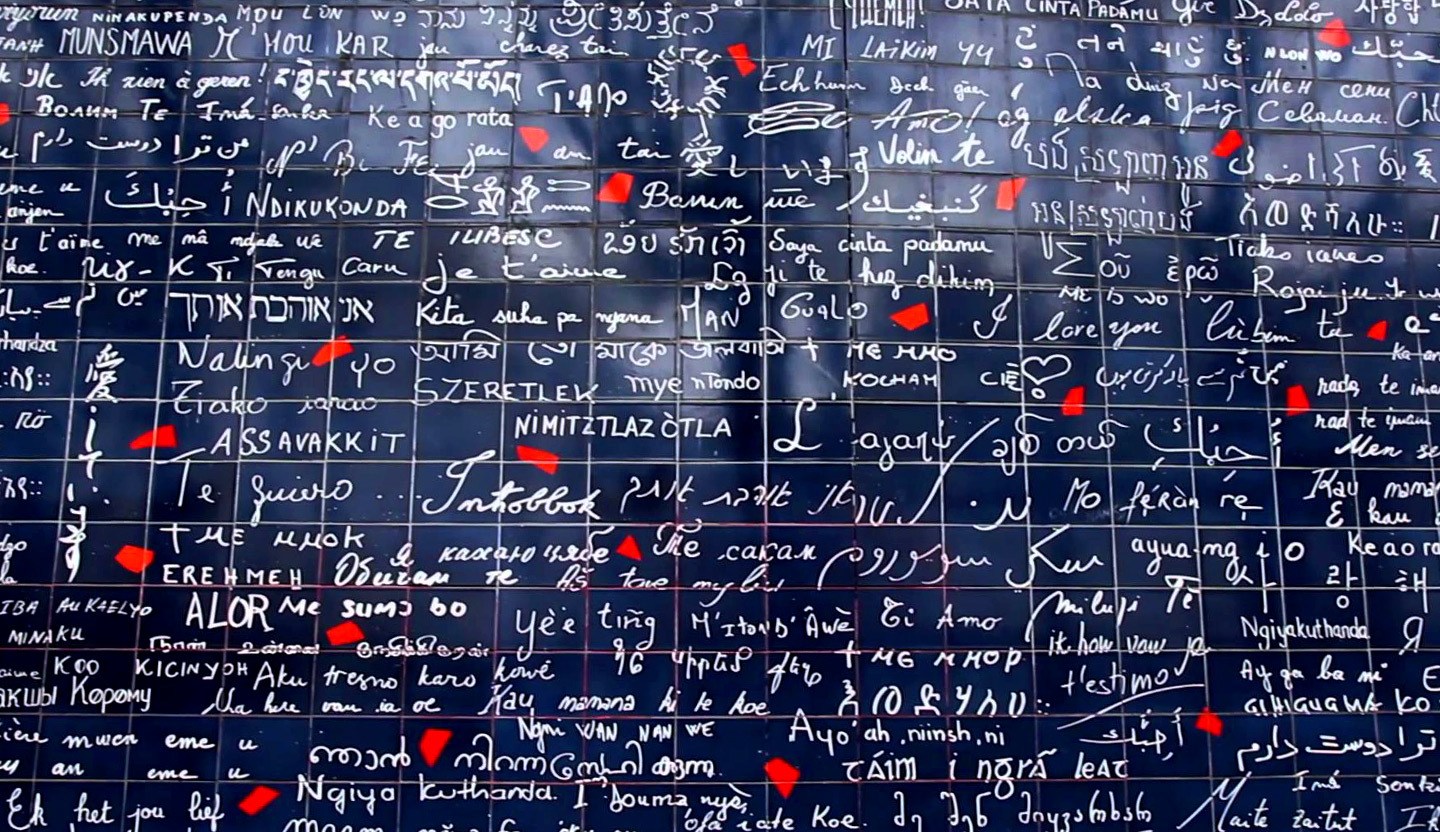
Self-guided Montmartre walking tour map
If you’d like to do this Montmartre walk yourself, click on the map below to access directions through Google maps. The route is just over 2.5km (1.6 miles) and takes 35 minutes to walk straight through, but allow a couple of hours to include stops.
It’s not a particularly challenging walk, though there are hilly sections, and Montmartre has some cobbled streets so trainers or walking shoes are a good idea.
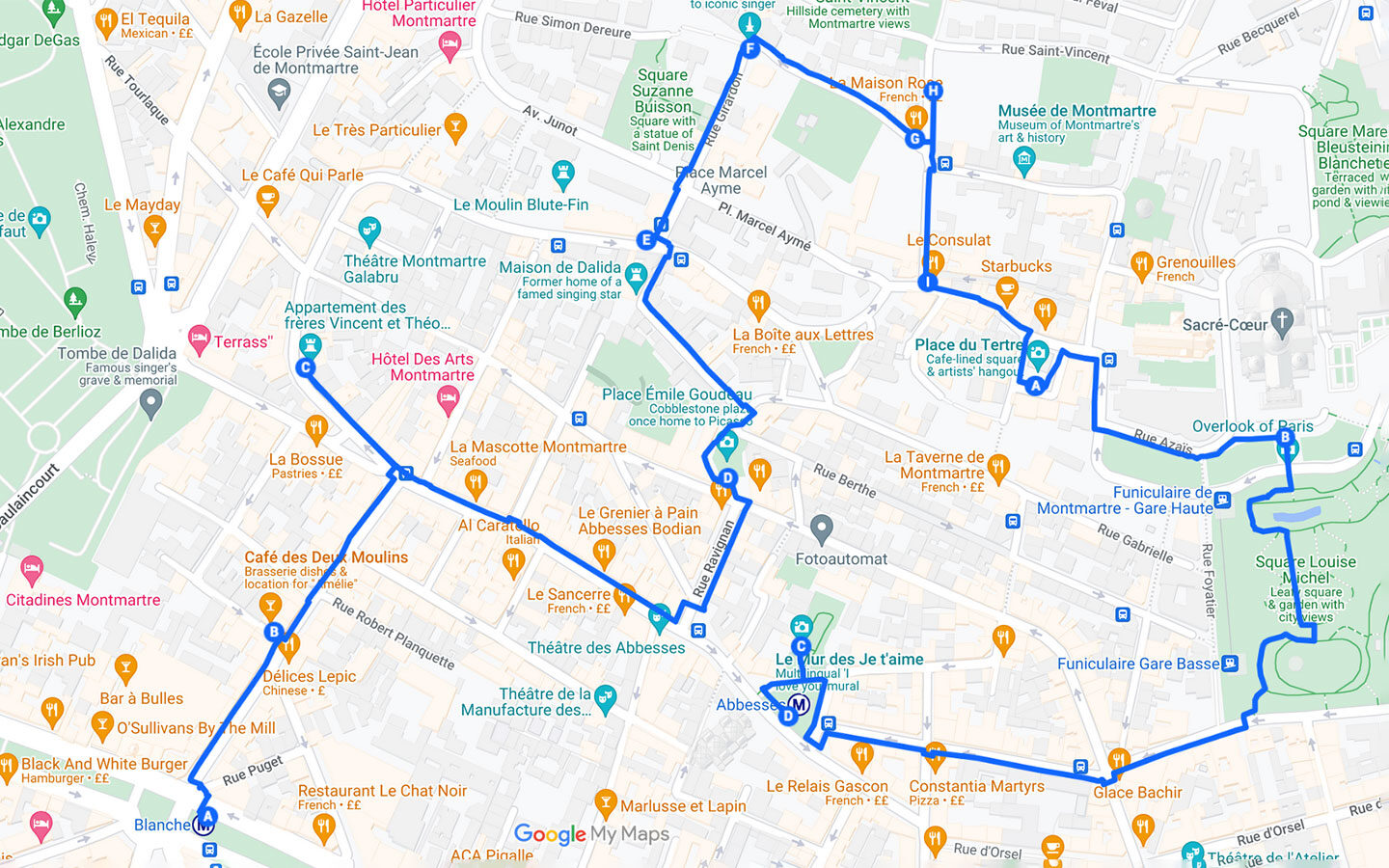
Looking for somewhere to stay in Paris?*
Save for later
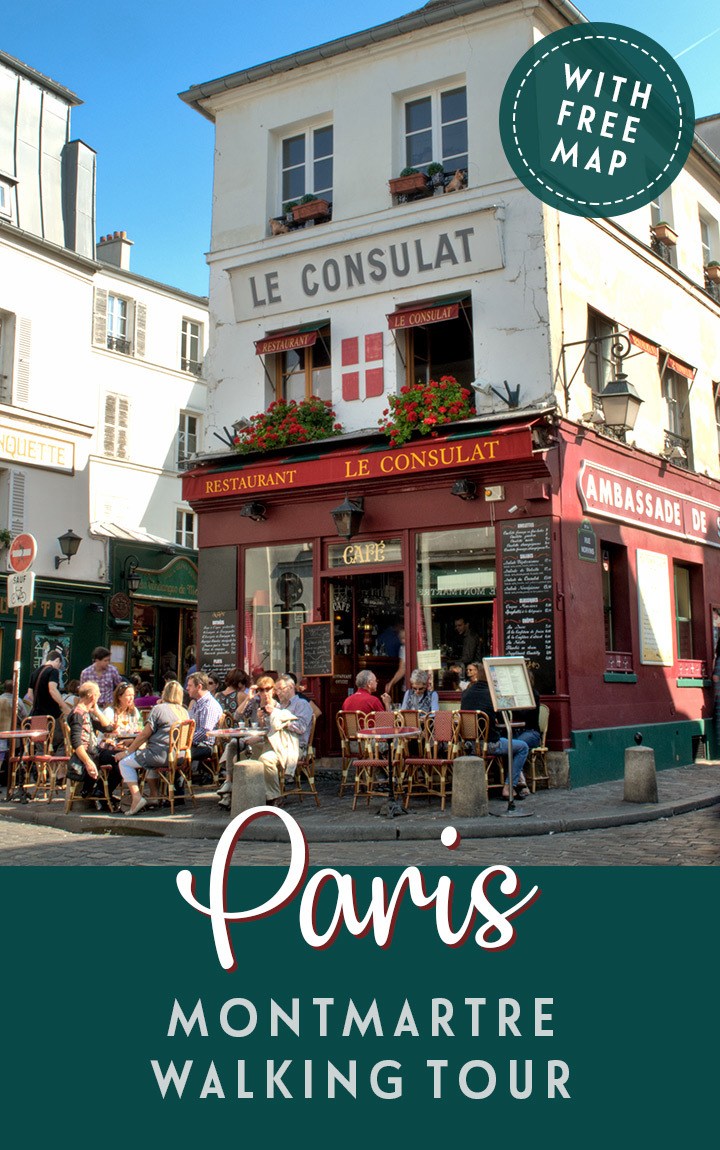
You might also like
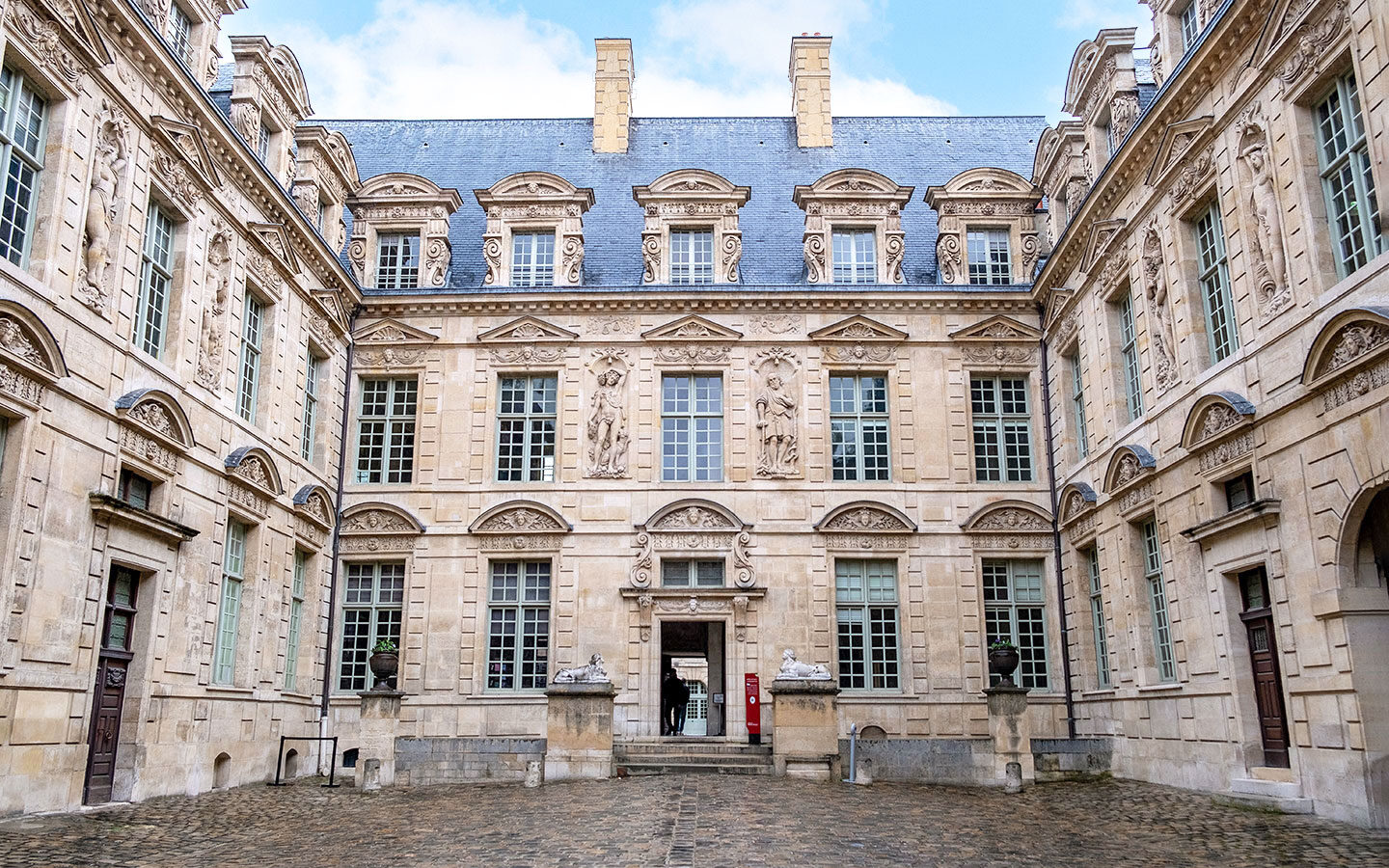
Free self-guided Marais walking tour, Paris
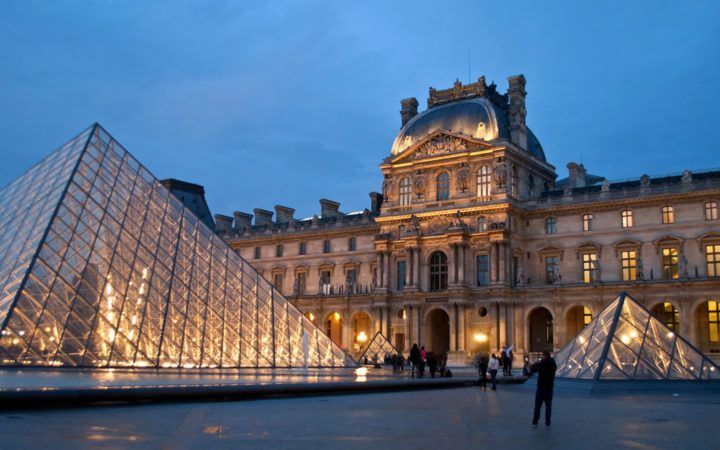
Alternative things to do in Paris
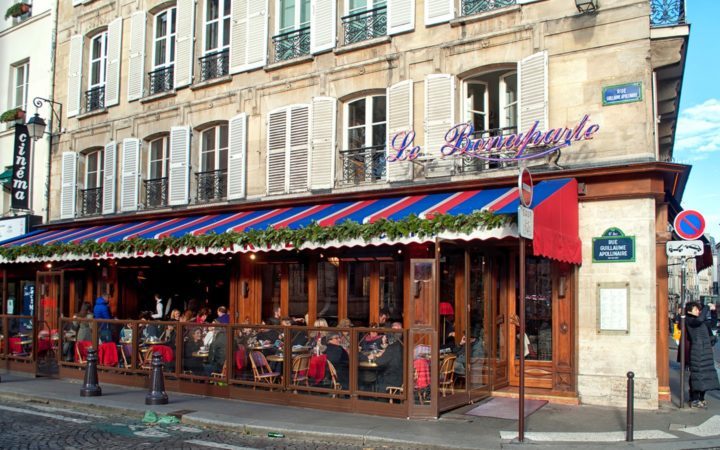
Free self-guided St Germain walking tour, Paris
Friday 15th of March 2024
Estimated time of the tour?
Lucy Dodsworth
Hi Maria, the route is just over 2.5km (1.6 miles) and takes 35 minutes to walk straight through, but allow a couple of hours to include stops.
Magda Colodetti
Tuesday 26th of December 2023
We went on a Montmartre tour today, stopping at all suggested points along the way. The route was excellent.
Saturday 30th of December 2023
That's great – really glad you enjoyed it!
Saturday 8th of July 2023
Thank you Lucy for the tour. Me and my husband learned a lot about this neighborhood. Do you have any other walking tour?
Sunday 9th of July 2023
Hi Adriana – great to hear you enjoyed it! I have a couple more Paris walks, on on St Germain (https://www.ontheluce.com/st-germain-paris-walking-tour/) and one on film locations along the Seine (https://www.ontheluce.com/paris-film-locations-walk/).
Thursday 16th of February 2023
Thank you for this route, it helped us a lot!
You're very welcome – great to hear it was useful!
Tuesday 9th of April 2019
Me and my missue are going there this weekend will defo use your map.
What other areas are good to visit?
Monday 15th of April 2019
Hi, I also love the St Germain area and the walk along the Seine is lovely – the Marais is a great neighbourhood too with lots of places to eat and drink.

Home > Paris Attractions > Stories of Old Montmartre Walking Tour – Map Included
Stories of Old Montmartre Walking Tour – Map Included
Montmartre self-guided walking tour.
This Montmartre walking tour takes you through the main sights of old Montmartre and the stories and legends behind it.
The Montmartre Hill in Paris, also known as La Butte by locals, is famous for its Basilica of the Sacred Heart, the Love Wall, and its panoramic view of Paris. However, it is also a gastronomic and cultural district with authentic charm, dotted with many picturesque stairs and old lampposts.
Montmartre was an independent village from its origins until 1860 when it was annexed to Paris. Due to the beautiful light from ‘the heights’ and the low rents, the Butte was colonized by artists in the 19th century. When walking in Montmartre at that time, you could come across people like Corot, Géricault, Renoir, Degas, Cézanne, Max Jacob, Apollinaire, Juan Gris, Vlaminck, Braque, and Picasso!
Needless to say, the history of this neighborhood is fascinating and you will learn many quirky stories and fun facts during this walking tour of Montmartre.
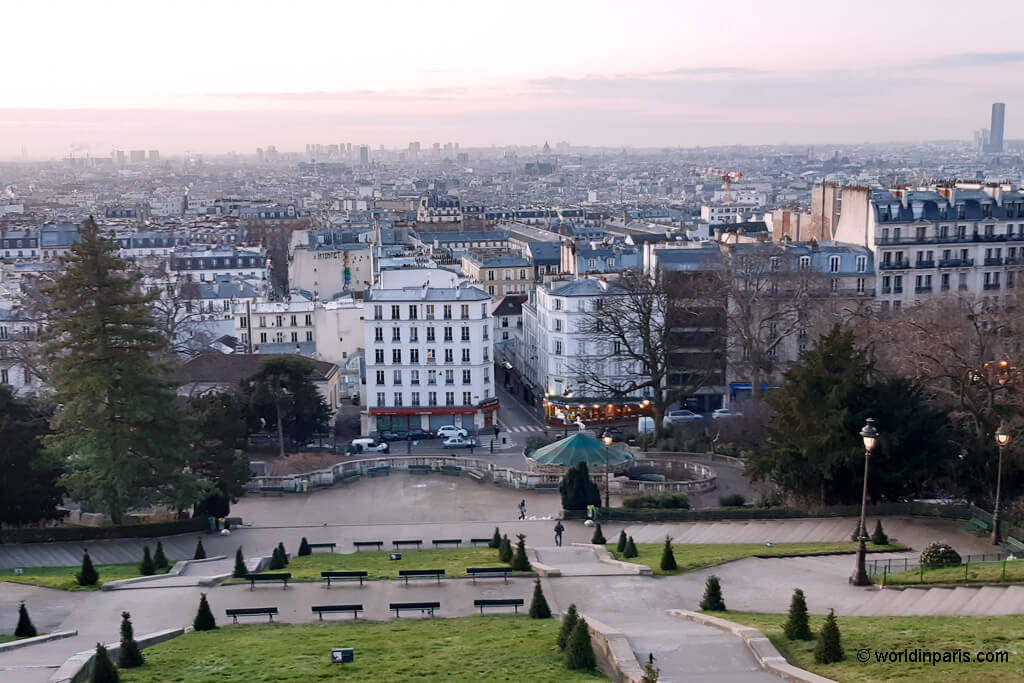
The neighborhood of Montmartre is one of the top places to visit in Paris. We recommend doing this Montmartre walking tour in the following Paris itineraries:
- 2 days in Paris itinerary
- 3 days in Paris itinerary
- 4 days in Paris itinerary
- 5 days in Paris itinerary
- 6 days in Paris itinerary
- 7 days in Paris itinerary
Montmartre Practical Information
How to get to montmartre.
Two metro lines operate within Montmartre Hill: lines 12 (green) and 2 (blue).
Montmartre is a hilly neighborhood with many staircases and cobbled streets. If you want to get to Montmartre from the airport and have a lot of luggage, we recommend booking a private transfer service like Welcome .
Where to Eat & Sleep in Montmartre?
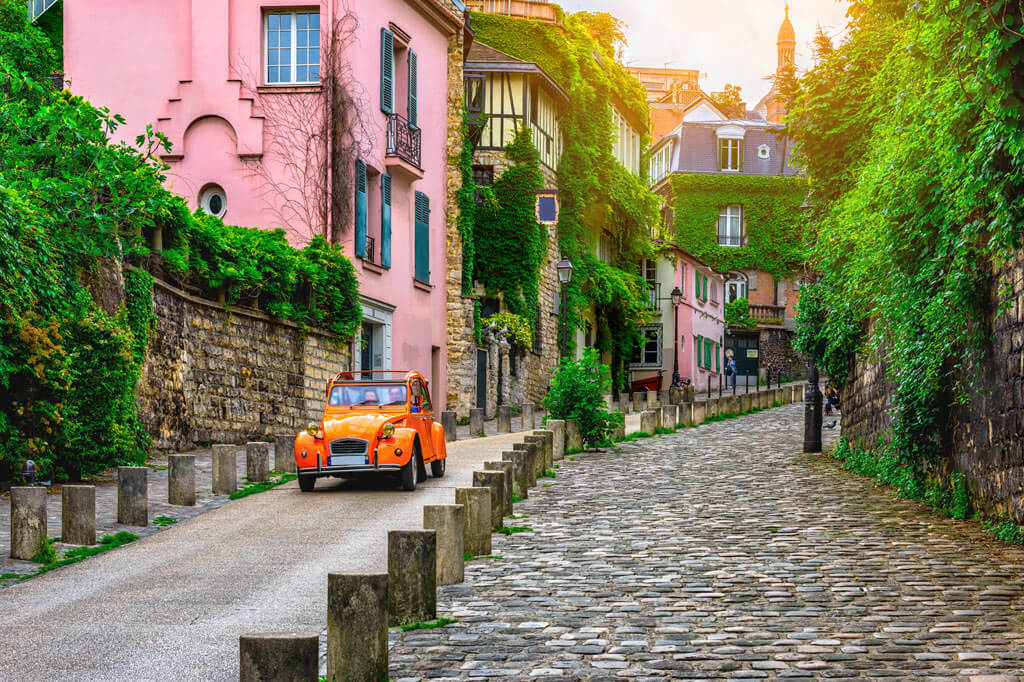
Montmartre Walking Tour Map
Walking in Montmartre is a wonder as long as there are no tourist crowds. That’s why I recommend taking this Montmartre tour early in the morning, right after sunrise, when everything is still calm and quiet.
This Montmartre self-guided walking tour starts in front of the Sacré-Cœur Basilica , in the heart of the neighborhood. The starting point (Sacré-Coeur) is marked with #1 on this Montmartre walking tour map.
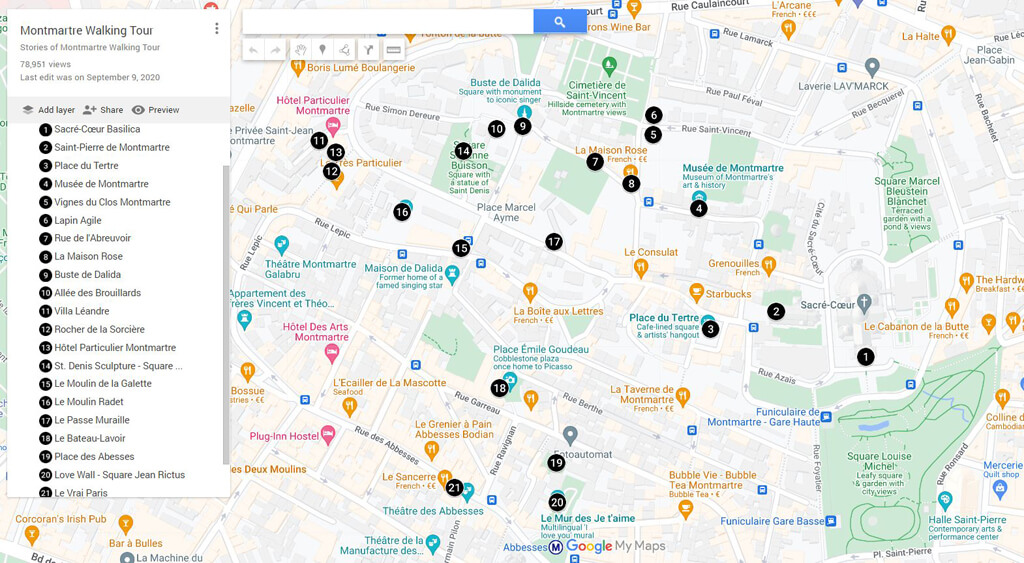
Click here to view this Montmartre walking tour on Google
Walking Tour of Montmartre – Itinerary
1. the secret of sacré-coeur’s eternal beauty.
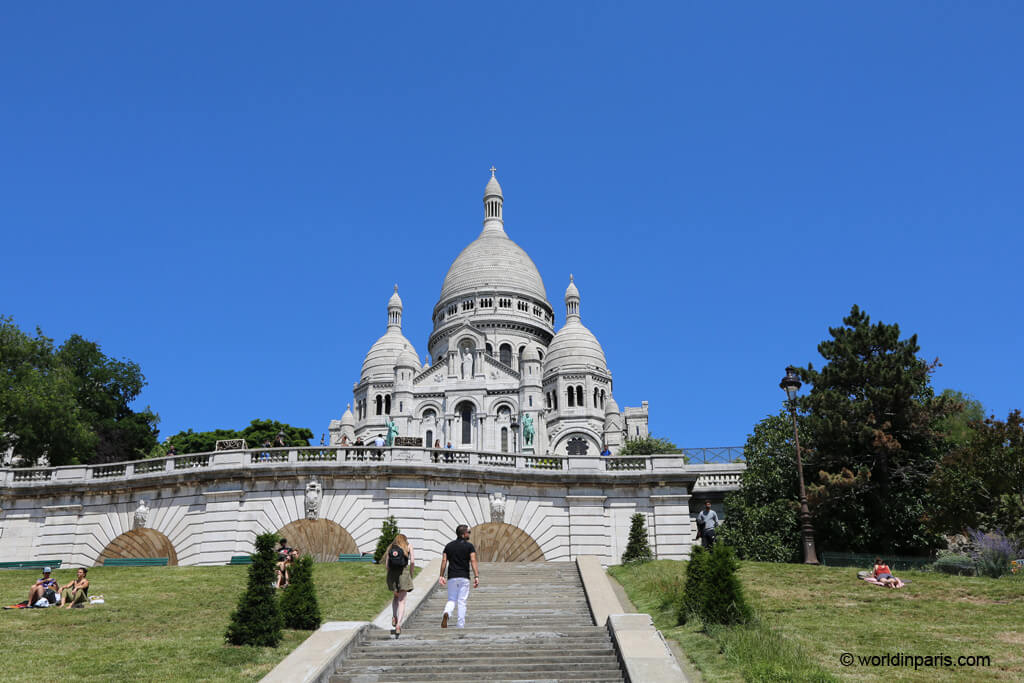
The Basilica of the Sacré-Coeur , located at the top of Montmartre Hill in Paris, is a major religious building built at the end of the 19th century. With more than ten million pilgrims and visitors per year (in 2006), it is the second most visited monument in France after Notre Dame de Paris Cathedral!
While most of the monuments of Paris tend to darken over time and are constantly subject to renovations, the Sacré Coeur is recognizable by its characteristic and unpolluted white color. How Montmartre’s symbol can stay so white?
The Sacré Coeur was built with the stone of Château-Landon, also used to build the Alexandre iii Bridge and the Arc de Triomphe. This stone has a very interesting characteristic: when it rains, it secretes a white substance in contact with water (the cullet) which flows along the walls of the building before hardening in the sun. This is Sacré- Coeur’s secret of eternal youth and the reason why it has never been renovated!
2. Saint-Pierre Church and the Myth of Saint-Denis
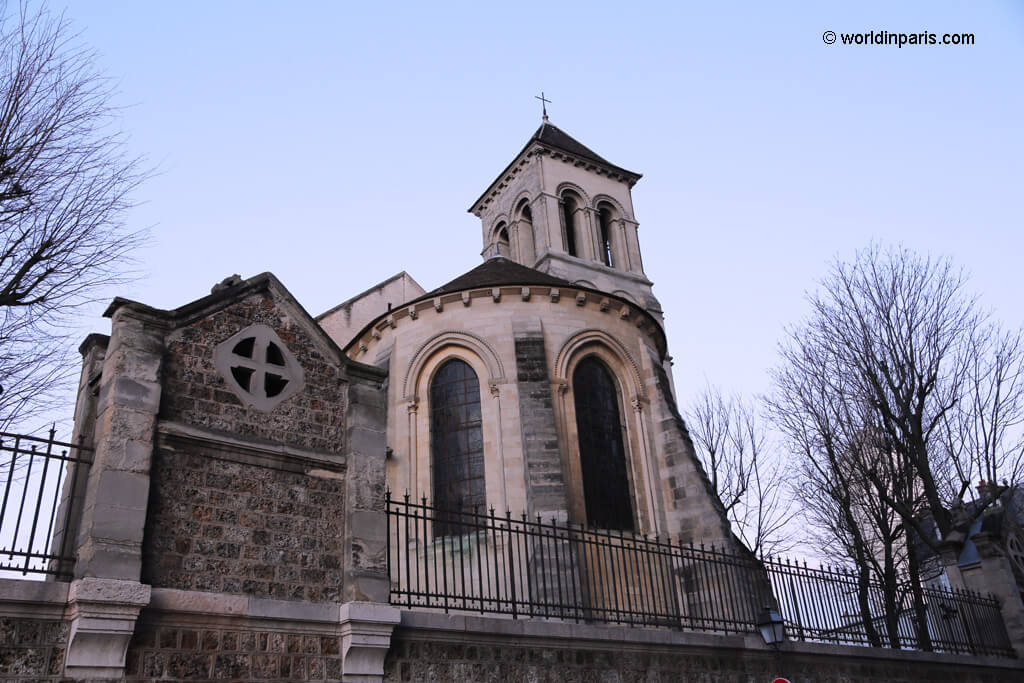
The next stop of this walking tour Montmartre is 2 rue du Mont-Cenis . Here, there’s one of the oldest churches in Paris, built in the Middle Ages.
Saint-Pierre Church is connected to the legend of Saint-Denis. The saint martyr was martyred on the Butte-Montmartre (Mount of Martyrs), which became a sacred place for Christians.
Before the Middle Ages, a temple dedicated to the Roman god of Mars stood at the site of the current church. This temple became in the 5th century a Merovingian chapel surrounded by a cemetery around which a small hamlet developed.
The site experienced a new development in the 12th century. In 1133, it was ceded with the Merovingian chapel to King Louis VI and Queen Adelaide of Savoy, who decided to found a Royal Abbey of Benedictine nuns in this place. In 1147 the Royal Abbey replaced the old chapel with a new church in Romanesque style (Saint-Pierre Church) and added more constructions around it.
During the troubles of the French Revolution, the parish worship spared Saint-Pierre Church while the rest of the religious buildings were demolished entirely. After being converted into a Temple of Reason (1794), and later transformed into a tower on which Claude Chappe installed his first aerial telegraph, Saint-Pierre Church was restored between 1899 and 1905.
Today, the church’s interior keeps its original Romanesque style, except for the Gothic rib vault and some Gallo-Roman parts recycled from the Merovingian chapel. Adjacent to the church there is the charming Calvary Cemetery , the oldest cemetery in Paris! The cemetery opens its doors only on 1 November and during the European Heritage Days.
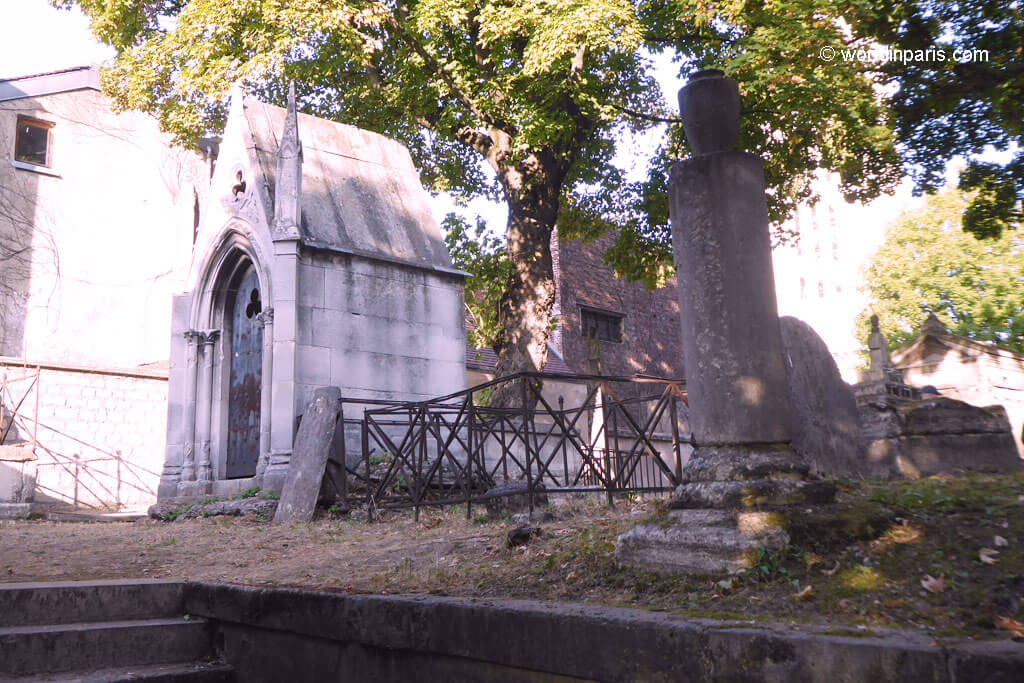
The hillock, dominated by Saint-Pierre Church and its public square (Place du Tertre), has long kept its village atmosphere. While the village’s fame has been widely exploited (you just need to see all those souvenir shops..) and completely distorted, the church retains a picturesque side with its clear perspective.
3. Place du Tertre and the Artists of Montmartre
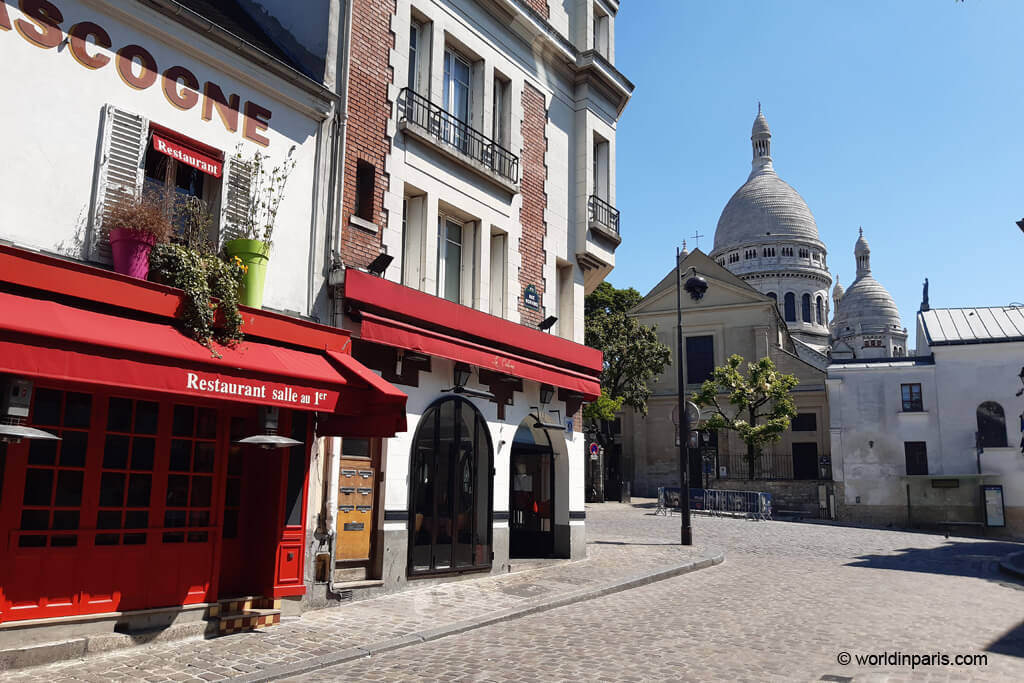
Place du Tertre is Montmartre’s beating heart. This picturesque square framed by 3-4 story 18th-century buildings and with a beautiful view over the Sacré Coeur corresponds to the center of the old village of Montmartre.
The village of Montmartre was officially founded in 1790, and its first town hall was at 3 Place du Tertre . In the square, there is also a plaque on the façade of house #21 which commemorates the arrival of the first automobile on Christmas Eve 1898, with Louis Renault behind the wheel. This event marks the beginning of the automobile industry in France.
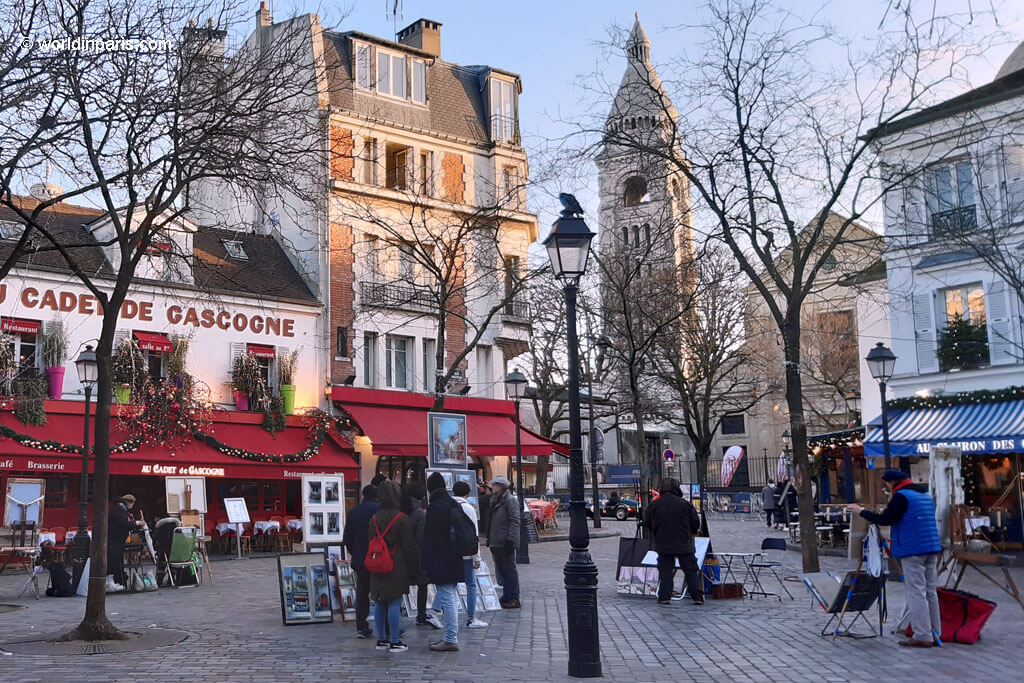
The local art trade is a tradition of the slopes of bohemian Montmartre, started around 1890 by famous Montmartre artists like Modigliani, Utrillo, Valadon, and Picasso. Each year, the City Council grants 140 licenses for a one-square-meter stall in Place du Tertre to be shared by two artists on alternating schedules.
Let’s take Rue Novins , the old village’s main street. This street was referred to in the 11th century as the cart road that goes from Montmartre to Paris . The even side is lined up with 18th-century townhouses with wooden shutters, wrought iron window railings, and dormers.
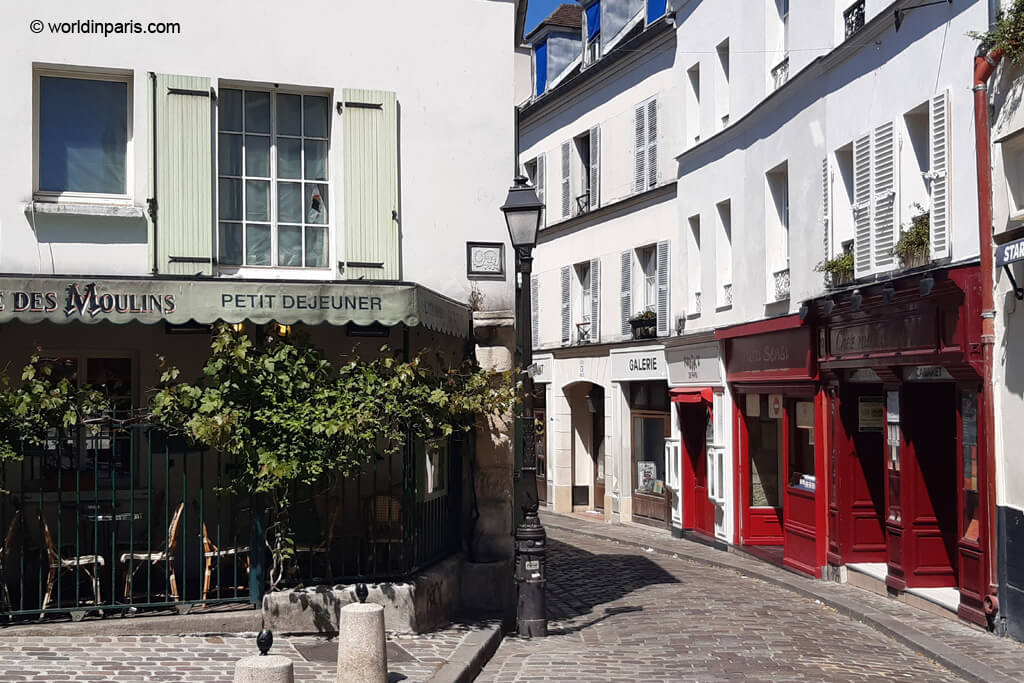
At #6 there’s the Mère Catherine Restaurant , a small bistro founded in 1793. This bistro replaced a 15th-century old presbytery, and guests liked to meet for drinking and to play wooden billiards. An old postcard shows the Mère Catherine and the pool players posing in front of the bistro.
Now, let’s turn left onto Rue des Saules , which plunges down the north side of the Hill. Don’t forget to take a picture of Le Consulat , one of the most Instagrammable cafés in Montmartre.
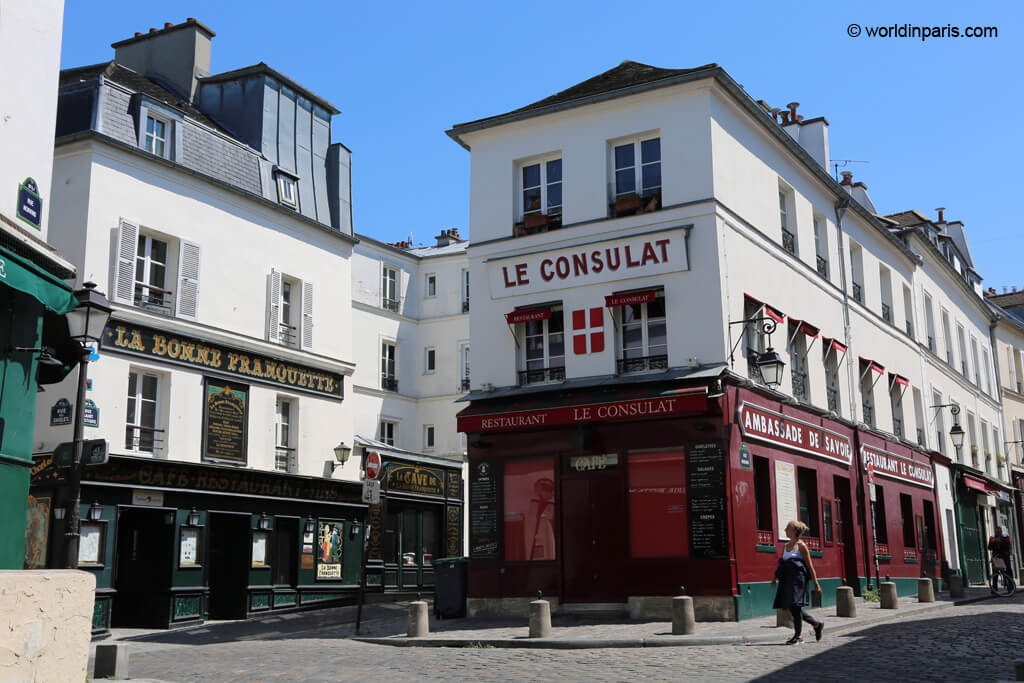
Rue des Saules was called in the 15th century the Chemin de la Saussaie, and it traversed swampy lands where willow trees ( saules in French) grew. For this walking tour of Montmartre, you will take the second intersection with Rue Cortot .
4. A Hothouse for Artists
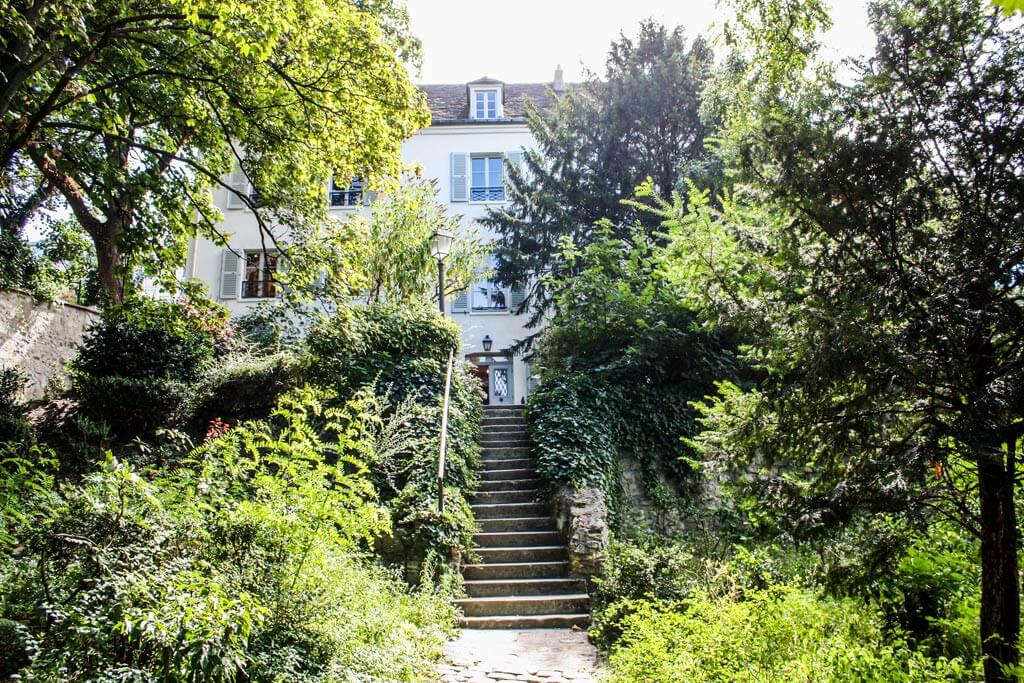
Considered the oldest house in Montmartre and formerly the art studio of many artists, Le Musée de Montmartre (12 rue Cortot) is nestled on a quiet street. Although the museum is located a stone’s throw from busy Sacré-Coeur, it feels a world away.
Auguste Renoir was perhaps its most illustrious guest. In 1876, He rented a studio and stables in the left wing to store Le Moulin de la Galette, the extra-large painting he was working in.
The rarely crowded museum has collections on the village’s history (the section on cabarets, for example, is very interesting). The setting is very romantic, and from the exterior areas, you are treated to excellent views over the vineyard of Montmartre. Take a drink in the beautiful café in the garden, immortalized by artists like Renoir in The Swing.
After the visit to the Musée de Montmartre, this Montmartre walk turns left on Rue du Mont-Cenis. This street was in the 12th century a steep path – only accessible to pedestrians and mules – which linked the Abbey of Saint-Denis to the Abbey of Montmartre through the Hill’s northern slope.
Then turn left onto Rue Saint-Vincent , a street with a provincial feel, and stop at Montmartre’s vineyards.
5. The Wine of Montmartre
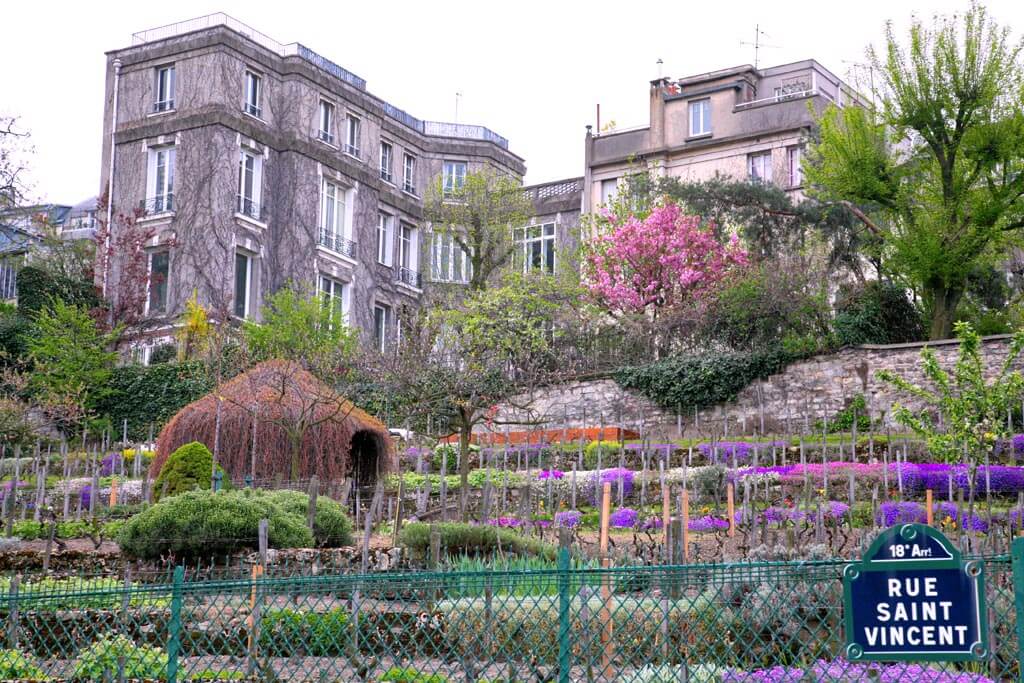
The Montmartre vineyards of Rue Sait Vincent, whose official name is Clos-Montmartre , perpetrates the memory and tradition of the many vineyards that used to cover these slopes.
In the 16th century, the inhabitants of Montmartre – then a village located outside Paris – were mainly laborers-winegrowers. The vineyards were cultivated from the top of the Butte to the surrounding plains.
In the 17th century, the Montmartre wine was a small wine reserved for local consumption. A popular saying of the time makes fun of its quality which seems to be exclusively diuretic: “It is the wine from Montmartre – Who drinks a pint, pisses a quarter of it!” .
This vineyard in Rue Saint Vincent was planted in 1933 to prevent any new construction on the grounds of a former (then abandoned) open-air dance hall called Le Parc de la Belle Gabrielle . Today, this vineyard includes “the most classic varieties from the wine provinces of France, as well as a selection of vigorous and fertile hybrids”. The whole is embellished by decorative plantations.
Public access is not permitted, except for exceptional occasions, such as the Fête des Jardins organized every autumn since 1997. The yearly harvest is generally in early October. The crop is hauled to the Mairie of the 18th Arrondissement cellars, and the 800-odd bottles of wine are sold at auction the following year during the popular Montmartre’s Harvest Festival . You can read more about this popular food & wine festival here .
6. Cabaret Life in Montmartre
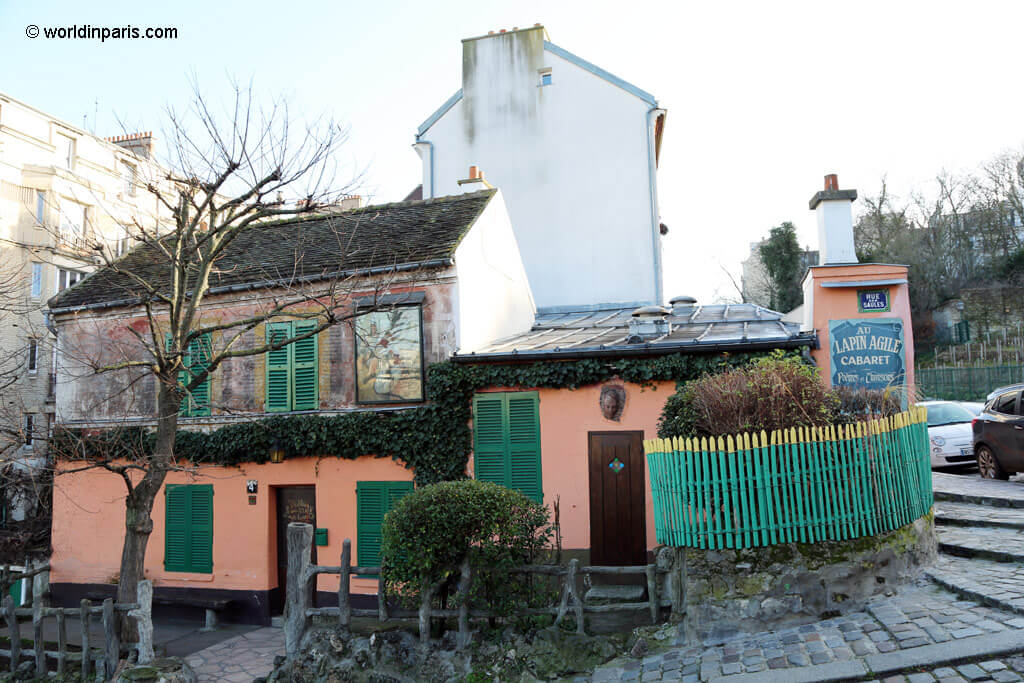
Le Lapin Agile at 22 Rue des Saules is a traditional cabaret established in the second half of the 19th century, bought by Aristide Bruant in 1913. We know that in 1886 this was a restaurant run by Adèle Decerf whose specialty was sautéed rabbit.
In the early 20th century, this village-style house was the center of bohemian life in Montmartre. Dorgelès, Carco, Renoir, Courteline, Forain, Picasso, Fargue, Utrillo, Van Gogh, Clemenceau, and many more were frequent guests of this cabaret. Picasso liked sitting out on the terrace beneath the giant acacia with his dog Frika.
Today, the Lapin Agile has preserved the original and warm atmosphere of the cabarets. You can read more about the Lapin Agile and other Parisian Cabarets in our quick guide to the Cabarets of Paris .
7. Rue de l’Abrevoir
Let’s walk up Rue des Saules , then turn right onto Rue de l’Abrevoir . In the 19th century, the residents of Montmartre followed this path to fetch water for themselves and to lead horses and cattle to the watering trough ( abrevoir in French) located on this street. The 19th-century house at #15 is the site of that old watering trough.
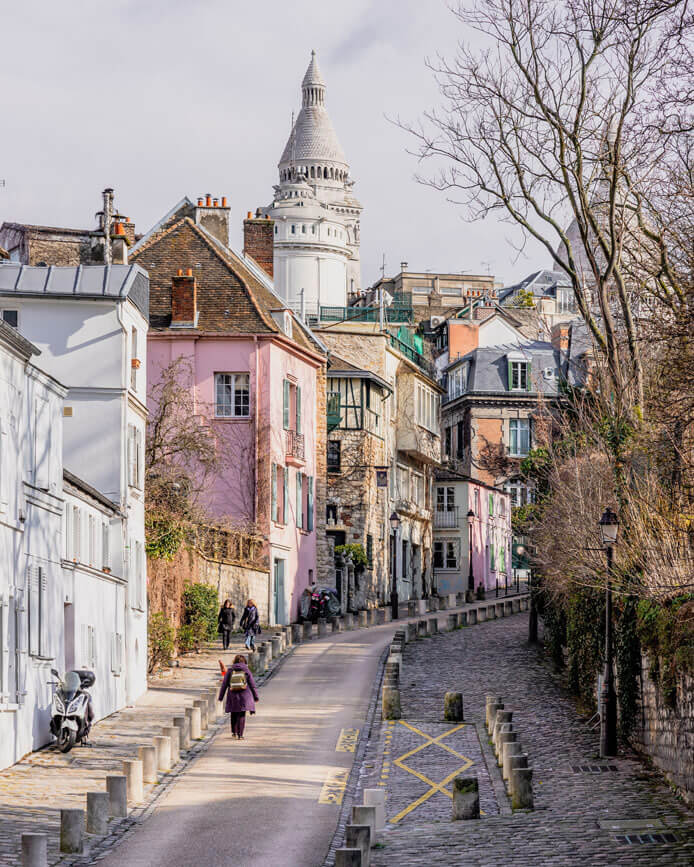
At #2, the little Maison Rose (point #8 on the Montmartre walking tour map) painted by Maurice Utrillo is now a legendary spot in Montmartre and one of Instagrammers’ favorite spots in Paris.
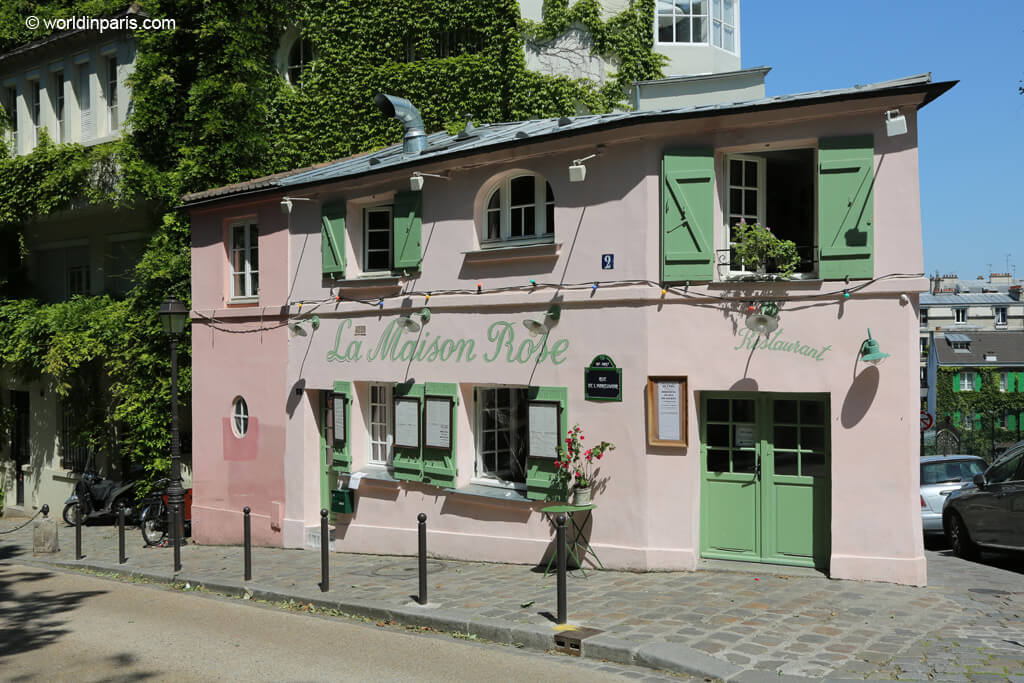
9. Dalida’s Tragic Life
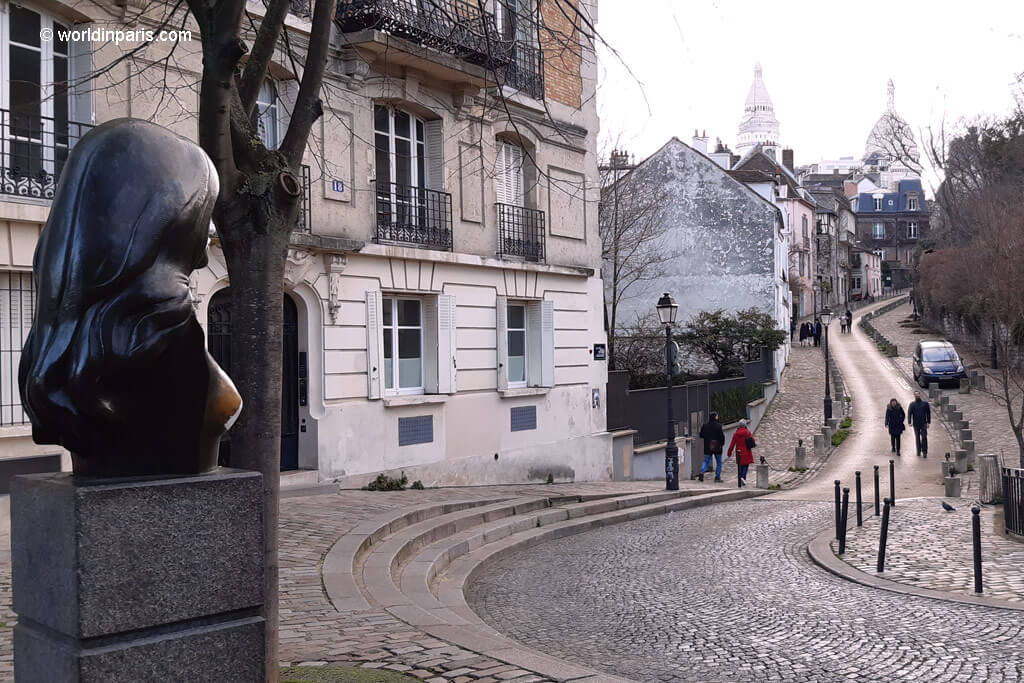
This Montmartre tour stops for a break at Place Dalida . This tiny square has one of the most beautiful views of Montmartre, with Rue de l’Abrevoir towards the Sacré-Coeur. The square is dedicated to Dalida , a famous pop singer who lived in Montmartre. Her incredible talent as a performer made her an icon of pop music in France.
The singer Dalida found a home in Montmartre, where she moved in 1962. She bought a beautiful mansion on the narrow 11 bis Rue d’Orchampt . She used to eat at the neighboring Italian restaurant Grazziano, down by the Moulin, and she also frequented the shops in the Rue Lepic. Dalida joined in the fight to defend and protect the Butte, so dear to her.
Weakened by the loss of her former companions (all committed suicide), as well as her friend Mike Brant, the singer died on 2 May 1987, breaking the hearts of the French. “Life is unbearable to me, please forgive me,” were Dalida’s last words. Dalida committed suicide in her house, and she was buried in the Montmartre Cemetery (not included in this Montmartre tour).
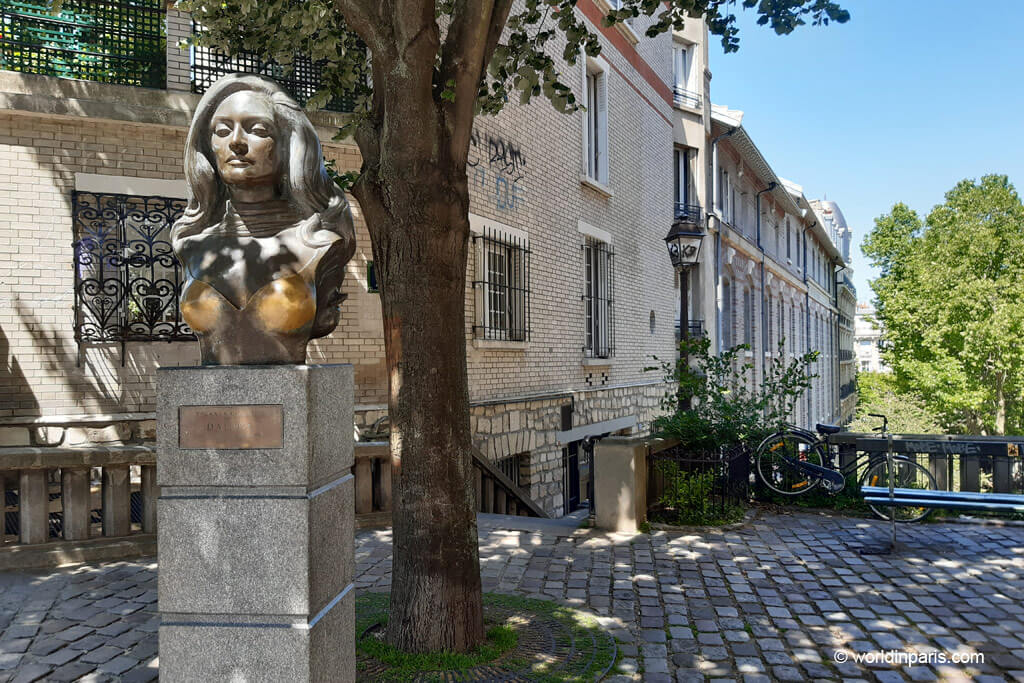
It is soon noticed that the bust dedicated to Dalida is particularly polished in some places – on the artist’s chest, in particular – leaving some visitors doubtful. There is no particular reason for that (unlike Giulietta, Dalida does not bring good luck, love, or money but quite the opposite…) so please be respectful towards this great artist and Montmartroise.
10. L’Allée des Brouillards
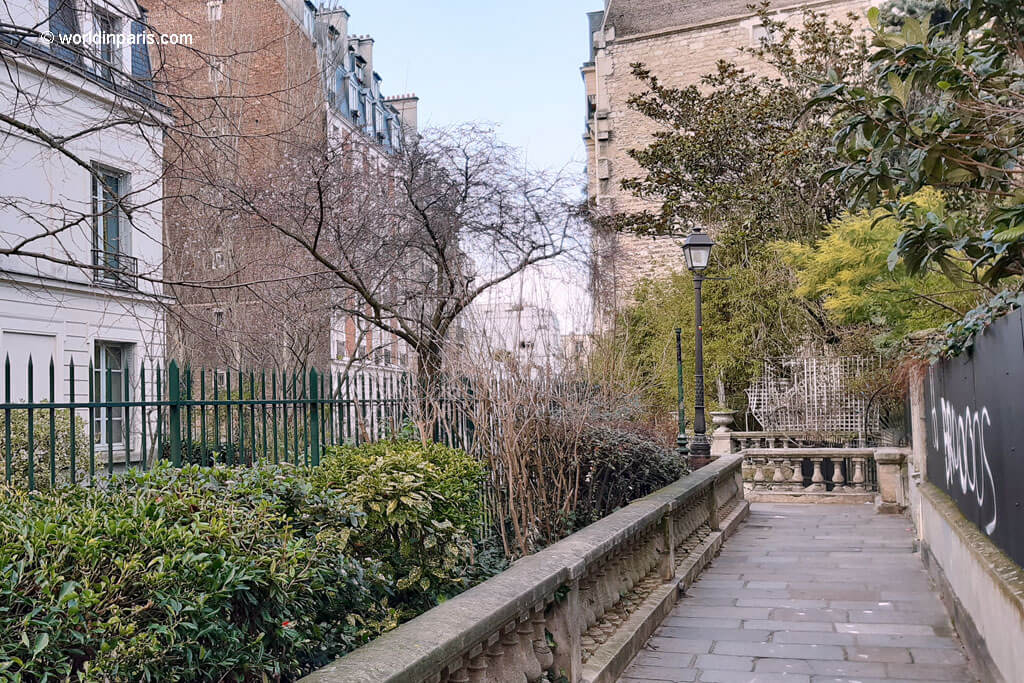
The romantic Allée des Brouillards is one of the few places that still can transport us back in time to the picturesque village of Montmartre. Renoir and his family lived at #8 from 1890 to 1897. His son, Jean, a famous film director, was born here in 1894.
On the right, behind a lawn, rises the delightful facade of the Château des Brouillards , in front of which so many painters set up their easels in the past.
In the 17th century, a modest farm and a mill occupied this site ( the Moulin des Brouillards ), which served as a press for Montmartre’s (not-so-good) wine. The name Allée des Brouillards (Mists Alley) tends toward two explanations: the morning mists generated by the abundance of the sources in the area or (another one much more festive) an allusion to the vapors of the wine.
In 1764, the hovel and the ruined mill were sold to a lawyer in the French Parliament who built a beautiful house, the ‘Château des Brouillards,’ parts of which you can still see today on the left side. The Château comprised a farmyard, orchard, cellars, and wells, and it was a pleasant country residence.
In 1850 the outbuildings of the Château were torn down to make room for individual houses separated by mere hedges, now on the tiny alley with the poetic name. Its park, gradually invaded by miserable huts, became the famous “maquis” (bush), so dear to nostalgic Montmartrois.
It was not until the 1920s that the castle owner began to restore it. He launched a campaign for its conservation because the City of Paris wanted to remove the old alley and demolish the house. Today, the Château des Brouillards receives the visit of many walkers and lovers of Montmartre in search of an air of the rural and picturesque Butte of better days.
11. Villa Léandre
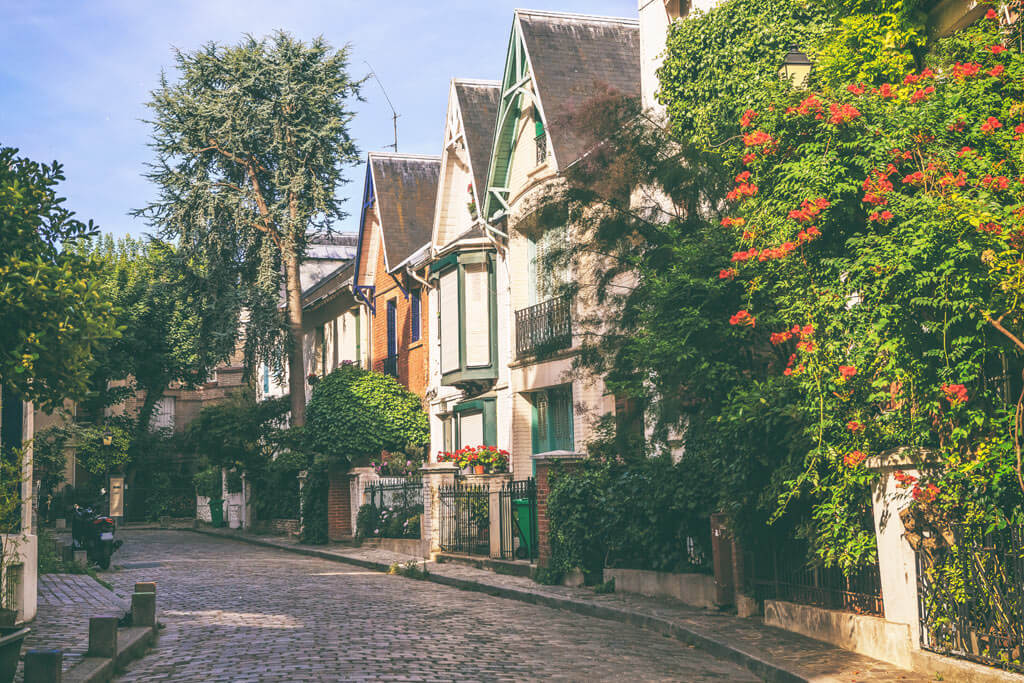
This walking tour Montmartre takes now Rue Simon-Dereure and then Avenue Junot on the left. Before walking uphill, stop at the charming Villa Léandre for a couple of pictures.
Created in 1926, Villa Léandre was initially named Villa Junot , after its larger street tributary. Its current name comes from the caricature artist Charles Léandre, whose studio was located nearby. The cobbled cul de sac is lined with colorful anglo-Normand style houses covered with climbing plants and with small front yards.
Montmartre Things to Do and Hidden Gems
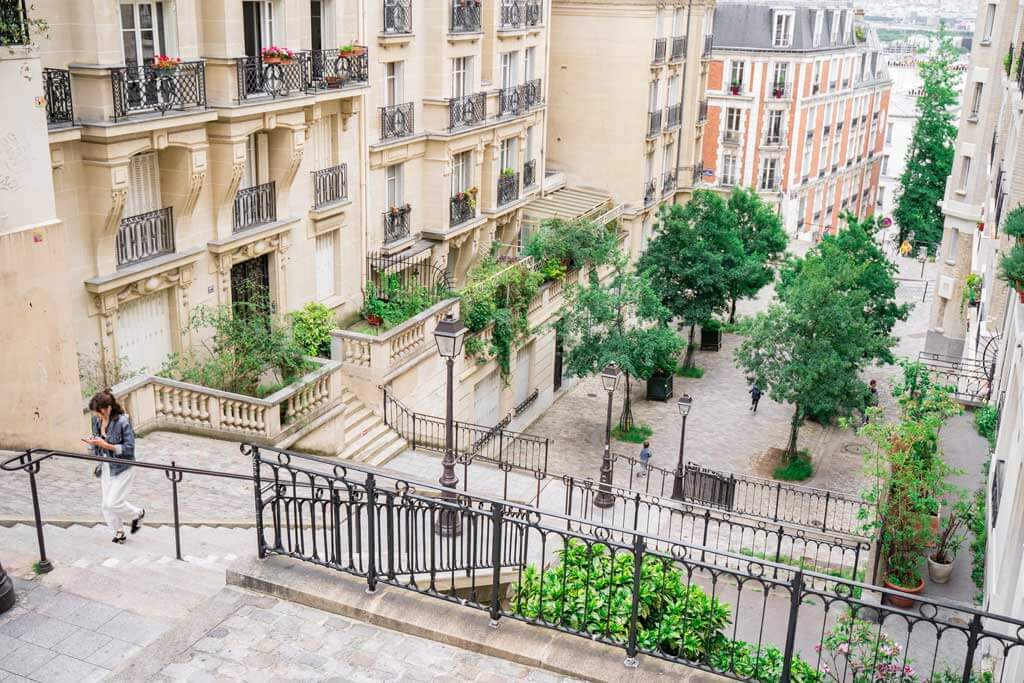
12. The Mysterious Witch’s Rock
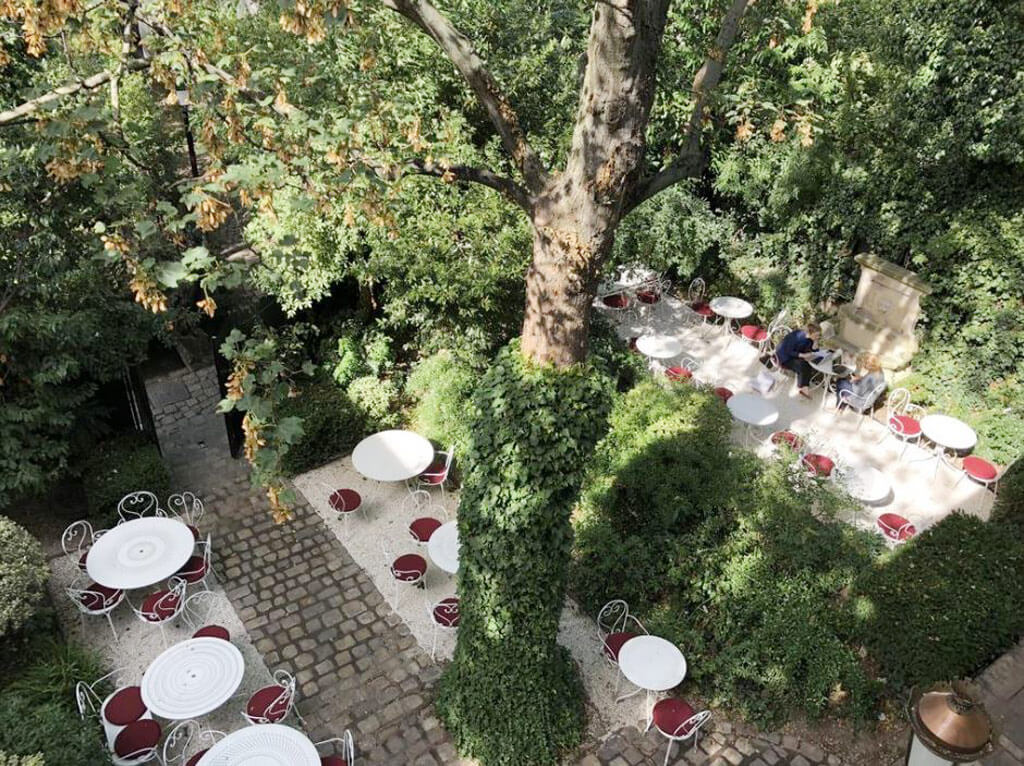
The Passage de la Sorcière , accessible from 23 Avenue Junot or 65 rue Lepic, is one of the most pleasant and privileged little alleys in Montmartre. But this little corner of the Butte comes with many legends! Among the mysterious stories linked to this passage, we find the legend around the imposing block of stone found in its center – La Roche de la Sorcière (the Witch’s Rock).
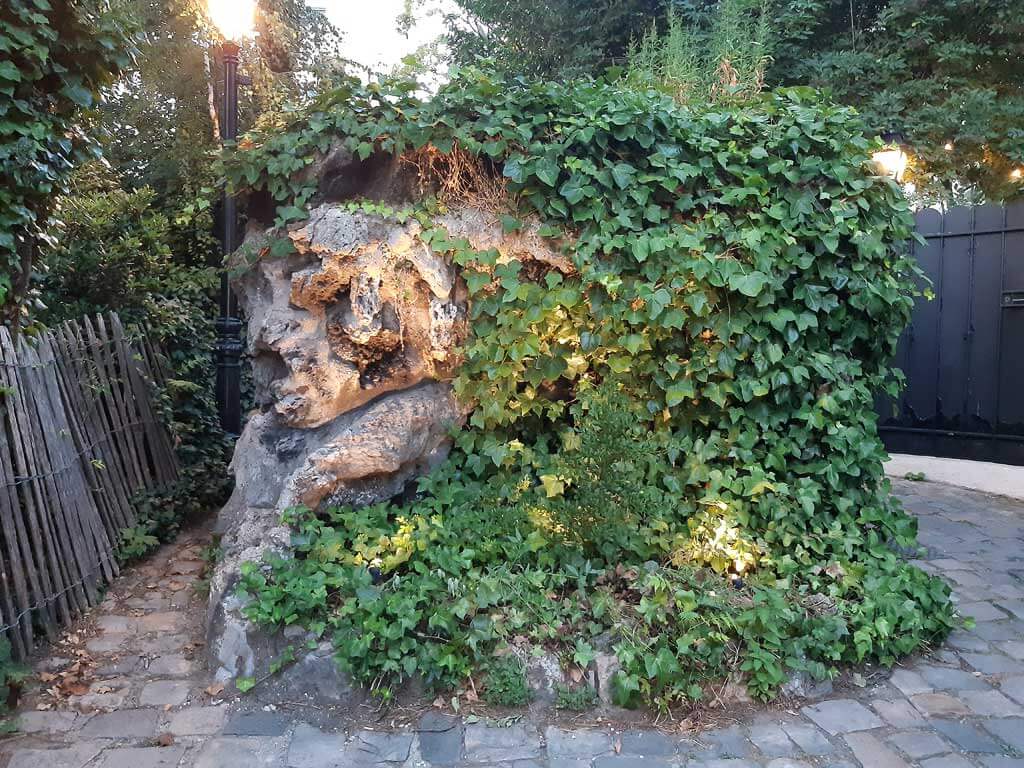
The inhabitants of Montmartre had long believed that this rock was a meteorite, which fell there we do not know when, or how … and it was a magic tool used to protect a witch! Indeed, this imposing rock faces a rather intriguing portal that hides a big and beautiful house. According to legend, this house belonged to an old – and a little bit crazy – woman.
This rock, however, is the vestige of a disused fountain, ‘La Sourcière’ (from source , spring in French), and the neighbors transformed the name of the Passage de la Sourcière , from the name of the fountain which was present there, into Passage de la Sorcière (=Passage of the Witch). Soon, the Rock of the Witch turned into an evil tool with many legends around and spread for generations among the inhabitants of Montmartre.
Today, the witch’s private mansion is one of the most beautiful addresses in the capital, the Hôtel Particulier Montmartre (point #13 on the Montmartre walking tour map). I always recommend this hotel for a romantic stay in Paris which also comes with one of the most beautiful bars in the city. The Hôtel Particulier Montmartre is your only chance to see the Rock of the Witch as this alley is private today.
14. The Legend of Saint-Denis
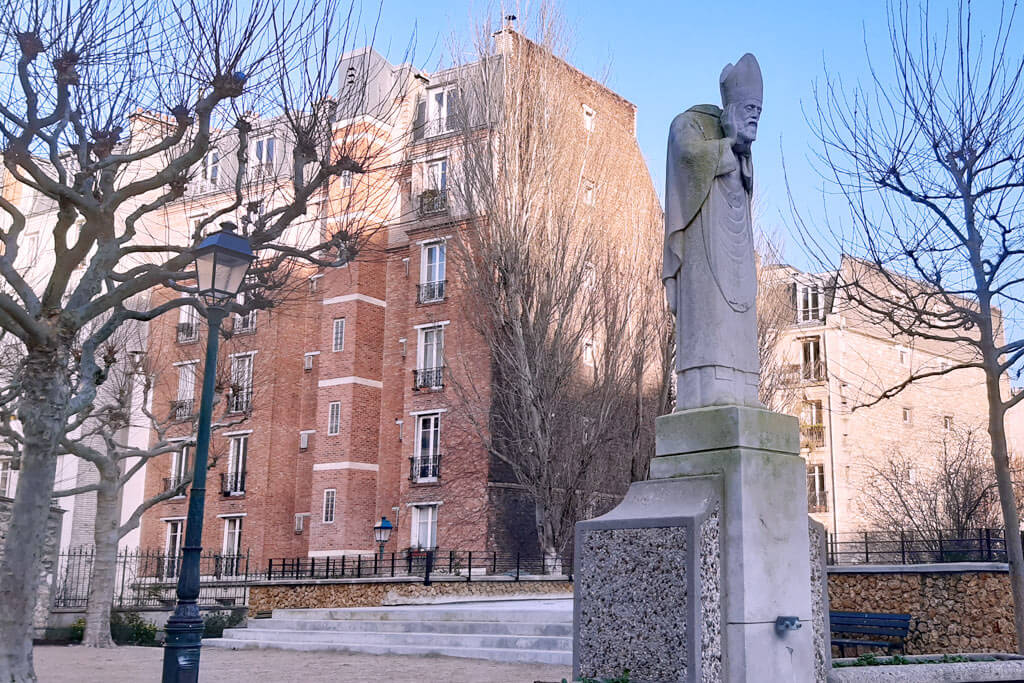
Back to Avenue Junot , this Montmartre self-guided walking tour stops at Square Suzanne-Buisson , dominated by the statue of Saint-Denis. Saint-Denis was the first Christian bishop of Paris in Roman times and the evangelist of the Parisians. The Saint was martyrized and beheaded with his companions Rustique and Éleuthère during Emperor Valerian’s prosecutions.
Legend has it that after his martyrdom (circa 275), the Saint washed his decapitated head in the spring that flowed here until the early 19th century before continuing quietly on his way towards the site where he was buried (current location of the crypt in the Basilica of Saint-Denis). For this reason, the Basilica of Saint-Denis became the burial place for all the Kings of France, who wanted to rest eternally near the remains of the Saint.
15. The Windmills of Montmartre
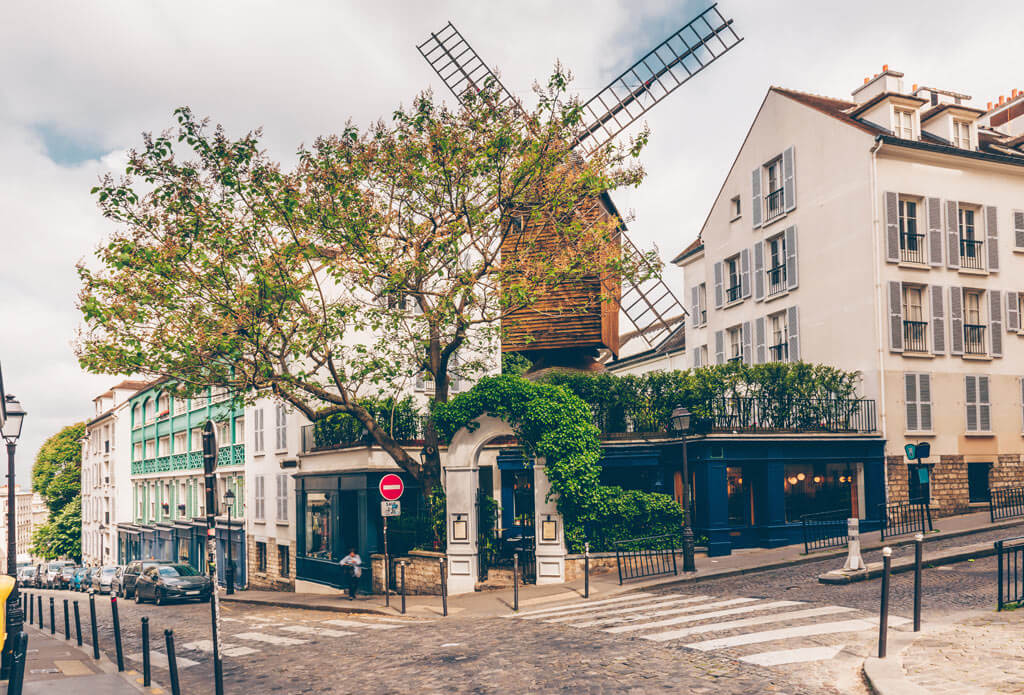
Back to Avenue Junot, on #3, you can get a glimpse of the Moulin of the Blute-Fin , built around 1622. Of the thirteen mills which once stood on the Butte Montmartre, only this one and the Moulin Radet (#16, at the corner of Rue Girardon and Rue Lepic) survive. These windmills were used to grind wheat, press grapes, and crush materials needed in factories.
These two remaining windmills, their surrounding gardens, and a farm made up the popular guinguette (dance hall) Bal du Moulin de la Galette in the 1870s. Every Sunday, the Parisians flocked to the Ball to dance the polka, quadrille, rowdy, and French cancan .
From the 1900s, the Moulin de la Galette gained popularity and quickly became the favorite haunt of many celebrities (painters, designers, actors, etc.). Artists like Renoir, Toulouse-Lautrec, and Picasso immortalized the entertainment of Moulin de la Galette in their paintings.
17. The Fable of the Passe-Murailles
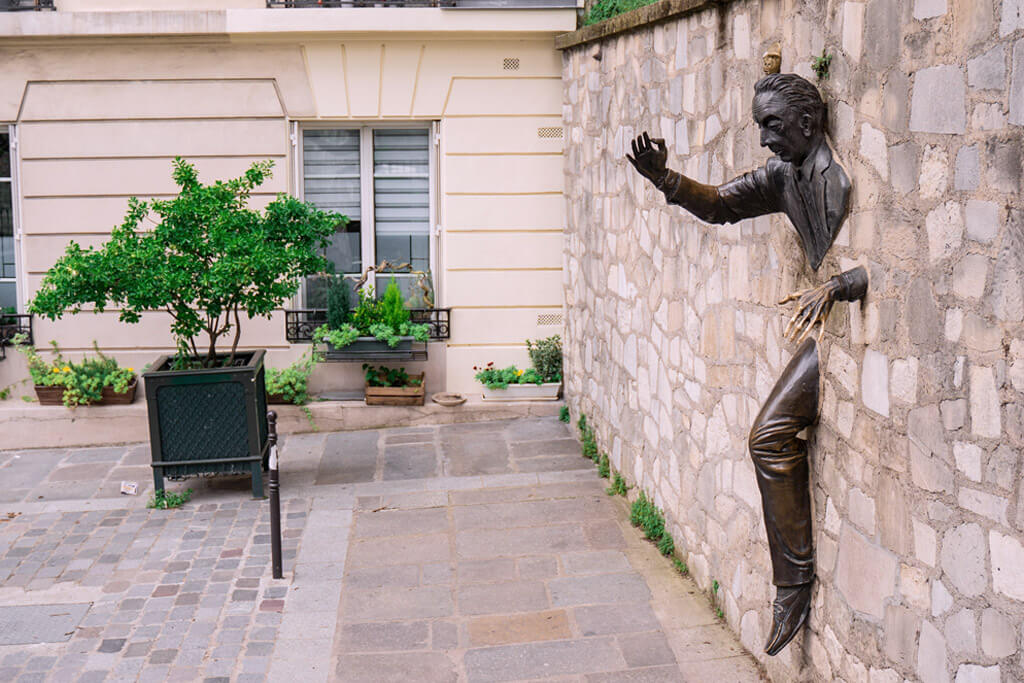
Continue walking Avenue Junot up to Place Marcel-Aymé . This is a beautiful place to see during the cherry blossom season. Here, you can see a man in bronze breaking through the wall.
The Passe-Muraille , the name of the sculpture, personifies a short story written by Marcel Aymé in 1943. ‘ An excellent man named Dutilleul had the extraordinary gift of being able to walk through walls without any trouble.’ This is a beautiful homage to the writer, who lived in Montmartre for 40 years.
Go back to the junction with Rue Girardon and then take Rue Orchampt down to Place Émile Goudeau. On the way, you can see Dalida’s house at 11bis Rue Orchampt and some picturesque artist studios.
18. Picasso and Le Bateau Lavoir
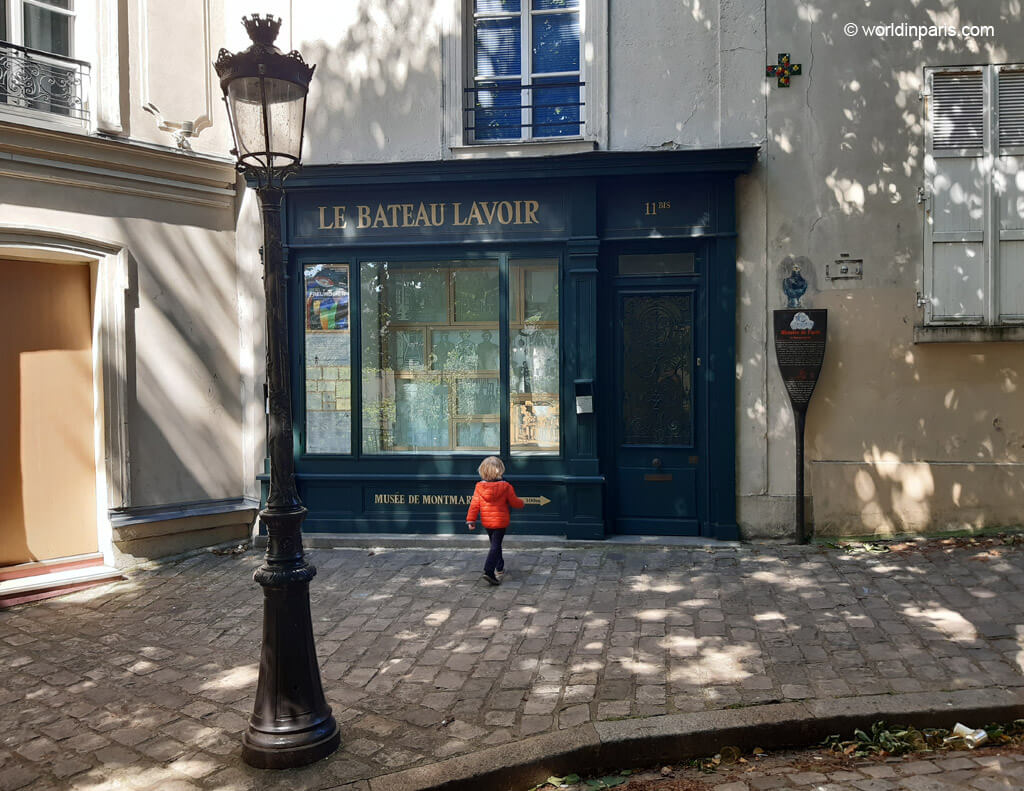
Formerly a ballroom and then a piano factory, the Bateau Lavoir facing Place Émile Goudeau was divided into twenty small workshops for artists. The place was without heating and provided with a single water point.
The Bateau-Lavoir hosted a good part of all the art people of the time: Le Douanier Rousseau, Amedeo Modigliani, Henri Matisse, Georges Braque, Guillaume Apollinaire, Jean Cocteau… All went through the small, cramped workshops of this unusual house.
Until his death, Pablo Picasso (1881-1973) kept nostalgia for the rural Montmartre of his youth, with its picturesque farms, orchards, and cabarets. The artist arrived at the Butte at 19, and he took up a workshop at Le Bateau Lavoir in 1904. Here, he executed the last works of the blue period, those of the pink period – inspired by his love for Fernande Olivier – and The Young Ladies of Avignon (1907), a prelude to cubism.
In 1970, the Bateau Lavoir’s wooden structure did not resist a terrible fire and only the facade, today listed as a historical monument, survived.
19. Place des Abbesses
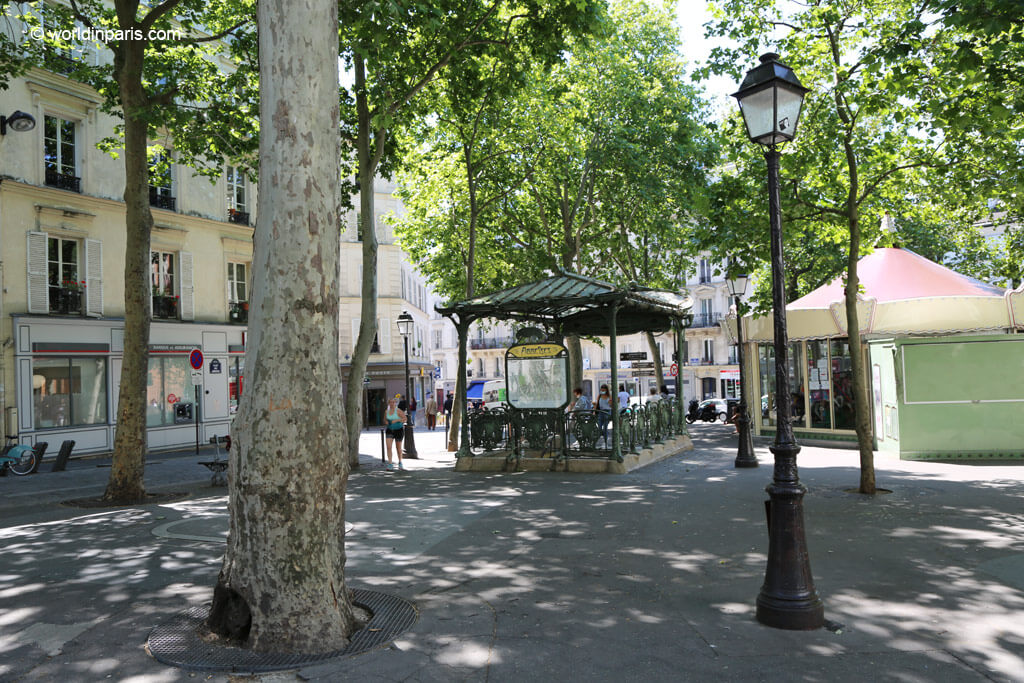
The last stop of this Montmartre walking tour is the picturesque Place des Abbesses . Take your time to explore this lively square with a carousel, some benches in the shade, and the Guimard metro entrance.
Metro Abbesses is the deepest metro station in Paris; it goes 36 m below the ground!
Also interesting is the Church of Saint-Jean de Montmartre (1894-1904), designed by Anatole de Baudot. He conceived the idea of social and economic architecture in harmony with the industrial development of the time. For this building, Anatole de Baudot dared to introduce cast iron and reinforced cement with (in my opinion) a beautiful result.
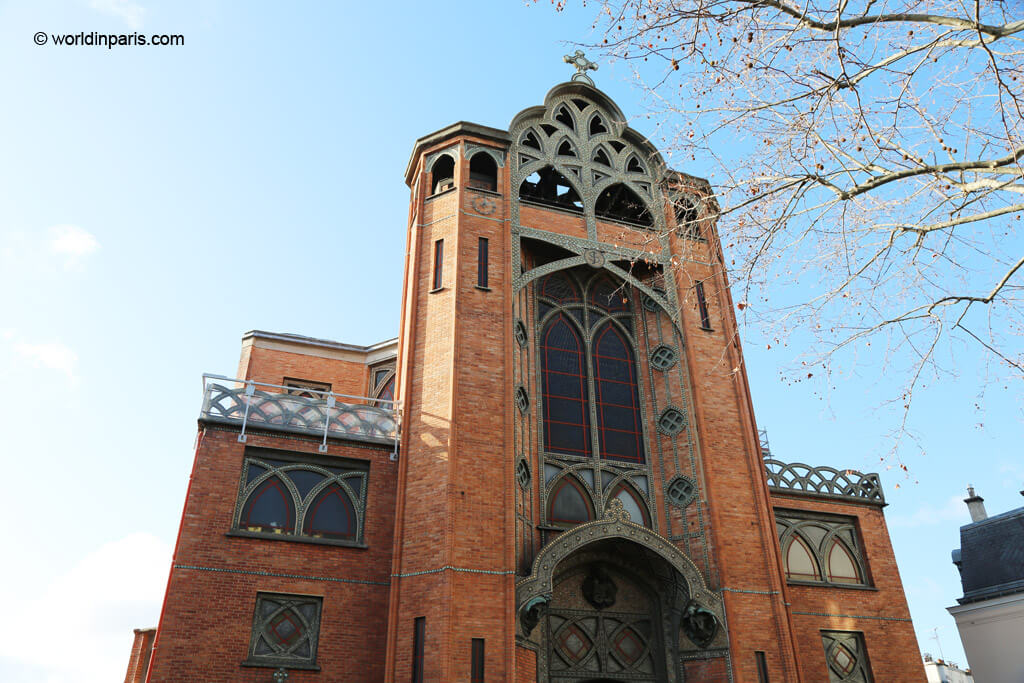
Nearby, in Square Jean Rictus (point #20 on the Montmartre walking tour map), you can see the famous Love Wall , but it is always swarming with people. Instead, make your way to its back corner to discover the hidden Jardin des Abbesses , a lovely small oasis in Montmartre.
After the Love Wall, this Montmartre walk ends at the picturesque café Le Vrai Paris at 33 Rue des Abbesses (#21) for a more than deserved drink and quick eats.
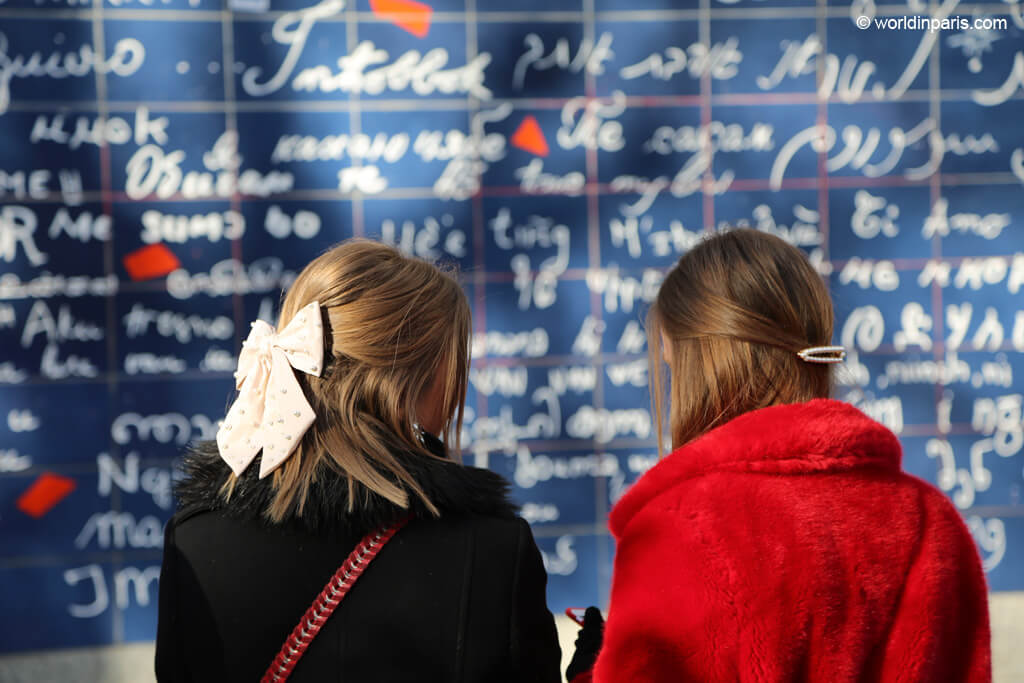
Click here to read about other Paris Attractions
Back to Homepage
Pin it now & read it later
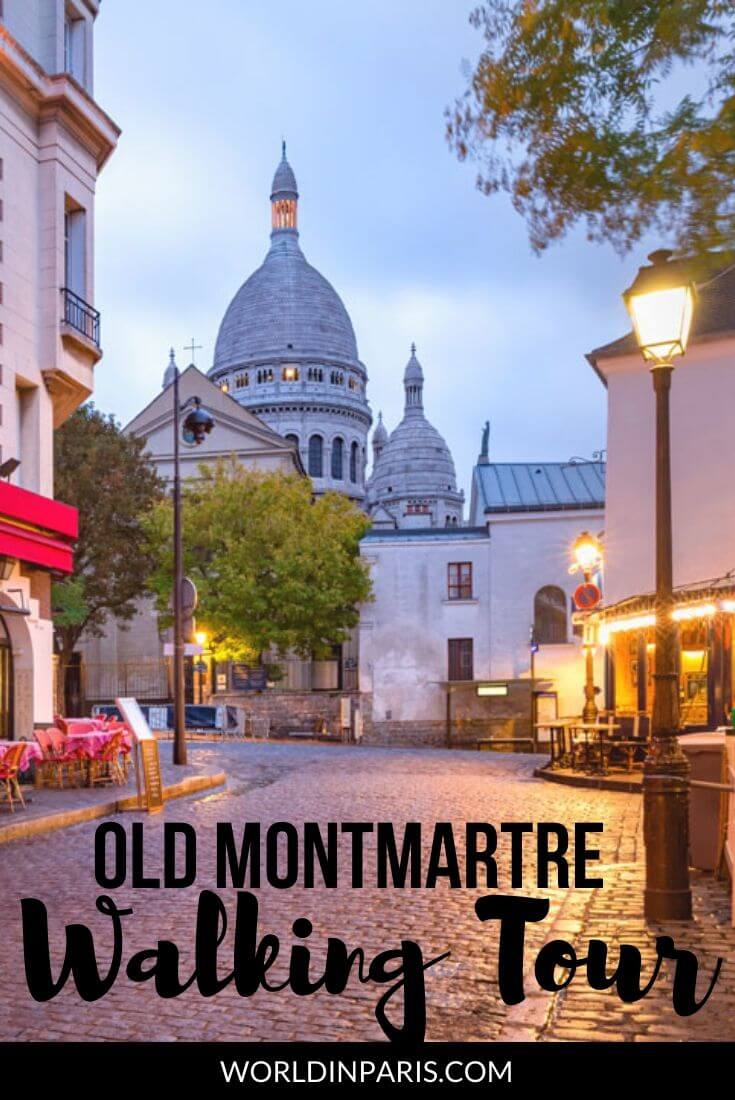
Disclaimer: This post includes affiliate links, meaning we get a small commission if you make a purchase through our links. It costs you nothing more (in fact, if anything, you’ll get a nice discount) but helps us to go on creating incredible Paris content for you. We trust all products promoted here and would never recommend a product that isn’t of value. World in Paris is a participant in the Amazon Services LLC Associates Program. As an Amazon Associate, we earn from qualifying purchases at no expense to you.

About WORLD IN PARIS
Quirky parisian explorers with a preference for lesser-known sights, we are continuously looking for new ideas and tips to bring you the best of the city of light read more about us ., i am elisa, the travel blogger behind world in paris. quirky explorer with a preference for the local side of my city and its lesser-known sights, i am continuously looking for new ideas to enjoy the best of paris & around . do you want to go beyond the louvre museum or the eiffel tower keep clicking for first-hand information & my best tips learn more.
This website uses cookies to improve your browsing experience and analyze the use of the website. Learn More

Montmartre Walking Tour

This post is a free and self-guided walking tour of Montmatre, one of Paris's most iconic neighborhoods, along with a map.
We also provide an audio tour version that is GPS-enabled to help guide you through the area.
And lastly, we provide a comparison of the various live-guided Montmartre walking tours , including, free walks , food tours , and art walks.
The neighborhood is a popular destination for visitors from around the world who are eager to follow in the footsteps of artistic legends such as Dali, Degas, and Hemingway, among several others.
The Moulin Rouge and Sacre Coeur Cathedral are especially famous attractions that have been attracting visitors, and tour companies, to the neighborhood for decades.

Click the Montmartre walking tour map to enlarge it.
SELF-GUIDED TOUR OF MONTMATRE
This self-guided tour should take between 2 and 4 hours depending on how long you dwell at each stop. In reality, there's no more than 1 hour of walking.
The tour begins at Place Pigalle ( map ). Take the metro to Pigalle on line 2 or 12 and prepare to stroll in the footsteps of geniuses. The tour ends near where it starts.
We also offer our own, GPS-led audio tour , developed and narrated by one of our local tour guides, Christina.
Here is a sample of the tour.
Place Pigalle
Take the metro to Pigalle on line 2 or 12 and prepare to stroll in the footsteps of geniuses.
Exit the metro and you’ll find yourself in Place Pigalle on the Boulevard de Clichy ( map ).
Downhill you’ll head back into Paris and going across either east or west you’ll be walking around the Butte du Montmartre or the hill of the martyrs.
We’ll find out about the name later, but in the late 19 th Century this went from being the countryside outside of the city to the most radical artistic neighborhood in the world.
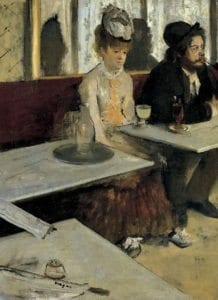
Looking down the hill you’ll see a nightclub called Folies Pigalle, this was once the café Nouvelle Athènes frequented by Van Gogh, Henri Matisse, and Degas where the latter painted his famous L’Absinthe (see picture).
Back then absinthe, a supposedly hallucinogenic drink made of anise, fennel, herbs, and wormwood, was all the rage but we’ll hear more about that later too.
By the 1940s, the bar had become a striptease club where the Nazis and later French Resistance fighters would relax.
Sex and the erotic have always been a big part of the Montmartre story. Looking around today you’ll see lots of clubs and sex shops along the Boulevard.
It can be quite seedy here at night, but as we head up the hill you’ll notice the atmosphere becomes much less bawdy.
The name Pigalle comes from the 18 th- Century painter, Jean Baptiste Pigalle, but American GIs arriving in Paris after its liberation by Free French forces found the same pleasures here and nicknamed the area Pig Alley!
Right now we’re going to head west along Pig Alley (the Boulevard de Clichy) keep downhill on your left and uphill on your right.
Le Chat Noir
(68 Boulevard de Clichy)

You are standing in front of the world’s first modern cabaret.
La Chat Noir is now most famous for stylish retro posters on a thousand student walls (see picture).
But this was the soul of Belle Époque Paris, a place where fashionable artists came to be entertained at their tables by raucous music hall entertainment.
The club opened in 1881 as the meeting place of Les Hyrdopathes a group of artists who preferred wine to water!
The doormen at the club dressed like the Pope’s Vatican Swiss Guard but their job was to stop priests and the military people from entering this bohemian and radical club.
The list of famous patrons is like a who’s who of modern art and culture; the musician Claude Debussy, the singer Aristide Bruant and painters like Henri Toulouse Lautrec.
Henri Toulouse Lautrec was a fascinating character. Born to a noble family with a history of inbreeding, Toulouse broke both legs when aged 14, and his legs ceased to grow, leaving him with an adult torso, a child’s legs, and hypertrophied genitals!
He became the center of the Montmartre social scene, a leading post-impressionist painter, and a legendary lover to many local prostitutes and models.
From this, he contracted syphilis, went crazy, and drank himself to death at the age of 36.
Today he’s probably best known for designing the posters and flyers for the most famous cabaret in the world.
You probably don’t need us to tell you the name of that cabaret, keep walking west on the Boulevard de Clichy, and on your right, you’ll spot a big red windmill!
Le Moulin Rouge

The original red windmill stood atop a low building here which marked the entrance to the cabaret where kings and paupers could mix and watch girls dancing the famous Can-Can dance.
That windmill burned down in a fire, but the club was rebuilt and continues to wow audiences.
The Can Can, where dancers kick up their legs one after the other, getting quicker and quicker, was originally danced by both sexes but women in the late nineteenth century wore open underclothes which would occasionally flash audiences as they danced.
Here at the Moulin Rouge, they found that the more the girls flashed the more customers kept returning, and over the years the underclothes got shorter and shorter as the club became more and more famous.
Baz Luhrmann’s film with Nicole Kidman and Ewan McGregor reignited interest in the club in 2001.
If you’ve seen the film John Leguizamo’s character is based on the painter Toulouse Lautrec.
The Moulin Rouge remains one of the main attractions in Paris with shows every night at 21:00 (9 pm) and 23:00 (11 pm).
Tickets start at 87€ per person , it’s not cheap but will certainly be an unforgettable evening.
For now, let’s head up into Montmartre. Turn back towards the Blanche Metro stop and then left up Rue Lepic.
Café des Deux Moulins
As you head up Rue Lepic, you’ll find this charming café-bar on the left-hand side - 15 Rue Lepic ( map )
Movie lovers will instantly recognize this as Amelie’s workplace from the famous 2001 French film; Amelie. The quirky love story is set around Paris but focuses heavily on Montmartre.
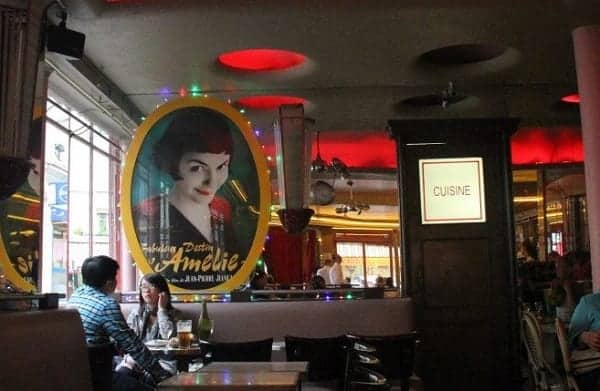
The cigarette machine from the film is missing but the Café’s bathroom remains identical to how it is in the raunchy movie scene!
Despite its fame, the Café des Deux Moulins is no more pricey than other cafés and restaurants in the area.
A top tip for saving money in Paris is to drink at the bar. You will pay a higher price for table service and an even higher price for sitting outside on the terrace.
Continue up Rue Lepic, you will get to what looks like a junction, but turn left and you’ll find that Rue Lepic continues curving its way up the hill.
Van Gogh’s House
As Rue Lepic turns right uphill you’ll find a plaque on the wall at 54 Rue Lepic ( map ) commemorating Vincent Van Gogh’s time here.

This was the home of Theo Van Gogh, Vincent's brother, who worked for a local art dealer. Vincent showed up in 1886 penniless and moved in with his brother.
This began a 2-year stint in Paris. It's here where Vincent's studio was set up (well, it was his bedroom).
In Paris Van Gogh became interested in Japanese art, pointillism, and impressionism and was hanging out with artists like Toulouse Lautrec, Paul Gauguin, and Camille Pissarro and his art took a transformative turn in these days.
Financial success eluded him to this point. Ironically, Van Gogh's poverty led him to focus on painting inexpensive and readily available items, which is why many of his paintings of this era involve flowers.
This is also the period when he painted several versions of his self-portrait.
For more information on his time here in Paris, there is an excellent article , which was a source for this entry, as well as an online exhibit .
Le Moulin de la Galette
Stop on Rue Lepic at the corner with Rue Tholozé ( map ) for fantastic views down into Paris. Cast your eyes upwards and you’ll see the Moulin de la Galette.

A galette is a kind of wholemeal crepe that was a staple food of the poor of Montmartre and Paris at the turn of the 20 th Century.
The windmill here is the only original windmill remaining today, but back then, Montmartre was full of windmills. This one is famous for two reasons:
During the 1870 Prussian siege of Paris, the mill’s owners defended the area and the miller was nailed to the sails of the mill in punishment by Prussian soldiers.
On a happier note, the mill was famous as a café, cabaret, and meeting point for artists. Many painted scenes here, but most famously Pierre-August Renoir.
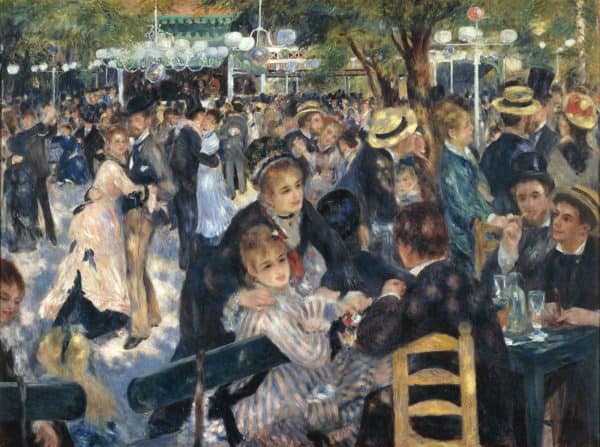
Renoir and the impressionists took art away from trying to capture purely accurate images. They preferred to show how things move and change over time as light changes from morning to evening.
Renoir’s Moulin de la Galette painting appears in the film Amelie for those who’ve seen it.
Today the windmill is privately owned and you can’t go up there so we’ll continue around the corner on Rue Girardon.
Saint-Denis Statue
One block on, at 2B Impasse Girardon ( map ), you will find a small park, Square Suzanne Buisson, on the left of the Rue Girardon.
In the park, there’s a statue of the first Bishop of Paris, Saint-Denis.
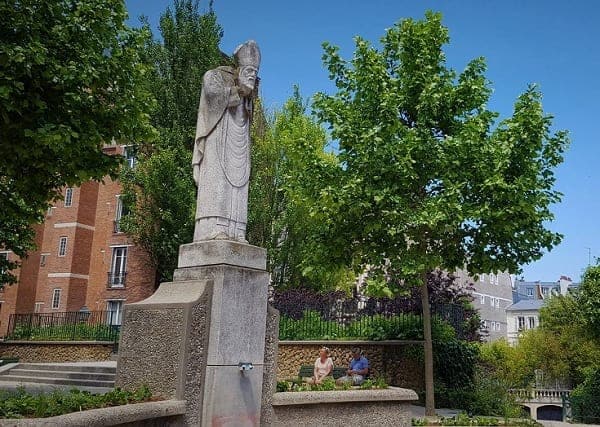
Saint-Denis was beheaded here on the hill by the Romans in the 3 rd Century.
According to legend his corpse picked up his head and walked 10km to the point where the Cathedral of Saint-Denis now stands in the suburbs of Paris.
Every French king is buried at Saint-Denis and it’s great for a visit if you get the time.
Historically, the name Montmartre, the Hill of the Martyrs, has been attributed to this event.
However, most historians today think the hill was already known as Montmars, the hill of Mars, by the pagans before the advent of Christianity.
Buste Dalida
Exit the park the same way you entered and continue down Rue Girardon.
At the corner, where it turns to the right onto Rue L’Abreuvoir ( map ), you will see a small bust of the famous Egyptian-Italian-French singer Dalida.
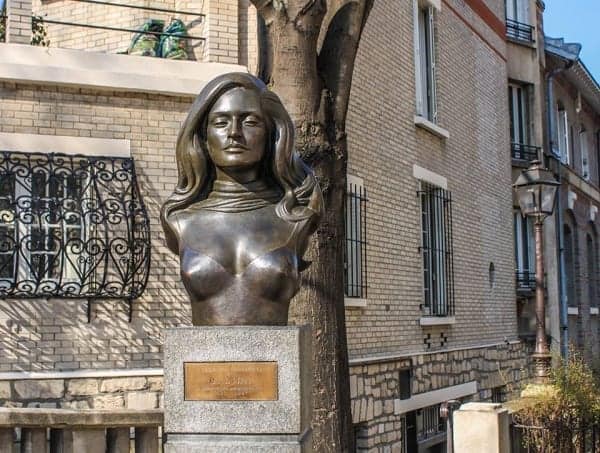
Dalida had an incredibly successful career but tragic love life.
Her first fiancé shot himself, her husband shot himself, her friend jumped to his death from a Paris apartment and her final lover gassed himself in his Renault car.
All this became too much and Dalida overdosed on barbiturates in 1987 leaving a note saying; life has become unsupportable for me. Can you blame her?!
Rue L’Abreuvoir
This charming street was immortalized by the painter Maurice Utrillo. Utrillo was one of the few painters born in Montmarte.
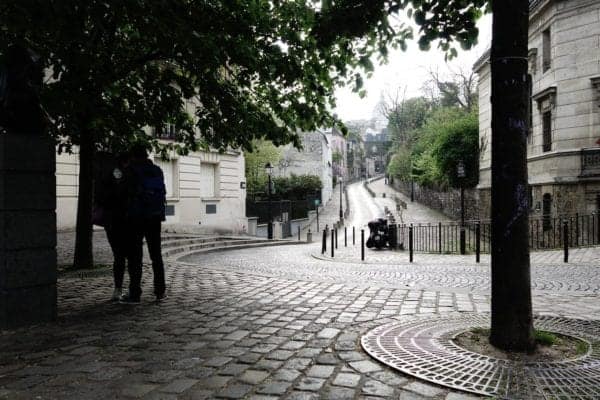
His mother Suzanne Valadon was the first woman admitted to the society of fine arts and learned her art from the countless painters she’d modeled for as a young woman.
Her former house is now the Montmarte Museum just ahead at number 12 Rue Cortot.
When Valadon fell pregnant she didn’t know who the father was. According to one Montmartre resident at the time; “she went to Renoir, but he looked at the baby and said, ‘can't be mine, the color is terrible’!
So she went to Degas, who said, 'He can't be mine, the form is awful!'
Valadon then saw an artist named Miguel Utrillo and told him her woes. He told her to call the baby Utrillo: 'I would be glad to put my name to the work of either Renoir or Degas!”
La Maison Rose
On the corner with the Rue des Saules ( map ), you’ll see the Maison Rose, or pink house, where Utrillo and many other painters used to hang out.
Upstairs was once a brothel where Van Gogh is reported to have contracted syphilis.
Today it’s been cleaned up and is a lovely spot for a bite to eat! Honestly!
Au Lapin Agile
Turn left down Rue des Saules with the vineyard on your left and stop on the corner by the Lapin Agile ( map ).
This little cabaret started life as a hang-out for low-lives and criminals.
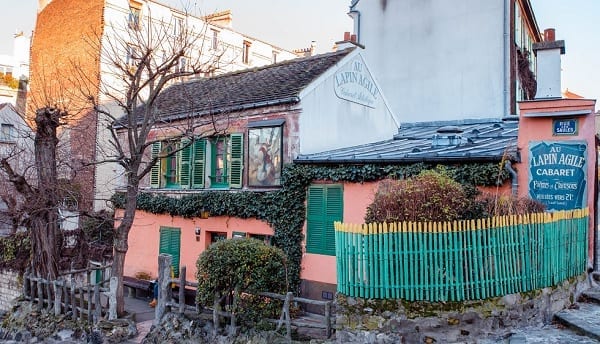
After the owner’s son was killed in an attempted robbery, the place was known as the Cabaret des Assassins.
But, fortunes changed when Andre Gill painted a new sign with a rabbit jumping out of a saucepan. People started to refer to the place as Gill’s Rabbit and this later changed to the Agile Rabbit.
At the turn of the 20 th Century the place was bought by Aristide Bruant to save it from closing and it became a favourite meeting place for struggling artists.
A young Picasso used to flirt with the waitresses and doodle their portraits on napkins in exchange for them letting him off the bill!
This is still a Cabaret today and well worth a visit for a more intimate and less bank-breaking French cabaret experience.
Le Jardin Sauvage
Turn right on Rue de Saint-Vicent and you’ll head past the old wild garden vineyards.
The wine they made here was Beaujolais, some of the first wines of the season and cheap wines for the people of Paris.
Unfortunately, the wine crops failed for several years in the late 19 th Century and this is where the tradition of drinking absinthe came from.
Once the wine stocks returned, many poor artists preferred to stick to absinthe as it was cheaper.
In order to get their customers back, many vineyards began spreading the idea that Absinth made drinkers go mad, hallucinate and commit all sorts of terrible crimes.
They also tried to get its sale prohibited. The legend they invented of hallucinogenic trips with the ‘green fairy’ persists to this day.
Le Sacré-Coeur
Continue uphill along Rue de Saint-Vicent. You’ll cross the path with the stairs heading up and down the hill.
The view down the hill is beautiful but we’ll continue uphill on the more gradual incline.
As the road bends to the right you’ll suddenly catch a view of the back of the Sacré-Coeur Basilica ( map ).
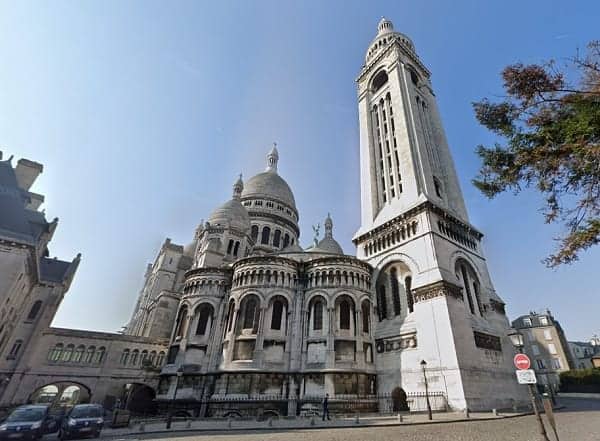
Le Sacré-Coeur Rear
The basilica was built to make up for what many saw as the moral corruption for which they blamed for the French defeat in the 1870-71 Franco-Prussian War
When Prussian troops took Paris in January 1871, the French Government and Army surrendered.
However, the working-class National Guard and the people of Paris refused to accept the surrender or the authority of the French Government and created an autonomous commune up here in Montmartre.
This was the first example of the working-class rule in the history of the world, but it only lasted a few months.

Barricade set up by Commune shown captured by French Army forces
In May French troops attacked and destroyed the Commune in what became known as the Semaine Sanglante or bloody week
On both sides, terrible atrocities were committed and the Sacré-Coeur was seen as a way to atone for those sins.
Construction of the basilica began in 1875 but didn’t finish until during WWI, so it was only consecrated after the war in 1919.
Let’s head around the church to its right, at the front you’ll get the most spectacular view of Paris, prepare to have your breath taken.

View of Paris from Le Sacré-Coeur
Take all the time you need to drink in the incredible views of Paris. In the afternoons the steps will be packed with people listening to street musicians.
Once you’ve regained your breath, turn back to the basilica and you’ll see two statues of people on horseback.

Le Sacré-Coeur Front
The statue to the left is King Louis IX, the only king of France to be made a saint.
Louis brought in the right to a fair trial and banned medieval trials by torturous ordeals like walking over hot coals.
From his fights in the crusades, he brought back holy relics that you’ll find today in the Sainte-Chapelle in the centre of Paris.
The statue on the right is Joan of Arc. During France’s darkest hours when the English were conquering at will, Joan rallied the French armies and started their fightback.
She was captured and burned as a witch by the English ensuring her legend forever in history.
You can enter the Sacré Coeur free from 6 am – 10.30 pm. You have to pay to climb the dome and you’ll need strong legs to climb the 300+ steps!
Place du Tertre
Once you’ve checked out the church and got your breath back from the view turn right with the church at you back and head along Rue Azais.
Looking out towards Paris you’ll catch a glimpse of the Eiffel Tower, then turn uphill to the right. As the street bends left you’ll enter the Place du Tertre ( map ).

Place du Tertre on a rather slow day.
Today, as in years gone by, the square will be full of painters selling their art. If you’d like your own portrait they’ll be more than happy to paint you.
On the northern side of the square, the Mere Cathrine restaurant was the first Bistro in the world.
Russian soldiers at the end of the Napoleonic wars demanded their drinks quickly- Bystro in Russian, and the idea of a bistro or rapid service restaurant was born!
Salvador Dalí Museum Paris
Once you’re done in Place du Tertre, leave on the downhill corner, diagonally opposite to the side you entered.
At the end of the small street steps go downhill, do not take those, turn right on Place du Calvaire and you’ll come to the Espace Dalí Montmartre ( map ).

Salvador Dalí is today the most famous surrealist artist in history, which is ironic as the surrealists kicked him out of their movement!
Surrealism was a reaction to all the craziness of wars and destruction in the world.
A group of writers, poets, and painters led by Louis Bréton began to question whether the comforting world of our dreams was actually the real world and our crazy world just a nightmare.
To connect with the dream world, they tried to write and paint without thinking consciously.
This automatic writing, as they called it, can be fun to try and to read back to yourself, but generally reading the nonsense of someone else’s head isn’t too engaging.
Dalí’s painting seemed intended to provoke and he was kicked out of the movement for thinking too much about his work and more than anything for making too much money from it!
People are still making money from his work today , entrance costs €13 and is a must for fans of surrealism.
Bateau Lavoir
Continue on Rue Poulbot and turn left at the end on Rue Norvins then left on Rue Jean-Baptist Clément and right on Rue Ravignan into Place Emile Goudeau ( map ).
This hidden little square is named after the leader of Les Hydropathes, who we met right at the start of our tour.

On the right, as you enter downhill, you’ll find the Bateau Lavoir which is steeped in art history. Only the façade remains for the original building after a fire in the 1970s.
But, at the turn of the 20 th Century the creaky building would sway in the wind like the washing boats on the River Seine, hence its name- the washing boat.
The name was coined by Picasso’s life-long friend the writer Max Jacob.
The original Bateau Lavoir had many floors below going downhill towards the back, and when Picasso arrived in Paris in 1900 the place was packed with struggling artists.
Picasso had been painting in dark blue colors since his arrival in Paris when his best friend shot himself over unrequited love.
But living here Pablo met his first love, Fernande Olivier, and began painting in happy pink or rose colors, he then moved on to experiment with African masks and created the first-ever cubist painting here in 1907.

The impressionists had been moving away from 100% accurate depictions of their subjects.
But in Les Demoiselles d’Avignon (see picture) Picasso took the art rule book, ripped it up, and threw it out of the window, representing five ladies with hard angular blocks of color.
Avignon is in the South of France but most people now think this painting is of five prostitutes from the Carrer d’Avinyó in Barcelona where Picasso grew up.
Picasso and his friends were poor struggling artists but always to be found out and about in Montmartre.
If you’re on the Picasso trail, check out the Picasso Museum in le Marais .
Murs de j’taime – The love wall
Leave the square downhill on Rue Ravignan and turn on Rue de Abbesses to Place des Abbesses.
On the upper side of Place de Abbesses you’ll find a small park with I love you written in over 250 languages.
The wall was created by the artists Frédéric Baron and Claire Kito and is a must for lovers and honeymooning couples.
If you come back this way Abbesses is the nearest Metro stop ( map ) to the top of the hill but its spiral staircase is hard work for all but the fittest of visitors.
If you’re looking for a place to eat, there are many great restaurants for all budgets around here.
A personal favourite of ours is l’Annexe on Rue des Trois Frees or for something fun and different, the Refuge de Fondues on the same street where the wine is served in baby’s bottles!

Refuge de Fondues
Take Rue Yvonne le Tac and Rue Tardieu across the hill (neither up nor down) and you’ll arrive at a park with fantastic views back up to the Sacré-Coeur.
This is where Amelie calls her lover on the payphone and tells him to follow the blue arrows.
Hopefully, you’ve enjoyed our time in this most romantic of neighbourhoods.
If you’re done with Montmarte just head down Rue de Steinkerque to Place Anvers where you’ll find the Boulevard where we started and the Metro station Anvers to head off to your next Paris destination.
If you’d rather hang around longer and explore, just remember whichever way you go downhill on the Sacré-Coeur side of the hill, you’ll hit the big Boulevard where we started and where you’ll find a Metro station.
Related Posts:
- Île de la Cité and Latin Quarter Self Guided Tour
- Banks of the Seine Tour (The Last Rulers of France Tour): Self Guided Paris Tour
- Paris Transport Guide
- Things to Do in Paris
If you're interested in a different kind of experience, there is a self-guided exploration game in Montmartre which tasks you with solving a mystery as you're discovering the area.
GUIDED WALKING TOURS
There are 4 main companies leading live-guided walking tours of the Montmartre District, including one pay-what-you-wish tour.
If you're looking for a different kind of experience, there is a self-guided exploration game in Montmartre which gives you the opportunity to solve a mystery while discovering the area.
We also offer our own, GPS-led audio tour , developed and narrated by a local tour guide, which you can take it anytime you wish.
Disclosure: We think you should consider our free tours , but we have also provided other options. While our recommendations are always unbiased, we may receive a small share of sales through some of the links below at no cost to you. See the full text .
Discovery Walks
Discovery Walks offer a 90-minute tour of Montmartre, visiting the areas from Moulin Rouge to the Sacre Coeur Cathedral.
The tour is name-your-own-price, leaving you free to decide its worth or what you could afford at the end. Group sizes can exceed 20 people, but reviews don't support this as an issue.
Montmartre Tour: Moulin Rouge to Sacre Coeur
- Departs daily at 11:00 am, 14:30 (2.30 pm)
- Pay-What-You-Like
- Book this tour .
New Europe Tours
At €16 per person, this is a reasonably priced option for those looking to explore this artistic neighborhood.
Like with other tours, you will learn about the famous figures who frequented Montmartre throughout history before finishing at the Sacre Coeur Cathedral.
New Europe tends to be popular with backpackers, so expect a younger crowd and larger(ish) group sizes.
Montmartre District Tour
- 2 hours
- Departs daily at 11 am and 6 pm
- €16 per person
- Get more information or to book .
Free cancellation up to 24 hours before the tour.
This company offers a variety of popular tours in Paris, including two outings that will take you through the neighborhood of Montmartre.
Their main Montmartre tour is approximately 1 ½ hours in length and it covers several notable sites such as Moulin Rouge, the Wall of Love, Picasso's Studio, and many other historic locations.
Alternatively, you can also take their Paris in a Day tour and visit additional neighborhoods such as the Latin Quarter and notable attractions like the Eiffel Tower and the Louvre museum.
Montmartre: Paris' Picture Perfect Village
- €15 per person
- Duration: 1 ½ hours
- Maximum of 20 guests.
- Includes stops at several notable locations.
Paris in a Day
- €165/Adults | €163/Students | €155/Children
- Spring/Summer Availability: Wed - Mon at 9 am
- Fall/Winter Availability: Mon, Wed, Sat at 9 am
- Duration: 9 hours
- Maximum of 15 guests.
- Includes admission to the Louvre.
- Includes admission to the Eiffel Tower.
- Includes Seine River cruise.
Fat Tire Tours
Though known around Europe for their fabulous bike tours, Fat Tire Bike Tours also lead walking tours!
Their Montmartre 2-hour walking tour is one of their most popular, as it visits all of the main attractions in this popular neighborhood.
This tour and Fat Tires as a company are both well-reviewed, averaging over 4 out of 5-stars on TripAdvisor and Get Your Guide ( read the reviews ).
This is the most expensive option in this section, but they also have the smallest group sizes and tend to attract a more mature clientele.
Paris: Montmartre 2-Hour Walking Tour
- Departs Wednesdays and Fridays at 10:00 am, and Sunday, Monday, and Thursday at 15:00 (3 pm)
- €25 per person
- Get more information or to book .
SPECIALTY WALKING TOURS
Montmartre impressionist art walking tour with skip-the-line musee d'orsay ticket.
This 1.5-hour tour is perfect for art lovers who are interested in learning the colorful histories of artists such as Van Gogh, Degas, and Monet.
With your purchase, you also receive a skip-the-line ticket to the Musee d'Orsay ticket, which is a great bonus considering the huge crowds that this museum usually attracts.
This tour is very well reviewed on TripAdvisor and Viator ( read the reviews ).
- Departs Sunday, Tuesday, Thursday, Friday, and Saturday at 10:30 am and 2 pm
- From €45 per person
- NOTE: This tour isn't currently available as of March 2024.
Meeting the French Tours
Meeting the French Tours are known for their specialty tours of Paris and offer 2 tours of the Montmartre District:
- (1) Paris Movie Tour of Montmartre and
- (2) Paris Romance Walking Tour of Montmartre.
As specialty tours, they are significantly more expensive than the traditional guided tours listed above.
However, for film aficionados and diehard romantics, these tours are totally worth it!
On the Paris Movie Tour of Montmartre, you will learn about filming rights in Paris and why Montmartre is such a popular place for filming, in addition to visiting several major filming locations for world-famous films.
Paris Movie Tour of Montmartre
- Departs daily at 10 am or 5 pm
- From €85 per person
- More information or to book .
The Paris Romance Walking Tour of Montmartre visits Moulin de la Galette, the ‘I Love You Wall,’ Studio 28 and other famous love-struck sights, as well shares stories about Paris’ history and culture of love and romance.
Paris Romance Walking Tour of Montmartre
- Departs daily at 2 pm or 4 pm
- From €65 per person
Paris is often considered one of the greatest culinary cities in the world... and with good reason!
And as a bustling neighborhood with an important history, Montmartre is one of the best places to dine.
This 3-hour culinary adventure will have you sampling homemade pies, cheese, charcuterie, and a glass of wine as your walk through the Montmartre District.
You will learn how these items are made, as well as how Parisien's shops traditionally prepare each dish every day.
Also, you will learn more about the culinary history of the neighborhood.
Food is included in the price of the tour.
Montmartre Gourmet Tour
- Departs daily at 2:30 pm
- From €95 per person
Culinary Tours of Paris
Named after Ernest Hemingway's famous novel set in Paris, Montmartre Moveable Feast Tour is a culinary tour of one of Paris's most famous neighborhoods.
With Culinary Tours of Paris, you will visit 3 different restaurants, enjoying 1 course at each. In the first, you get to sample an appetizer or charcuterie and fromage.
After moving on to the second stop, you will be served the main course, before finally eating a dessert presented at the last stop.
Between restaurants, you are taken through the streets of Montmartre and told the history of the area.
The tour is approximately 3.5 hours and includes each meal with the cost of the ticket.
Montmartre Moveable Feast Tour
- Departs Wednesday-Sunday at 11:45 am
- € 110 per person
Choose a Destination... I want them all PLUS general travel tips. Amsterdam Berlin Boston Charleston Chicago Dubai Lisbon London Los Angeles Miami Nashville New York City New Orleans Paris Philadelphia Prague Rome San Francisco Washington DC
About The Author
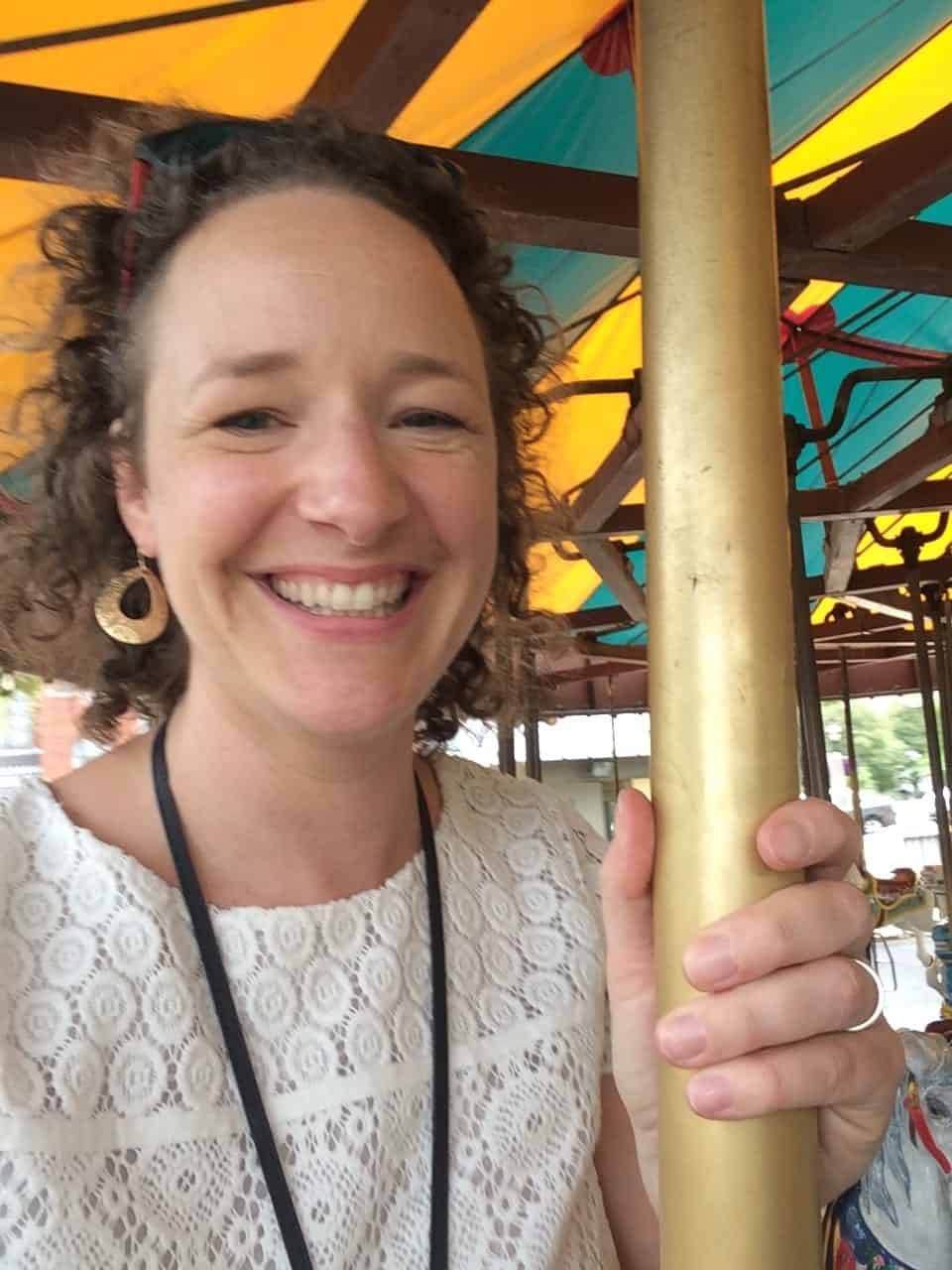
North America
United kingdom & ireland, middle east & india, asia & oceania.

Travel Blog | Travel Inspiration
Free Self-Guided Walking Tour Of Montmartre, in Paris

If you’d love to explore the legendary Montmartre area of Paris and don’t know where to go and what to do, you need this self-guided walking tour of Montmartre.
Why be held back by a slow group tour if you can find your own way and go at your own pace, without missing out on key information and local stories?
My FREE self-guided walking tour of Montmartre gives a manageable route that will take you to the main sights and prettiest streets, highlighting things to do along the way, plus places to eat. I’ve even thrown in a suggestion of where to stay in Montmartre.
Disclosure: This article contains affiliate links. These are links to products or experiences I recommend and if you were to buy something after clicking on them, I might earn a small commission at no extra cost to you. Any earnings go towards the upkeep of this blog, which I appreciate.
Table of Contents
Is Montmartre Worth Visiting?
I definitely recommend it! It’s a charismatic area of Paris. I made a point to visit Montmartre on my first visit to Paris – and I’ve been back many, many times since. I think it’s one of the most romantic things to do in Paris for couples – but I’ve also really enjoyed it with friends and when travelling in Paris solo . Montmartre is for everyone!
A big part of the appeal of Montmartre is its cultural story ; the role it has played in Paris’s history. Between 1872 and 1914, it was the beating heart of the Belle Époque, the golden age of art and innovation in Paris and across Europe. It was a bohemian hotspot and many artists, writers and performers lived and/or worked in Montmartre, where the rents were low. Among them were Claude Monet, Pierre-Auguste Renoir, Edgar Degas, Henri de Toulouse-Lautrec, Pablo Picasso and Vincent van Gogh.
Montmartre was once a hilltop village outside the city limits of Paris. And even though it has been a long time since it was enveloped by the city, it retains a quaint village feel , with its narrow cobbled streets and some cute cottages. There are even a couple of windmills and a small vineyard that remains!
And during Springtime , Montmartre is one of the places you can see cherry blossoms in Paris .

The hilltop location adds another reason to explore Montmartre: its elevated status gives some great views over Paris . The best is from the Basilica of Sacré Cœur de Montmartre, which sits like a gleaming white crown atop the butte of Montmartre.
Overall, Montmartre is a great part of Paris to explore. In fact, wandering Montmartre on foot it’s one of the things I suggest you do even if you only have a small amount of time in Paris. It features in my Paris 4-day itinerary , my Paris two-day itinerary and even my Paris one-day itinerary !
What You’ll See On This Self-Guided Walking Tour Of Montmartre
A few of the Montmartre highlights you’ll discover on this walking tour:
- The beautiful Basilica of Sacré Cœur de Montmartre
- Place du Terte , the beating heart of Montmartre
- Picture-perfect bohemian cafes including La Maison Rose & Le Consulat
- Pretty cobblestone streets including Rue de l’Abreuvoir & Escalier du Calvaire
- Artistic landmarks, including Musée de Montmartre & Le Bateau-Lavoir
- Montmartre’s tiny vineyard, Vigne du Clos Montmartre
- Contemporary monuments, including Wall of Love & Le Passe-Muraille
- Peaceful parks, including Square de la Turlure & Square Suzanne Buisson
- One of the classic Parisian cemeteries, Cimetiere de Montmartre
Self-Guided Walking Tour Of Montmartre in Paris
I’ll step you through this self-guided walking tour of Montmartre, describing the route and also the things to do in Montmartre along the way. However, there’s also an interactive map at the end of this article to help you find your way around.
How long does it take to walk Montmartre? In total, there are around 50 minutes of pure walking, but of course, it will take longer than that as you’ll be stopping to look at and do things along the way. I’d suggest you give yourself a couple of hours to do this walk.
Heads up: this route includes some hills! There is one place where you can avoid a steep incline by taking a funicular, but it’s hard to avoid some steepness altogether, so be aware there are slopes and steps involved.
1. Start: Anvers To Sacré-Cœur
Our walking tour of Montmartre starts at Anvers Metro station because it is the closest Metro to the most spectacular landmark in Montmartre, Sacré-Cœur . Anvers station has one of those classic Art Nouveau Metro entrances, so the first thing you do might be to admire that for a moment.

After that, head uphill along souvenir shop-heavy Rue de Steinkerque toward the Sacré-Cœur Basilica . At Place Saint-Pierre, you’ll be at the bottom of the gardens below Sacré-Cœur, and you could find a nice spot to photograph the basilica with the old-school fairground rides in the foreground.
You can either continue to walk up the hill, through Square Louise Michel OR you could take the easy route via the funicular to the left of the gardens (this costs the same as a single ticket on the Metro: €2.15 each way). Either way, you’ll end up at the top of the hill on Place du Cardinal Dubois, which is right in front of the basilica.

The iconic Neo-Byzantine-Romanesque-style Sacré-Cœur sits on the summit of the butte of Montmartre. From the graceful white dome, on a clear day, it is possible to see all of Paris and the surrounding countryside for fifty km around. It is the second-most visited monument in Paris, after the Eiffel Tower.
Things to do around Sacré-Cœur
- Admire the view over Paris. From Place du Cardinal Dubois, you get a southward vantage point
- Admire the Basilica in all its gleaming travertine glory – it is impressive both outside and inside (and entrance is free)
- Climb up into the elegant dome . For a fee and after you’ve climbed 300 steps, you will discover even better panoramic views over Paris
- Enjoy the perspective-bending view of the ‘sinking buildings’ on Rue Lamarck – a classic photo op is to line the camera up with the steep hillside instead of the houses.

2. Rue de la Bonne & Square de la Turlure
Once you’ve had your fill of the Sacré-Cœur, you might be tempted to follow the crowds westward down Rue Azais or Rue du Chevalier de la Barre towards the famous Place du Tertre. But resist!
Don’t worry, this walking tour of Montmartre will bring you to Place du Tertre, but later on. First, we’re headed to slightly the less touristy northern part of Montmartre, starting with a small city park behind Sacré-Cœur: Square de la Turlure (also known as Marcel Bleustein Blanchet Square).
To get there, walk all the way around the basilica and onto Rue de la Bonne , where you’ll find the park on the right-hand side. This small, attractive park has a nice arched walkway and some places to sit, but the main thing I like about it is the view of Sacré-Cœur from the back. It’s a view I haven’t seen often, with the campanile (belltower) very prominent.

Walk a bit further down Rue de la Bonne and you’ll come to a corner with a view down the hill, over apartment buildings and courtyards. The last time I was here, I paused for a while to watch some people play pétanque down there.
3. Rue Saint-Vincent To La Maison Rose
Head left down Rue Saint-Vincent , which is a handsome street with some more viewpoints, attractive squares and staircases.

Soon you’ll come to a junction with Rue des Saules. On the right is Lapin Agile , a 19th-century cabaret bar. This place was in the centre of artistic Paris at the turn of the century and became a favourite spot for struggling artists and writers, including Picasso and Modigliani.
On the left, you’ll find what looks like a garden, but is actually a vineyard, Vignes du Clos Montmartre , which still produces wines from a variety of grapes. Unfortunately, it’s closed to the public, but it is interesting to see the oldest vineyard in Paris, even though you can only look at it from the street.

Head up Rue des Saules and on the right, soon you’ll find a popular spot in Montmartre: La Maison Rose was another artist’s hang-out at the turn of the 20 th century, and also in the 1960s and 70s . This pink café/restaurant with pint-green shutters is an Instagram favourite due to its picturesque exterior and pretty pavement seating area. This could be a good spot to take a break and get some refreshments if you need them. In spring and summer, it will be very popular for brunch, so you might be best to book ahead. However, if you come on a Monday or Tuesday, it won’t be open.

From here, our walking route continues down Rue de l’Abreuvoir, but you could detour to Montmartre Museum .
It’s a small museum, which tells the story of bohemian Montmartre in the 19 th and 20 th Centuries, with lots of Art Nouveau prints and classic Toulouse Lautrec posters and artefacts, including details about the rise of the Can-can dance. It also has a preserved studio of artist Suzanne Valado; a cafe and a lovely garden, which has a view over Vignes du Clos. I’ve been a couple of times and really enjoyed it.
4. Rue De l’Abreuvoir
La Maison Rose is at the top of Rue de l’Abreuvoir , widely touted as one of the most beautiful streets in Paris . And they’re not exaggerating. This cobbled street has a number of charming pink and ivy-clad cottages along it. However, if you reach the bottom and you’re not impressed with it, turn around and look back up the hill.
Not only is the curved cobblestone street lined by those quaint buildings, but the domes of the Sacré-Cœur are visible just beyond it – it’s so quaint and gorgeous.

The best place to appreciate the view of Rue de l’Abreuvoir is from Place de Dalida , the corner of the street where there’s a small bronze bust. This is Buste de Dalida , a tribute to one of France’s most popular singers. She lived in Montmartre until her tragic death in 1987.

There are some steps from here down to Place Constantin Pecqueur, from where you could take another detour and check out handsome Rue Calaincourt, if you like. But if you want to stick with my route, you’ll be turning into one of the remaining (for now!) quiet corners of Montmartre next…
5. Allée des Brouillards, Square Suzanne Buisson & Place Marcel Ayme
From Place Dalida, take the pedestrian passageway next to a gated garden. Its sign isn’t that obvious, but it is signposted as Allée des Brouillards . It’s a short passageway, but quite pretty and I don’t normally see many other people on it, so it still feels ‘lesser known’ (I won’t say ‘hidden gem’, because that will be over-promising!). Once you’ve walked down it, if you look back the way you’ve come, you should be able to see the bell tower of the Sacré-Cœur, above the treetops.
Allée des Brouillards ends in some cute, ivy-clad steps at Place Casadesus , where you will see the entrance to a park.

Suzanne Buisson Square a small park, which is a good spot to sit and simply soak up the vibes of Montmartre. It has a nice fountain, some seating and a pétanque terrain (I had to look that up: it’s the name for the area pétanque is played). If you need a rest by this point, this is a good place to do it.

Whenever you leave the square, head to the junction of Rue Giradon and Avenue Junot. There’s a detour you could take down Avenue Junot to peek at Villa Leandre , another of the prettiest streets in Paris, in my opinion.
And in Place Marcel Ayme , there’s a quirky statue that appears to be emerging from within the wall, Le Passe-Muraille . There are also some cherry trees here, which are so pretty when in bloom.
The southern end of Rue Girardon has Theatre Lepic. And right at the end, you’ll find Le Moulin de la Galette , a restaurant made famous by the Renoir painting Bal du moulin de la Galette . This is a great place to grab lunch if you’re here around lunchtime.

The restaurant is named for the 17th-century windmill, whose owners were famous for their galette bread.
6. Rue Lepic To Place Du Tertre
At Le Moulin de la Galette, turn right along Rue Lepic . This will curve to the left as you head uphill. Where it comes to a junction, you’ll see a small octagonal building called La Commanderie Du Clos Montmartre , a pretty but decommissioned water tower.
Head right here along Rue Norvins and soon you’ll be in a quaint cluster of establishments including a shop selling old prints called Galerie Butte Montmartre the very picturesque Le Consulat cafe. This is another place that is frequently found on ‘cutest in Paris’ lists and it claims past patronage from artists including Picasso, Van Gogh, Toulouse-Lautrec and Monet.

It will likely feel busier here: you’re heading into the more touristy part of Montmartre now.
Unless you fancy a bite to eat in Le Consulat, carry on to the right of it and soon you’ll be in Place du Tertre . This square was opened to the public in 1635 as Montmartre village central square and was a hub of activity during Montmartre’s bohemian period in the late 19 th and early 20 th centuries.

If you’re in Paris in winter , Place du Tertre will be a quiet space to wander between trees; in summer, it will be packed with artists selling their wares and terrace seating for the many restaurants around the edges.
If you can find a spot, grab a drink on a terrace and enjoy the buzz. I prefer Chez Eugene , which offers a good view of the square for people-watching.
Once you have had enough (or if it is just too hectic for you to linger there), get ready for some downhill walking, because the next stop is lower down the butte of Montmartre.
7. Escalier Du Calvaire & Place Émile Goudeau
On the southern side of Place du Tertre, you’ll find a set of pretty steps, descending down the hillside: Escalier du Calvaire . Walk down the steps, enjoying the view as you go.

At the bottom, turn right along Rue Gabrielle and stay with the road as it bears left. Soon you’ll come to a small square with trees, benches and an attractive Wallace Fountain. This is Place Émile Goudeau and not only does it have a pretty view between buildings, it was home to another artist’s landmark: Le Bateau-Lavoir .

Le Bateau-Lavoir (or, Washhouse Boat) was the nickname for a kind of unofficial clubhouse for several artists in the late 1800s, most famously Pablo Picasso. Here he painted several works, including a painting that signalled his move into cubism, Les Demoiselles d’Avignon .
8. The Wall Of Love
From Place Émile Goudeau, head downhill and down Rue Ravignan, then left onto Rue des Abbesses and into Place des Abbesses. This is a small square with one of only two original ‘Dragonfly’ entrances to the Metro. There’s also a cute old carousel and in December, this is the location of one of the sweetest Christmas Markets in Paris .
Here you’ll find Square Jehan Rictus and the Wall of Love . This monument to love was created in 2000 and is composed of 612 tiles, on which the phrase ‘I love you’ is featured 311 times in 250 languages. See if you can find it in your language!

9. Rue Des Abbesses To Cimetiere De Montmartre
From the Wall of Love, head west along Rue des Abbesses , a classic Parisian street with plenty of cafes with street terraces. When you come to Rue Tholoze on the right, check out the Art Deco cinema, Studio 28 , which was featured in the movie Amelie. It was the first avant-garde cinema on the right bank and opened in 1928. They play a mix of movies, including some in English. It could be somewhere to come back in the evening to if you’re staying in Montmartre.
At the junction by the Terrass Hotel , you’ll find Cimetiere de Montmartre on the left and ahead of you. Officially known as the Cimitière du Nord, Montmartre Cemetery opened in 1825. It is the third largest necropolis in Paris, after the Père Lachaise cemetery and the Montparnasse cemetery.

Strolling a cemetery might not be for everyone, but I suggested it for a couple of reasons. One is the sheer impressiveness of some of the tombs here. In the UK, we tend to have single headstones on graves, but the fashion here is clearly grander. The graves are often marked with tall stone tombs, many with a striking gothic style.
It’s also interesting because there are some historical figures buried here, including the impressionist painter Edgar Degas, writers Emile Zola and Alexandre Dumas and the film director François Truffaut. Dalida’s tomb is also here – and it’s quite a spectacle.
The entrance to the cemetery is a little way along Rue Caulaincourt.
If You Want To Continue Your Exploration Of Paris On Foot…
By this point in your journey, I hope you’ve had an enjoyable tour of Montmartre and that your head is of full of the charming things you’ve seen along the way.
However, if you’re hungry for even more, I encourage you to explore beyond this walking route – it’s never a bad idea to do off the beaten path in Paris .
You could also continue onto nearby Boulevard de Clichy to visit the famous Moulin Rouge theatre: the birthplace of the Can-can and the inspiration for the 2001 movie of the same name. The Moulin Rouge is still a working theatre where you can see cabaret.
If you do that, be warned: it’s not as glam as it looks in the movie! It’s in Pigalle, a red light district in Paris, and the road it’s on is kinda sleazy with lots of sex shops and ‘girls girls girls’ kind of establishments.
Map: Self-Guided Walking Tour Of Montmartre Route
Here are the route and markers for key attractions along this walking tour of Montmartre.
How To Use This Map : Click the tab in the top left-hand corner of the map to view the layers. If you click the icons on the map, you can get more information about each one. If you click the star next to the map’s title, it will be added to your Google Maps account. To view it on your phone or computer, open Google Maps, click the menu, go to ‘Your Places’ or ‘Saved’, then click Maps and you will see this map in your list.
Where To Stay In Montmartre
I stayed in a great hotel in Montmartre: Terrass” Hotel . It’s an excellent 4-star hotel with two big attractions: it has some rooms with a view of the Eiffel Tower and it has a nice rooftop restaurant and terrace bar – again, with great views.

I treated myself to one of their Eiffel Tower rooms and it was lovely: a big room with all the amenities I could ask for. Terrass” Hotel is definitely one of the best places to stay in Paris for first-timers .
Other Hotels in Paris
If you want some more hotel ideas, here are some of the other Paris hotels I recommend. I’ve stayed at these hotels myself recently (in the last 2 years), and I’d happily return to them:
La Finca Hôtel & Spa (formerly called the Hotel Auberge Flora) is a 3-star hotel in the vibrant Bastille area, which has lots of bars and cafes. The rooms are small but comfortable, have all the amenities you need, plus the staff are friendly. They have a bar downstairs and they offer a simple, affordable breakfast in the morning.
Hôtel Diva Opéra is a boutique 4-star hotel in Fauberg-Montmartre , which is really central, making it a great place to stay if you want easy access to places like the Grands Magasins of Boulevard Haussmann and some of the best covered passages in Paris
Hotel Regina Louvre is a grand old hotel next to the Louvre . This 5-star is traditional and also luxurious, with some elegant Art Nouveau design features in the lobby. Some rooms have a view of the Eiffel Tower (mine did – it was a wonderful surprise!)

For more ideas on places to stay, check out my post on the best hotels in Paris for first-timers .
Where To Eat In Montmartre
I’ve already mentioned La Maison Rose and Le Consulat , both of which are picture-perfect brunch/lunch spots, with bohemian heritage. However, I really liked these two places:
- Le Moulin de la Galette – I mentioned this place earlier. It has an interesting heritage and a classic French menu. I had onion soup followed by classic steak frites there and it was delicious!
- La Boite aux Lettres – this small and unpretentious bistro on Rue Lepic has an innovative menu with a focus on seasonal produce.
In Conclusion
Walking is a great way to explore the historic and culture-rich area of Montmartre in Paris. I hope this free self-guided walking tour helps you discover the best of Montmartre. However, if you feel like you’d prefer to follow a guide, you could join a guided walking tour of Montmartre .
And if you’re interested in even more ideas about the historic corners of Paris, check out my review of the best covered passages in Paris . And if you’re travelling to Paris solo, dive into my comprehensive guide to solo travel in Paris .
Have fun strolling around Montmartre!
If you like this article, I'd be delighted if you shared it!
About The Author
Martha Knight
Related posts.

Best Places To Stay In Paris For First Timers: Great Hotels For 2024

38 Things To Do in Paris In Winter In 2024

Discover The Best Covered Passages In Paris In 2024

Most Beautiful Streets In Paris To Stroll Down In 2024

Solo Travel In Paris: Tips, Ideas & Itinerary For Visiting Paris Alone In 2024

Paris in Spring: 26 Gorgeous Spring Things To Do In 2024
Leave a comment cancel reply.
Your email address will not be published. Required fields are marked *
Save my name, email, and website in this browser for the next time I comment.
This site uses Akismet to reduce spam. Learn how your comment data is processed .
Privacy Overview

Day Trip to Montmartre, a Self-Guided Walking Tour
Is montmartre worth visiting.
Yes, a day trip to Montmartre Paris France is worth it! Montmartre is known for its cobblestone streets, beautiful architecture, pretty street cafes, yummy pastries, artists drawing caricatures, vineyards, cabarets, carousel, the famous Sacré-Cœur, and having one of the best views of Paris. Spend the perfect day in Montmartre with this self-guided walking tour to 25 of the best things to do and see in the bohemian community.
Montmartre was once a rural area with orchards and vineyards. Artists began moving into the area in the late 1800s due to low rent and the area filled with cafés and cabarets. Today people flock to Montmartre to visit Sacre-Couer, enjoy the overlook of the city, and walk the cobbled streets of Renoir, Picasso, Dali, and Van Gogh. Be sure to watch Amélie and Paris, and J’taime before your visit. Also, download a playlist of Dalida , a famous French singer who lived in Montmartre, on Spotify to listen to as you explore the area.
READ Complete France Travel Guide, What You Need to Know
READ 100 Things to Do in Paris, a Bucket List City

How to Get to Montmartre
Montmartre is a quick 5-minute Metro ride from Paris. Montmartre is located in Paris’ 18e Arrondissement, atop a large hill. Begin by taking the metro line 7 to Lamarck-Caulaincourt, and be sure to stop to admire the façade. This is the highest point in the area accessed by metro allowing you to descend as you explore, for the most part. Alternatively, you can take an Uber, hop-on-off bus tour, or the mini train from Moulin Rouge to the top and make your way down from Sacré-Cœur.
Important to Know Before You Go
- Be sure to wear comfortable shoes, there is no way to avoid stairs and uphill walks on cobblestone.
- Try to avoid visiting on Monday, as many smaller shops & restaurants are closed.
- The best time to visit Montmartre is in the morning before the crowds arrive.
- Bring a fillable water bottle, there are free fountains for refills.
- Be aware of pickpockets and scams; keep belongings close to you, do not stretch your hands out to anyone or agree to sign anything.

Day Trip to Montmartre Paris France
Top things to do in montmartre.
Lamarck-Caulaincourt Metro sign, Saint-Vincent Cemetery, Cabaret Au Lapin Agile, Vigne du Clos Montmartre, La Maison Rose, Rue de l’Abreuvoir, Buste de Dalida, Le Moulin de la Galette, The Passe-Muraille, Le Consulat Restaurant, Dali Paris, Place du Tertre, Chateau d’eau Montmartre, Musée de Montmartre, Rue du Mont Cenis Stairs, Square Marcel Bleustein Blanchet, rue du Chevalier-de-La-Barre stairs, Sacré-Cœur, overlook of Paris, sinking house, Funiculaire Gare Basse, Square Louise-Michel and carousel, Wall of Love, Moulin Rouge, Terass Hotel rooftop terrace.
Self-Guided Walking Tour of Montmartre, Step-by-Step Itinerary
Begin at the Lamarck-Caulaincourt Metro. Begin walking up and pass the Saint-Vincent Cemetery on the way to Cabaret Au Lapin Agile, the oldest bar-cabaret in Paris.
Continue on Rue des Saules to Vigne du Clos Montmartre, the last working vineyard in Paris. Have lunch at Instagram’s famous La Maison Rose.

Walk down Rue de l’Abreuvoir and stop at Buste de Dalida and rub her breast to be lucky in love. Note: you can also visit her tomb at the Saint-Vincent Cemetery if you are a fan.
Turn left on Rue Girardon and continue to the landmark Le Moulin de la Galette, one of the two remaining windmills in Montmartre. Now, backtrack to Pl. Marcel Aymé and turn right to see “The Passe-Muraille” (The Man Who Walked Through Walls) sculpture.

Continue on to the pretty Rue Norvins and Le Consulat Restaurant. To visit the Dali Museum, turn right on Rue Poulbot. Otherwise, follow Rue Norvins to Place du Tertre. Spend some time in this square admiring the artist’s paintings and have your caricature done.
Keep going and turn left at Rue du Mont-Cenis. Pass the Chateau d’eau Montmartre (water tower). Turn left on Rue Cortot to visit the Musée de Montmartre, or, continue on to the Rue du Mont Cenis Stairs.

You can now go down the stairs and come back up around the corner, or, backtrack to Rue du Chevalier de la Barre and wind around to Square Marcel Bleustein Blanchet. Either way, stop for photos looking back at Sacré-Cœur and relax in the park before continuing on.
Check out the Rue du Chevalier-de-La-Barre stairs before continuing around the base of Sacré-Cœur and entering the famous church. If you have the energy, climb another 300 stairs to the top of the dome for incredible city views.

Exit the church and stop at the overlook of Paris for photos. Continue down the stairs and turn back for photos of Sacré-Cœur. Now, head left for a view of the Eiffel Tower and right to get that photo of the sinking house you have seen on Instagram.
Ride the Funiculaire Gare Basse (fare is equal to Metro fare and included in Metro pass) or continue walking down to the Square Louise-Michel and ride the famous carousel.
Make your way from Square Louise-Michel to the Wall of Love made of 612 tiles that say ‘I love you’ in 250 different languages. You are now at the Abbesses Metro stop and can make your way back to the hotel.

Want to stay for the evening? Purchase Moulin Rouge tickets for the 7PM dinner and 9PM show. Or, stop at Terass Hotel and enjoy a cocktail with views of the Eiffel Tower and Sacré-Cœur from the rooftop terrace.
Check the Montmartre Office of Tourism website for additional information.
Bookmark and Pin Day Trip to Montmartre, a Self-Guided Walking Tour

Booking Resources for France Travel
France travel guide.
Pick up a France Travel Guide from Amazon.com to browse on the plane.
Book Your Accommodation in France Now
Spending the night? Search Booking.com and VRBO in one place to find the perfect property!
France Attractions and Day Trips
The best attractions sell out! Don’t chance it, get your tickets now and relax when you arrive.
Travel Essentials
Need a universal travel adaptor, power bank charger, or packing cubes? Save time at my Amazon shop and have travel essentials delivered to your home.
Have a great vacation!
This is something new I saw on the internet today I want to thank you for writing such a great and helpful blog. I really appreciate your efforts.
Thanks for providing such a resourceful info about the place. It’s insightful. Got to know some amazing facts.
Comments are closed.

Montmartre in Paris: A Self-guided Walking Tour
Montmartre is a beautiful neighborhood of Paris. Visit cafes, parks, artists, antique shops, historic buildings and more. Break away from the congestion of downtown Paris and enjoy a self-guided walking tour of Montmartre – which includes Sacre Coeur and Moulin Rouge.

The trail outlined above is roughly three miles. It begins at the Anvers metro stop along the No. 2 line and stops back at the same metro stop.
While three miles doesn’t seem long, you’ll still want to make sure you have great walking shoes. Also plan on multiple, long staircases that you will go up and down along the path.

Sacre Coeur: The Carousel, Funicular, Stairs and Basilica
Sacre Coeur, which translates to Sacred Heart, is a beautiful white basilica built on a small hill outside of Paris. It’s also one of the more iconic and touristy spots of Paris.
As you arrive at the bottom of the hill, you’ll find a beautiful little carousel. If you have young kids (or you want to act young), take a ride before heading up the hill.
There are two ways up the hill. The funicular is part of a regular metro pass, and is a quick and simple way up the hill. If you want to take the stairs, beware of people who try to stop you and give you a little bracelet made of string. They will ask you to pay them after pretty much shoving a bracelet on your wrist.
RELATED POST: Your guide to the Grevin Wax Museum in Paris
At the top, enjoy a visit inside the basilica. They will check your bag as you walk in, so have it open and ready to keep the line moving. Enjoy your visit inside and be respectful – it is a church, not a theme park.

Bonus: The Sinking House
As you make your way up the stairs to Sacre Coeur, keep an eye out to the right side of the stairs. Near the top, there’s a camera trick you can use to capture a sinking building – or what looks like a sinking building. Simply rotate your camera about 30 degrees so the green grass (hillside) is parallel to the top and bottom of your viewfinder. This becomes the new horizon. As a result, you get the above photo.

Montmartre Museum
The Montmartre Museum provides you with a little history of the neighborhood. You can learn about many of the artists and writers that called this area home.
During your visit, you’ll find works of art from many of the artists, including the largest collection of Monet’s art in a single space. You can also visit the Renior Gardens and get a nice view of the vineyard, which is the next stop on the self-guided walking tour.
RELATED POST: 12 Things to See at the Louvre Museum in Paris
The museum is open every day from 10 a.m. to 7 p.m. (Apr-Sept) and 10 a.m. to 6 p.m. (Oct-March). Costs are roughly 12 Euro for adults, which includes and audioguide.

Le Clos Vineyard of Montmartre
What makes this grape vineyard unique? The fact that it’s a full-functioning vineyard in the middle of the city. Most vineyards are out in the countryside on large open areas of land. So Le Clos Vineyard is a welcome site in an area packed with houses.
The vineyard is not open to the public. But you can wander around the outskirts of the area to observe. While we were there, the grapes were covered in this netting. Not entirely sure why, but it was.
If you’re looking to point out something fun to others in your group, look at the handle on the gate into the vineyard. It’s a little wine bottle. Kind of fun, right?

La Maison Rose
La Maison Rose is a famous little restaurant in Montmartre. The pink walls will probably catch your eye as you walk by it. You learned about the artists who lived in the area earlier in this post, so it should go without saying that artists like Picasso frequented this quaint little cafe and restaurant.
Want to enjoy a meal at La Maison Rose? Book a reservation in advance of your visit, then enjoy appetizers and small plates. The cafe is closed on Tuesdays, and Thursday evening (18:30 – 23:30) and Friday to Monday (12h – 23h30).

Bust of Dalida
Dalida was a famous French singer. She isn’t well known in the English music scene, she was popular in the French culture. In fact, she sold more than 170 million albums and singles worldwide.
In 1987, Dalida committed suicide. Ten years later, Place Dalida (located at rue de l’Abreuvoir and rue Girardon) was dedicated and this bust was erected.
You’ll probably noticed the discoloration of the breasts of Dalida. It’s because of a superstition that good luck comes to those who rub the breasts of this Dalida bust. Apparently, it’s a popular thing to do and many people are superstitious. 😉

Moulin de la Galette
Along the route, you’ll find Moulin de la Galette. While it looks like just another windmill, it has a rather interesting past. The windmill was built in the 1600s and the miller used it to grind flour for bread. Famous artists that inhabited Montmartre immortalized it in paintings, like Renoir’s Bal du Moulin de la Galette .
Where it gets interesting is during the early 1800s and the end of the Napoleonic Wars. During one of the sieges of the area, many men were killed trying to defend the windmill. When the miller was killed, his body was nailed to the wings of the windmill.
Currently, the Moulin marks the entrance of a bistro known as Le Moulin de la Galette. If you need a bite to eat on your walk through the neighborhood, it’s worth checking out.


Fountain of the Ancient Reservoir
I knew nothing about this fountain before walking past it on our stroll through the streets. But it was a picturesque stop on a beautiful day. The gates around the fountain were closed, so we weren’t able to get any closer to the bronze urn.
The fountain/reservoir was built in 1835 to hold water for the surrounding neighborhood.

Le Consulat Restaurant
Like many of the stops in Montmartre, there are many spots to walk where the great artists walked. Le Consulat is one of those locations. It reminds me a little of the Flat Iron building in New York City – it stands alone on a narrow strip of land, lined by streets on both sides.
If you want to grab a quick coffee or glass of wine, stop in Le Consulat. If you’re looking for more of a quick bite or lunch-time meal, you can grab a seat inside or out and enjoy some French cuisine.

Place du Tertre: Artists Square
We both loved wandering around Artists Square, also known as Place du Tertre. When watched as several artists created some amazing works of art. The artist above used nothing more than a knife to paint. Others used brushes, some pencils or charcoal.
All of the artists sell their paintings. If your looking for something more custom for your home, they’ll paint a portrait of you – either solo, as a couple or a family. If you decide to have that done, plan on sitting for a while. I also recommend scoping out the artists to make sure you pick the artist that will paint the style you want for your home – because each one is unique.

The Wall of “I Love You”
When I was dating my wife, she said she knew how to say “I Love You” in several languages. When I found out there was a Muir de Je t’Aime ( Wall of I Love You ) in Montmartre, I wanted to surprise my wife by not telling her about this stop until we got there.
Once there, I pulled out a red ring pop and asked her to marry me again. I’d used a ring pop in my initial marriage proposal, so it was something I thought she’d enjoy. We shared a laugh about it and then started looking for all the different ways to say I Love You. We were able to identify a few of the languages, but since I Love You is written 311 times, it may take some time to find the languages you recognize.
RELATED POST: Explore the Army Museum in Paris
The area can get pretty packed, but hopefully people will be courteous and people will let you step up to the wall for your photo – or even marriage proposal if you’re looking for a romantic spot. 😉

Moulin Rouge
The iconic red windmill of Paris, known as the Moulin Rouge, is one stop along the walking tour. I would’ve loved to photograph it at night with the lights all a glow, but we hit it up midday.
Moulin Rouge is a cabaret club, so there are dinners shows available each evening. However, it should be noted that those shows are cabaret – topless women in ornate costumes. In the United States, kids wouldn’t be allowed in such a club, but from what I’ve seen on various Facebook groups about things to do in Paris, the age requirement was pretty low.
After grabbing a photo of the Moulin Rouge, the route along the Boulevard de Clichy has numerous adult toy and lingerie shops. If you’ve got your kids with you, you may want to take the side streets. But that’s just me.

Antique Shop: Objet qui Parle
Although there are many souvenir shops throughout Montmartre, one I had read about and was interested in visiting was an antique shop. Sadly, the month of August typically has several small stores closed while the owners take their annual vacation. L’Objet Qui Parle (which translates to Object that Speaks) was closed. But it’s worth checking out to see what antique treasures you can find in Montmartre.

Montmartre is a beautiful and classic-Parisienne neighborhood. From the Sacre Coeur Basilica to the artists square, you won’t regret your walk as you explore the small streets. And if you wander off the marked path above, you’ll likely discover other hidden gems of Montmartre. And don’t forget to have a good pair of walking shoes or your feet will remind you often that you wore the wrong shoes.

Share this:
Similar posts.

Santon Village – A Cultural Museum in Southern France
Twenty years ago, I was living in a small town in Southern France. I learned all about the culture and even brought a little piece of it home with me. I purchased a nativity set of little clay people known as santons. They’re indicative to southern France and are a great reminder to me of…

Paris Art Museum: Musee D’Orsay
Renoir. Monet. Degas. Cezanne. Rodin. Those are a few of the amazing artists featured in this Paris art museum – the Musee D’Orsay. Before becoming a museum in the 1980s, it was a magnificent train station in the heart of Paris. The building itself is a work of art, both inside and out. On the…

Paris Art Museum: Musee de l’Orangerie
Paris is full of art. Especially art museums. During our trip, we spent hours looking at art from probably hundreds of artists. It was at the Musee de l’Orangerie – a smaller Paris art museum – that I discovered the piece of art that I would love to have hanging on the walls in my…

Science Museum in Paris – Palais de la Decouverte
Paris is full of art museums and historic buildings. While many tourists flock to them, there’s one spot I think everyone should visit (tourist or local) – Palais de la Decouverte. In English, it translates to Palace of Discovery. In other words, it’s a science museum in Paris. My wife and I came across some…

Versailles Palace and Gardens: A Visitor’s Guide
When someone says they’re going to Paris, there are two places I tell them they need to visit. The Eiffel Tower and Versailles. The palace and the gardens are magnificent. My favorite part was renting a rowboat and taking it for a spin in one of the ponds. It felt like royalty… but without the…

International Travel: 7 Things You Should Know Before You Leave Home
Planning a vacation out of the country can be stressful. There are a lot of questions about passports, electricity, money, safety and more. I’ve traveled to France, Czech Republic, Mexico and Canada. With international travel, I learn a little more each time I head abroad. I’ve compiled a list of a few things you need…
One Comment
- Pingback: Eiffel Tower: A Visitor's Guide - Carltonaut's Travel Tips
Leave a Reply Cancel reply
Your email address will not be published. Required fields are marked *
Notify me of follow-up comments by email.
Notify me of new posts by email.

One Day in Montmartre – A Detailed Itinerary

Ain’t no place like Montmartre!
A trip to Paris won’t be complete without visiting Montmartre. The neighborhood is a remarkable microcosm not to be missed.
Located in the 18 th arrondissement, Montmartre is one of the prettiest districts in Paris, and if there is one place you shouldn’t skip, it’s definitely this one.
I’ve visited the neighborhood many times; and yet, Montmartre still manages to surprise me. Recently, I have compiled a comprehensive travel guide to Montmartre . Now,here’s my (free) self-guided Montmartre itinerary. So that you can spend less time planning and more time enjoying your best Parisian experience.
Table of Contents
One Day in Montmartre: Map
One Day in Montmartre: The Complete Itinerary
Step 1- the wall of love (le mur des ‘je t’aime’) .

Start by taking the Parisian Metro (Metro Line 12) and exit at “Abbesses station”. Head north on Rue de la Vieuville toward Place des Abbesses. The Wall of Love (Mur des ‘ Je t’aime ’ in French) is located in the Square Jehan Rictus.
Created in 2000 by Frederic Baron and Claire Kito, the 40-square meter mural is a wall dedicated to love. The mural is composed of 612 tiles of enameled lava, and displays 311 ways to write ‘I love you’ in 250 different languages. We, of course, found it in Nepali! The little red splashes on the wall represent the pieces of a broken heart.
Step 2- Place Emile Goudeau & Bateau Lavoir

Head back to Place des Abbesses and turn right on Rue des Abbesses. Then, turn right on Rue Ravignan and go straight on until you reach Place Emile Goudeau.
Located on the charming square ‘Place Emile Goudeau’ (No.13), ‘ Bateau-Lavoir ’ is a building that houses workspaces for young artists.
Bateau-Lavoir was originally a piano factory. But in 1889, the owner decided to divide the building into a dozen of small artist workshops. Bateau-Lavoir soon became the residence of many famous artists and writers: Paul Gauguin, Pablo Picasso, Modigliani, Max Jacob, Henri Matisse, Guillaume Apollinaire, Renoir and many others. It is there that Picasso made his famous painting ‘Les Demoiselles d’Avignon’ in 1907. ‘Bateau-Lavoir’ was the nickname given by Max Jacob. It means ‘ Laundry Boat ’ in French. With its small studios distributed along a long narrow corridor, the interior of the building looked like a boat, and there was only one water point (‘ Lavoir ’ means ‘wash house’ in French). A fire completely destroyed the building in 1970; only the façade survived the accident. The Bateau-Lavoir was totally rebuilt in 1978.
Step 3- Café des Deux Moulins

Head back to Rue des Abbesses via Rue Ravignan. Turn right and continue on Rue des Abbesses. Turn left on Rue Lepic. Go straight until you reach the Café des Deux Moulins at No.15, rue Lepic.
Before visiting Montmartre, you might want to watch ‘ Le Fabuleux destin d’Amélie Poulain ’. The 2001 French movie is great and its main location is the Montmartre district. In the movie, Amelie works at ‘ Le Café des Deux Moulins ’. The café became quite a tourist attraction, but has managed to stay very authentic somehow.
Although there are some bad reviews on Internet regarding the service, I went there few times (including one time pregnant asking a slight change (or two) in the menu), and the staff was always helpful and super friendly. Besides, the food is quite good and prices are very reasonable. Give it a try, at least for a coffee!
Step 4- Montmartre Cemetery

Turn right on Rue Cauchois, then turn right again to stay on Rue Cauchois and continue on Rue Constance. Turn left on Rue Joseph de Maistre. Then, turn left on Rue Caulaincourt (walk across the bridge). Take the stairs to reach Avenue Rachel. Go straight (under the bridge) and you’ll reach the Cemetery of Montmartre.
Montmartre Cemetery is the second largest cemetery in Paris. It is a peaceful and beautiful place located in the heart of Montmartre. It is known as the Cemetery of the Artists.
One of the most unique tombs you’ll see is, without doubt, the one belonging to Michel Berger, France Gall and their daughter Pauline Hamburger. Another famous grave is the (quite impressive) tomb of Dalida.
Step 5- Van Gogh’s House

Head back to Rue Joseph de Maistre via Rue Caulaincourt. Turn left on Rue Lepic. At No.54 Rue Lepic, you’ll find the former apartment of Vincent Van Gogh, one of the greatest post-Impressionist painters of all time.
Vincent Van Gogh lived in this building, on the 3 rd floor, with his brother Théo Van Gogh, from 1886 to 1888, before relocating to the south of France. The room of Vincent had a small window with open views on the roofs of Paris, and he quickly created many paintings of the Paris skyline, as well as the Montmartre countryside and windmills. It is also in Montmartre that Van Gogh produced his extraordinary series of self-portraits.
Step 6- Rue Durantin and La Cour aux Juifs
Head north on Rue Lepic and turn right on Rue Durantin. Rue Durantin is a street that is quite well-known by the locals, not much by the tourists though. However, it is a street that is worth to wander through, at least for its stunning architecture.
At No.40 Rue Durantin, you’ll find one of the most beautiful courtyards in Paris. Dating back from the Restoration period, it is known as ‘La Cour aux Juifs’, and has always been a favorite location for filmmakers.
Step 7- Moulin Blute Fin and Moulin de la Galette

Continue on Rue Durantin and turn left on Rue Tholozé. From this street, you’ll see the old Moulin de la Galette (Blute-Fin ), built in 1622, in front of you and from there, you can reach Rue Lepic.Turn right on Rue Lepic. At No.83 Rue Lepic, you’ll find ‘ le Moulin de la Galette ’ ( Radet ), built in 1717.
These windmills are the last two windmills of the 14 windmills that stood once on the Butte Montmartre.
Originally used to grind flour, these two windmills soon became a guinguette where people came to eat a millet galette (flat brown bread) with a glass of milk. Then, the glass of milk was replaced by a glass of wine and the guinguette became a cabaret. In 1834, the place was extended and became a popular and iconic open-air dancing hall with gardens. It is at the ‘Moulin de la Galette’ that Auguste Renoir made his famous painting ‘ Le Bal du Moulin de la Galette ’ in 1876 (now in Musée d’Orsay).
The windmill Radet was restored in 1978 but never used again. However, le Moulin de la Galette was transformed into a restaurant around 40 years ago. It was one of the favorite restaurants of Dalida.
Step 8- Le Passe-Muraille

Turn left on Rue Girardon and then, turn right on Place Marcel Aymé. Check out the sculpture “Le Passe-Muraille”, a statue stuck in a wall.
The sculpture was inspired by Marcel Aymé’s book “ Le Passe-Muraille ” and represents the fictional character Léon Dutilleul who had the power to walk through walls but ended up stuck into one after abusing his power.
The statue was made in 1989 by sculptor Jean Marais and is dedicated to the writer Marcel Aymé, who was a resident of Montmartre. The statue represents the writer Marcel Ayméhimself in the role of Léon Dutilleul.
Step 9- Avenue Junot, Villa Léandre et le Rocher de la Sorcière
Head back toward Rue Girardon and continue straight on Avenue Junot.
There is the Montmartre of tourists who stay around the Sacré-Coeur and Place du Tertre, and there is the ‘Montmartre of the Montmartrois’ (the residents of Montmartre don’t call themselves Parisians but Montmartrois). Trust me, you also want to wander the backstreets.
‘Avenue Junot’ is one of the most expensive avenues in Paris. This discreet avenue isn’t very touristic. Nevertheless, Avenue Junot offers many surprises:
— Le Club Lepic Abbesses Pétanque (CLAP): a hidden place where you can play ‘pétanque’ (les boules) with locals (French style) in a very (French) countryside atmosphere.
— Located at 23, Avenue Junot, the most secret Parisian Hotel of Montmartre ‘ Hotel Particulier Montmartre ’ opened since 2007. Former residence of the Hermes family, the Hotel has only 5 Suites and is known to be quite exclusive. Many celebrities (such as Brad Pitt, Kristen Stewart, …) prefer the discretion of this romantic refuge to a Palace.
— Did you know that there is a witch’s rock in Montmartre? This one is totally off-the-beaten-track. Hidden behind a fence in a private passageway between No.23, avenue Junot and No.65, Rue Lepic, the witch’s rock is one of the last vestiges of the Maquis de Montmartre (former ghetto of Montmartre). Many of the habitants thought for a long time that it was a meteorite that felt here to protect the home of a witch ( in fact, it is an ancient disused fountain and the rock is nothing but fake! ). The passage isn’t accessible to the public. However, there is a way to still witness the Witch’s rock. You can now eat (or have a tea) at the restaurant of the ‘Hotel Particulier Montmartre’, and from there, you can access the passageway to see the rock.
Accessible from Avenue Junot between the No.23 and No.27, the picturesque ‘Villa Léandre’ is really an atypical street. Built in 1926, it is the most charming impasse of Montmartre. Here, you’ll find British-style houses with small cute front yards. Do not miss the No.10, a nod to the residence of the Britain’s Prime Minister, 10 Downing Street in London.
Step 10- Square Suzanne Buisson

Head back toward Rue Girardon and take the first impasse on your left (before reaching Rue Girardon): the impasse Girardon will take you to the hidden Square Suzanne Buisson.
The Square Suzanne Buisson, named after the French political activist Suzanne Buisson, is popular for its beheaded statue of Saint-Denis holding his own head in his hands.
Saint-Denis is known as the most famous cephalophore ( a saint who is depicted carrying his own head ) in Christianity. Saint-Denis was a Christian martyr and the first Bishop of Paris. It is said that after being decapitated, Saint-Denis took his head and walked kilometers; it is supposedly here, on the fountain where the statue is standing, that Saint-Denis stopped to clean his head.
Step 11- Allée des Brouillards
From the Square Suzanne Buisson, head north toward Place Casadesus, turn right and you’ll reach the Allée des Brouillards.
L’Allée des Brouillards is quite an unusual street. Nestled between Place Dalida and Place Casadesus, the unique Allée des Brouillards (meaning ‘Mist Alley’) has still kept a special ‘je-ne-sais-quoi’ mystery. Many renowned artists lived in the pavilions of the Allée des Brouillards: Kees van Dongen, Poulbot, Renoir, …
In the 18 th century, the windmill and the farm located on Allée des Brouillards were bought by the lawyer Legrand-Ducampjean who built a Villa, nicknamed Châteaudes Brouillards.
Step 12- Place Dalida

Continue on the Allée des Brouillards until you reach Place Dalida.
Located on the corner of the picturesque Rue de l’Abreuvoir and Rue Girardon, Place Dalida is a cute little square named after the iconic singer. In 1997, commemorating the 10 th anniversary of Dalida’s death, the city of Paris renamed this square ‘Place Dalida’ and installeda bronze bust of her at its center to pay homage to the star. The statue was sculpted by French artist Aslan.
Born in Cairo, Egypt, in 1933, Yolanda Cristina Gigliotti, better known as Dalida, made Montmartre her home when she bought a beautiful mansion located No.11 bis Rue d’Orchampt in 1962. Dalida lived in this house until her death in 1987. She was an important figure of Montmartre and Dalida is etched in the collective memory of the Montmartre residents.
Located near the Place Dalida (No. 16 Rue Girardon), you’ll find the world renowned Cité Internationale des Arts . Founded in 1965, the foundation offers studio residencies to artists from all over the world.
Step 13- La Maison Rose

Head east on Rue de l’Abreuvoir toward ‘La Maison Rose’.
Located on the corner of Rue de l’Abreuvoir and Rue des Saules, the picturesque ‘ Maison Rose ’ is one of the most beautiful houses in Montmartre. Maurice Utrillo quickly fell in love with this little pink house and painted it many times; one of his most famous paintings was ‘La Petite Maison Rose’ back in the 1900s; it made ‘La Maison Rose’ quite famous worldwide.
The pretty little pink house hasn’t changed much since its opening.
In the 1900s, Laure Germaine Gargallo, one of Picasso’s muses, was the friend of many artists of Montmartre. Among all her suitors, she chose and married the painter Ramon Pichot Girones in 1905. Together, they bought this house on the corner of two cobbled streets in the heart of Montmartre. They painted the house in pink and transformed it into a modest restaurant in 1908. La Maison Rose was born. Throughout its history, the restaurant has welcomed many talented artists: Utrillo, Camus, Picasso, Edith Piaf, …
Step 14- Le Clos Montmartre

Turn left on Rue des Saules and you’ll reach the Clos Montmartre at the corner of Rue Saint-Vincent and Rue des Saules.
‘ Le Clos Montmartre ’ is one of the last vineyards in Paris and belongs to the City of Paris.
The ancestral wine growing tradition exists since a long time in Paris. The vineyards of Montmartre date back to the Gallo Roman period, and reached its peak in the 18 th century. However, the Clos Montmartre only exists since 1933. It was initially created to save the land from urbanization; and today, its main purpose is to maintain the viticulture heritage of Montmartre.
Covering 1,556 m2, the Clos Montmartre manages to produce between 1,500 to 2,000 bottles every year coming from their 1,600 feet of vines. You can buy Clos Montmartre’s wine only in few places: at the Museum of Montmartre, at ‘la Maison des Epicuriens’ (rue Lamarck), on their website ‘ Comité des Fêtes de Montmartre ’ or at the restaurant ‘Le Négociant’ (Place Jean Gabin).
Unfortunately, Le Clos Montmartre is closed to the public. However, every year, in October, there is a (fantastic) 5-day Grape Harvest Festival (‘ Fête des vendanges ’ in French) and the vineyard opens its door for the occasion.
Today, the Grape Harvest Festival of Montmartre is the 3 rd most popular event in Paris. Although there are so many specialties to taste and drink, it is a tradition to taste the wine of Montmartre at the Clos Montmartre (and of course, booking in advance is necessary to visit the Clos Montmartre). Sure, it won’t be the best wine you’ll taste in France but I am quite sure you’ll like the folklore linked to it.
Step 15- Au Lapin Agile

Right across the street from the Montmartre vineyard (Clos Montmartre), you’ll find the cabaret “Au Lapin Agile” at No.22, rue des Saules.
The illustrious cabaret ‘ Au Lapin Agile ’ is quite an institution in Montmartre. It is the last 19 th century cabaret celebrating French music in Paris. It opened 1860, and it is still in operation today. In fact, it didn’t change much since its debut.
Formerly named ‘Au rendez-vous des voleurs’ (‘ At the meeting point of the thieves ’ in English), then ‘Au Cabaret des Assassins’, the house was originally a bar covered with portraits of murderers. The caricaturist André Gill painted the signboard with the famous rabbit on it, which eventually gave its current name to the Cabaret. People began to call the cabaret ‘At Gill’s Rabbit’ ( in French, Au Lapin à Gill) , and over time, it became ‘Au Lapin Agile’. This place is deeply connected with the history of Montmartre and attracted many artists (Picasso, Modigliani, Apollinaire, Toulouse Lautrec, Utrillo to name but a few).
The most famous prank of the village happened here, at the ‘Lapin Agile’. Roland Dorgelès presented a painting ‘ Sunset over the Adriatic ’ supposedly made by an artist named ‘Boronali’, part of the new Excessivist movement, and it had great success. But, neither Boronali, nor the Excessivist movement existed. All of it was invented by Dorgelès. In reality, the painting was made by Lolo, the donkey of Frédé (the owner of the cabaret at that time), with a paintbrush attached to his tail.
‘Au Lapin Agile’ is ‘the’ place to be for an authentic Parisian experience. There, you’ll find the old Montmartre vibe, the Paris of yesteryear everyone is looking for.
Step 16- Museum of Montmartre

Head back toward la Maison Rose and continue on Rue des Saules. Turn left on Rue Cortot. At No.12 Rue Cortot, you’ll find the museum of Montmartre.
The small ‘ Museum of Montmartre ’ is located inside one of the oldest buildings in Montmartre. It was founded in 1960 but the building dates back to the 17 th century. The museum contains many paintings, drawings, posters, photographs and manuscripts depicting the story of Montmartre.
The ‘Musée de Montmartre’ hosts a permanent collection retracing the history of Montmartre and its residents, and is located in the House of Bel Air (‘ Maison du Bel Air ’ in French). The temporary exhibitions are held in the ‘Hotel Demarne’. Besides the museum per se, you can also visit the former atelier-apartment of Suzanne Valadon. It is also at the Museum of Montmartre that you can find a scale model of Montmartre.
Even if you don’t attend to visit a museum during your visit in Montmartre, it is worth to know that you can walk into the ‘ Jardins Renoir ’ (Renoir gardens) for only 5 euros. The view over the Clos Montmartre vineyard is just amazing from there. The ‘Jardins Renoir’ are 3 gardens dedicated to the famous painter Auguste Renoir. In 1876, Auguste Renoir made the beautiful painting ‘ La balançoire ’ (‘The Swing’) right in this exact garden and you can even sit on a swing that is the exact replica of the one in the painting.
Step 17- Dal í Museum

Head back to Rue des Saules, turn left and continue down to the very picturesque ‘ Le Consulat ’ restaurant.

Turn left on Rue Norvins and then, turn right on Rue Poulbot. Continue until you reach the Dalímuseum, at No.11 Rue Poulbot.
I am a pretty huge fan of Salvador Dalí. I have previously visited the Dali museum in Figueres and also his house in Portlligat, both located in Spain. Of course, I have also visited the museum dedicated to Salvador Dalí in Montmartre .
Founded by Art collector Beniamino Levi 1991, the museum displays over 300 artworks of the Spanish surrealist artist Salvador Dali from paintings to sculptures and engravings. It is the largest private collection dedicated to Salvador Dalí.
There are Dalí artworks for sale in the gallery next door (you’ll pass through it before exiting the museum).
Step 18- Place du Tertre

Continue on Rue Poulbot toward Place du Calvaire. Turn left and you’ll arrive at Place du Tertre.
Famous for its painters, portrait artists and restaurant terraces, La Place du Tertre, also known as ‘ the Artist Square ’, is the historic square of the ancient village of Montmartre and an absolute must-see when visiting the district. The word ‘ Tertre ’ means ‘ hillock ’ in French and ‘ Place ’ means ‘ Public square ’.
There, you’ll find many local painters, portraitists and caricaturists working in the open air. This is the perfect opportunity to have your portrait drawn or painted (or why not a caricature!).
I’ll be honest, the Artist Square has changed a bit over the past 15-20 years though. The artists were always in conflict with the restaurant owners; but now, it seems that restaurants are expanding their terraces more and more, taking advantage of the picturesque nature of this unique square. Tourists come to Place du Tertre to see the artists, not to go to a terrace. The seductive folklore of the Place du Tertre is, of course, still attractive, even though it is now fully dedicated to tourism. Especially in summer, this place can be very crowded.
Beware of some shops that are selling paintings ‘ Made in Place du Tertre ’, most of them (and I mean literally thousands of them) are, in fact, made in China (cheaper it is, more the chances are that it was made in China). Please do the artists a favor and maintain the tradition: if you wish to buy a painting, buy it directly from the artist of your choice at Place du Tertre. I did one portrait 12 years ago and I still have it; I can assure you that it is an amazing souvenir to keep. Do not hesitate to take your time and wander around the place to find your favorite artist.
Another important landmark in Place du Tertre is ‘ Chez la mère Catherine ’. Founded in 1793, this restaurant is considered as the oldest bistro in Paris. The legend says it is there that the word Bistro was born. After Napoleon defeat, in 1814, Russians Cossacks were occupying France; some of the Russian soldiers came to ‘Chez la mère Catherine’ and bothered by the slow service, asked in Russian ‘ Bystro! Bystro! ’ meaning ‘ Fast! Fast! ’, hence the creation of the name ‘Bistro’. French linguists argued against this theory and proved that the word ‘bistrot’ came from the slang French ‘bistraud’, meaning ‘wine servant’ at the time. However, legend still stands at ‘Chez la mère Catherine’ and we love it!
Step 19- Sacré-Coeur Basilica

Cross the Place du Tertre to reach Rue Norvins, and turn right on Rue du Mont-Cenis. Then, turn left on Rue Azais and you’ll arrive on the Parvis of Sacré-Cœur.
Perched at the very top of the hill of Montmartre (the highest point in Paris), 130 meters above the ground, the Basilica of the Sacred Heart (‘ Basilique du Sacré-Cœur ’ in French) is a beautiful Roman Catholic church watching over Paris. The magnificent white Basilica is dedicated to the Sacred Heart of Jesus.
The construction of the Sacré-Coeur Basilica came from a ‘National Vow’ initiated by two faithful followers (Alexandre Legentil and Hubert Rohault de Fleury) in 1870, after the defeat of France in the Franco-Prussian war. The Basilica was designed by Paul Abadie and its construction took around 40 years, from 1875 to 1914. Achieved in 1914 and consecrated in 1919 (after the World War I), the Sacré-Coeur Basilica is, since then, considered as the emblematic symbol of Montmartre.
With its Romano-Byzantine architecture, the white Basilica, dominating the skyline, stands out from the other Gothic churches in Paris. If the Sacré-Coeur Basilica always looks brand new, it is due to its white travertine stones. The travertine stones come from the quarry of Château-Landon, Seine-et-Marne, and are known for exuding calcite and washing themselves in contact with rainwater.
The interior architecture of the Basilica is quite stunning. Inside the Sacré-Coeur, you’ll have the chance to admire the largest mosaic in France (and one of the largest in the world): the 475m2 ‘ Mosaic of Christ in Glory ’, representing the risen Christ with his golden heart surrounded by his Adorers. The Basilica also possesses another jewel: one of the heaviest bells in the world (weighing 19 tons), known as ‘ La Savoyarde ’.
Located on the left side of the Basilica, you’ll find the crypt of the Martyrium. The crypt possesses the tombs of Cardinals Guibert and Richard who laid the foundation stone of the Basilica, the heart of the faithful follower Alexandre Legentil who made the ‘vow’ to dedicate a church to the Sacred Heart of Jesus, the foundation stone of the Basilica, the chapel of Saint-Peter and the treasures offered to the Basilica.
Also located on the left side of the Basilica, you’ll find the main access to the dome. The dome is probably one of the best viewpoints of Paris. In fact, it is the second highest point in Paris after the Eiffel Tower and you’ll have to climb 300 steps to reach it.
The Sacré-Coeur Basilica is the second most visited religious monument in Paris, after the Notre-Dame cathedral (of course, right now, it is the first as the Notre-Dame cathedral is currently under reconstruction). Although the Basilica is extremely touristy, coming here is well worth the visit.
Step 20- Marché Saint-Pierre

Important Note: Beware ~ There are men with (supposedly cheap) friendship bracelets at the bottom of the staircases of the Basilica who will try to grab your wrist and tie one of their bracelets on you. They will demand money for it. Please, ignore them and don’t let them approach you, nor touch you. If they approach you, don’t get intimidated and shout a firm ‘no’ to them if they insist. If you wish to avoid them completely, instead of using the main stairs, take the stairs on the western side of the Hill (Rue Foyatier).
Take the stairs down via Rue Foyatier. Turn left onto Place Saint-Pierre and continue toward the Marché Saint-Pierre.
The Marché Saint-Pierre (Saint-Pierre Market) is the largest fabric market in Paris. It is the perfect place to buy fabric for creating your own clothes. Any fabric you could possibly want, you can find it here. The biggest (and most popular) stores are Reine, Dreyfus and Moline. Many people (Parisians and tourists, professional designers and amateurs) walk the streets of the Saint-Pierre Market every day. Here, you’ll find everything you need to create your own design.
Tips: If you plan to buy some fabrics here, take a peek in the haberdashery Saint-Pierre behind Dreyfus.
Step 21- Halle Saint-Pierre

Head back toward Place Saint-Pierre and on your right, you’ll find the Halle Saint-Pierre.
The Halle Saint-Pierre is known for housing the Museum of Naïve Art (Museum of Primitive Art and Outsider Art), one of the most bizarre museums in Paris. Former covered market built in 1868, the Museum opened its doors in 1986.
The Museum has a permanent collection but also hosts temporary exhibitions. The Halle Saint-Pierre isn’t only a museum; it also has a gallery, a library, an auditorium and a coffee shop.
Step 22- Musée de la Vie Romantique

Paris. The City of Love. The City of Romance. I couldn’t do a Montmartre itinerary without the charming ‘ Musée de la Vie Romantique ’ (The Museum of Romantic Life).
Head back to Place Saint-Pierre and turn left on Rue de Steinkerque. Turn right on Boulevard de Rochechouard. Continue on Boulevard de Clichy and turn left on Rue Jean-Baptiste Pigalle. Turn right on Rue Chaptal and you’ll find the Musée de la Vie Romantiqueat No.16 Rue Chaptal.
Located in the heart of the Pigalle district, the ‘Musée de la Vie Romantique’ was the residence of Dutch painter Ary Scheffer (1795-1858). In 1956, the house was sold to the State and in 1982, it became a museum. Many illustrious personalities, including Dickens, George Sand, Delacroix and Chopin, were regularly invited to Scheffer’s parties in his house.
The museum is divided into 2 parts: the ground floor is dedicated to writer George Sand and the 1 st floor to Scheffer’s paintings and works of other contemporary artists, all from the Romantic period.
The museum is free of charge (except if there is a temporary exhibition).

After your visit to the museum, spend some time in the romantic style garden and its lovely ‘Café du Musée de la Vie Romantique’.
Step 23- Moulin Rouge

A trip to Montmartre won’t be complete without visiting the nearby Red-Light district, Pigalle. Of all the attractions in Pigalle, Moulin Rouge is surely the one who truly symbolizes the soul of the district.
From the exit of Musée de la vie romantique, turn right. Then, turn right on Rue Blanche. Go straight on until you’ll reach the ‘Moulin Rouge’ in front of you, at No.82 Boulevard de Clichy.
Created in 1889, Moulin Rouge is the most famous cabaret in France, if not in the world. It is principally known as the birthplace of the French Cancan.
The ‘ Féerie show ’ is performed every day, 365 days a year, since 1999, and tickets always sells out instantly. The Moulin Rouge offers 2 cabaret shows per night: one at 9pm and one at 11pm. It is also possible to book a dinner there at 7pm followed with a 9pm show. The cabaret is purely French and before booking, you have to know that the shows in Moulin Rouge involve many topless dancers. Despite that, the shows are sophisticated and spectacular. A show at the Moulin Rouge is always described as an amazing and unique experience.
Even if you do not attend a show, it is still worth it to stop by for capturing the view of the legendary Red Windmill.
How to get to Montmartre?
The best way to reach Montmartre is by metro. You can access Montmartre from the Metro Station Abbesses (Metro Line 12) ~ if you follow this itinerary ~ or from the Metro Station Anvers (Metro Line 2) but be prepared to climb 270 steps to reach the Basilica. You can also access the Basilica by taking the funicular (price of a metro ticket) or by taking the little train (Petit Train de Montmartre). If you want to begin your visit around Pigalle or Rue Lepic, Metro Station Blanche (Metro Line 2) is a good starting point.
If you’d like to use the metro occasionally during your stay, and if you are 2 travelers, it is more cost-effective to take a carnet with 10 tickets (5 tickets each) as it only costs 14.90€. If you are using the metro several times, taking the weekly pass ‘Forfait Navigo Semaine’ (22.80€ + 5€ for the card) is the most convenient (and cheapest) way to travel without hassle. The use of public transportation is unlimited in all zones and you can use the Metro, but also the RER, bus, train and tramway within those zones.
The Paris PassLib (available for 1, 2, 3 or 5 days) is really the best cost-effective option if you wish to visit many museums and monuments in Paris. Plus, with this Pass, you’ll get unlimited public transportation (zones 1 to 3), access to sightseeing buses and a river cruise.
Best time to visit Montmartre
‘ Paris is always a good idea ’, they say.
Winter is a great season to visit Montmartre, especially if it’s snowing. It is the perfect time to enjoy the really cute Christmas market of Montmartre, and a ‘vin chaud’ (mulled wine) of course. It is a magical experience to see Montmartre covered in snow.
During the spring season, the weather is particularly pleasant. The flowers (especially cherry blossoms, magnolia, wisteria and tulips) are in bloom, and the streets are absolutely gorgeous.
Although many Parisians are on holidays in July and August, there are still many tourists visiting the city of love. But the atmosphere is very agreeable and in fact, more laidback in summer. The views from the Sacré-Coeur are also the best during the summertime. Unfortunately, many restaurants and shops are closed in August.

Autumn is my favorite season to visit Montmartre. Autumn sees generally less tourists and the weather is great. It is the best moment to visit Montmartre, enjoy local festivals and blend with locals. Besides, the colorful fall foliage of Montmartre is so stunning that it is worth the visit alone.
Where to eat in Montmartre?
La Boîte aux Lettres
Address: 108, Rue Lepic, 75018 Paris
For its authentic (local) atmosphere, its traditional French food and its special menu ‘ pour les indécis ’ (for the one who don’t know what to choose, the chef decides for you).
Le Coq Rico
Address: 98, Rue Lepic, 75018 Paris
A legendary restaurant with the best roasted chickens of Paris. Besides it is a Michelin restaurant!
Le Jardin d’en face
Address: 29, Rue des 3 Freres, 75018 Paris
For its very friendly staff, local laidback atmosphere and delicious food. Far away from the tourist traps!
Terrass’’
Address: 12-14, Rue Joseph de Maistre, 75018 Paris
For its rooftop and amazing panoramic view over Paris. I highly recommend the dinner experience with the Eiffel Tower sparkling in the background.
Le refuge des Fondus
Address: 17, Rue des 3 Freres, 75018 Paris
If you love cheese and drinking wine in baby bottles!
Le Poulbot

Address: 3, Rue Poulbot, 75018 Paris
For the atmosphere, the location and the tasty traditional French food. It is located in a very touristic street but has managed to keep its authentic local feel (even if it’s in the heart of Montmartre).
For more travel inspiration in Paris, follow my Instagram account: https://www.instagram.com/paris_kathmandu/
Pin this article to read it later:

If you liked it, share it 😀
- Click to share on Twitter (Opens in new window)
- Click to share on Facebook (Opens in new window)
- Click to share on Tumblr (Opens in new window)
- Click to share on LinkedIn (Opens in new window)
- Click to share on WhatsApp (Opens in new window)
- Click to share on Skype (Opens in new window)
- Click to print (Opens in new window)
- Click to share on Pinterest (Opens in new window)
- Click to share on Reddit (Opens in new window)
- Destinations
- Tours in Paris
Montmartre - Moulin Rouge to Sacre Coeur. Small-Group, Free Tour
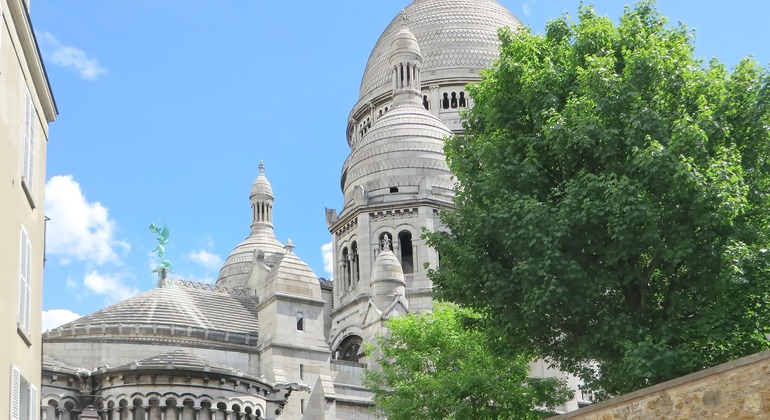
FREETOUR.com says
Our Secret Traveller praises this free walking tour of Montmartre as "an excellent way to gain an authentic local insight to this famous district". "As well as the highlights like Moulin Rouge, Lapin Agile, and Sacré-Cæur Basilica, the guides bring the cultural history of the area to life, reveal fascinating anecdotes about the bohemian artists that resided here such as Van Gogh, Edith Piaf, Picasso, and Renoir, and show you the alternative side of Montmartre too. And they give great local tips on vibrant nightlife and recommended restaurants too. A must-do!"
Overview of the tour in Paris
On our award-winning free walking tour of Montmartre, we show you the nooks and crannies of the most Bohemian and artistic district of Paris, the center of good-living and once the home of Renoir, Picasso, Edith Piaf and so many others. At Discover Walks, we take pride in giving you an authentic, intimate tour. This means your group will be small (we aim for 10-15 guests, with a cap at 22/guide), and your guide will be a Parisian (not an expat!), so you can discover both the tourist landmarks and the real Paris. Moulin Rouge, cabaret of the Assassins, the home of Van Gogh, the breasts of Dalida, and of course Sacré Coeur. Do not miss our most popular tour, the Montmartre Free Walking Tour by Discover Walks! Average tip on this tour: €12. To see more on this free tour, we do not spend time going inside each building. **HOT DAY SPECIAL: on hot days, our guides have fans for every guest. We walk in the shade. And every tour makes frequent stops for water. EXCLUSIVELY WITH DISCOVER WALKS.
This activity includes:
- Haunts of Renoir
- Sacre coeur church
- French pop culture
- Moulin Rouge
- And so much more!
Meeting point
Metro Blanche
Your guide wil wear a pink vest, and start from the Blanche Metro station only exit. The tour starts on the clock, rain or shine. Please don't be late, the guide will not wait for you. A little late? Look for the pink vest while walking towards Moulin Rouge.
Things to note
See more than just Sacre Coeur – the charm of our Montmartre tour is in its back alleys, and our Paris city guides take you there to the secret side of Montmartre. Your native guide also has insider insights and tips for making the most of Montmartre, whether to stroll, eat, or take pictures. The average tip on this tour €12. Look for the guide wearing a Pink Vest! We walk rain or shine.
Free Cancellation
You are free to cancel a booking anytime. We kindly remind you to cancel bookings you cannot arrive for. Being reported as absent decreases your customer level points and the benefits you can enjoy.

- Join Freetour
- Provider Sign In
- Affiliate Program
- Security & Privacy
- Terms & Legal
- Cookie policy
- Freetour Awards
- Ratings & Reviews powered by
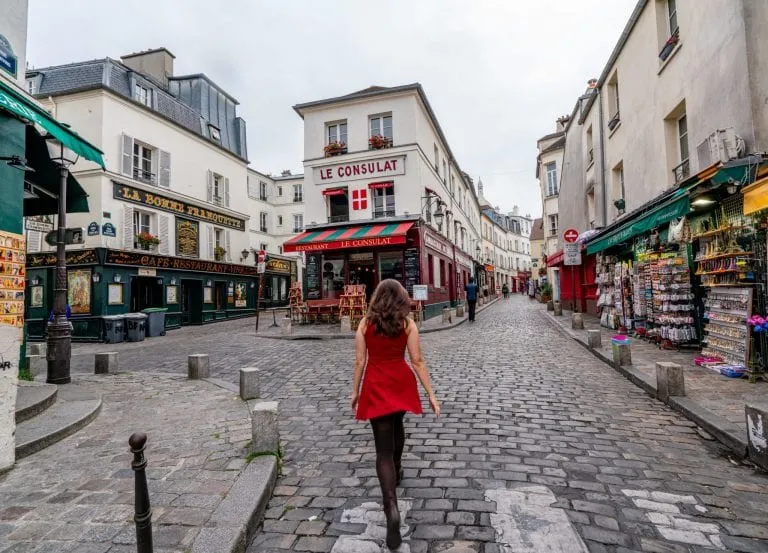
25+ Magical Things to Do in Montmartre, Paris (+ Map & Tips!)
Winding cobblestone lanes, artistic haunts, endless cafes, and historic cabarets, all topped off with a basilica that stands proudly on the highest hill in Paris: Montmartre has long captured the hearts of travelers, and with so many wonderful things to do in Montmartre, it’s not hard to see why!
Once the home of artists like Picasso, Renoir, Van Gogh, and Matisse–just to name a few–visiting Montmartre today provides plenty of glimpses into the neighborhood’s Belle Époque past.
While Montmartre, or Paris’ 18th arrondissement , is one of the most popular places to visit in Paris today, that doesn’t mean that it hasn’t retained its magic–you just have to know where (and when) to look.
We’ve had the chance to visit Montmartre many times, including basing ourselves in the neighborhood on two separate trips, most recently for a full week.
Here is exactly what to do in Montmartre, from iconic views to hidden gems, plus tips for making the most of your visit!
Table of Contents
Want to visit Montmartre the easy way?
The best things to do in montmartre, paris, fun things to do near montmartre, where to stay in montmartre, where is montmartre in paris (+ how to get there), tips for visiting paris’ montmartre neighborhood, self-guided montmartre walking tour itinerary, faq for visiting montmartre in paris, map of the best places to visit in montmartre.
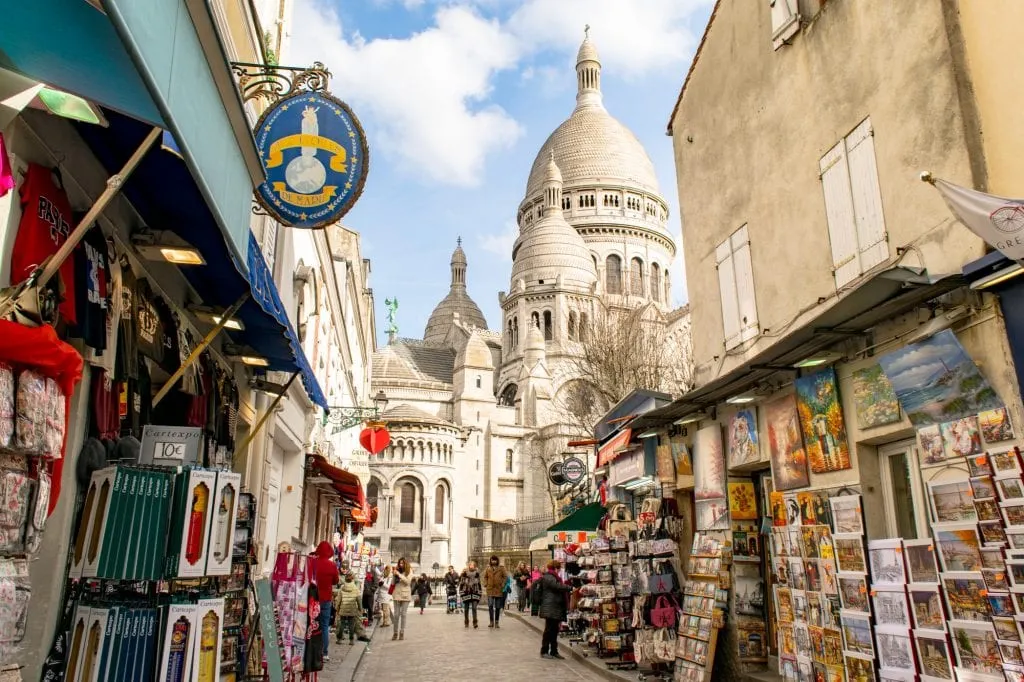
Some links in this post may be affiliate links. If you make a purchase through one of these links, we may earn a small commission at no extra cost to you. Please see our disclosure policy for more detail.
Only have a short time (say, half a day or less) to visit Montmartre and want to make the most of it?
This popular walking tour covers many of the most popular places to visit in Montmartre that we talk about in this travel guide ( this is an even shorter tour option that also gets great reviews).
Opting for a walking tour instead of exploring independently does come with a few trade-offs–one of the great joys of visiting Montmartre is wandering semi-aimlessly around the neighborhood–but it comes with big benefits, too.
A knowledgeable guide with colorful stories can bring Montmartre’s bohemian past to life in a vivid way that is difficult to replicate on your own.
(… Without doing a lot of reading about the history of Paris in advance, anyway–for example, did you know that for a brief time in 1871, Montmartre wasn’t even part of Paris?).
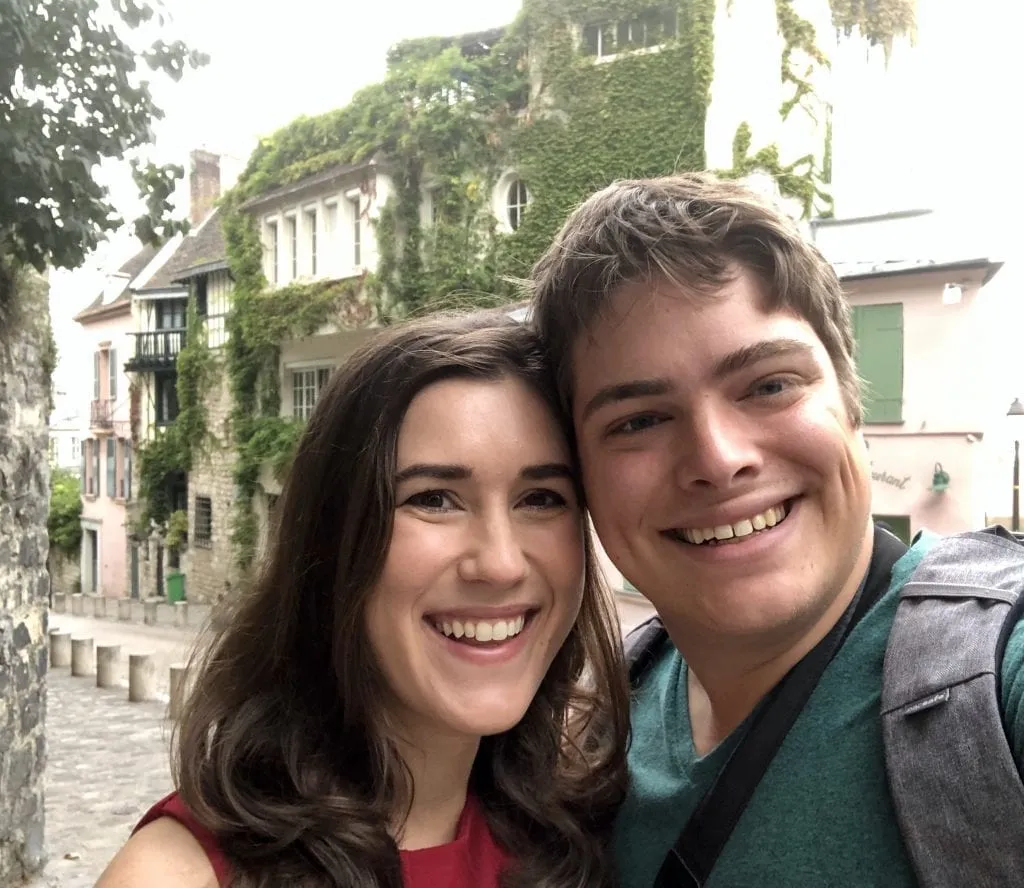
A walking tour also has the benefit of making sure you have a chance to enjoy Montmartre’s best angles without getting lost or climbing a few extra staircases in the process, which is easy to do.
If you do opt for a Montmartre walking tour, we recommend saving a little extra time before or after your tour to enjoy a drink at one of the neighborhood’s many outdoor cafes, and/or climb to the top of Sacré-Coeur, after your tour if at all possible.
Book your walking tour of Montmartre today!
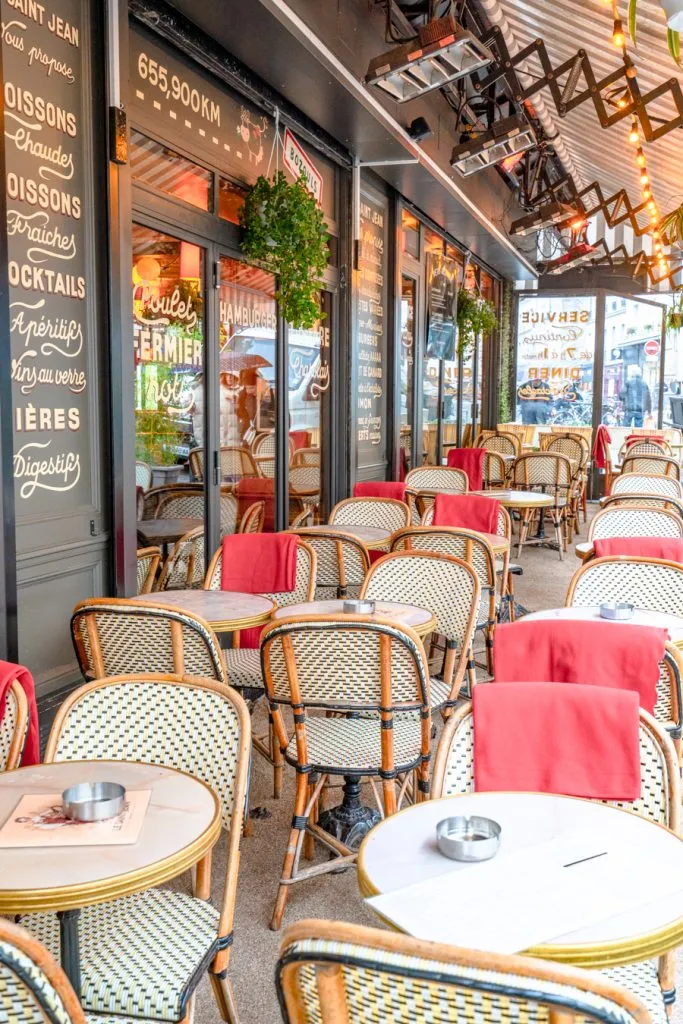
Step inside the incredible Sacré-Coeur Basilica.
Standing tall at the peak of the Montmartre butte and visible from many of the best viewpoints in Paris, Montmartre’s Sacré-Coeur Basilica is a must-see when in the neighborhood!
The basilica itself is free to enter, and its Romano-Byzantine interior, complete with marvelous mosaics that remind me of a more modern Ravenna , is worth admiring.
Sacré-Coeur is newer than you might think, too!
Construction started in 1875 and was declared completed in 1923, a clear reminder of how ever-changing the Montmartre neighborhood is.
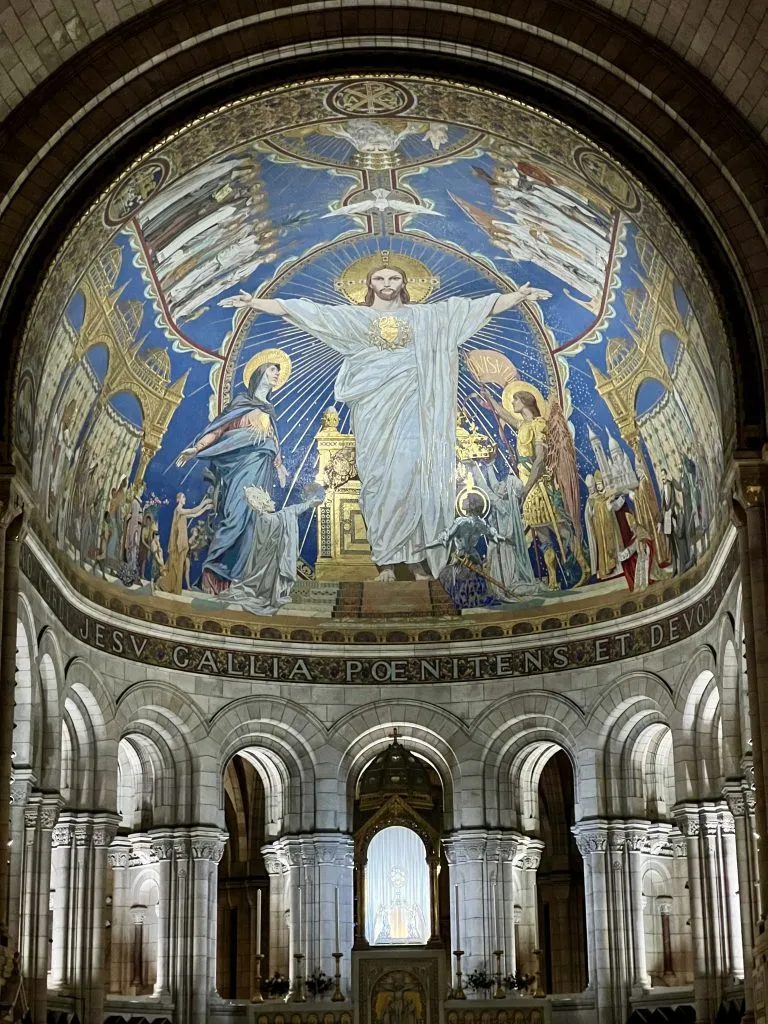
… and climb to the top to enjoy one of the absolute best views of Paris.
Climbing another 300 steps after already climbing all the way up to the base of Sacré-Coeur may feel a bit overwhelming (visiting Montmartre can be quite the workout), but it’s absolutely worth it!
While the view of Paris from the steps of the Sacré-Coeur is popular and lovely, the view from the top of the dome is stupendous .
The dome is open daily, but with different opening hours depending on the season.
You can check here for the current opening hours.
If at all possible, we recommend timing your visit to the dome for sunset, and be sure to leave yourself 15+ minutes to circle the dome (you can walk all the way around the edge of it) and enjoy the view!
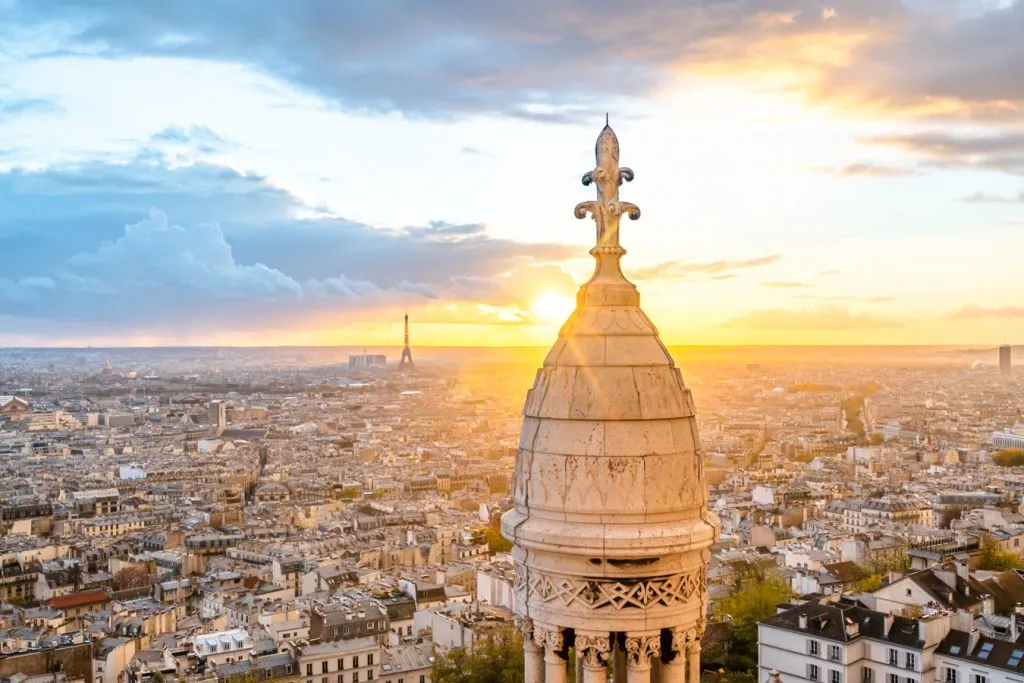
Admire Sacré-Coeur without the crowds at Square Marcel Bleustein Blanchet.
If you start circling Sacré-Coeur after enjoying views from the front, you’ll eventually come to the lovely Square Marcel Bleustein Blanchet, which is home to one of the loveliest views of the basilica!
This small park is located behind Sacré-Coeur, and thanks in large part to its location, is a delightfully uncrowded hidden gem in Montmartre.
From here, you can take a deep breath and enjoy gorgeous views without fighting for space or asking touts to leave you alone.
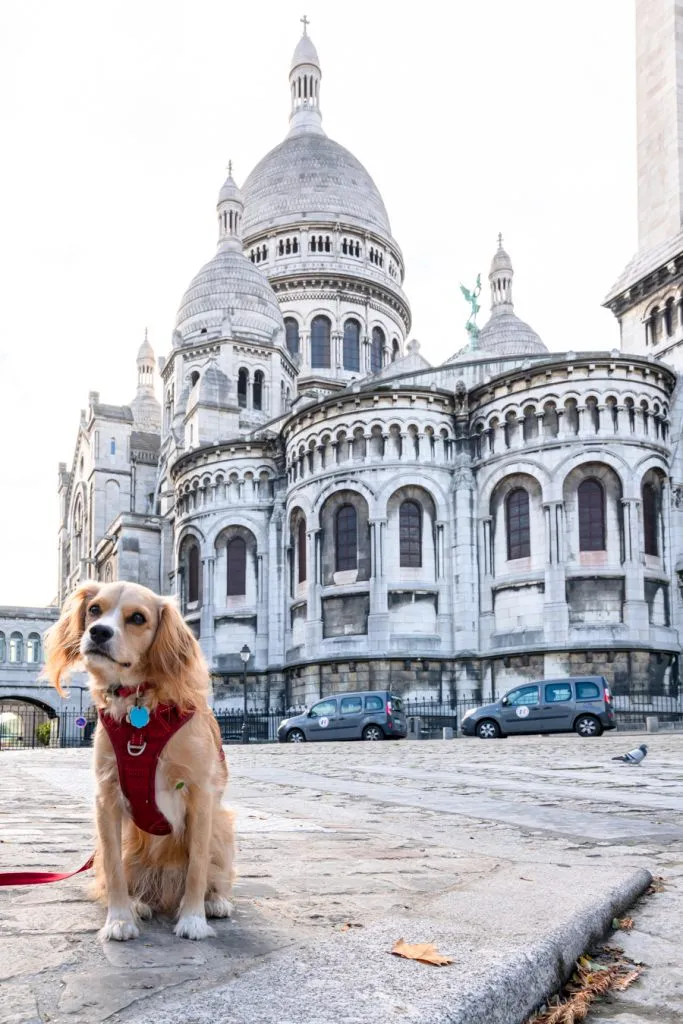
Enjoy the bustling, artistic atmosphere of the Place du Tertre.
Lined with picturesque cafes and covered with artists’ easels, the beautiful Place du Tertre is the heart of Montmartre’s artistic culture and has been for centuries.
If having your portrait drawn by a local artist is on your Montmartre bucket list, this is the place to do it!
The artists with easels set up in the Place du Tertre are licensed and regulated, and have to apply with the city to set up there–not just anyone can join.
For that reason, we recommend approaching a sitting artist if you’re interested in buying art here.
Roving artists who pitch their wares to you are not regulated, technically not allowed (though they always seem to be around), and much less likely to provide a product you’ll be satisfied with.
Regardless of whether or not you’re in the market for artwork, the atmosphere in the Place du Tertre is lovely and visiting is a great addition to a trip to Montmartre.
Don’t forget to turn back toward Sacré-Coeur for a view of the domes peeking up over the square!
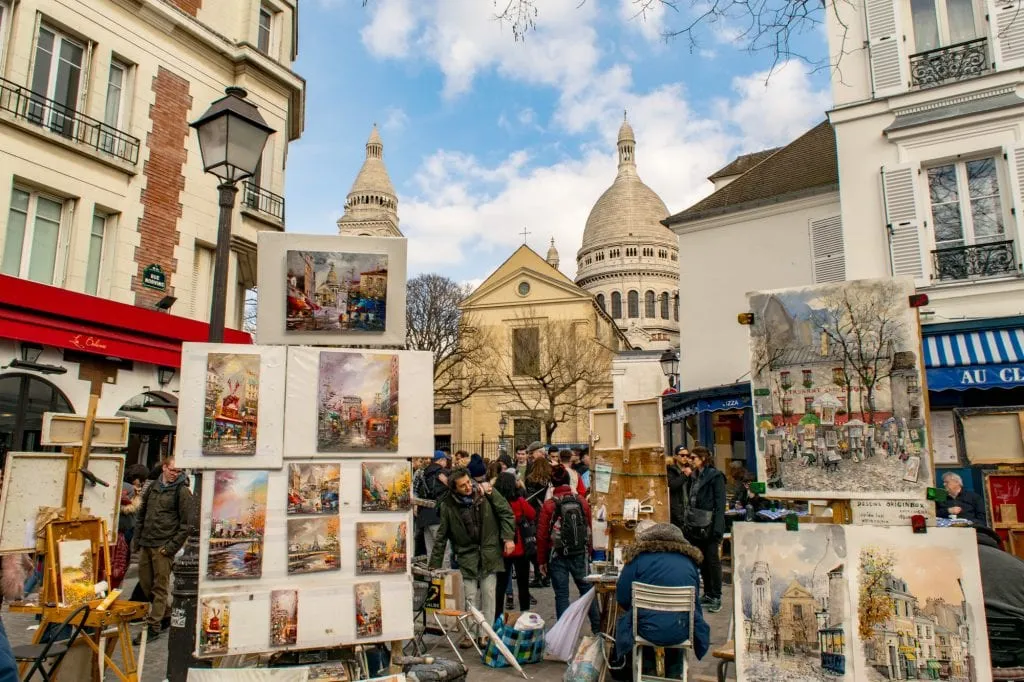
Watch the world go by at one of Montmartre’s many charming cafes or bistros.
Montmartre is positively covered in picturesque cafes and bistros, and sitting outside to enjoy a coffee and croissant in the mornings is a fabulous way to enjoy them.
Of course, given how popular visiting Montmartre is, many of the cafes and bistros have mediocre food, high prices, or both–but you can usually find somewhere worth enjoying.
The famous spots of Le Consulat (where you can drink at the same cafe Picasso and Monet once enjoyed, Le Refuge, and Le Vrai Paris all get solid, if not raving, reviews.
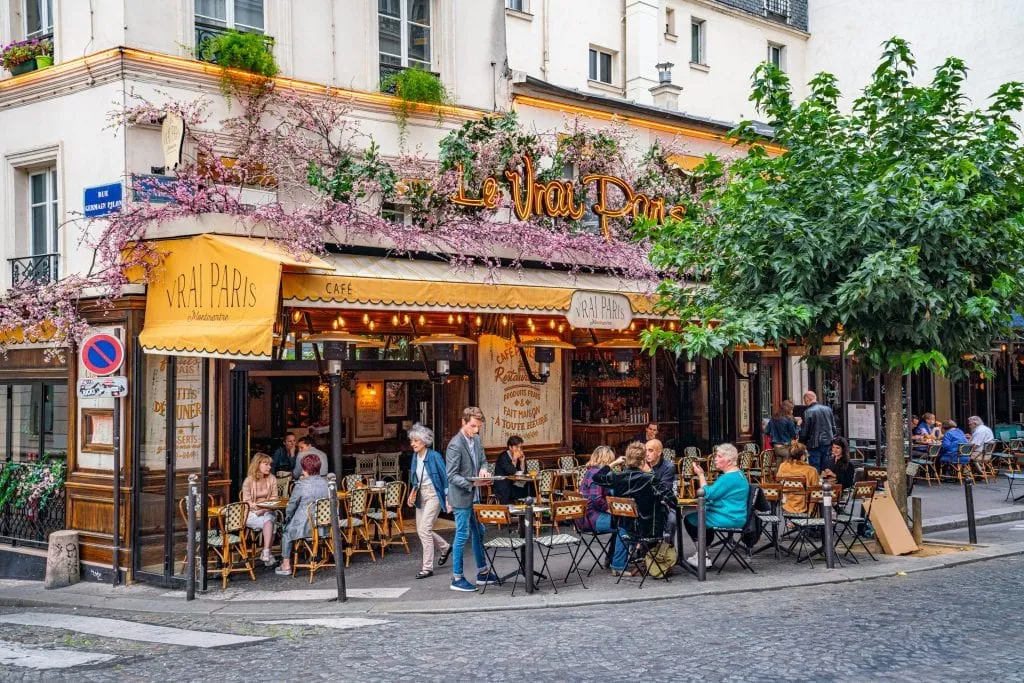
Café des Deux Moulins , which was featured in the movie Amélie , doesn’t get as good of reviews, but visitors hoping to enjoy the nostalgia seem to enjoy it.
We have also enjoyed a morning café at Le Bimbo , and Porto-Paris (Portuguese rather than French, but good).
And, while you can’t sit down there, I can’t talk about breakfast in Montmartre without mentioning Pain Pain , a former winner of the best baguette in Paris award and a must-taste when visiting Montmartre!
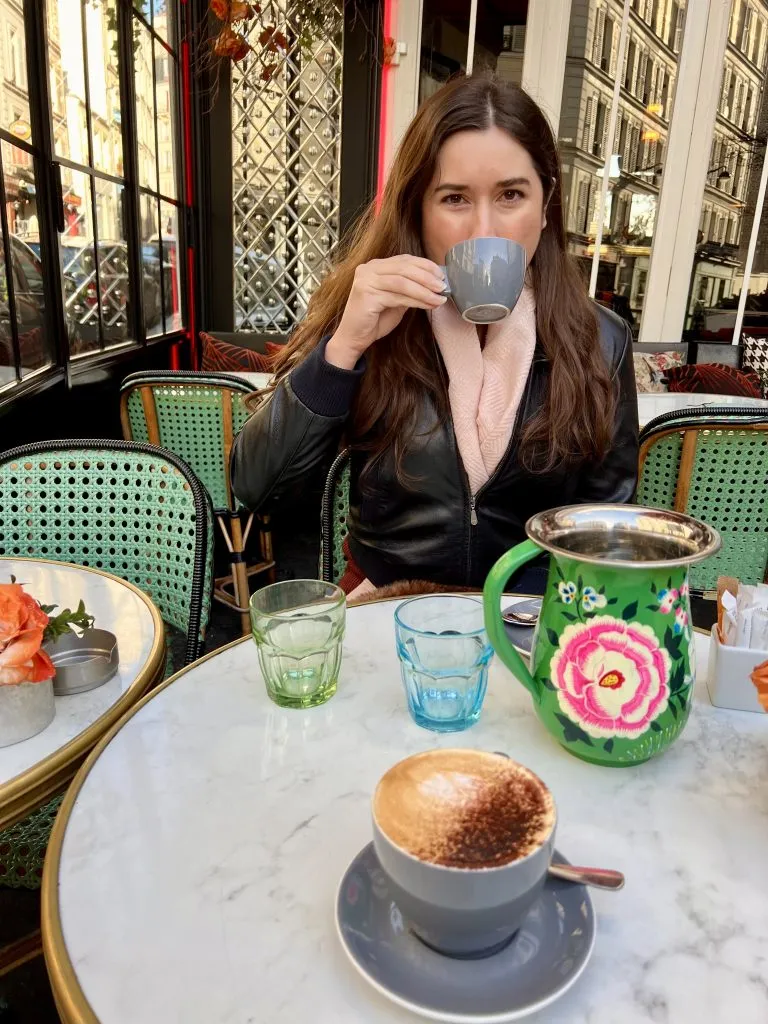
Stroll down the beautiful Rue de l’Abreuvoir.
Sandwiched between La Maison Rose at the top and Place Dalida at the bottom, the short street of Rue de l’Abreuvoir is one of the prettiest streets in Montmartre, and quite possibly one of the prettiest streets in all of Paris!
And, it’s without a doubt one of the 18th’s most famous photography spots.
As you walk down the street, be sure to turn back regularly to look behind you!
Like many of the most beautiful places in Montmartre, the domes of Sacré-Coeur will start peeking out over the top of the hill as you descend.
While not particularly busy, this is still an active driving street, so keep an eye out for cars as you explore!
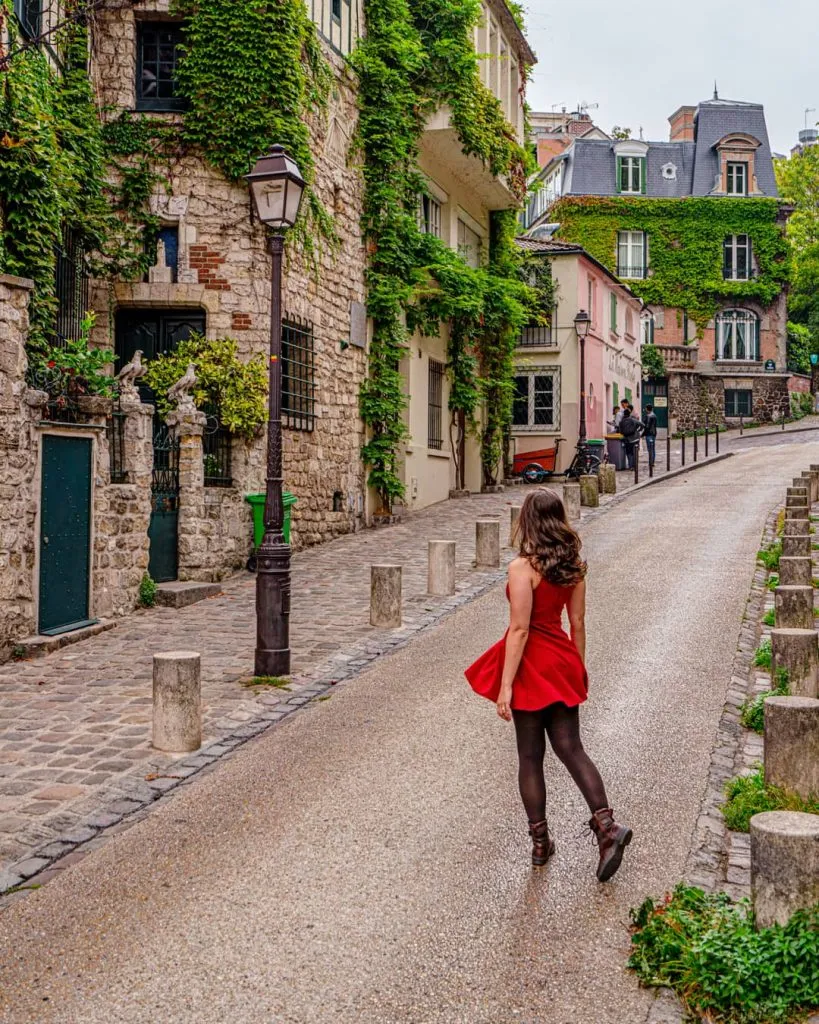
… and pause at the bottom to enjoy Place Dalida.
Shady and peaceful Place Dalida is situated at one end of Rue de l’Abreuvoir and features beautiful views of the picturesque street framed with the white domes of Sacré-Coeur.
It’s also home to a bust celebrating–who else–the famous French singer Dalida, who was known for performing in more than 10 languages.
Legend says that touching Dalida’s bust is good luck–and based on the discoloration, it’s easy to see that many people visiting Montmartre have given it a chance to work.
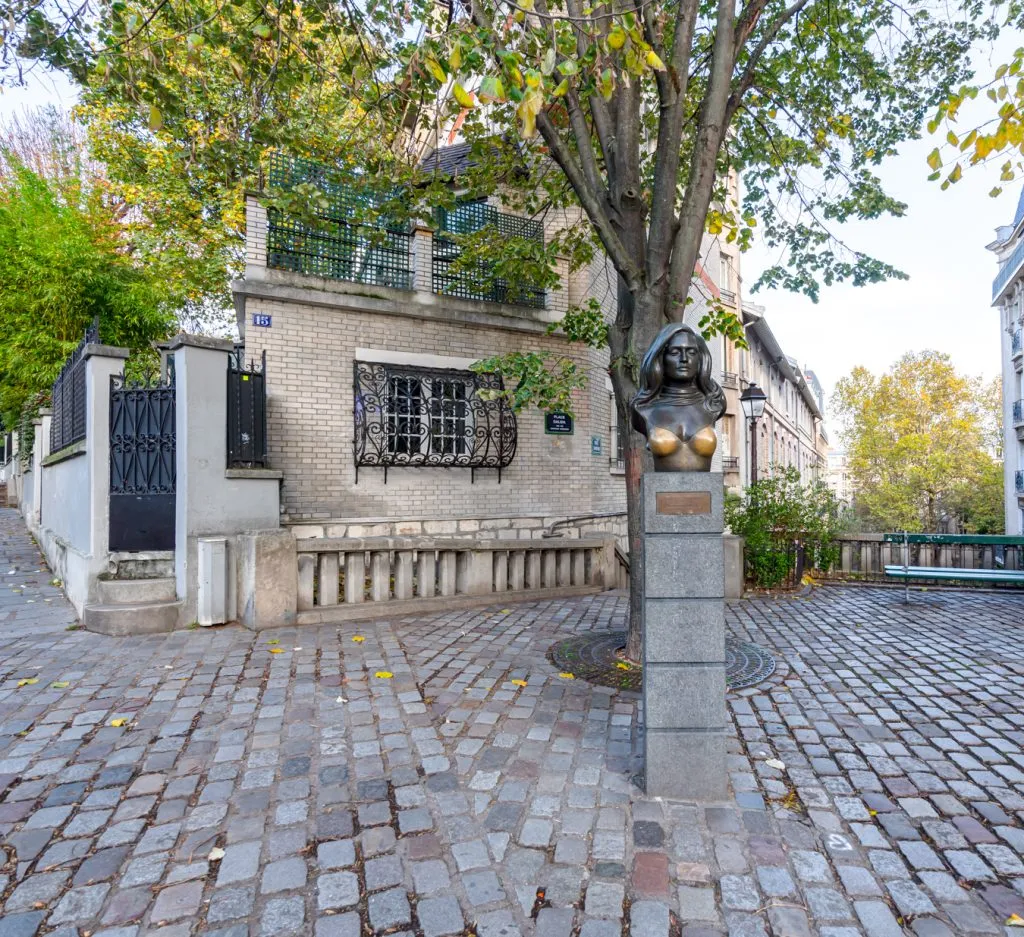
Explore the Montmartre Museum.
Generally speaking, Montmartre is less of a museum-hopping neighborhood and more of a place to soak up the atmosphere–but it’s worth making an exception for the Musée de Montmartre .
Housed in the former home of Auguste Renoir, the Montmartre Museum explores the history of the neighborhood.
Most of the attention is focused, of course, on Montmartre’s heyday starting in the 19th century, with exhibits on the building of Sacré-Coeur, the iconic shadow theatre of the original Chat Noir, a recreated apartment of Suzanne Valadon, and much more.
We thoroughly enjoyed the museum and the attached Renoir Gardens.
The gardens are also home to the best accessible view of Le Clos Montmartre, one of the only remaining vineyards in Paris!
Buy tickets to visit the Montmartre Museum today!
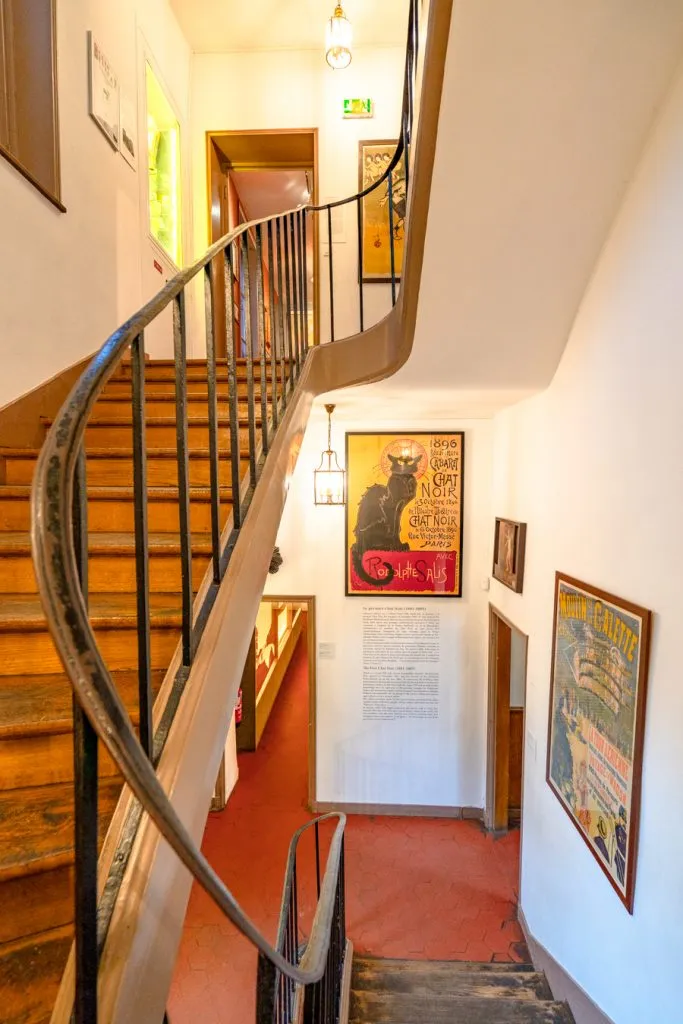
Admire the vines of Le Clos Montmartre (from outside the gate).
In a city as modern and busy as Paris, finding a small vineyard nestled amongst the buildings is an absolute treat!
And, what better home could there be for a quirky urban winery than Montmartre village, which already feels worlds apart from much of the city?
Unfortunately, Le Clos Montmartre isn’t generally open to the public, but that doesn’t stop travelers from eagerly peering through their front gate on Rue des Saules (it helps that the gate is just around the corner from La Maison Rose).
The best view of the vineyard, where I took the below photo, is from the Montmartre Museum’s gardens, but you’ll need to purchase a ticket to the gardens to access it.
Garden access is included with a museum ticket , or you can purchase only access to the gardens separately.
Le Clos Montmartre only produces a small amount of wine–1000 bottles a year or less–but if you’d like to try it, you can find it for sale around Montmartre (including in the Montmartre Museum gift shop).
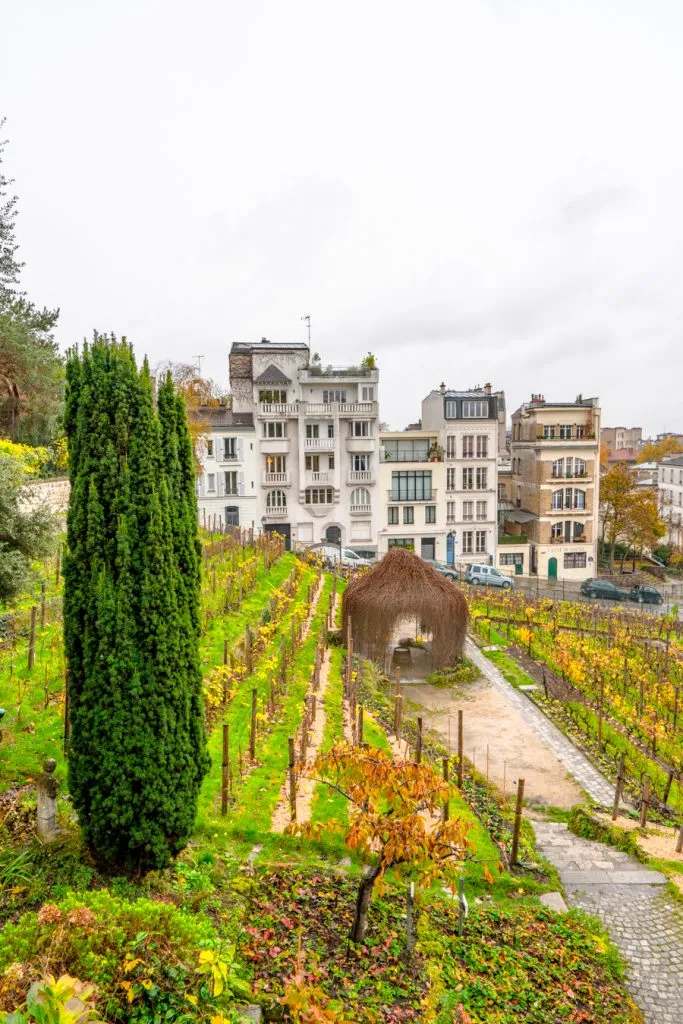
See the best of Montmartre’s cuisine on a food tour.
Want to sample delicious Parisian food while exploring Montmartre on foot with an excellent guide?
Consider booking a Montmartre food tour with Devour Tours!
Devour Tours is one of our favorite food tour companies in Europe (they’re also associated with Take Walks , another favorite of ours).
We loved this Paris food tour we booked with them, among several others!
Their Montmartre food tour offers an incredible combination of excellent food and memorable stories about the history and culture of the 18th arrondissement.
Book your Montmartre food tour today!
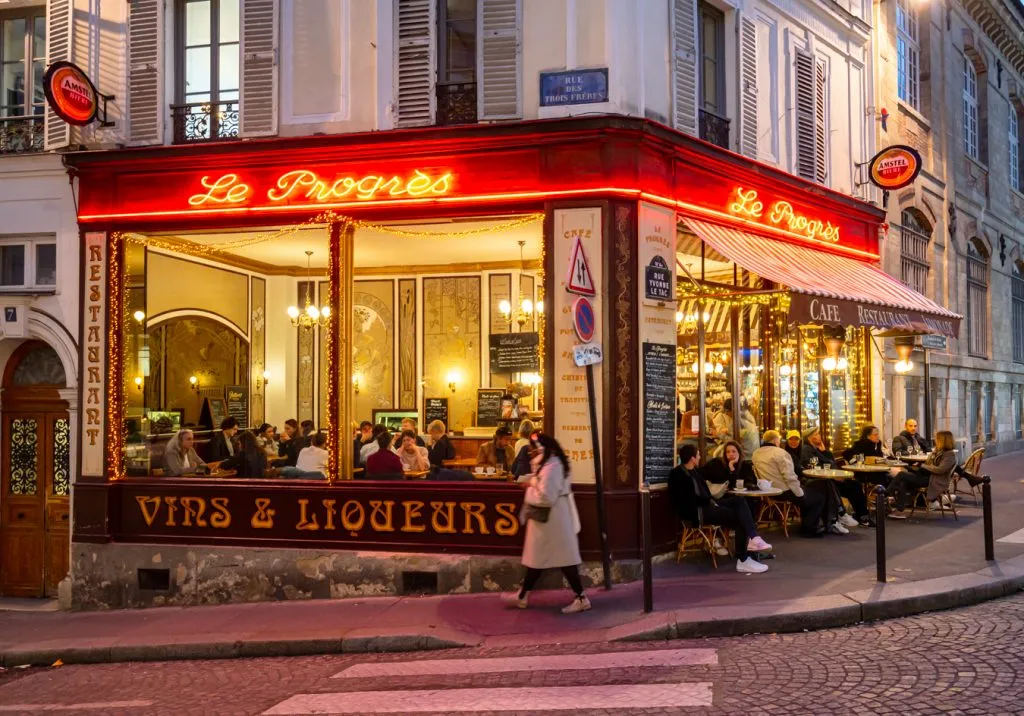
Visit the famous La Maison Rose.
Originally opened in 1908, the beautiful pink facade of La Maison Rose has been a staple of Montmartre for generations.
While it has gone through a handful of closures, reopens, and ownership changes over the years, its iconic pink facade dates all the way back to the original.
Staples of Montmartre, such as Albert Camus and Dalida, were once clients, and today, La Maison Rose remains a functioning restaurant (we highly recommend making reservations if you want to eat there).
Most visitors, though, no doubt come merely to admire the exterior.
The facade has been slightly updated in the few years since I took the below photo–“La Maison Rose” is now printed in a more modern, blocky green style.
I have to admit I’m still extremely partial to the script version, so opted to preserve my favorite version in this Montmartre blog post.
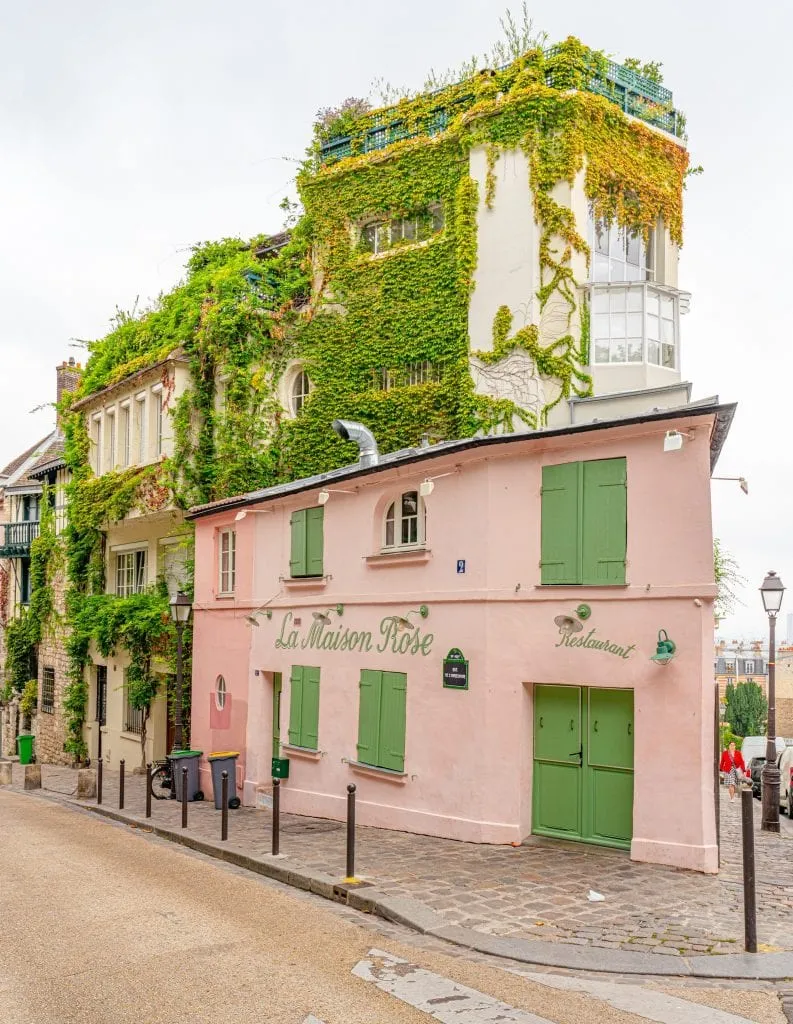
Enjoy the Place Saint-Pierre (and its carousel).
Tiny Place Saint-Pierre is one of the most recognizable places to visit in Montmartre, but you may have never heard its official name before–because Place Saint-Pierre is much better known for what sits inside it.
Home to the Montmartre carousel (technically named the Carrousel de Saint-Pierre , but generally referred to as the Montmartre carousel), the Place Saint-Pierre sits below Sacré-Coeur.
Rides are short but inexpensive, and popular with kids visiting Montmartre!
The carousel may be even more popular with photographers, though: the ability to capture the Sacré-Coeur and a historic Parisian carousel in one image is a delight.
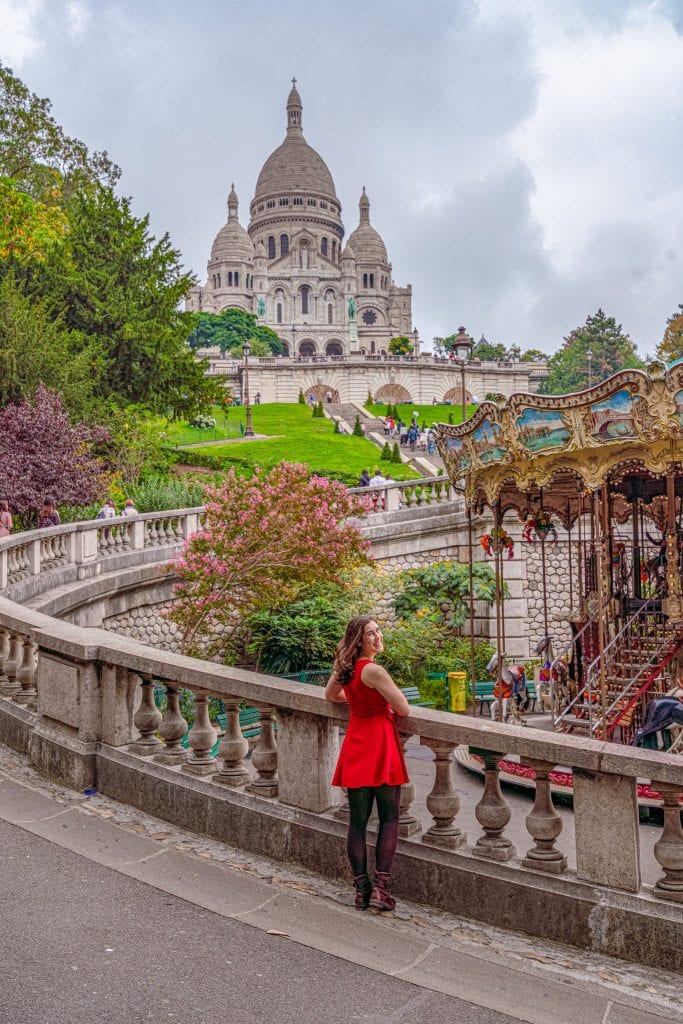
Find Montmartre’s remaining windmills.
Once upon a time, Montmartre was known for its many windmills.
Today, only a handful remain–including, Moulin Radet, the windmill that overlooks the restaurant La Moulin de la Galette .
There’s also a windmill named Moulin Blute-Fin, which is on private land but you can spot from the street.
Collectively, these two windmills are known as Moulin de la Galette, and they have been featured in paintings by Van Gogh, Renoir, and many more.
Meanwhile, the iconic windmill on top of the Moulin Rouge, while not technically in Montmarte, is near-synonymous with the neighborhood.
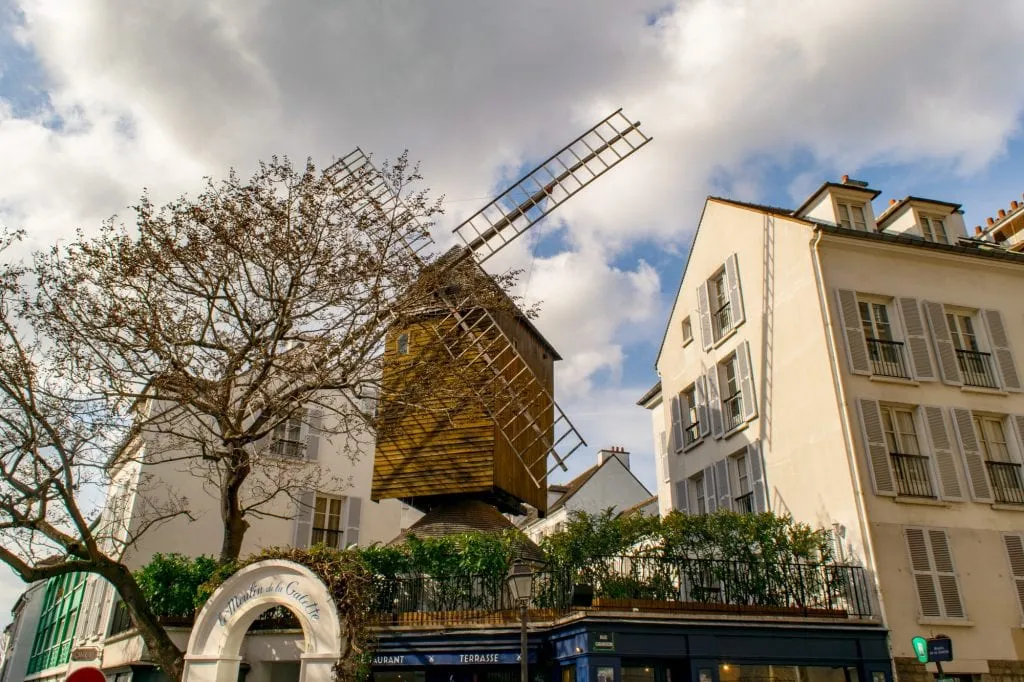
… and the quirky statue of Le Passe-Muraille .
The bronze statue of Le Passe-Muraille (or “Passer Through Walls”) is one of the quirkiest attractions in Montmartre, and only takes a minute to see!
Depicting a man stuck inside a wall as he attempts to walk through, Le Passe-Muraille is actually a statue of a specific character from the French novel Le Passe-Muraille .
The character, and therefore his statue, met his unfortunate fate of being permanently stuck in a wall after using magical powers for immoral purposes.
You don’t need to have read or even be familiar with the book, though, in order to appreciate this unusual art piece that feels right at home in the 18th arrondissement .
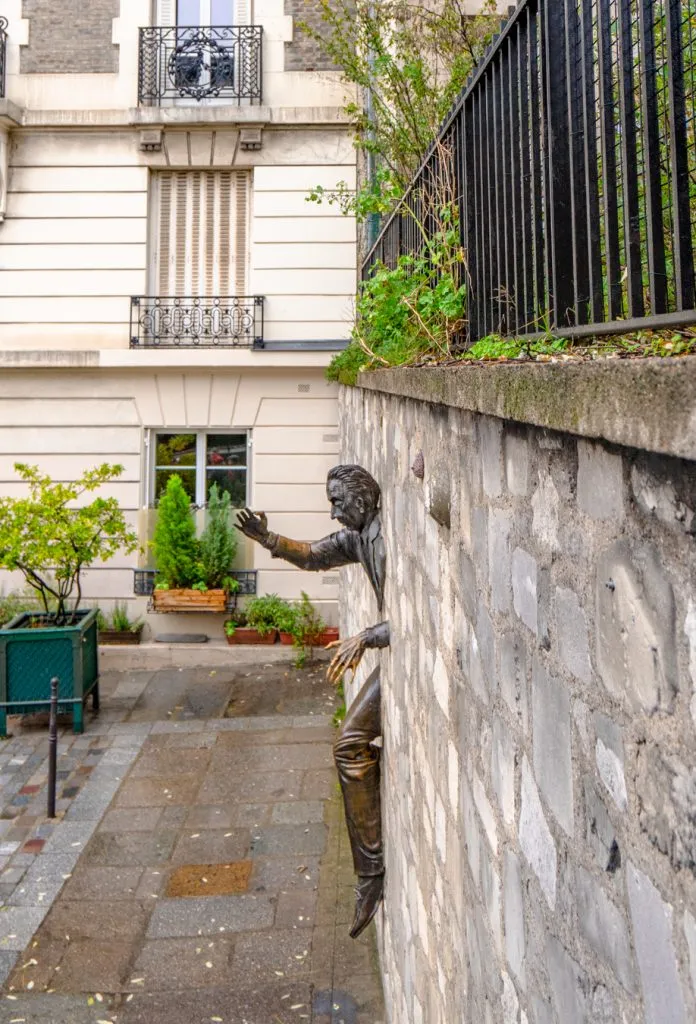
Spend some time relaxing on the Sacré-Coeur steps that overlook Louise Michel Park.
Enjoying the view of Paris from the steps leading to the Sacré-Coeur is one of the most popular things to do in Montmartre, especially at sunset!
Regardless of what time you visit, though, it’s worth stopping to rest and enjoy the view (especially if you just climbed the roughly 270 steps it takes to reach the Sacré-Coeur from Place-Saint Pierre).
However, be cautious: the combination of the viewpoint being popular and free to access means that pickpockets and scammers are rife here.
That’s not a reason to stay away, but it’s definitely a reason to be extra cautious with your belongings.
We have enjoyed several stunning Paris sunsets from this spot, and hope to see many more in the future!
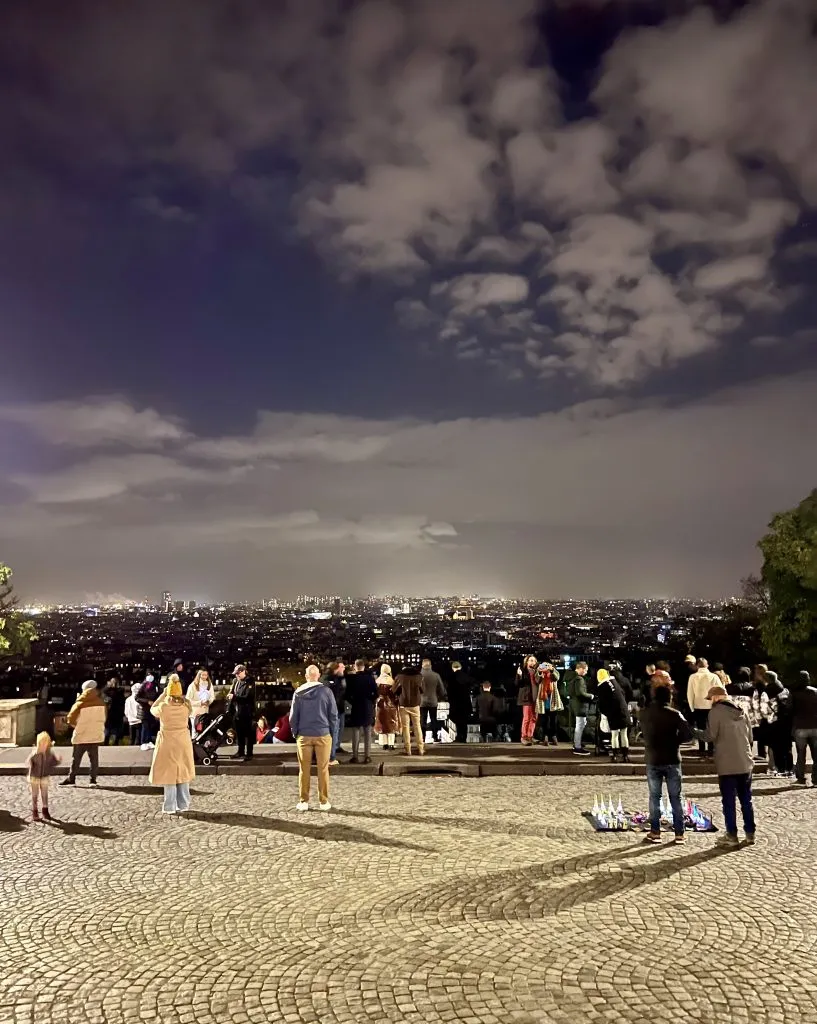
… and don’t miss seeing the Sinking House of Montmartre while you’re there!
The Sinking House of Montmartre is one of Paris’ most beloved optical illusions, and it’s very easy to find during a Montmartre visit!
If you’re standing amongst the crowd on the steps of the Sacré-Coeur, face the basilica and then turn to your right.
You’ll see a red building jutting out in the distance, beyond the lawn.
Turn your camera ( this is our beloved camera , though we shot the below photo years ago on this one ) so that the lawn is straight.
Voilà –suddenly the red building is “sinking”!
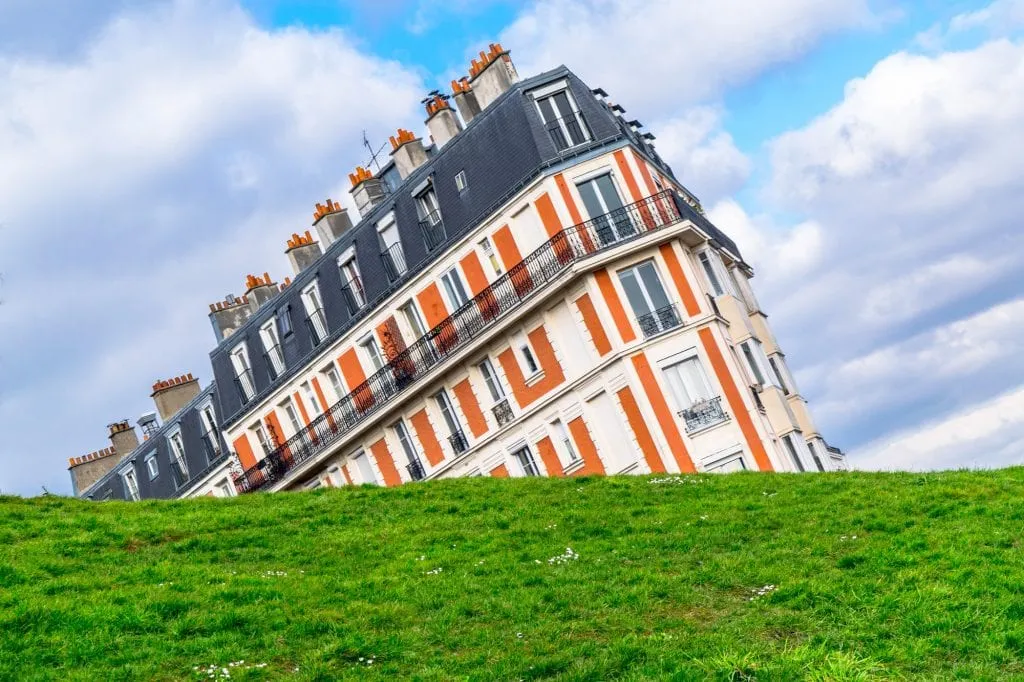
Seek out “secret” Eiffel Tower views from Montmartre.
Meander along the top of the Montmartre butte long enough, and you’ll come across some pretty spectacular views of Paris that you won’t find on any map or in any guidebook.
Often visible in only a small sliver when peering through buildings or trees, these views are all the more rewarding for how surprising it often feels to stumble across one (and many of them even overlook the Eiffel Tower).
Here’s one spot to get you started: navigate to the restaurant Chez Plumeau, located just around the corner from the Place du Tertre.
Start at the top of the staircase, and then meander along the edge of the wall, and you’ll find plenty of gorgeous Eiffel Tower views!
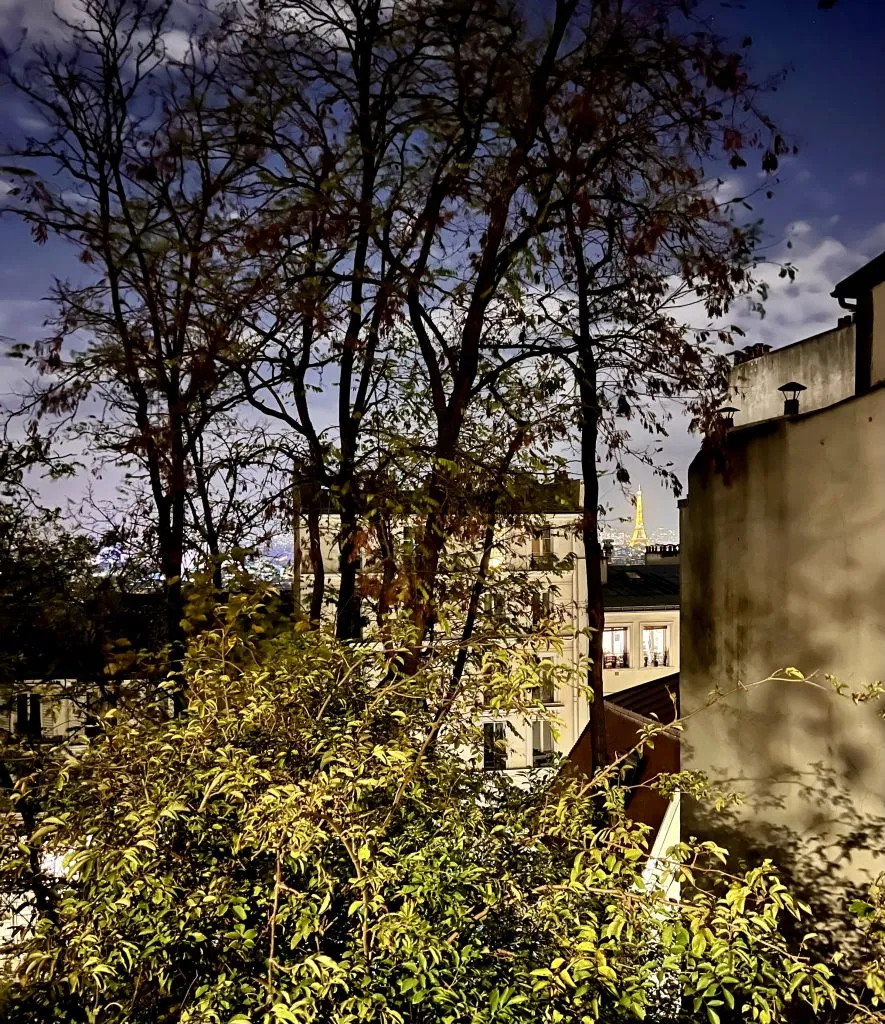
Duck inside the second-oldest church in Paris.
Situated right between Sacré-Coeur and Place du Tertre, you might suspect that the second-oldest church in Paris would be crowded with visitors–but this is actually one of the many hidden gems of Montmartre that are tucked away in plain sight.
Construction of the Church of St. Pierre de Montmartre began in 1133, though it is believed that a church has stood on this site since the 3rd century.
Home to the Montmartre Abbey before the French Revolution, St. Pierre de Montmartre has a long history in the 18th arrondissement –significantly longer than the more-famous Sacré-Coeur.
The interior is fairly simple, with featured stained glass and lots of stone, but lovely and worth a quick peek inside (it’s free to visit).
St. Pierre de Montmartre is also home to the Calvaire Cemetery, which you should definitely visit if you get the rare opportunity.
It’s only open one day a year, on All Saint’s Day (November 1)!
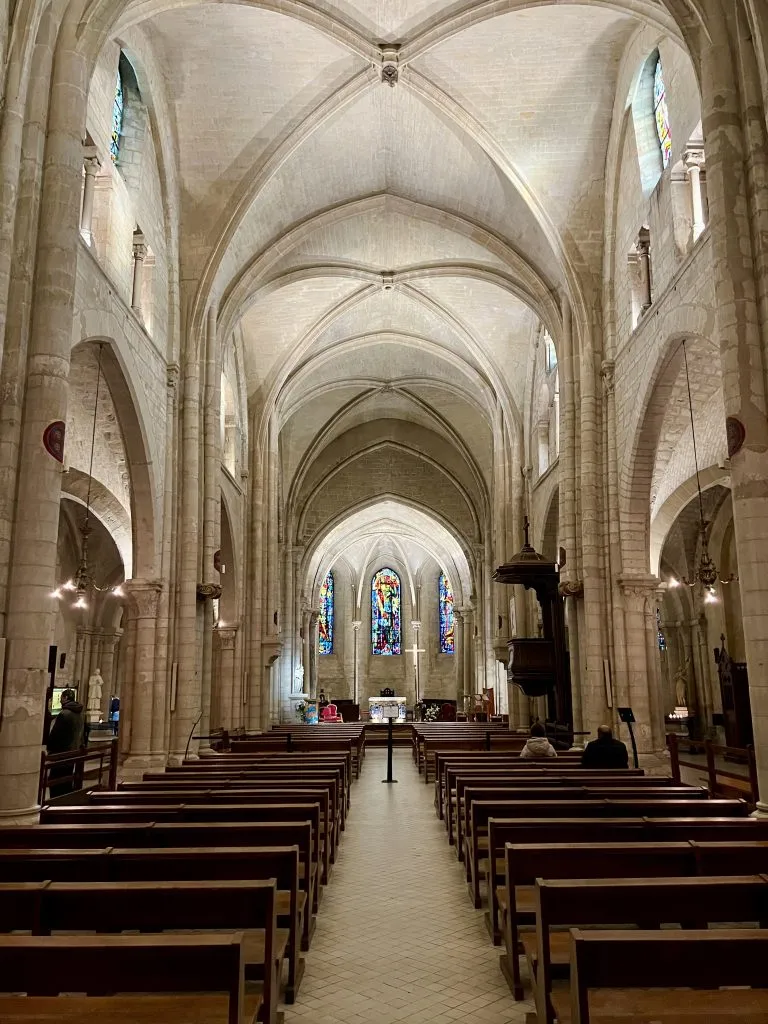
Enjoy a world-famous cabaret beloved by Picasso at Cabaret Au Lapin Agile.
Dating to 1860 and the inspiration behind a Picasso painting of the same, Cabaret Au Lapin Agile bills itself as Paris’ oldest cabaret.
Situated in the heart of Montmartre (along Rue des Saules), and once the haunt of many of Montmartre’s most famous residents, the party is still going like it’s the Belle Époque every night in Au Lapin Agile.
Today’s version is touristy, yes–but still lots of fun.
Be sure to make reservations in advance if you want to spend an evening in Montmartre tucked inside this lively spot.
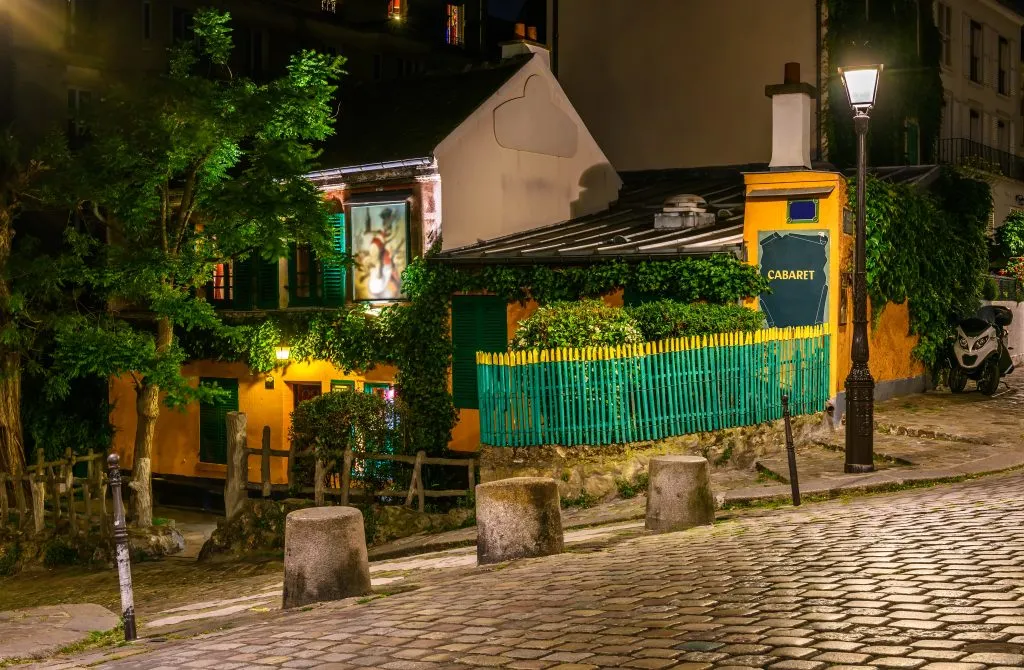
Snap a selfie with someone you love at the “I love you” wall.
Located in Square Jehan-Rictus, just a few steps from the Abbesses metro stop, you’ll find one of the most beloved Montmartre photo spots!
The dark blue Wall of Love is adorned with the phrase “I love you” in more than 300 languages, making it the perfect place to visit with one of your favorite people.

Stroll along some of Montmartre’s most picturesque streets.
Montmartre is made for wandering, and one of the absolute best things to do in Montmartre is to turn down random streets and find your favorites.
A few of the prettiest streets in Montmartre include the famous Rue de l’Abreuvoir, the winding Rue Lepic, and Rue Abbesses.
Rue des Saules is well worth a stroll as well, as are Rue Andre Antoine and Rue Lamarck.
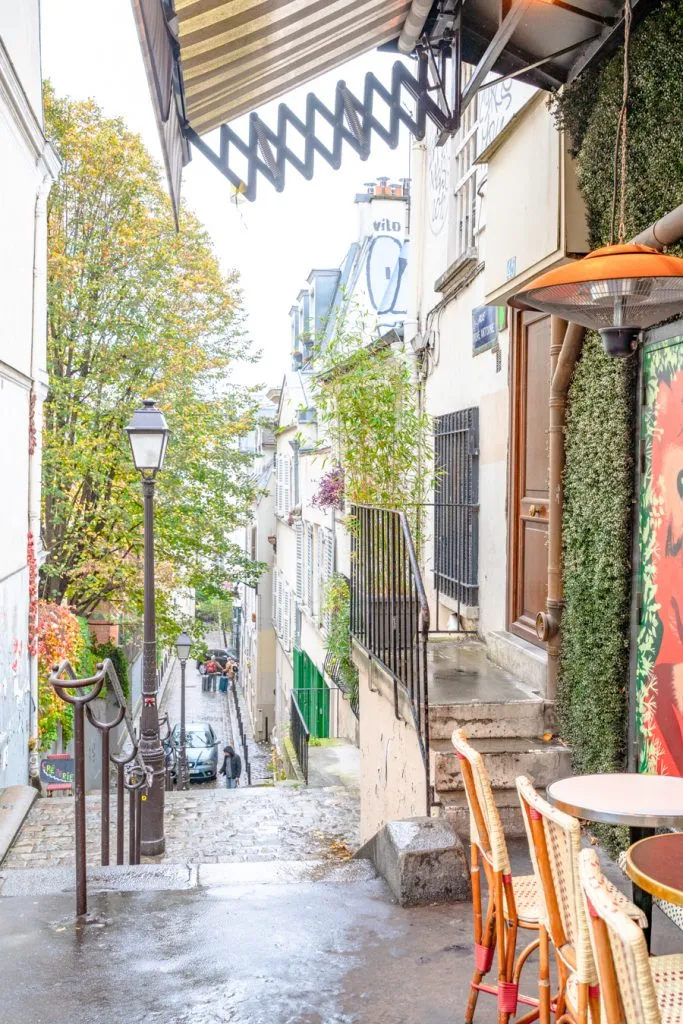
Pay a visit to the Montmartre Cemetery.
As the largest cemetery in Montmartre and the third-largest cemetery in Paris, the Montmartre Cemetery (technically named Cimetière du Nord ) is the final resting place of many of the 18th arrondissement’s most famous residents!
Located in a former quarry, strolling through the Montmartre Cemetery definitely gives the impression that you’re wandering beneath the ground (though it is all open air–just sunken).
Alexandre Dumas, Dalida herself, and many more were laid to rest here.
The Montmartre Cemetery is free to visit and an easy addition to most Montmartre itineraries.
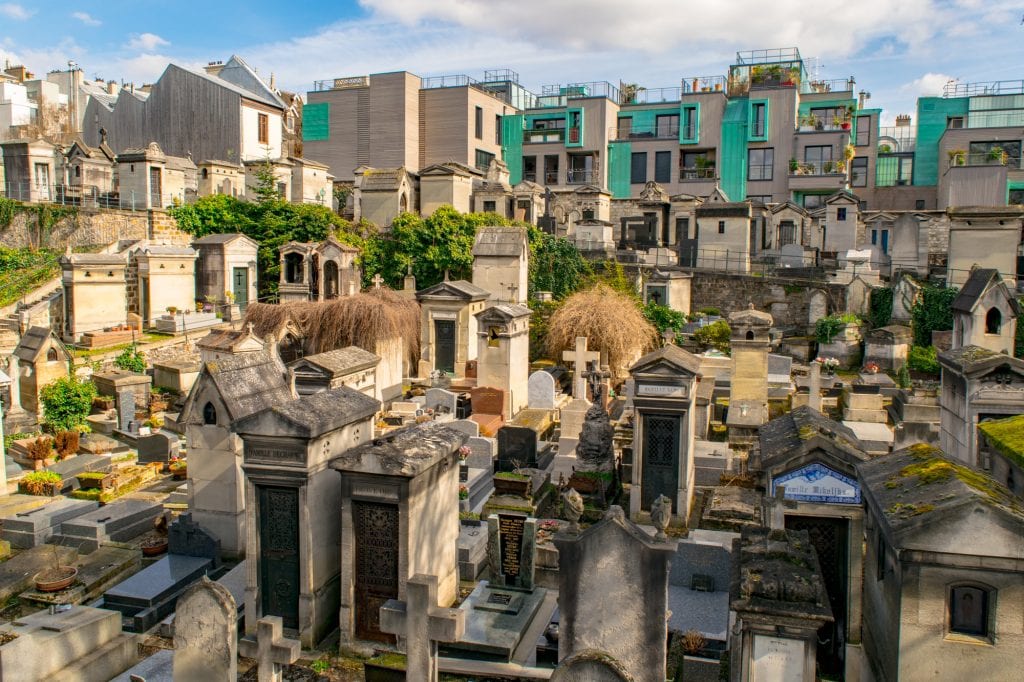
Seek out Amélie filming locations.
The popular French movie Amélie just may be the most beloved piece of cinema that has ever been filmed in Montmartre!
As a result, visiting Amélie filming locations is popular in Montmartre (and if you don’t know what I’m talking about, watching the movie before visiting will definitely inspire you to visit Montmartre)!
Café des Deux Moulins and Au Marché de la Butte (which played the Maison Collignon grocery store) are 2 of the most popular spots to visit that won’t necessarily already be on your Montmartre bucket list.
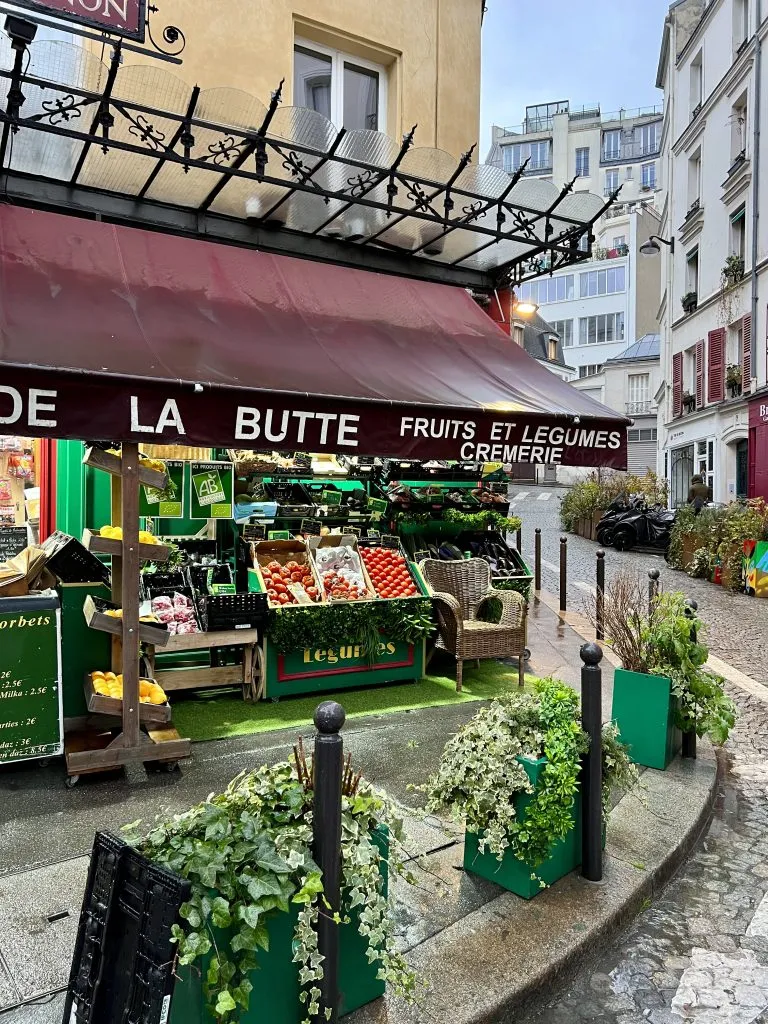
Wander through the St. Vincent Cemetery.
The final resting place of many of Montmartre’s former poets, artists, actors, and more, the peaceful St. Vincent Cemetery is a smaller and quieter alternative to visiting the larger Montmartre Cemetery.
Free to visit and home to notable Parisians like Maurice Utrillo, Léontine Aubart, and more, the cemetery also has a view of the rooftop of the famous Au Lapin Agile Cabaret.
There are also free public toilets located inside the cemetery, a nice perk for travelers who have been pounding the pavement on a self-guided Montmartre walking tour.
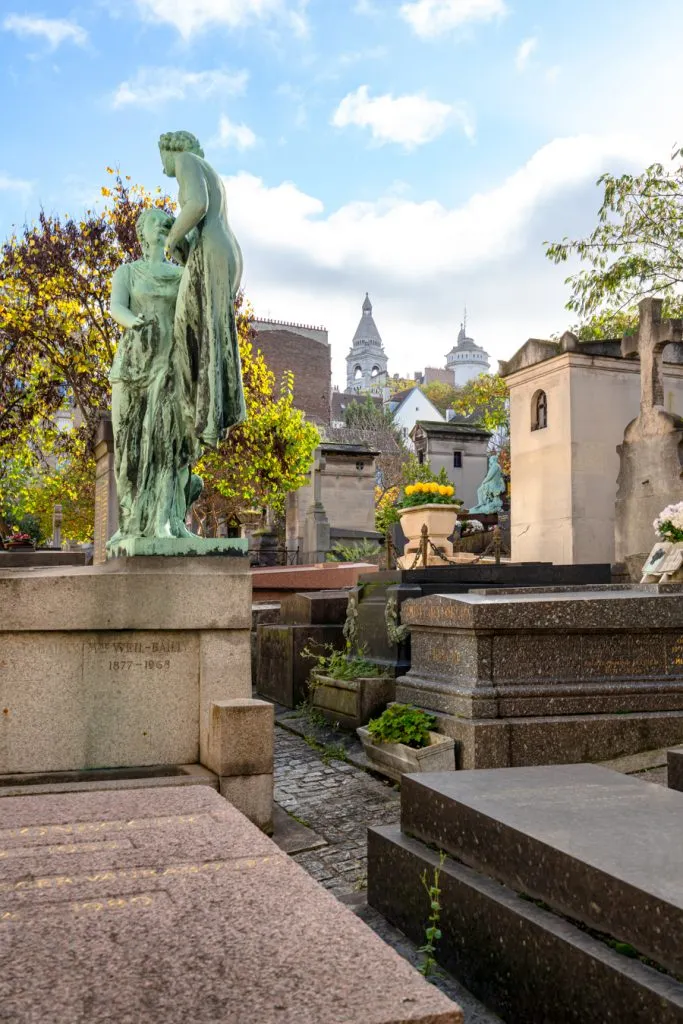
Explore the Espace Dalí Museum.
Dedicated to the one and only Salvador Dalí, the Dalí Museum features over 300 works by the prolific artist.
Originally amassed as a private collection, Espace Dalí was completely redone in 2018.
If your taste in art leans more toward the contemporary, this is the place in Montmartre for you!
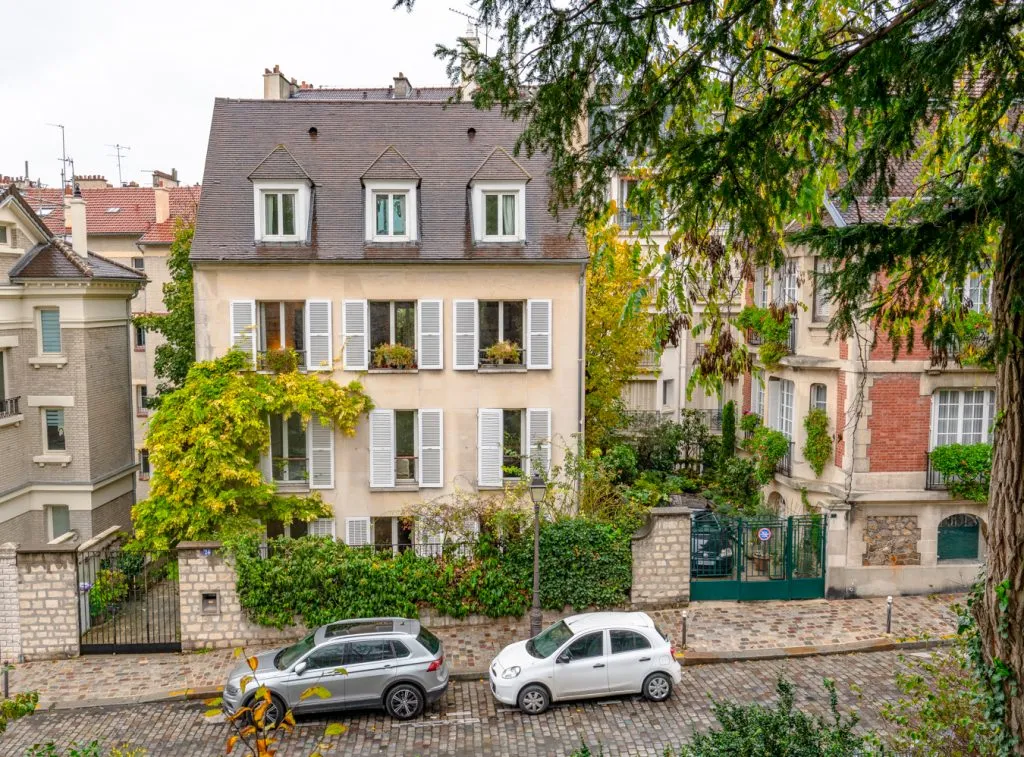
Wander aimlessly and find your own unusual places to visit in Montmartre.
Cliche it may be, but to this day, one of the most rewarding things to do in Montmartre is simply to wander through the neighborhood!
From quiet cafes to stately homes to shady staircases to quirky shops to unusual views of Paris (including the Eiffel Tower), Montmartre’s a wonderful place to explore on foot.
On our most recent trip to Montmartre in Paris, we stumbled across a Portuguese-themed coffee shop among many other treasures, which delighted us to no end as we had a chance to reflect on the 14 months we lived in Lisbon .
We wouldn’t have found that shop in a guidebook, but it was a memorable stop all the same.
Just remember to wear comfortable shoes and prepare for hills when exploring on foot: visiting Montmartre involves climbing lots of hills!
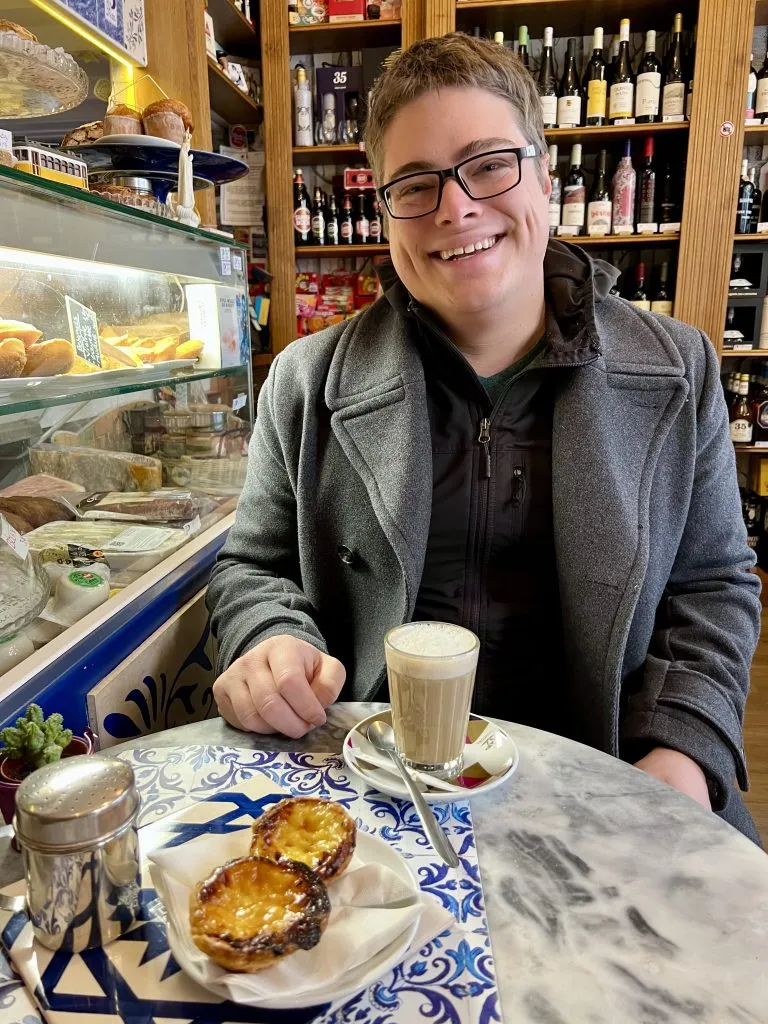
Just outside the boundaries of the neighborhood, you’ll find several more fun things to do near Montmartre.
That includes one of Paris’ most famous attractions, too–one that is often associated with the 18th arrondissement …
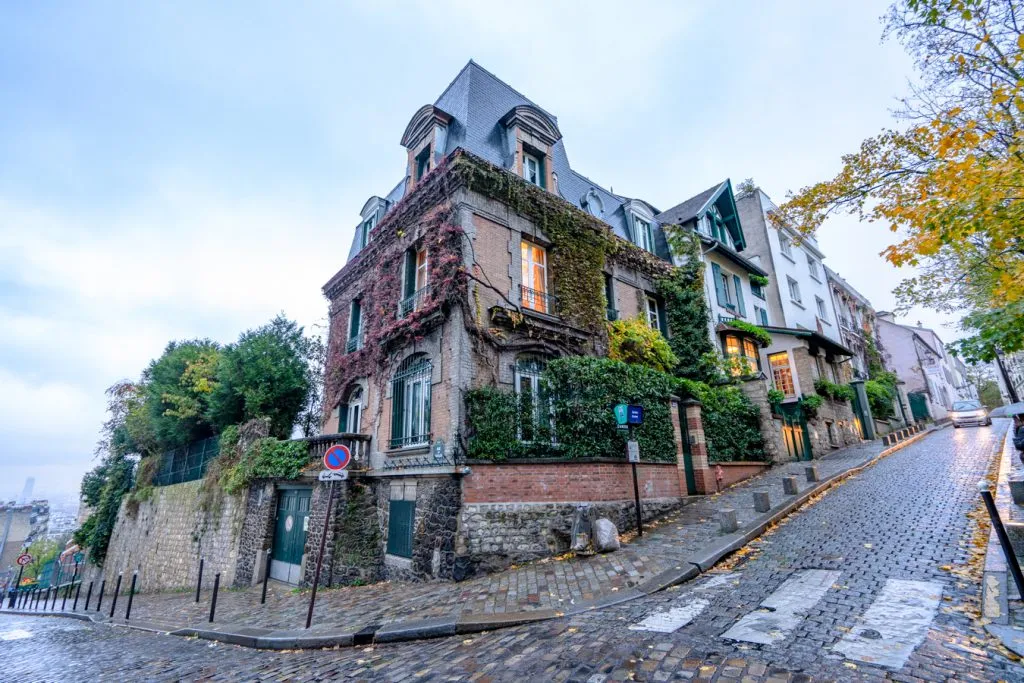
See a show at the famous Moulin Rouge!
Thanks in large part to the 2001 movie starring Nicole Kidman and Ewan McGregor, the Moulin Rouge is one of the most recognizable Montmartre landmarks.
… but it’s not technically located in Montmartre!
Located in the Pigalle district just south (and downhill) from Montmartre, the Moulin Rouge is Paris’ most famous cabaret and is topped by its most recognizable windmill.
You can file this one under “indisputably touristy and extremely memorable”, and most people love the performance (think variety show, not cohesive play).
If you want to see the cabaret show, be sure to book at least a couple of weeks in advance !
Even if you don’t go inside, though, it’s worth stopping by for a quick photo op with the windmill.
Book tickets to the Moulin Rouge cabaret show today!
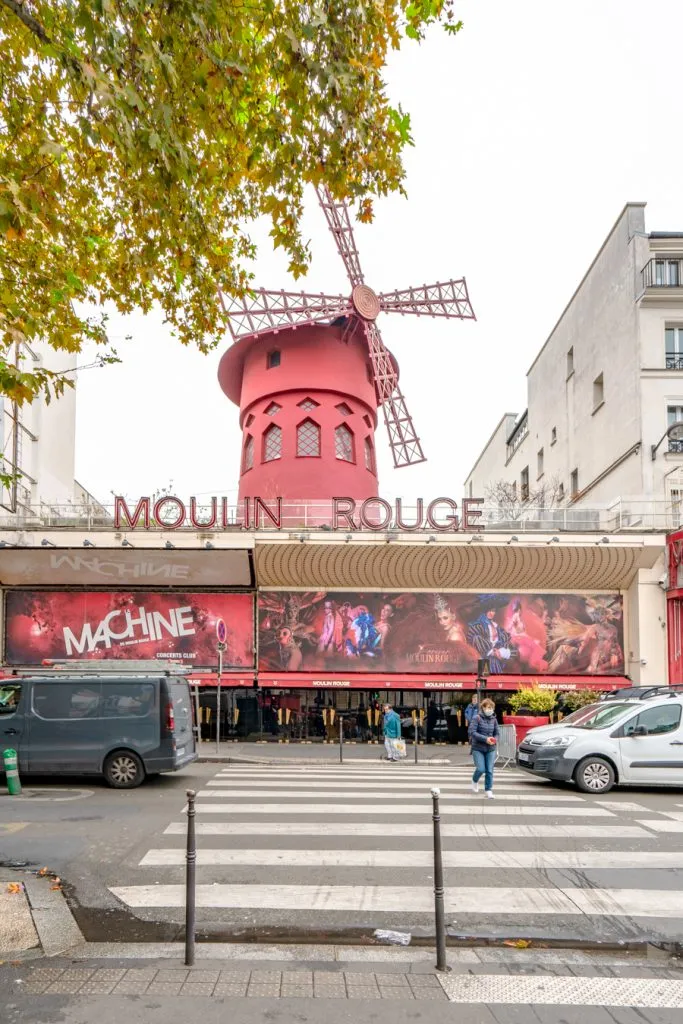
… and pay a visit to the current Le Chat Noir.
Thought to be the original Parisian cabaret, a form of nightlife that took Montmartre by storm at the end of the 19th century, Le Chat Noir has an enduring legacy in the area.
If you visited the Montmartre Museum, you no doubt learned all about the original Le Chat Noir and its unique “shadow play” that helped make it an icon.
And, if you’ve ever so much as glanced into a shop when browsing for Paris souvenirs , you have no doubt seen posters, placemats, and more decorated with the black cat drawings that have their origins at Le Chat Noir (translation: the black cat).
While the original Le Chat Noir has been closed for over a century, a later location opened in 1907 is still in business to this day.
Reviews are solid if not exceptional, and the atmosphere is a clear nod to Montmartre’s historic cabarets, complete with live music every night.
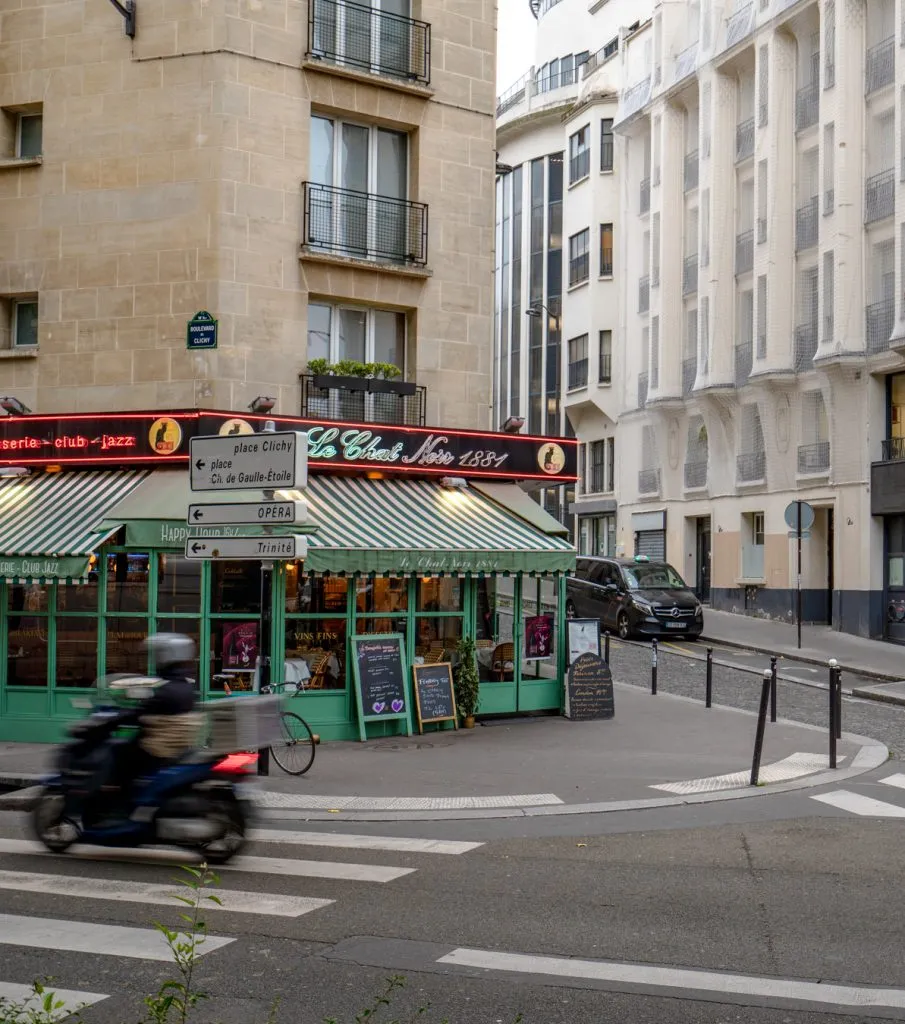
Check out the Museum of Romantic Life.
Housed in a pretty and delicate home dating to 1830, the Musée de la Vie Romantique explores a literary side of Paris, with a focus on George Sand.
Peaceful and quiet, the Museum of Romantic Life is tucked away in a charming courtyard that feels worlds away from central Paris (though if you visit during recess, you’ll hear the nearby schoolchildren playing!).
The museum includes a garden which is home to a pretty cafe, perfect for relaxing a bit before continuing your sightseeing in Paris.
The permanent exhibitions are free to visit, and we felt like we had the museum all to ourselves when we visited a few years ago.
However, now that the Museum of Romantic Life was briefly featured in season 3 of Emily in Paris, it may get a bit more crowded!
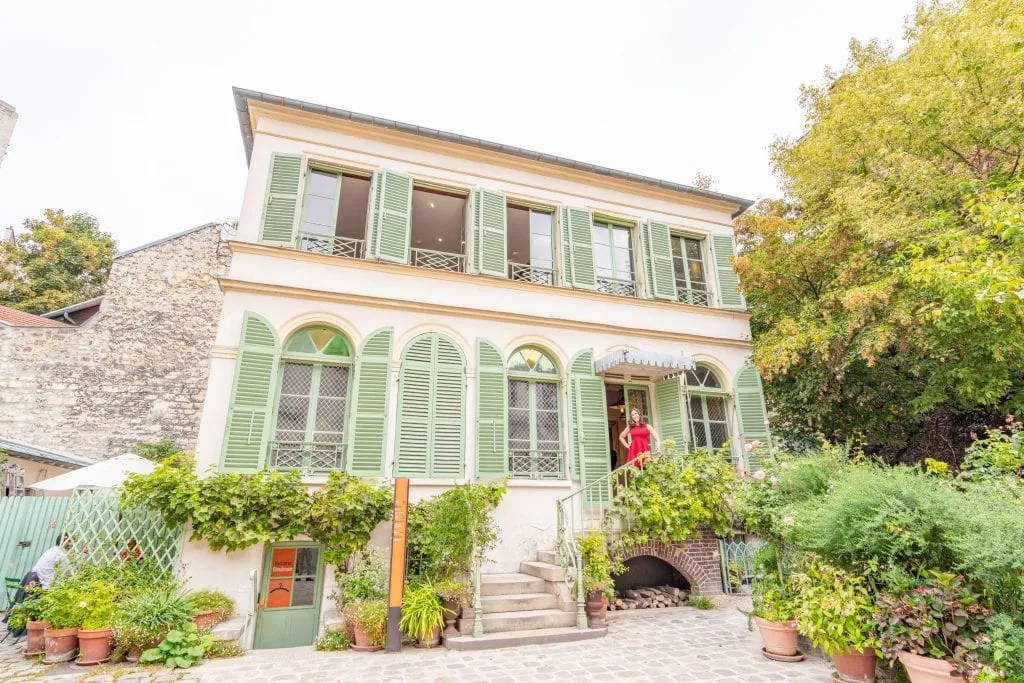
Hoping to make Montmartre your base for your trip to Paris?
As much as we love Montmartre, we first need to caution that given Montmartre’s comparative remoteness to many of the other things to do in Paris, it may not be the best fit–and we say that as travelers who have stayed in Montmartre twice and loved it both times ( this is where we stayed most recently ).
Generally speaking, we would suggest that most first-time visitors to Paris choose a more centrally located neighborhood to stay in (the Latin Quarter (5e) or Saint-Germain-des-Prés (6e) fairly close to the Seine are our go-to suggestions).
However, if you’re a repeat visitor to Paris who loves Montmartre, or you’re hoping to save money by staying a bit further out, Montmartre can be a lovely option as long as you’re prepared to “commute” to most of the top things to do in Paris.
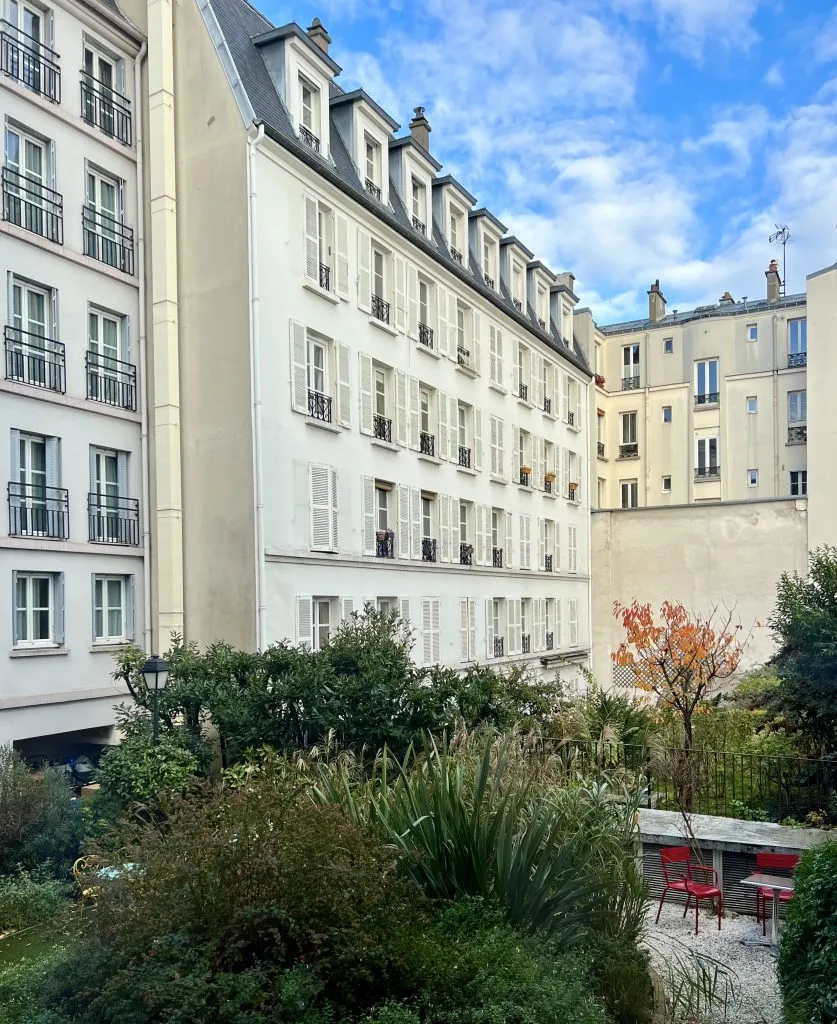
During our first trip based in Montmartre, we checked into Hotel Bellevue Montmartre (small rooms but adequate), and most recently at the Aparthotel Adagio Paris Montmartre , which we loved!
As you leave the boundaries of Montmartre itself, the nearby Pigalle area (where the Moulin Rouge is) can be a bit louder due to the nightlife, as well as a bit less refined, so keep that in mind as you’re browsing places to stay in Montmartre.
Ateliers de Montmartre ADM and the Mom’Art Hotel are two well-reviewed properties we’d love to stay in during future trips to Montmartre.
Check rates & book your stay in Montmartre today!
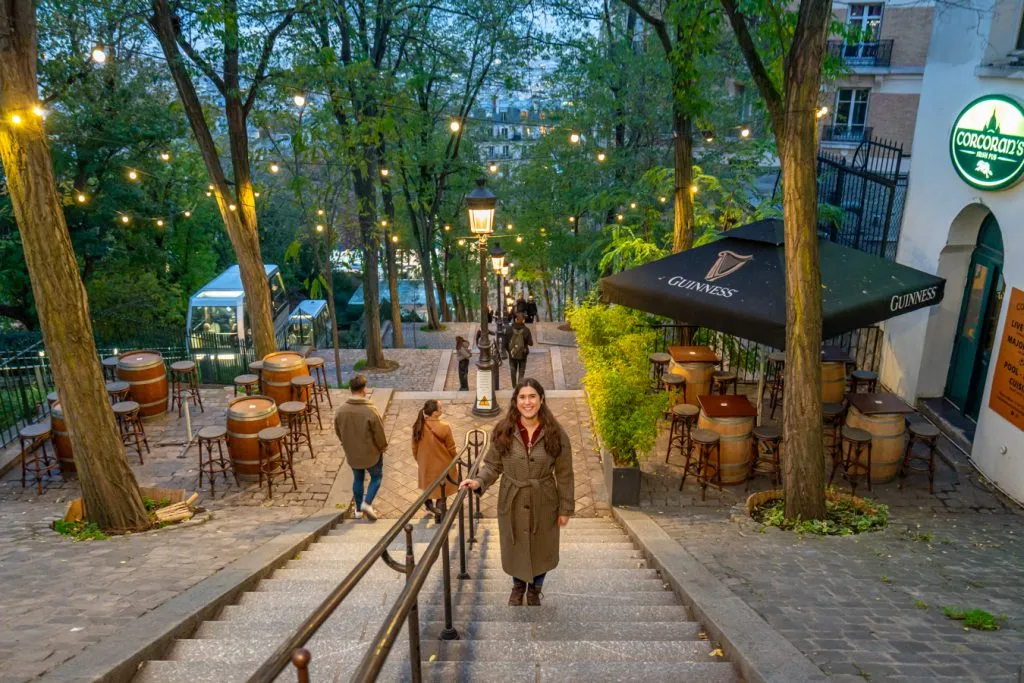
Paris is famously divided into 20 arrondissements , or neighborhoods, that are named via a number system that starts with 1 in the center of the city and circles outward like the shell of a snail.
Montmartre is the 18th arrondissement and is located on the outskirts of the city center, just north of Pigalle (where the Moulin Rouge is).
Because it is fairly far removed from–not to mention uphill from–many of the other popular things to see in Paris (it would take roughly an hour and 15 minutes to walk to Sacré-Coeur from the Eiffel Tower, for example), most visitors don’t arrive in Montmartre on foot.
You can either head to the Abbesses stop (Line 12), the deepest metro in Paris, and right next to the Wall of Love, or go to the Anvers stop (Line 2) and walk directly up Rue de Steinkerque from there until you dead-end into the Sacré-Coeur.
If you head to Abbesses, be sure to take the elevator/lift out of the station–it takes 144 steps to reach the surface!
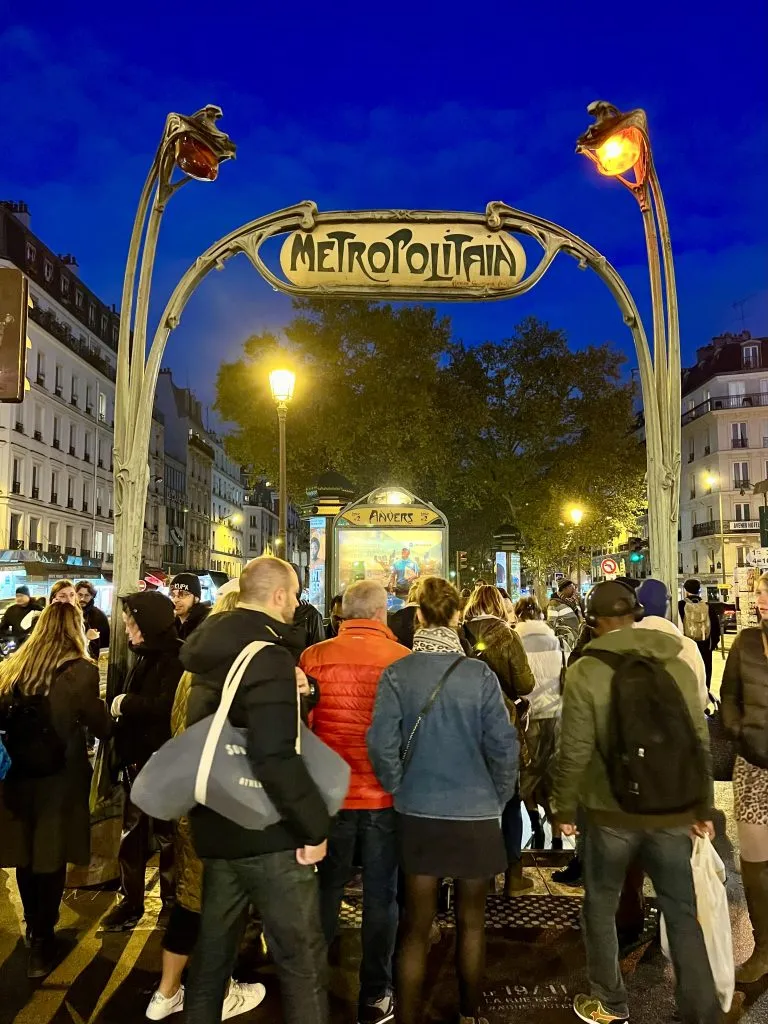
The Lamarck–Caulaincourt (Line 12) is another option on the north side of Montmartre, near Le Refuge. Its photogenic entrance is worth a look!
If you’d rather not take the metro, a taxi or Uber is always an option as well.
If you’d like to walk at least one leg of the trip to and from Montmartre, we recommend walking as you leave (downhill).
The Palais Garnier and Galeries Lafayette flagship store (with its famous dome and rooftop view) are about a 30-minute walk downhill from Montmartre.
The journey is part of the fun on this route, though: take the Rue des Martyrs and you’ll be surrounded by distractingly tempting cafes, bakeries, cheese shops, butcher shops, fruit stands, and more as you meander back toward more central neighborhoods in Paris.
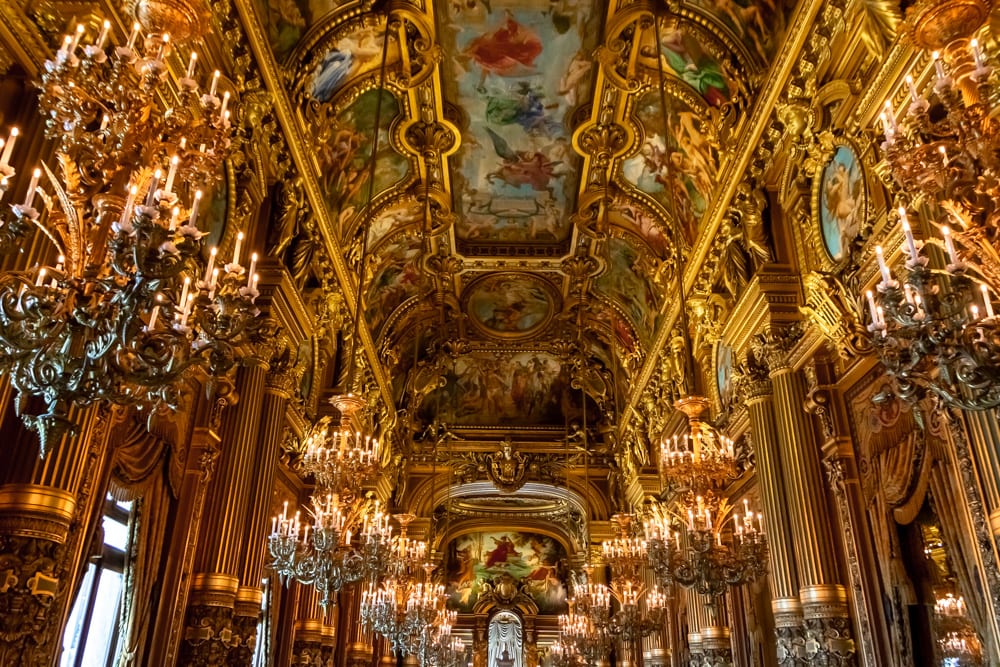
Be prepared to climb lots of hills!
There’s no getting around it: exploring the best things to do in Montmartre means climbing lots of hills, including several steep staircases!
This can be somewhat mitigated in a few places, but ultimately, it’s an unavoidable feature of the neighborhood.
To limit your climbing, you can take the Montmartre Funicular from near the Place St. Pierre to the base of Sacré-Coeur for the price of one metro ticket.
The Montmartre tourist train is also a cute way to stay off your feet, especially if you’re visiting Montmartre with kids.
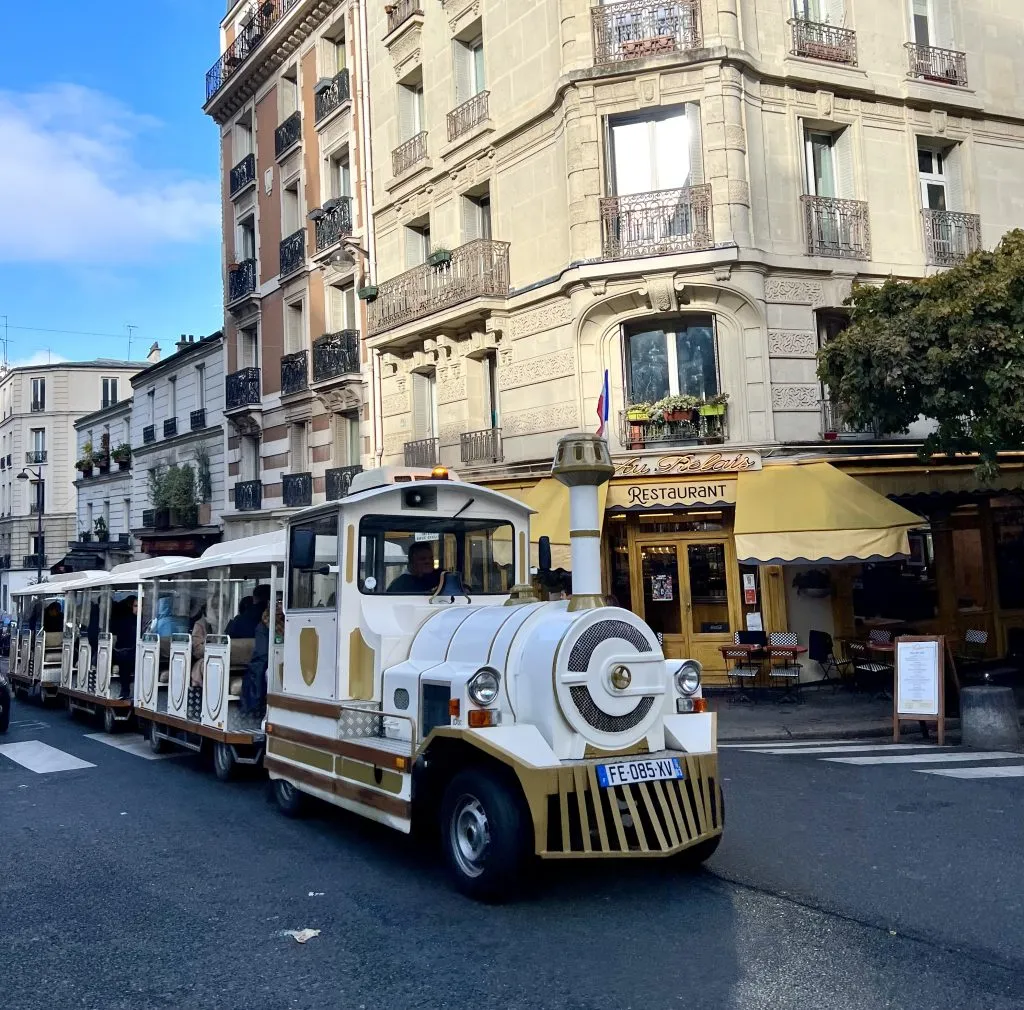
Keep an eye out for scams, especially on the steps of Sacré-Coeur.
Petty tourist scams are, unfortunately, a persistent issue in parts of Montmartre.
In particular, be cautious near the Place du Tertre, Place St. Pierre (near the carousel Sacré-Coeur), and especially on the Sacré-Coeur steps.
Common scams include unlicensed roving artists charging too much for mediocre (or worse) work, “friendship bracelets” offered for free and then charged for once they’re on your wrist, and of course, standard pickpockets.
This isn’t a reason to be frightened or stay away, but keep your wits about you and your belongings close, especially when you’re in crowds!
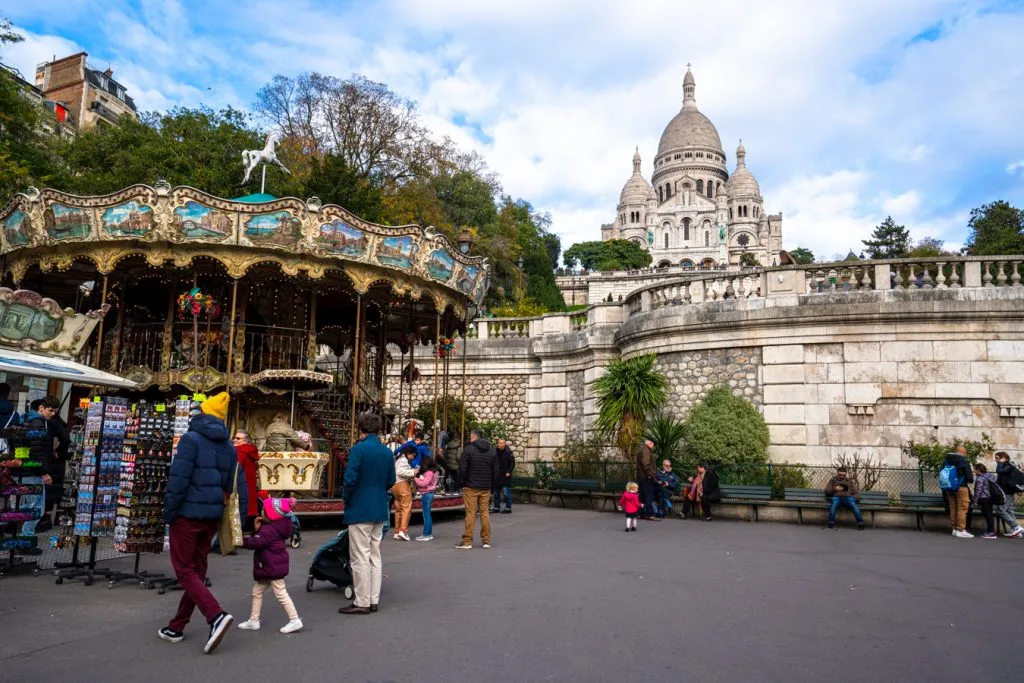
Proceed carefully if you want to have your portrait drawn in Montmartre.
I mentioned this when discussing the famous Place du Tertre, but it bears repeating: if you want to have your portrait drawn in Montmartre, choose your artist carefully!
An artist who is seated with an easel in the Place du Tertre is licensed and approved by the city, and is your best bet for quality work.
Don’t forget to discuss the price before committing!
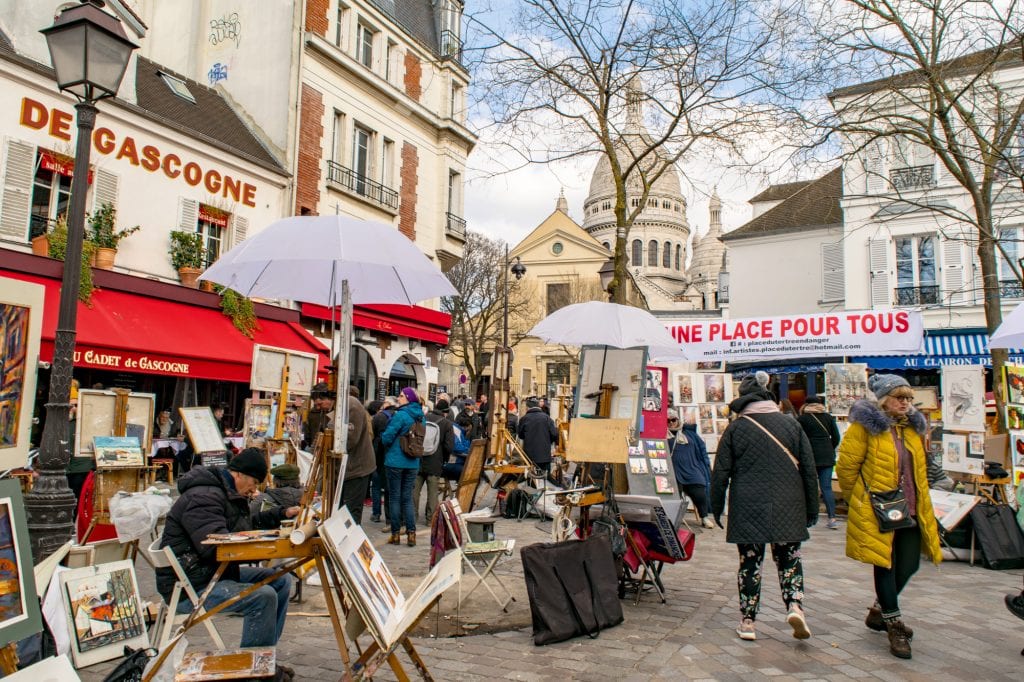
Consider visiting in the morning (or off-season) for the lowest crowds.
Generally speaking, a good rule of thumb for visiting Montmartre in Paris is that the earlier you arrive, the fewer crowds you’ll have to contend with.
If you are visiting Paris in the winter , then all the better: there’s far less congestion in Montmartre then.
Regardless, as one of the most popular neighborhoods to visit in Paris, it’s best to come to Montmartre expecting to be surrounded by tourists, souvenir hawkers, and more–unless, of course, you arrive at dawn.
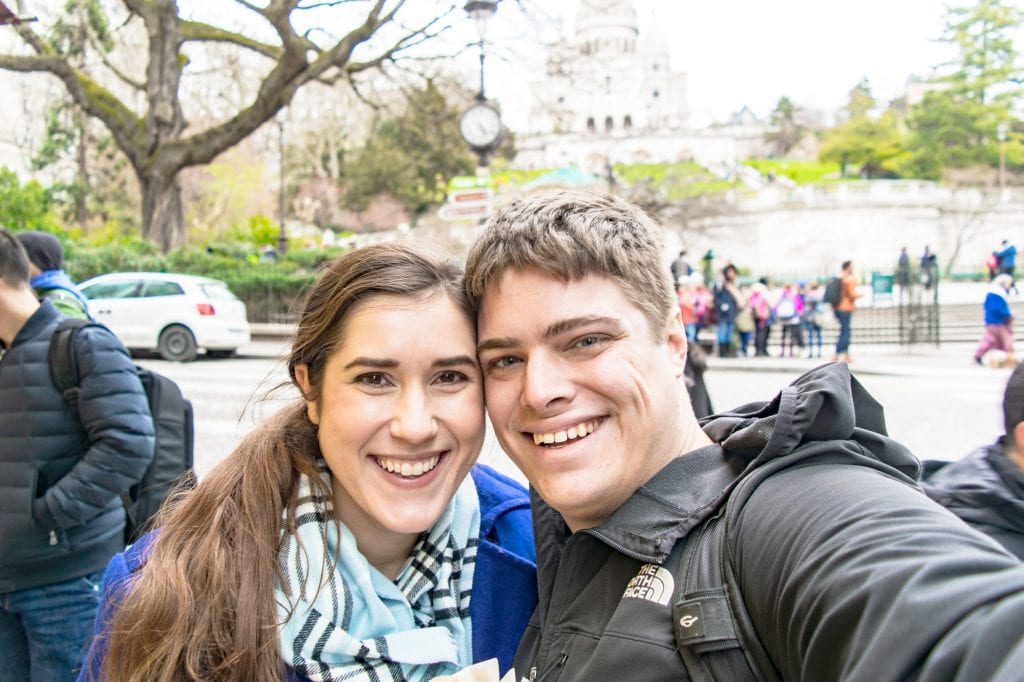
… but watching the sunset from Montmartre is also something special.
Watching the sun set over Paris from the butte of Montmartre is a beloved tradition in Paris and a fun addition to your trip!
The views are best from the top of Sacré-Coeur’s dome, but they’re still wonderful from the steps (you can’t see the Eiffel Tower from the steps, though).
Students, ex-pats, visitors, and more all gather into a jovial crowd to watch the sunset from the steps of the Sacré-Coeur every night, and it’s a memorable experience to join in the fun (just watch your pockets closely).
If you’d prefer a little more peace and quiet, wander around until you find one of the many smaller-but-still-magical viewpoints overlooking Paris.
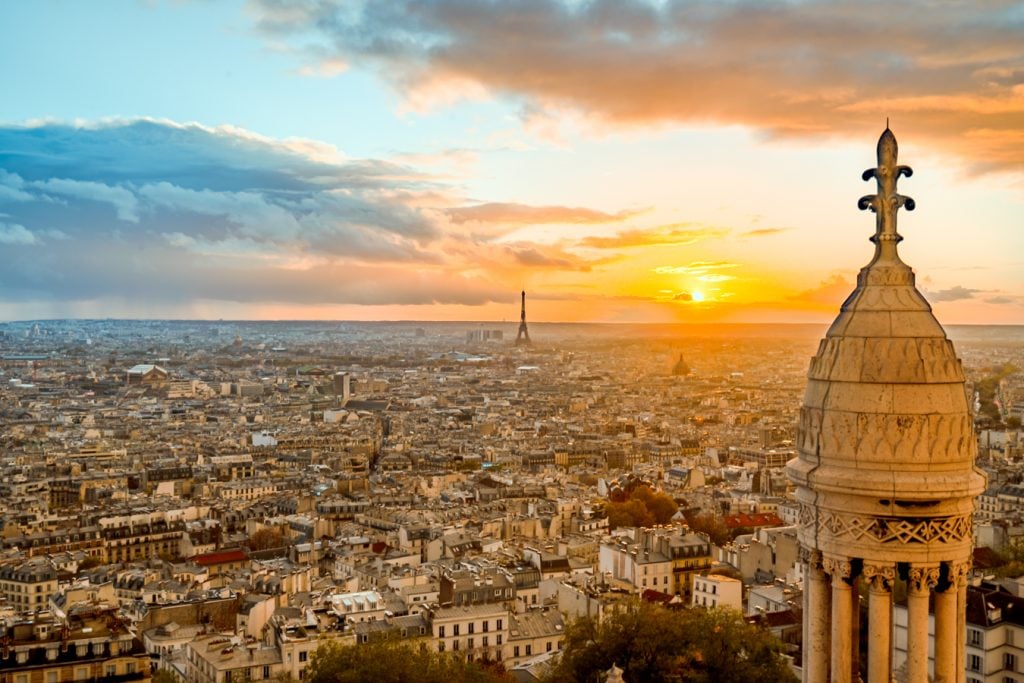
Don’t sit down at a restaurant without a quick check of its reviews.
In a place as popular with visitors as Montmartre, it’s inevitable that plenty of mediocre restaurants and cafes will pop up to serve them.
That’s not a reason to avoid eating in Montmartre at all, and we’ve enjoyed some lovely meals there (more on that in the FAQ section), but you’ll want to exercise the same caution here that you would when choosing restaurants near the Eiffel Tower or the Louvre.
Namely, avoid places that ask you to come inside, have a multi-lingual menu with flags printed on it out front, and (generally) that are within view of a major monument.
We like to use Google Reviews to check a place’s credentials before sitting down too–if you stick with places rated 4.1 and above, you’ll generally enjoy at least a solid (and sometimes delicious) meal without running into issues like surprise fees.
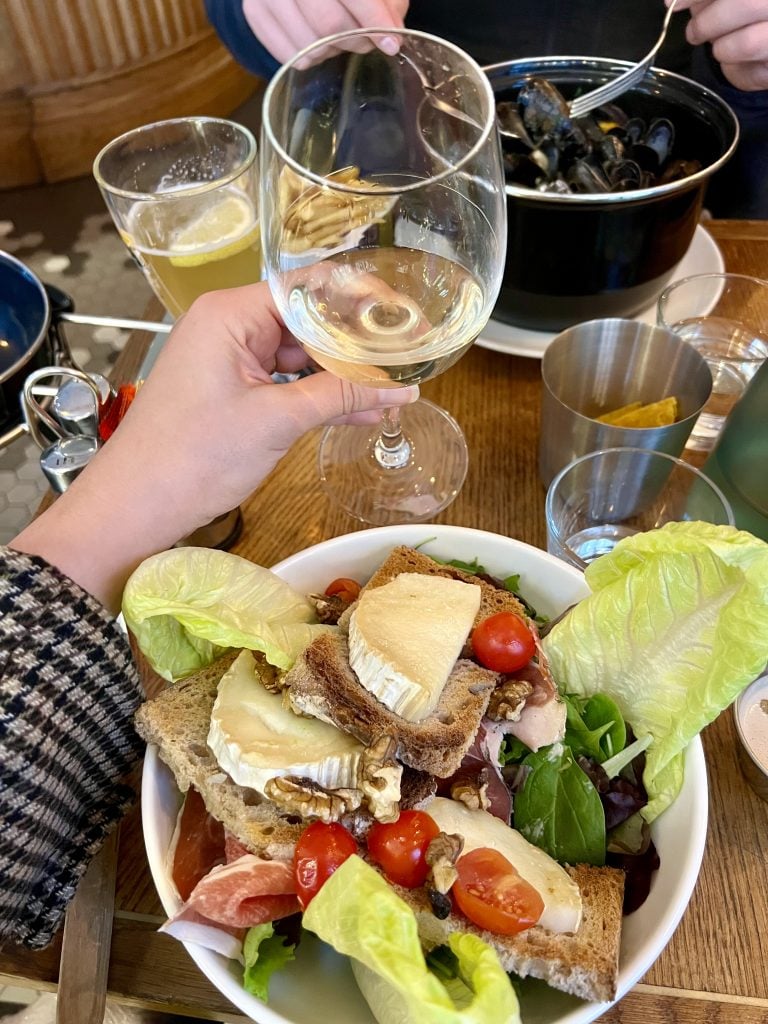
Only have time for a short visit and want to enjoy as many of the best things to do in Montmartre as possible?
Here’s a quick Montmartre walking route that we have enjoyed variations of many times!
Starting from the Anvers metro stop, head up Rue de Steinkerque until you reach Place Saint-Pierre and its beautiful carousel and view of Sacré-Coeur.
Head further uphill (ideally by passing through Square Louise Michel, though you can take the funicular as well) to the steps of Sacré-Coeur.
Enjoy the view, head inside (it’s free!), and if you’re so inclined, climb the 300 steps to the top of the dome (it’s worth it).
Afterward, circle the basilica and pay a visit to Square Marcel Bleustein Blanchet.
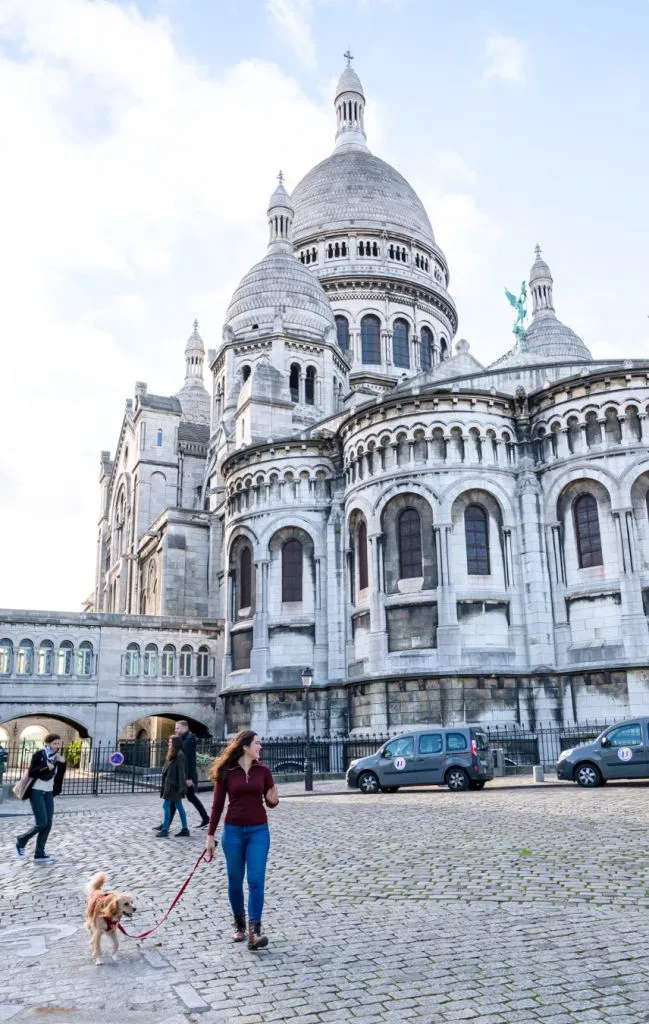
From there, finish encircling the church and head to the Place du Tertre, potentially ducking inside the Church of Saint-Pierre de Montmartre on your way.
Continue down Rue Norvins until you hit Le Consulat, and then right onto Rue des Saules.
In a very short time, you’ll come upon Le Clos Montmartre on your right.
Take a peek, then double back to La Maison Rose and stroll down the Rue de l’Abreuvoir until you hit Place Dalida (don’t forget to look behind you to enjoy the view!).
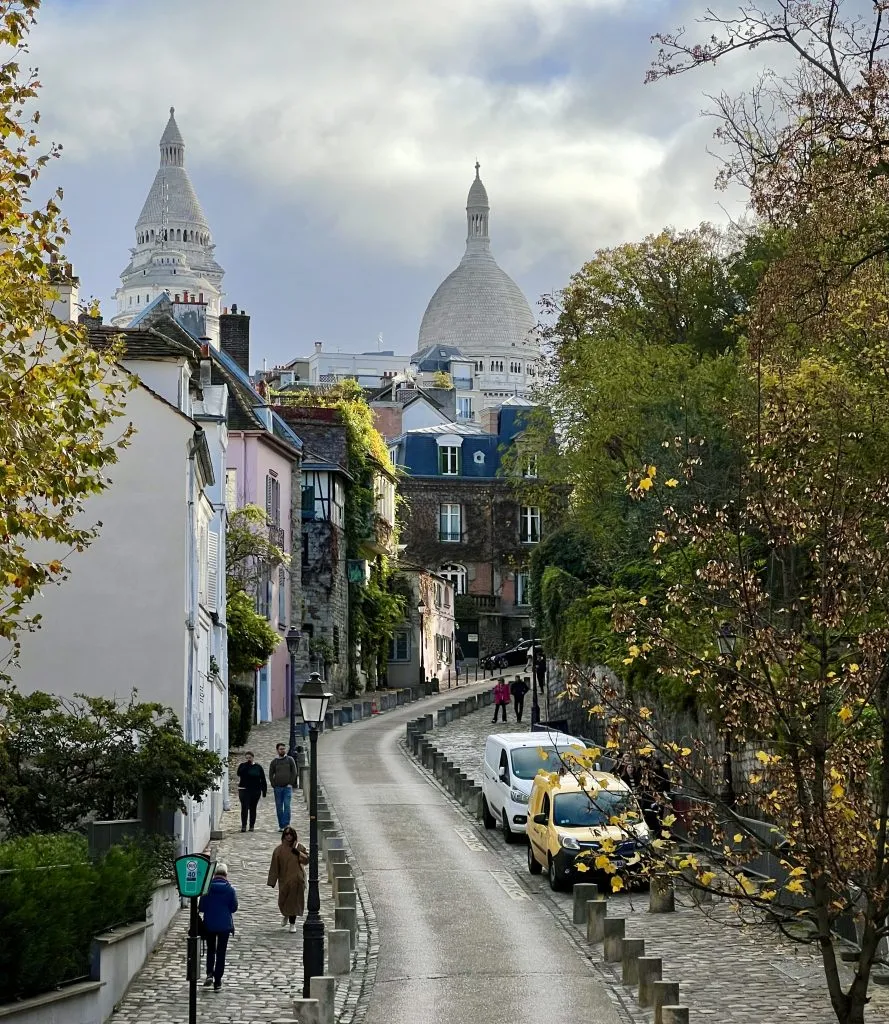
Head up Rue Girardon to famous Rue Lepic, and follow Rue Lepic as it curves back around and eventually meets up with Rue des Abbesses.
Right by the Abbesses metro stop, you’ll find the Wall of Love tucked inside Square Jehan Rictus (and right next to the metro stop, you’ll also find a crêperie stand that makes an excellent Nutella crepe).
From there, you can either hop on the metro and head off to another place in Paris, or double back to Rue Lepic and walk down to the Moulin Rouge (it’s about an 8-minute walk from the Wall of Love).
While this clearly doesn’t cover all of the beautiful places in Montmartre to visit, it’s an efficient way to get a memorable snapshot of Paris’ 18th arrondissement for those who may only have a few days in Paris and are working with limited time.
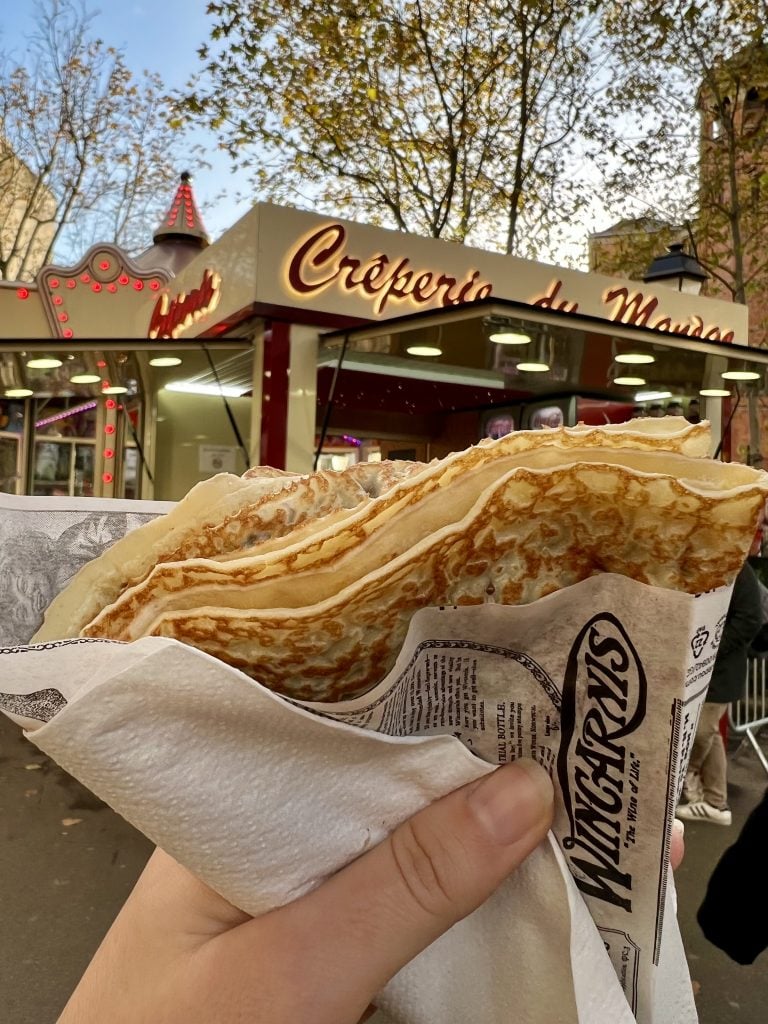
What’s the best way to get to Montmartre?
We covered this in more detail in the how to get to Montmartre section of this blog post, but essentially, the easiest way to get to Montmartre is to take the metro.
The Lamarck–Caulaincourt (Line 12) is another option on the north side of Montmartre, near Le Refuge.
If you want to see the Moulin Rouge on your way up, you could get off at the Pigalle stop and walk to Montmartre from there.
While there are a few other nearby metro stops and ways to access the neighborhood, Abbesses and Anvers are generally the most frequently used metro stops in/near Montmartre for visitors.
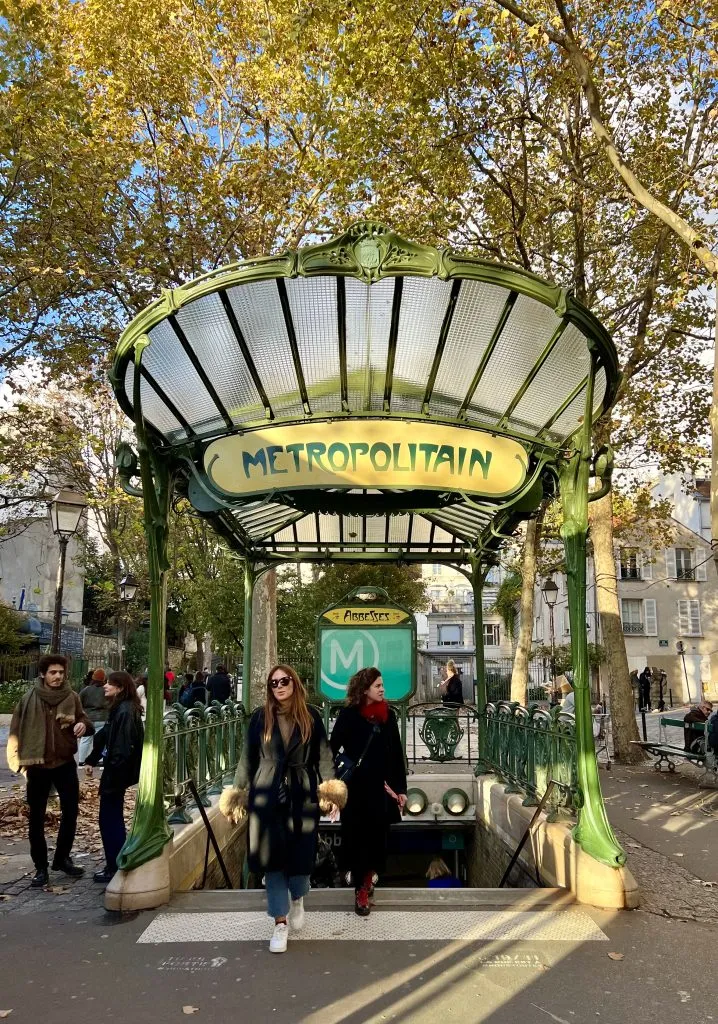
Where should I eat in Montmartre?
Montmartre has more than its fair share of mediocre restaurants aimed at tourists, so be sure to look up the reviews of anywhere you want to eat before you go!
For a special occasion, the Michelin Guide has some great suggestions!
For something unique, La Refuge des Fondus famously serves popular fondue at long, family-style tables–and serves their wine in baby bottles (yes, really).
Personally, we had tasty, casual lunches at Café de Luce and La Villa des Abbesses and would be happy to return to either.
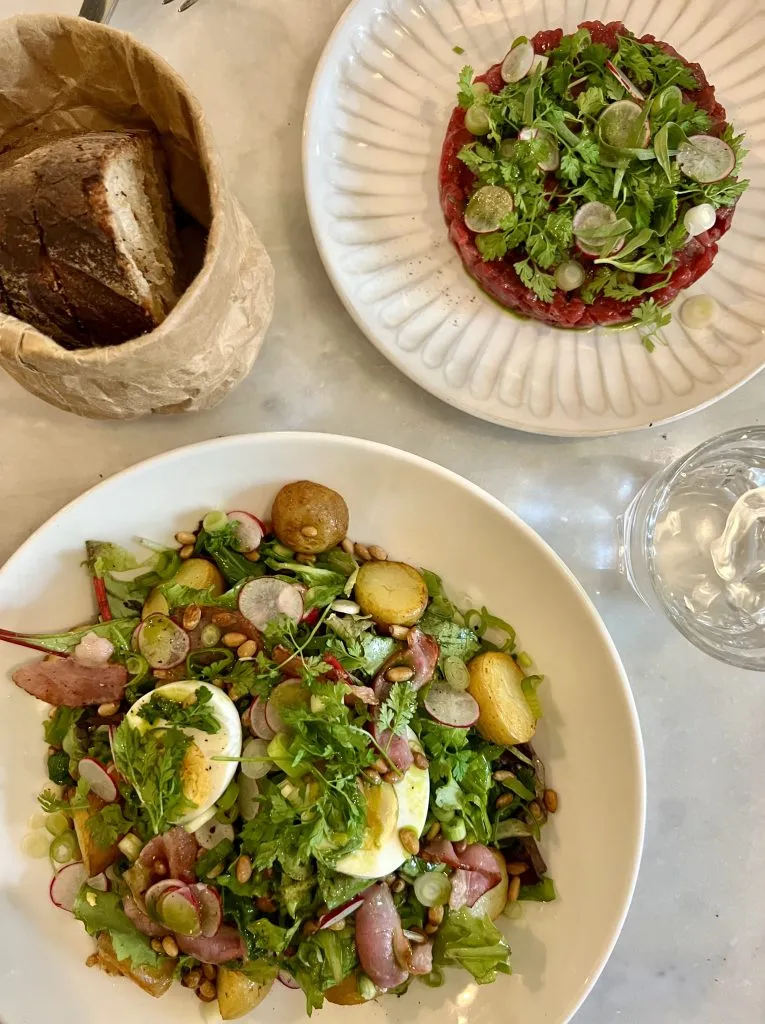
For a quick bite, Fric-Frac gets wonderful reviews for their variety of croque-monsieurs .
And, don’t forget to stop by Pain Pain to sample a baguette that was once voted the best in Paris!
This barely scratches the surface of Montmartre restaurants, of course, but ultimately, just be sure to check the reviews of an eatery before sitting down.
And, like elsewhere in Paris, it’s best to either make reservations or show up at opening in order to have a good chance at getting a table (in the most popular or famous places, reservations are often a must).
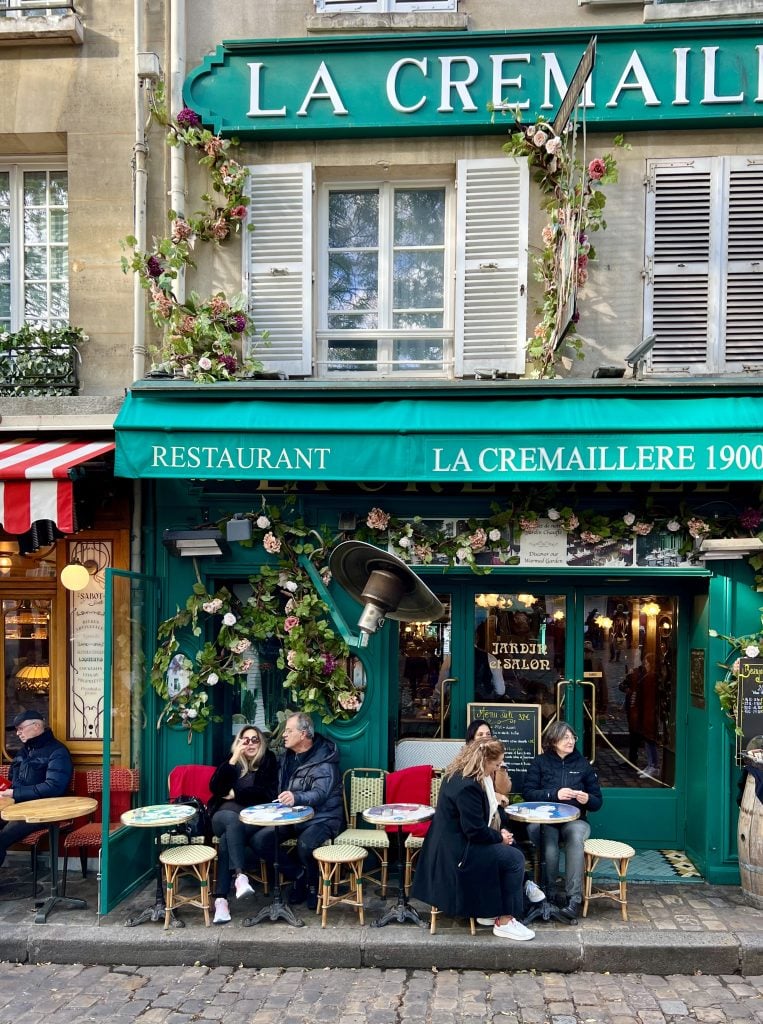
Is Montmartre a good place to stay in Paris?
It can be, depending on what kind of traveler you are!
We’ve stayed in Montmartre twice, first in a Hotel Bellevue Montmartre (small rooms but adequate), and most recently at the Aparthotel Adagio Paris Montmartre , which we loved!
Keep in mind that as you leave the boundaries of Montmartre itself, the nearby Pigalle area (where the Moulin Rouge is) can be a bit louder due to the nightlife, as well as a bit less refined, so keep that in mind as you’re browsing places to stay in Montmartre.
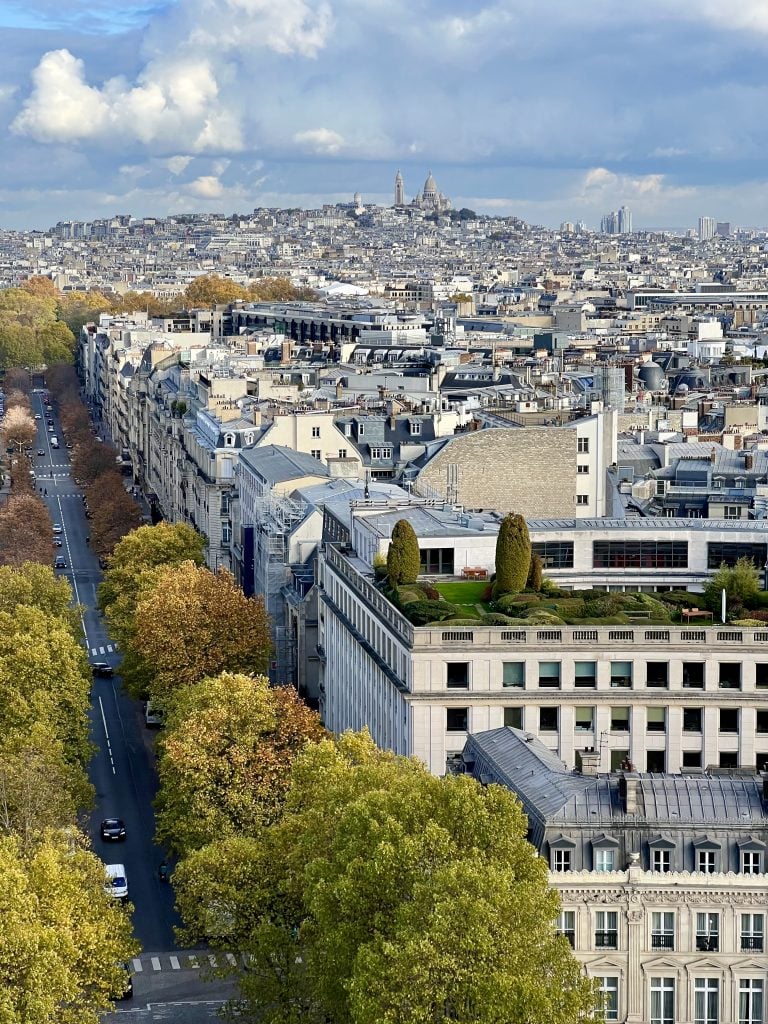
Is Montmartre worth visiting?
Yes, Montmartre is absolutely worth visiting!
Montmartre is one of Paris’ prettiest and most popular neighborhoods to visit and has been a favorite among visitors for generations.
While you’ll find more tourists than artists in this formerly bohemian neighborhood these days, that doesn’t mean it’s not still worth exploring–just that you’ll have to work a little harder to find quiet corners.
The most popular places to visit in Montmartre are typically popular for good reason, though, so don’t let the crowds scare you off (though maybe show up early to avoid the worst of them–more on that below).
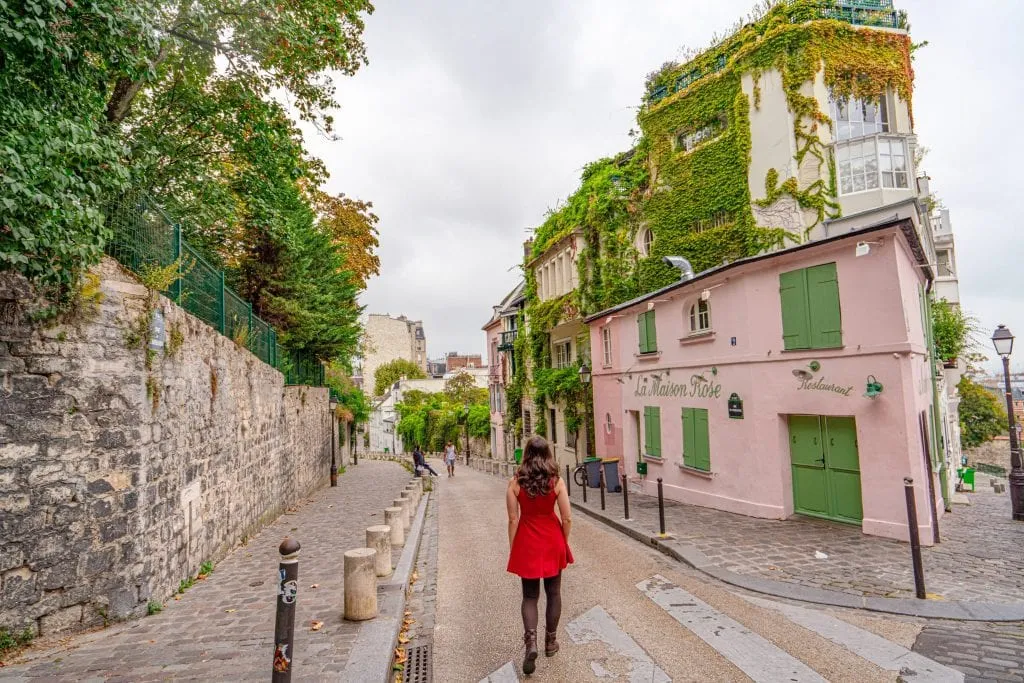
Is Montmartre safe?
When it comes to staying physically safe, Montmartre is generally as safe as any other tourist destination in Paris–which is to say, statistically very safe!
However, petty crime is a different story.
Pickpocketing is a problem in Montmartre, especially in places where tourists congregate in large crowds like the steps of Sacré-Coeur and the Place du Tertre.
Definitely keep an eye on your belongings, and don’t set your bag down at a cafe or restaurant in a place you can’t easily watch it ( our favorite anti-theft backpack latches to chairs for a bit of extra safety).
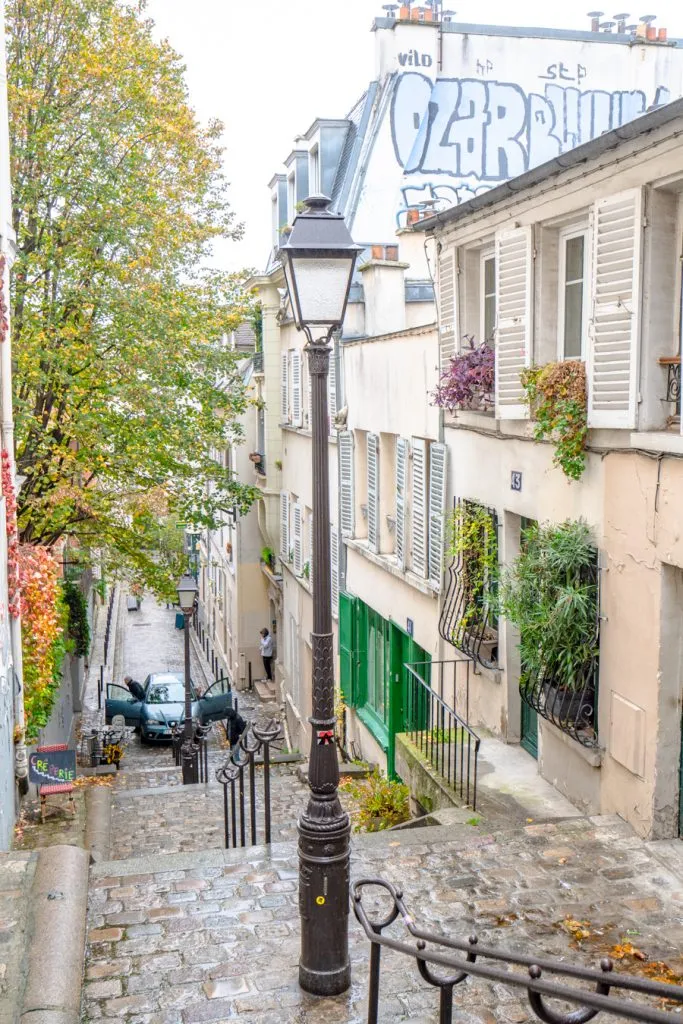
Scams are also an issue, but easily avoided: don’t give anyone money, and don’t accept any “free” items from touts (friendship bracelets are frequently offered).
A simple but firm “ non, merci ” and moving on is the best way to deal with a persistent tout.
We’ve never been pickpocketed, but it does happen and we do know people who have been robbed in Montmartre.
This is absolutely not a reason to avoid Montmartre, but staying aware of your belongings and surroundings is a must.
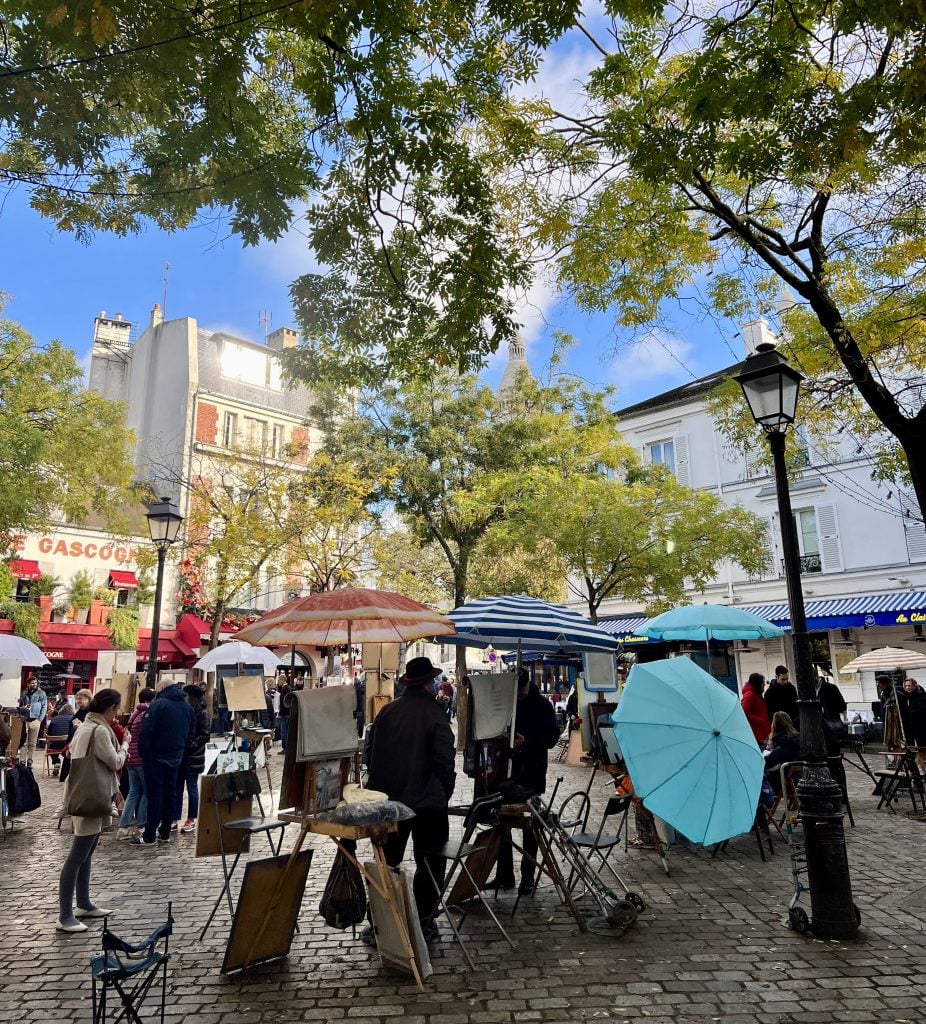
Is Montmartre safe at night?
Montmartre is very busy and touristy, and it’s generally considered just as safe at night as it is during the day!
You’ll want to be vigilant about common scams and pickpockets, but there’s no reason not to visit Montmartre at night.
Some of our favorite memories of visiting include enjoying Montmartre in the evening.
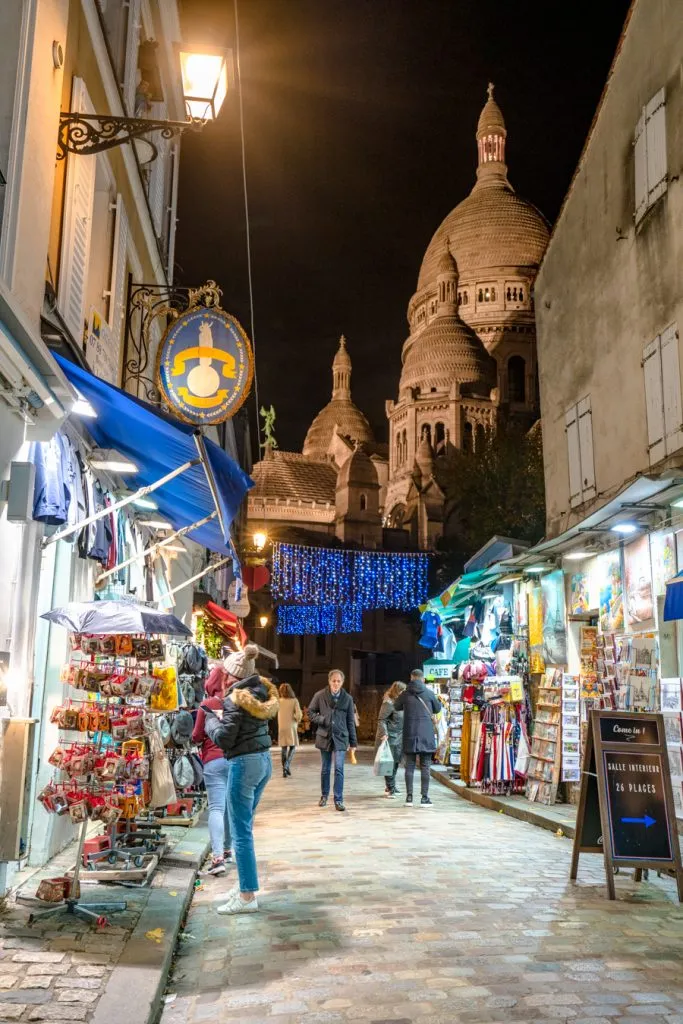
How long does it take to see Montmartre?
Our shortest visit to Montmartre lasted a couple of hours, and our longest visit was when we based ourselves in Montmartre ( in this aparthotel , which we loved) for a week!
In other words, exploring the Montmartre neighborhood is very adaptable to however much time you do have.
Since it does take a bit of a time commitment to get there from the center of Paris, I’d recommend planning to spend at least 2 hours there to make the journey worth it.
If you have less time to spare than that, you’re probably better off enjoying one of the many other incredible things to do in Paris that are closer to the center–but then again, that depends on just how much you want to see even the tiniest sliver of Montmartre.
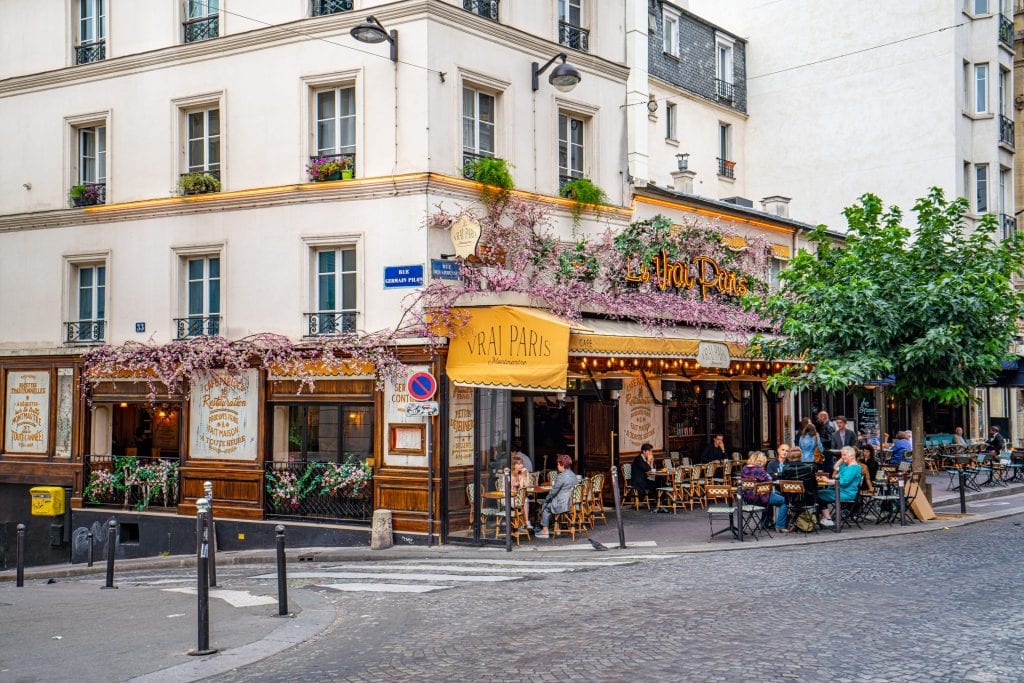
What’s the best time to visit Montmartre?
The most peaceful time to visit Montmartre is in the early morning, as soon after dawn as you can manage to get there!
Mornings generally have wonderful light for photography, too.
The most crowded time of day to visit Montmartre is the middle of the day and afternoon.
The evenings, including sunset, are far less peaceful than the mornings but are wonderful to experience.
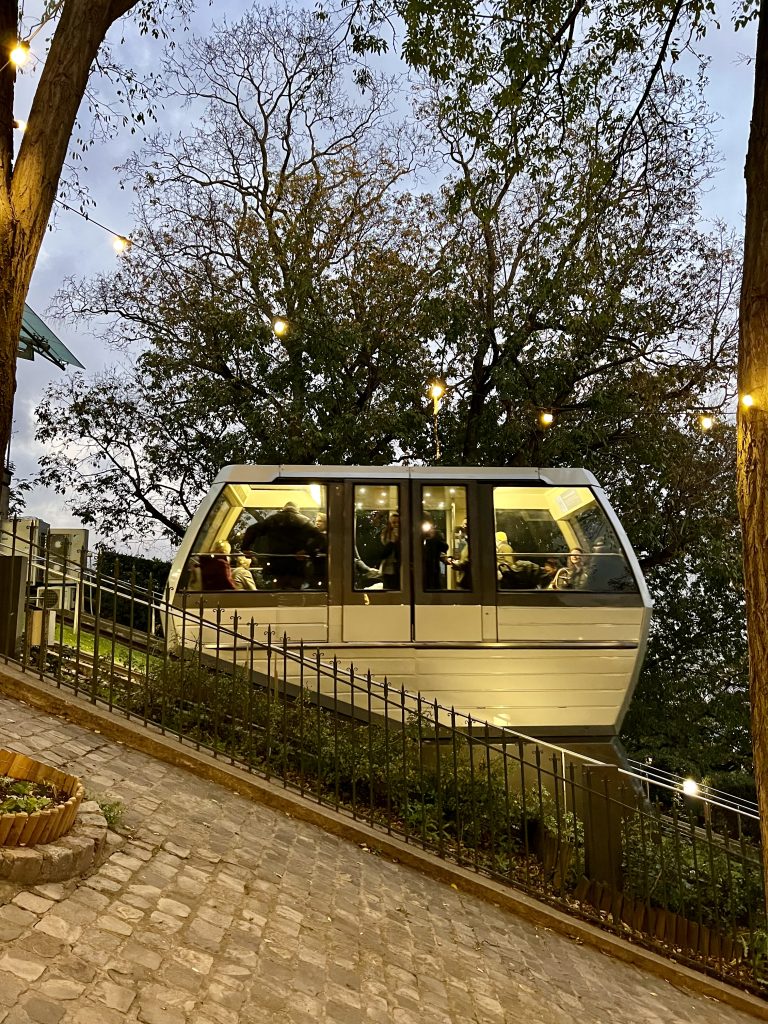
What’s the best month to visit Montmartre?
As far as the season goes, the crowds in the neighborhood of Montmartre follow those in the rest of Paris: summer is the busiest, winter the most empty, and spring and fall somewhere in the middle.
There’s not a single month of the year where I’d turn down a morning in Montmartre, though!
Cherry blossom season (late March to mid-April), fall foliage season (the first half of October), and Christmas market season (late November through early January) all also bring their own perks to the neighborhood.
Regardless of which month you visit, you’ll be able to enjoy all of the typical top things to do in Montmartre, Paris, plus perhaps some seasonal attractions as well!
Take This Map With You! Click each highlight to pull up the name of the destination. To save this map to “Your Places” on Google Maps, click the star to the right of the title. You’ll then be able to find it under the Maps tab of your Google Maps account! To open the map in a new window, click the button on the top right of the map.
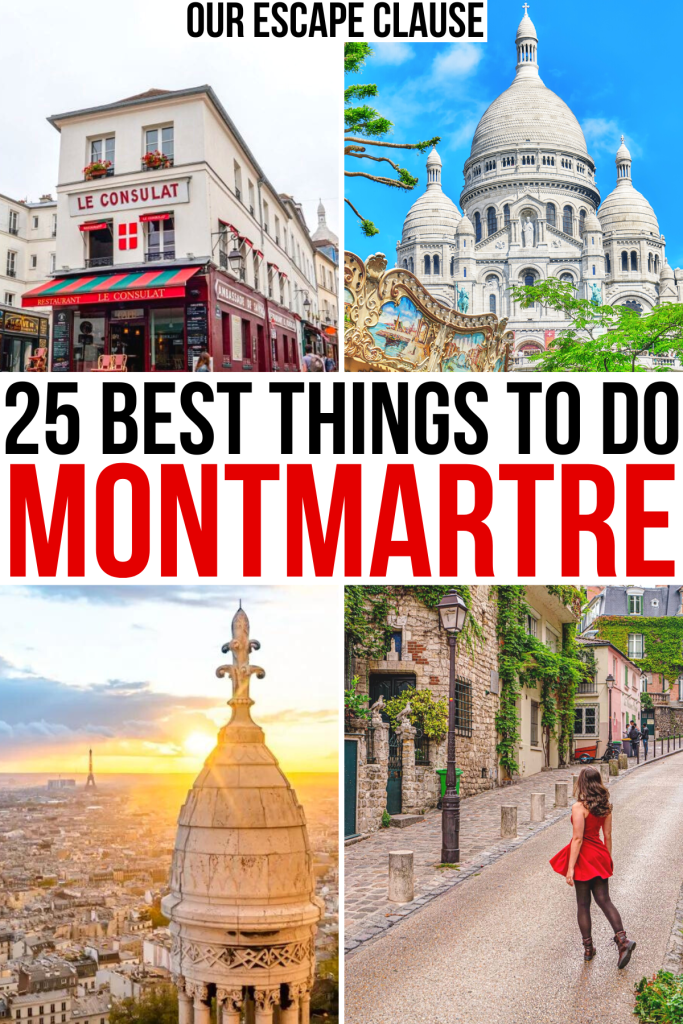
About Kate Storm

In May 2016, I left my suburban life in the USA and became a full-time traveler. Since then, I have visited 50+ countries on 5 continents and lived in Portugal, developing a special love of traveling in Europe (especially Italy) along the way. Today, along with my husband Jeremy and dog Ranger, I’m working toward my eventual goal of splitting my life between Europe and the USA.
2 thoughts on “25+ Magical Things to Do in Montmartre, Paris (+ Map & Tips!)”
Do you have any suggestions for: Monte Carlo, Monaco, Marseille, France, Sete (Montpellier) France, & Barcelona, Spain? We will be taking a fall cruise and visiting these places each for a full day of 8 hours or more. Looking for options of what to see. I really LOVE following you 2 and Ranger. Wishing you nothing but the BEST & HAPPINESS. Keep on traveling.
We’ve visited most of those, but not very in-depth for most of them (we have spent almost a week in Barcelona). We had the terrible luck of a rainy day when we were in Monaco, so didn’t get to see nearly as much of it as we would like!
I hope to publish a guide to spending one day in Barcelona sometime this spring, but in the meantime, I talk quite a bit about it in this post: https://www.ourescapeclause.com/10-days-in-spain-itinerary/
Thank you so much for following along with us! Wishing you and yours all the best. 🙂
Leave a Comment Cancel reply

- Must Do in Paris
Paris: Sacré-Coeur and Montmartre Guided Walking Tour
Embark on an enriching journey through the vibrant and colorful Montmartre neighborhood in Paris.
Quick Details
- Users Tour Type: Small Group or Private Tour
- Hour Glass Duration: 2 hours
- Check Calendar This tour runs everyday: Monday to Sunday
- Clock Start Time: 3:30 pm (1 Nov - 31 March) / 5:00 pm (1 April - 31 Oct)
- Info Additional Information: Please note that Saint Pierre de Montmartre remains closed on Mondays.
- Map Marker Meeting Point: We meet at Place des Abbesses. The guide will be waiting for you at the exit of Abbesses metro station, which is the nearest metro station. Your guide will have a signboard that says, "Walks In Europe".
Here is the Google Maps link
Embark on an enriching journey through the vibrant tapestry of Montmartre, Paris’ colorful neighborhood . Our expertly guided tour unveils the captivating essence of this district, immersing you in its history, culture, and captivating stories.
Begin your journey in the picturesque Place des Abbesses , a delightful square that sets the stage for our exploration. From here, we’ll embark on a leisurely stroll that leads us to the iconic Wall of Love – Mur des Je t’aime , where love takes center stage in a mosaic of languages and emotions. Visit the Church of Saint-Jean de Montmartre, a hidden gem of architectural beauty and spiritual significance. Pl. Émile Goudeau and Pl. Marcel Ayme will reveal their secrets, including the intriguing sculpture of Le Passe-Muraille – the Passer-Through-Walls at the latter square.
Meander through the charming streets , Pl. Suzanne-Buisson will greet us with the statue of St. Denis, a historical touchpoint. On Rue de l’Abreuvoir , encounter the Buste de Dalida , a tribute to a beloved French singer. Our tour takes us to the renowned Cabaret Au Lapin Agile , a gathering place for artists and free spirits throughout the years. Continue along Rue des Saules , the Clos Montmartre vineyard, a testament to Montmartre’s rich history, will grace our path.
Make your way through the charming streets, Pl. du Calvaire will provide us with picturesque vistas, and we’ll soon arrive at the famed Place du Tertre , affectionately known as the painters’ haven. Nestled at the heart of Montmartre, this renowned square has been a cultural melting pot for generations, resonating with the voices of artists, revolutionaries, and free spirits who have all contributed to Paris’ extraordinary narrative. Along the way, absorb the charming vistas of local windmills, sprawling vineyards, and the quintessential Parisian way of life . Delve into the architectural nuances of the district’s diverse structures, while stories of luminaries like Picasso, Van Gogh, and Utrillo come to life.
Our tour doesn’t just illuminate Montmartre’s history; it connects you with its contemporary allure. Discover touchpoints of French pop culture and iconic filming locations, including spots seen in “Amélie” and “Emily in Paris.” Unearth hidden gems that lie beyond the usual tourist paths, thanks to your knowledgeable guide. Venture through the cobbled streets, uncovering hidden architectural gems, our journey leads us to the Église Saint-Pierre de Montmartre.
Conclude your adventure at the famous Sacré-Coeur Basilica , where you’ll be treated to a breathtaking panorama of the entire city of Paris. Discover the soul of Montmartre , from its cultural treasures to its hidden nooks, on a guided tour that promises an unforgettable exploration of this enchanting neighborhood.
- Chevron down Itinerary
- Place des Abbesses
- Wall of Love – Mur des Je t’aime
- Church of Saint-Jean de Montmartre
- pl. Émile Goudeau
- pl. Marcel Ayme – Le Passe-Muraille – the Passer-Through-Walls
- pl Suzanne-Buisson – the statue of St. Denis
- Rue de l’Abreuvoir – Buste de Dalida
- Cabaret Au Lapin Agile
- Rue des Saules – The vineyard, known as Clos Montmartre
- pl. du Calvaire
- Place du Tertre
- Église Saint-Pierre de Montmartre
- Sacré Coeur Basilica
- Chevron down Highlights
- Explore the famous Sacré-Coeur Basilica and Saint Jean de Montmartre Church with an expert guide.
- Visit Place du Tertre and trace artistic legends such as Monet, Renoir, and Van Gogh.
- Witness the Lapin Agile, a place once frequented by painters like Picasso for their meals.
- Uncover the tale of Dalida and her affection for this neighborhood.
- Experience the lives of renowned artists, musicians, and iconic figures of Paris on a walking tour.
- Chevron down Included
- Professional and local Walks In Europe tour guides
- Guided tour of Montmartre and Place du Tertre
- Outside tour of the Sacré-Coeur Basilica
- Small Groups of up to 9 people
- 2-hour walking tour at a relaxed pace
- Chevron down Excluded
- Entrance to the Sacré Coeur Basilica
- Transportation to the meeting point
- Food and drinks
- Chevron down Essential Information
- Confirmation will be received at the time of booking.
- Not wheelchair accessible.
- This tour will have a maximum of 9 travelers.
- Travelers should have a moderate physical fitness level.
- Please note that Montmartre features inclines and hilly streets. This tour is designed for those who relish delightful historical walks.
- If you’d like to visit Sacre Coeur on your own, in the end of the tour, we suggest you to wear appropriate dress for a better experience regarding rules of the basilica.
- Kindly take note of the fact that Sainte Pierre de Montmartre remains closed on Mondays.
- Clients must arrive at the meeting point 15 minutes before the start of the tour.
- Please be advised that it is not possible to join the tour after it has commenced.
- Chevron down Meeting Point
We meet at Place des Abbesses. The guide will be waiting for you at the exit of Abbesses metro station, which is the nearest metro station. Your guide will have a signboard that says, “Walks In Europe”.
Related Tours
- Exclusive Experience
- Hour Glass 2 Hours
Paris: Masterpieces of the Louvre Tour with Pre-reserved Tickets
Only 6 individuals led by an expert guide for an exclusive experience where you can discover the masterpieces of the Louvre in just 2 hours–with pre-booked tickets!
Our semi-private guided tour is the most efficient way to appreciate the potentially overwhelming amount of art housed in the Louvre Museum
- Great Combo: 2 in 1
- Hour Glass 2 Hours , 3 Hours
Paris: Guided Walking Tour with Seine River Cruise Tickets
Experience the heart of Paris on a scenic walking tour led by an expert guide. Take in iconic landmarks such as Notre Dame, and the Louvre Museum. Explore Île de la Cité, the city’s central island.
Choose to end your day with an optional ticket for a cruise on the Seine River.
- Exceptional Destination In Paris
Paris: Jewish History Guided Tour In Marais
Explore the cultural and historic center of Jewish Paris in the Marais district. Join a small group tour to witness the rich legacy of Jewish culture in Paris led by an expert local guide.
Learn fascinating insights and stories about the people, events, and traditions that have shaped the Marais Jewish district over the centuries.
- Explore the Heart of Paris on a Cruise Along the Seine
- Hour Glass 1 Hours
Paris: Seine River Sightseeing Cruise
A delightful and captivating journey through the heart of Paris, showcasing the city’s most iconic landmarks and breathtaking scenery. Cruise past the magnificent Eiffel Tower and as the boat gracefully glides along the Seine River, see views of historical landmarks such as the Louvre Museum, Notre-Dame Cathedral, and the charming Pont Neuf. Enjoy informative audio commentary providing fascinating insights into the history and culture of Paris.

Pack your bags
Subscribe to my newsletter to get updates in your inbox!
You have successfully joined our subscriber list.
The Ultimate Montmartre Paris Photo Walk
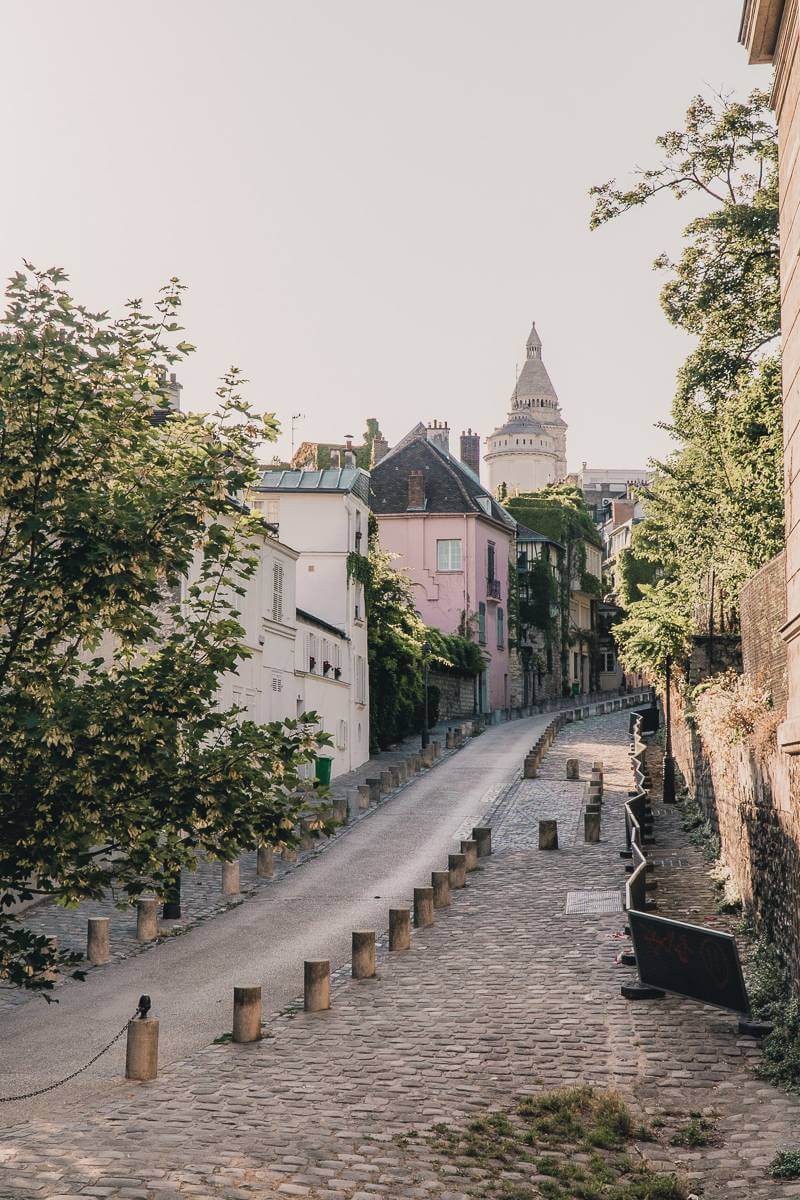
This post may contain affiliate links, meaning if you buy or book through one of these links, I may earn a small commission .
If you are looking for the ultimate charming walk through Paris, look no further than Montmartre in the 18th arrondissement. Located on top of the “butte”, or hill, Montmartre boasts the iconic white basilica of Sacré-Coeur, and was once home to artists like Renoir and Picasso. Below, I’ve created a stunning walk through Montmartre to make sure you see its most beautiful and inspirational scenery.
On my first ever two-day trip to Paris , I actually skipped Montmartre, and had no idea what I was missing! This neighborhood used to be its own village outside of Paris until 1860, and retains a bohemian spirit and energy. Starting in the mid-1800’s, Montmartre’s cheap rents attracted all types of artists, and their creative energy still permeates in the cobblestones today.
As Montmartre sits on the butte, any visit to the 18th arrondissement will include some stairs and inclines. During my recent solo Paris trip , I kept returning to Montmartre, heaving myself up the hill and dripping in sweat. However, I’d always sigh at the beauty that greeted me at the top, which is ultimately what inspired me to share this dreamy Montmartre walk.
18 Stops for the Most Magical Montmartre Photo Walk
Below is a mapped route of this photo walk, and underneath, I am listing out the sights in the order that you’d find them. Of course, you can do this walk in any order you want, but the suggested route will ensure you don’t miss any Montmartre highlights.
If arriving by metro, I recommend taking the green line to the Abbesses stop (be ready for stairs!). I’ve also created a map with pins of all the below sights here .
It’s best to do this self-guided Montmartre walk in the morning. By afternoon, the area will be crowded with tourists, crawling with pick pocketers, and in peak summer, insufferably hot. I should know – the high was 106 degrees F during my visit!
Wall of Love
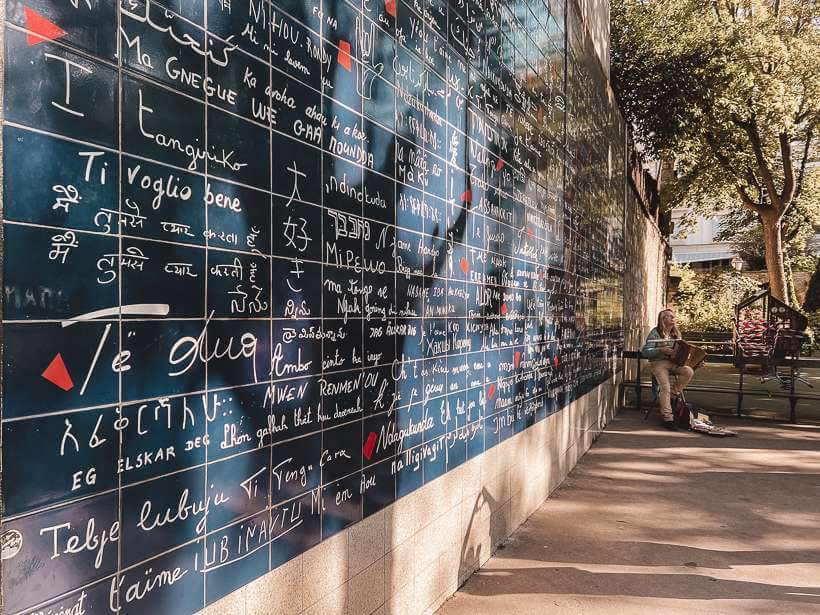
The Wall of Love, or Le Mur des Je t’aime, is one of the first sights you’ll encounter upon climbing the hill into Montmartre. It is located inside a darling little park on Place des Abbesses. The wall is a popular photo spot, and you will see many visitors posing for selfies.
The wall consists of 612 squares made of enamelled lava, with “I love you” written on them 311 times in 250 languages. Designers Frédéric Baron and Claire Kito also scattered little red shapes among the words to represent a broken heart from the separation of mankind. The wall itself optimistically symbolizes a reunification.
During my visit, a man sat in front of the wall signing songs of heartbreak while playing the accordion. “Jamais, jamais, jamais” repeated in my head for the rest of the morning.
Le Bateau-Lavoir

Le Bateau-Lavoir (translation is “laundry boat”), is the artists’ studio on Place Émile Goudeau where Picasso once lived and worked. Here, Picasso painted works from his Rose Period, which are thought to be inspired by model Fernande Olivier. In 1907, he painted Les Demoiselles d’Avignon, thus beginning his famous cubist style.
The current Bateau-Lavoir building is not the original, as the studio burned down in 1970. However, the reconstructed space still functions as a studio today for budding artists.
As the studio is closed to the public, you can only view the exterior, which unassumingly sits in a shady corner of the square. It’s easy to miss if you aren’t looking for it!
Note: Before continuing your Montmartre walk, stop at the Wallace Fountain in the square. It’s the perfect chance to top off your water bottle for free!
Dalida Statue

Dalida was a French singer who saw great career success, with songs like “Paroles paroles” and “Bambino”. Raised in Egypt by Italian parents, Dalida came to Paris during the 1950’s to launch her career. In 1962, she purchased an apartment in Montmartre at 11 rue d’Orchampt. You can still view its little balcony today.
Although Dalida is a celebrated musician and known for fun disco songs, she struggled personally. Sadly, the singer took her own life in her Montmartre home in 1987 at the age of 54.
In 1997, Dalida was immortalized with a bust facing up towards Rue de l’Abreuvoir, one of Paris’s most picturesque streets. Strangely, rubbing the singer’s bosom is said to bring good luck. You can see from the wear on the statue that she has received a lot of superstitious visitors!
It is also possible to pay homage to Dalida by visiting her grave in Montmartre Cemetery.
Rue de l’Abreuvoir
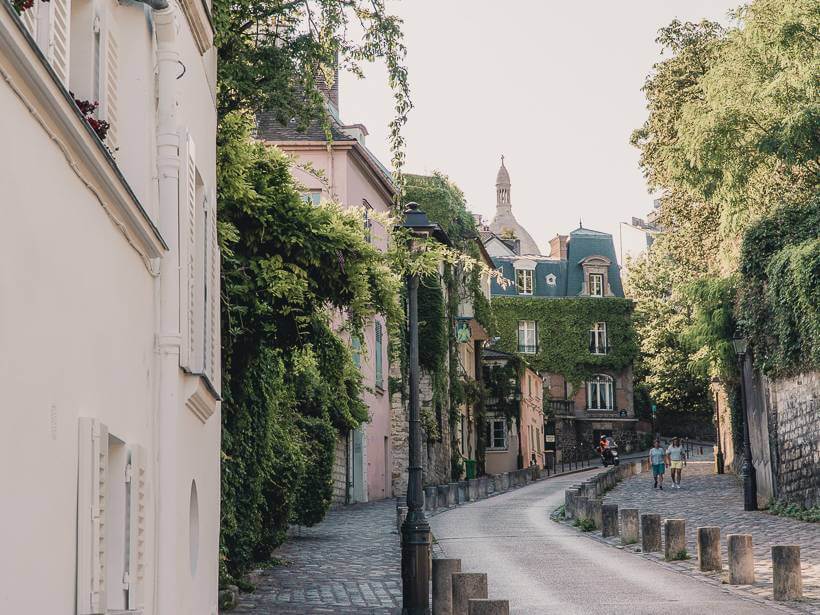
Turn opposite from the Dalida statue, and you’ll be looking up Rue de l’Abreuvoir. If you feel yourself swooning, that’s totally normal…with the dome of Sacré-Coeur rising above the pretty houses, it’s a beauty! Reference was made to the street as early as the year 1325, when it was called “Ruelle qui va au But”.
You may also know this street from the scene in Emily in Paris, where Emily stages a bed at the bottom of the hill during a marketing campaign. Emily’s friend, Mindy, translates the street’s earlier name to “road that leads to the end”. However, I think it means something closer to “alley that leads to the top of the hill”.
Chemin de L’Abreuvoir became the street name in 1863. “Abreuvoir” means “trough”, which refers to the drinking trough that once sat at the corner of Rue Girardon and Rue de l’Abreuvoir.
The street stretches from Place Dalida to Rue des Saules, which is where this Montmartre walk is heading next. Don’t forget to take photos along the way!
La Maison Rose
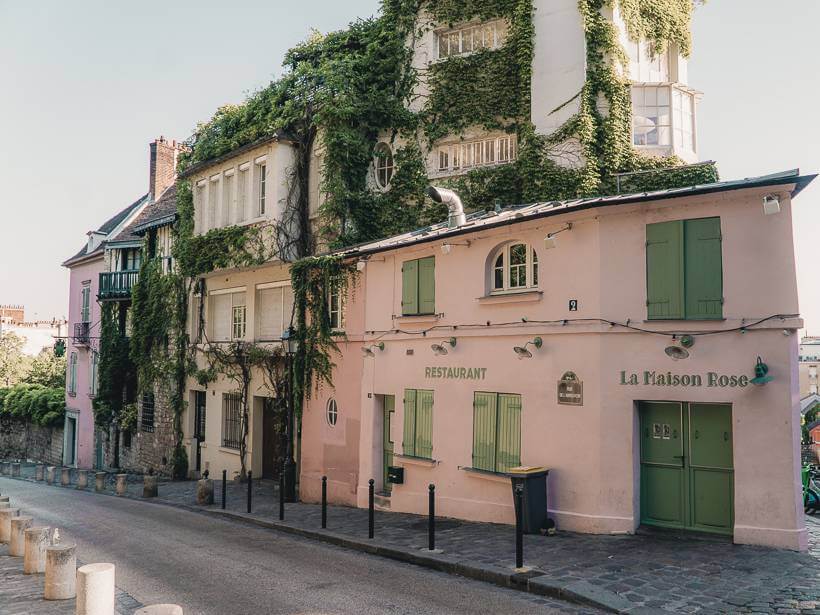
La Maison Rose , with its famous pink façade, sits sharply on the corner of Rue de l’Abreuvoir and Rue des Saules. Germaine Gargallo, wife of painter Ramon Pichot, opened the restaurant in 1908. It quickly became a regular hangout for various artists and their friends.
Maurice Utrillo was the one who immortalized La Maison Rose in his paintings, although he was greatly influenced by Élisée Maclet, who painted the same scenery before him. The restaurant changed hands over the years, while the likes of Dalida and Albert Camus dined here and furthered the restaurant’s legendary status.
Visitors can still eat and sip a coffee at this café while visiting Montmartre today. For the best photos of La Maison Rose, come early in the morning, when you’ll have the place mostly to yourself. By the afternoon, this popular spot will be overrun with selfie-takers.
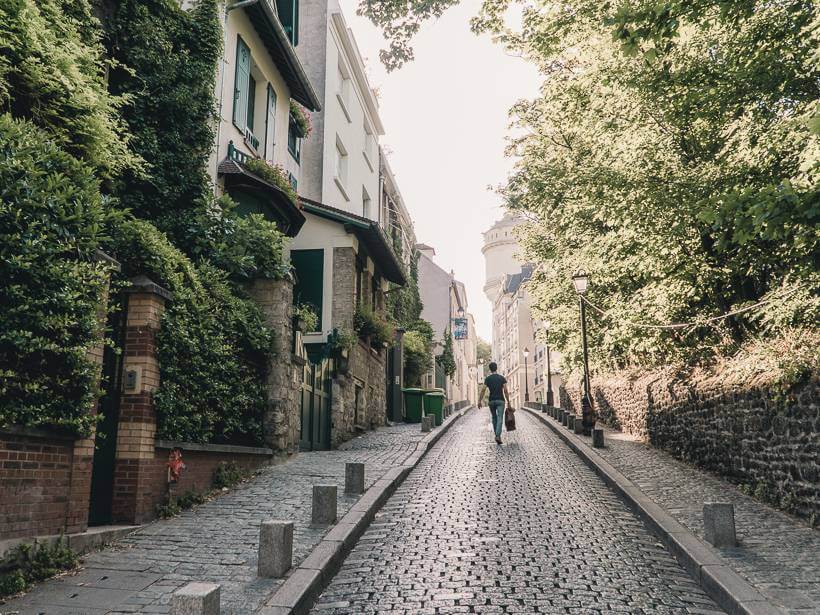
You’ll encounter shady Rue Cortot after crossing Rue des Saulles in front of La Maison Rose. Straight ahead, you’ll see the Montmartre water tower, which uses the same stone as Sacré-Coeur and still services Montmartre buildings at the top of the hill today.
Formerly called Rue Saint-Jean, the street first appeared on a Paris map in 1672. The new name took place when Paris acquired the village of Montmartre in 1860, naming it after sculptor Jean-Pierre Cortot.
Number 6 was once home to landscape and portrait painter Adolphe-Felix Cals, who lived there until 1853. Later, composer and writer Erik Satie lived at the same address. That’s not all though – continue further down the street to find an address of even greater historical and artistic significance.
Musée de Montmartre
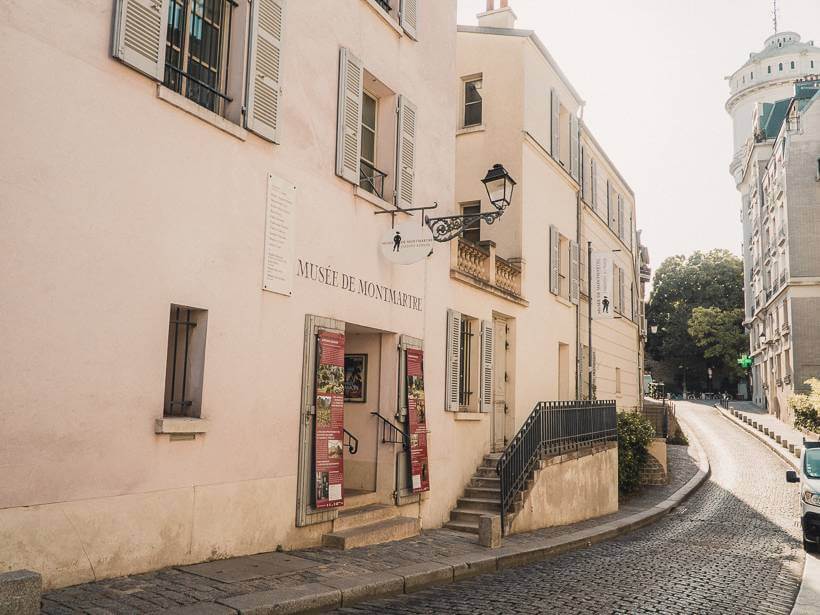
A walk through the Musée de Montmartre will have you entering the oldest building on the butte, which dates back to the 17th century. In 1960, addresses 12-14 Rue Cortot were converted into a museum to preserve crucial pieces of Montmartre’s history. It all honesty, many museums bore me, but not this one.
First off, some of the most famous Montmartre artists once called 12 Rue Cortot home. From 1875 to 1877, August Renoir lived here, and painted famous works like Bal du moulin de la Galette and Jardin de la rue Cortot. Later, in 1912, artists Suzanne Valadon, André Utter, and Maurice Utrillo also lived and found inspiration here.
Second, the museum’s exhibitions take you back in time to 19th and early 20th century Montmartre. Check out the detailed reproduction of Suzanne Valadon’s studio before browsing paintings, posters, and drawings by Montmartre artists. It’s impossible to leave here without feeling totally immersed into the bohemian Montmartre of yore!
Don’t forget to spend some time outside too, where there are three gardens that replicate Renoir paintings and a pleasant little café. Before continuing your Montmartre walk, head to the west side of the gardens to see this next fascinating sight.
Vigne du Clos Montmartre

Clos Montmartre is a hidden vineyard within the urban sprawl of Paris. It preserves the winemaking tradition that was a large part of Montmartre’s economy from at least the Middle Ages. By the time Montmartre became part of Paris in 1860, this practice had essentially vanished due to industrialization and diseased vines.
Artists living in Montmartre planted a new vineyard during the 1920’s in order to block a real estate project. Ever since the first harvest in 1933, there has been a festival each October to celebrate the grapes. The vineyard annually produces about 1,000 bottles of reportedly mediocre red wine each year, but it is still beloved for what it represents.
You can view Clos Montmartre by turning left onto Rue des Saules after you pass La Maison Rose. However, you will get an even better view from the gardens of Musée de Montmartre.
Just beyond the vineyard, you can also see the orange building of Lapin Agile . There has been a cabaret at this site since the mid-1800’s. It was a favorite hangout for artists to blow off steam, with one of the most famous clients being Pablo Picasso.
Rue du Chevalier de la Barre
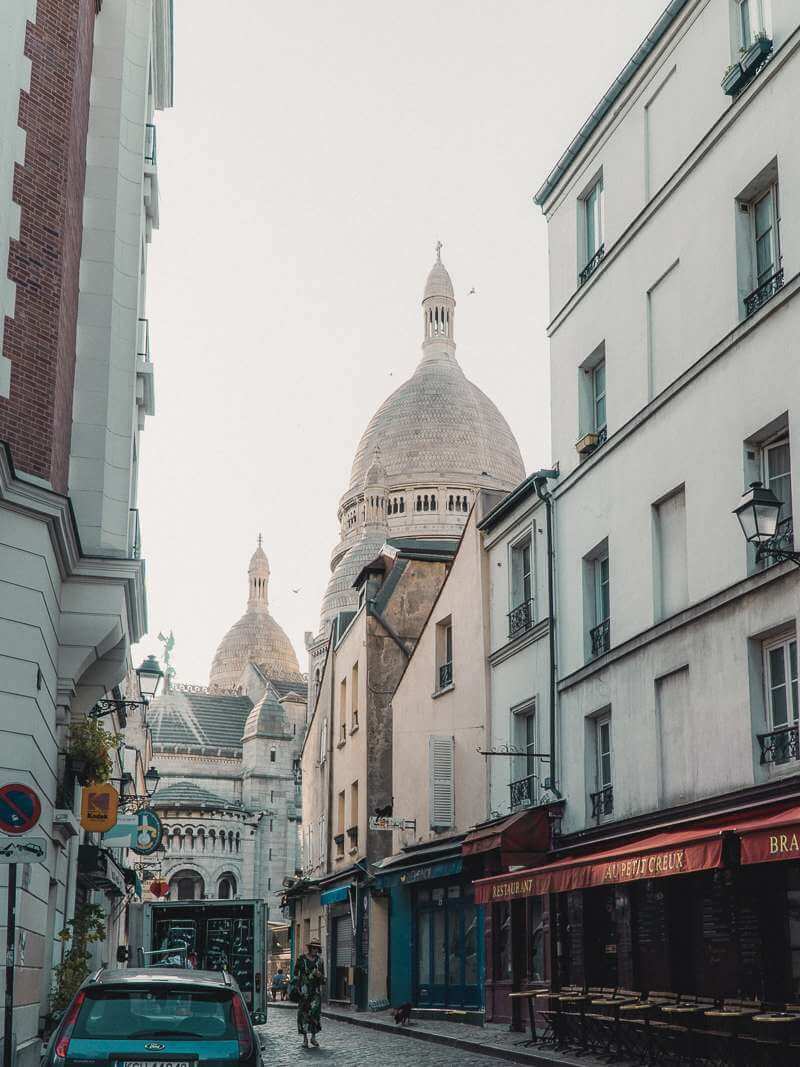
Feast your eyes on yet another beautiful street on this Montmartre walk. I found Rue du Chevalier de la Barre by accident after leaving the Musée de Montmartre, when I turned a corner and Boom! Stunning view of Sacré-Coeur right before my eyes.
This street is named for nobleman Francois-Jean de la Barre, who was brutally executed in 1766 for outwardly expressing religious intolerance. Some say his crime was not saluting a Roman Catholic religious procession, but there were probably other small offenses. This mattered at the time, as the church was very intertwined with government in Roman Catholic France, and La Barre’s actions were seen as blasphemous.
Today, you can find La Barre’s statue in Square Nadar. The 1897 original was melted down in 1941 during Nazi occupation, but was rebuilt and put in the same spot in 2001. La Barre’s statue and namesake street are seen to symbolize the checks that must be placed on religious power.
Today, Catholicism is still the predominant religion in France, although the country has actually become one of the least religious in Europe.
Sacré-Coeur
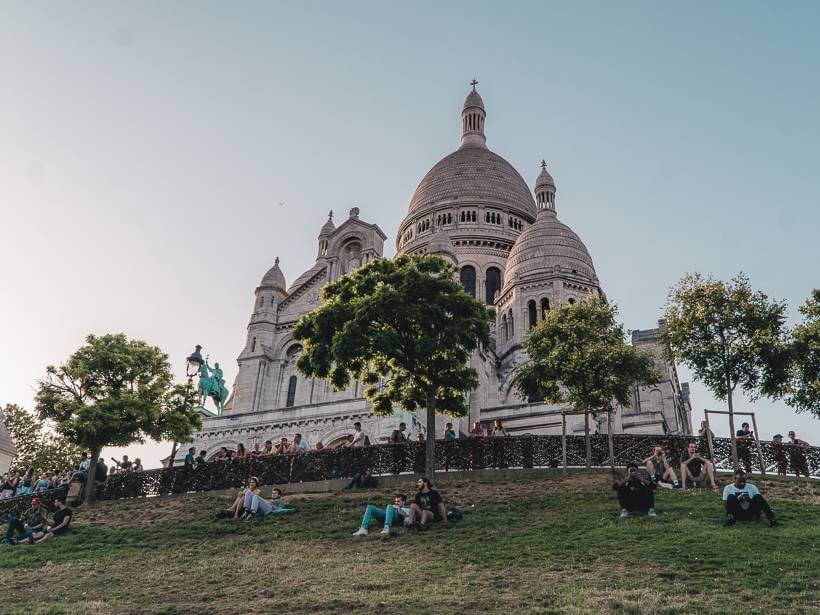
Sacré-Coeur is the star of Montmartre, drawing over 10 million visitors each year. It is situated at the top of the butte, which has been a site of worship since ancient times. One of the most famous legends is the martyrdom of St. Denis, who was beheaded here and walked off with his head still preaching.
Plans for Sacré-Coeur originated during France’s war with Prussia from 1870-1871, which fell during a century of national unrest. Some Catholics saw this violent period as punishment for increasingly immoral behavior in Paris. Upon losing the war, Hubert Rohault de Fleury and Alexandre Legentil pledged to build a new basilica high enough to be seen all over Paris to atone for the city’s sins.
At this time, Paris was split between the pro-monarchy Catholic establishment and increasingly liberal Parisians who desired a separation of church and state. This split culminated in the Paris Commune, an ugly period that saw destruction all over Paris and thousands of citizens killed. You could see why many Parisians would be weary of building what they saw as a giant symbol of Catholicism that would be visible from all over Paris.
Despite this, plans went ahead in 1873, when Architect Paul Abadie designed the new basilica in the Romanesque-Byzantine style. Funding for Sacré-Coeur came entirely from public donations, and despite a pause during World War I, was completed in 1923. The basilica’s iconic exterior is due to a type of limestone that releases calcite and becomes whiter when it touches rainwater.
Today, you can visit the basilica for free, as well as pay €7 to climb 300 steps to the dome, which gives panoramic views over all of Paris.
Sacré Coeur Steps

No Montmartre walk would be complete without a stop at the Sacré-Coeur steps. You can find them directly in front of the Basilica, with their incredible view over Paris’s rooftops, especially during golden hour.
Just stay aware of your surroundings while you take in this beauty. This area is infamous for pickpocketers.
“Sinking” House

The sinking house of Montmartre is a favorite photo spot for Instagrammers and bloggers. It is visible from Sacré-Coeur, to the left when facing away from the basilica.
To get a photo with the building seemingly “sinking” into the grass, you will need to go to the middle of the stairs in front of Sacré Coeur (not the ones attached to the building, but the next set below) and stand at the far left (facing Paris). Turn to the left, and you will be able to see the salmon-colored building sitting beyond a grassy hill.
Simply tilt your camera to the right, and voila! The building looks like it’s sinking. Note – you can also make the adjustment later, by turning the picture to the left during editing.
Place du Tertre

Located just steps away from Sacré-Coeur, Place du Tertre is lined with charming, albeit touristy, cafes and restaurants. The many artists who found inspiration here, including Van Gogh, Picasso, Pissarro, and Modigliani, led it to be called the “artists’ square”.
Translating to “of the mound”, Place du Tertre is Paris’s highest square and was Montmartre’s main gathering spot until the village became part of Paris in 1860. It was also the site of Montmartre’s first town hall in 1790. Three years later, the restaurant La Mère Catherine opened for business, and is still serving authentic French food today.
Montmartre’s creative spirit is kept alive in the center of the square, where artists with easels sketch portraits and paint scenery with watercolors. It’s good fun, but scams do happen, so agree to a price before sitting for a portrait.
Speaking of scams, Place du Tertre’s crowds of tourists tend to lure pick pockets. Visiting in the morning will help you avoid any unhappy situations and evade the worst of the crowds.
Join this food tour to eat your way through Montmartre
Rue Saint-Rustique

Continue your walk down Rue Saint-Rustique: the oldest street in Montmartre and the highest street in Paris at 130 meters. The street dates back to the Middle Ages, and received its current name after Montmartre’s annexation to Paris. The name comes from the priest, Rustique, who was executed alongside Saint Denis by the Romans during the spread of Christianity.
Utrillo famously painted Rue Saint-Rustique in 1926. Later, in 1973, it became the first street in Montmartre designated as a pedestrian walkway.
Today, Rue Saint-Rustique is an incredibly romantic alleyway to stroll, with gorgeous views of Sacré-Coeur. You will even pass a couple restaurant terraces charmingly tucked away along the route.
Montmartre’s current name may be derived from “Mons Martyrum”, which is Latin for “The Martyr’s Hill”.
Le Consulat Cafe

Le Consulat is a 19th century cafe that sits alone on the corner between Rue Norvins and Rue Saint-Rustique. The café is famous for the collection of celebrated artists that frequented it, which are rumored to include legends like Picasso, Sisley, Van Gogh, Toulouse-Lautrec, and Monet. Plus, it’s just adorable.
A perch here is a wonderful spot to watch the world go by while enjoying traditional French food and wine. Maybe you’ll even soak up some of the artistic energy that was once so prevalent in a bygone era.
Moulin de la Galette

The first thing you’ll undoubtedly notice about Moulin de la Galette is the giant windmill sitting on top. Being one of Montmartre’s last remaining windmills out of more than a dozen, it preserves an important part of this former village’s heritage. Don’t let the touristy appearance fool you, though – this restaurant is completely fabulous!
The famous “Radet” windmill above the restaurant dates back to 1717. In 1809, the Debray family purchased the windmill and used it to grind flour. With their flour, the family would make “galettes” to serve with milk to visiting Parisians, which later gave the restaurant its name.
During the 1830’s, milk was replaced with locally harvested wine and the mill became a cabaret. Renoir immortalized the venue in 1876 with his painting, Bal du moulin de la Galette. You can find a copy of the painting in the restaurant’s outdoor dining area today.
Thanks to new ownership in 2016, Moulin de la Galette’s restaurant lives up to its legendary status. The attentive waitstaff plays up the traditional French theme, with their short-sleeved striped shirts and flirtatious humor. Far from cheesy, though, the menu and atmosphere stay classic, while injecting a bright and playful feel.
I absolutely loved my sea bass and foie gras, and the mousse was a chocolate lover’s paradise. Complete it with a magnum of champagne for the ultimate celebratory evening! Be sure to make reservations for Moulin de la Galette in advance so you don’t miss out.
Moulin Rouge

The Moulin Rouge’s famous red windmill is one of the most iconic sights in Montmartre. You can find this cabaret at the foot of the butte on Place Blanche. The area is a little seedy, though not dangerous; however, there are certainly prettier areas in Montmartre.
The Moulin Rouge opened its doors on October 6, 1889, offering a dance floor, cabaret, and garden seating. Toulouse-Lautrec helped make this establishment famous with his posters and drawings, such as La Goulue. Moulin Rouge’s heyday was La Belle Époque, when visitors came to watch performances of the French cancan.
The original cabaret burnt down in 1915, but was rebuilt by 1921 with a copy of its original red windmill. Today, if you don’t mind some toplessness, you can still buy tickets to watch one of two nightly shows.
Truth be told, the Moulin Rouge is on a busy urban street, and there isn’t much ambiance during the day. I recommend returning for a show ( purchase tickets here ) to see the windmill lit up at night.
Montmartre Cemetery

Opened on January 1, 1825, Montmartre Cemetery (officially Cimitière du Nord), sits at the bottom of the butte. It has the unique characteristic of a metal bridge crossing overhead, as parts of this former quarry are below street level. Only people who died in Paris or had lived there can be buried here.
This hauntingly beautiful cemetery stands out for more than its collection of rather grand and intricate graves. Many of the writers, composers, singers, painters, etc. who worked on their craft in Montmartre are buried here.
One of the most visited graves is that of Dalida. However, you can also find author Alexandre Dumas fils, son of Alexandre Dumas who wrote novels like The Count of Monte Cristo, and Adolphe Sax, who invented the Saxophone. The elder Dumas is buried in the Panthéon.
As a writing and photography enthusiast myself, it was moving to see the resting spots of so many creators and thinkers.
Suggested Stay Near this Montmartre Walk
I loved my hotel room at Hôtel Monterosa – Astotel . This 9th arrondissement hotel had breakfast and a cute street view in a much less touristy area than Montmartre. I was still near plenty of local eateries, and only had to walk ten minutes to the Wall of Love.
There you have it! This walk is proof that Montmartre is the most charming and gorgeous part of Paris. Its unique history will have you buzzing with inspiration after discovering new layers of Paris’s culture. Plus, your camera will be full of frameable beauties.

Related Posts

Leave a Reply Cancel reply
Your email address will not be published. Required fields are marked *
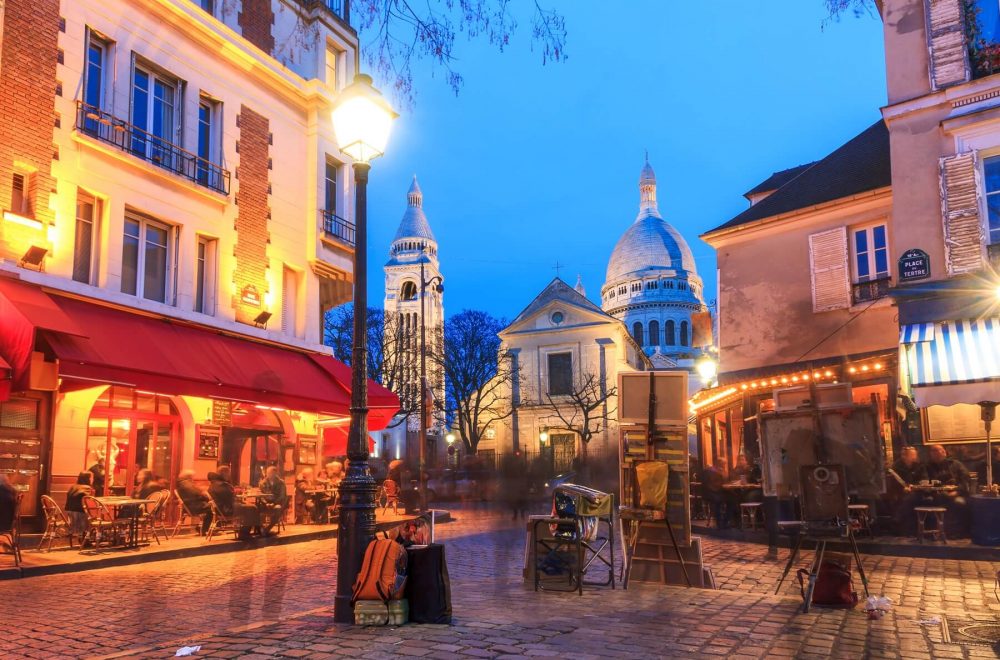
Montmartre Walking Tour
From the moulin rouge to the sacré-cœur in the bohemian heart of paris.
- When 2 PM daily except Tuesday (seasonal schedule)
- Duration 90 minutes
- Meeting Point 5 Place Blanche, in front of Starbucks across from the Moulin Rouge
€36 per adult
Local experts, worry-free booking.
Check Availability
- Meeting Point
- Travel Tips
- Uncover the art and culture of this neighborhood where Van Gogh and Picasso once painted.
- Visit the Place du Tertre, busy with French artists.
- Enjoy views of Paris from Montmartre’s hilltop.
- See the last remaining vineyard in Paris.
- Hear the colorful history of the Moulin Rouge, birthplace of the can-can.
- Pass the Cafe Des 2 Moulins, made famous in the film “Amélie.”
- Learn about Parisian food, from legendary cheeses to charcuterie.
- Discover the beautiful and once controversial Sacré-Cœur Basilica.
- Take our Paris shuttle for convenient transportation, included with your tour.
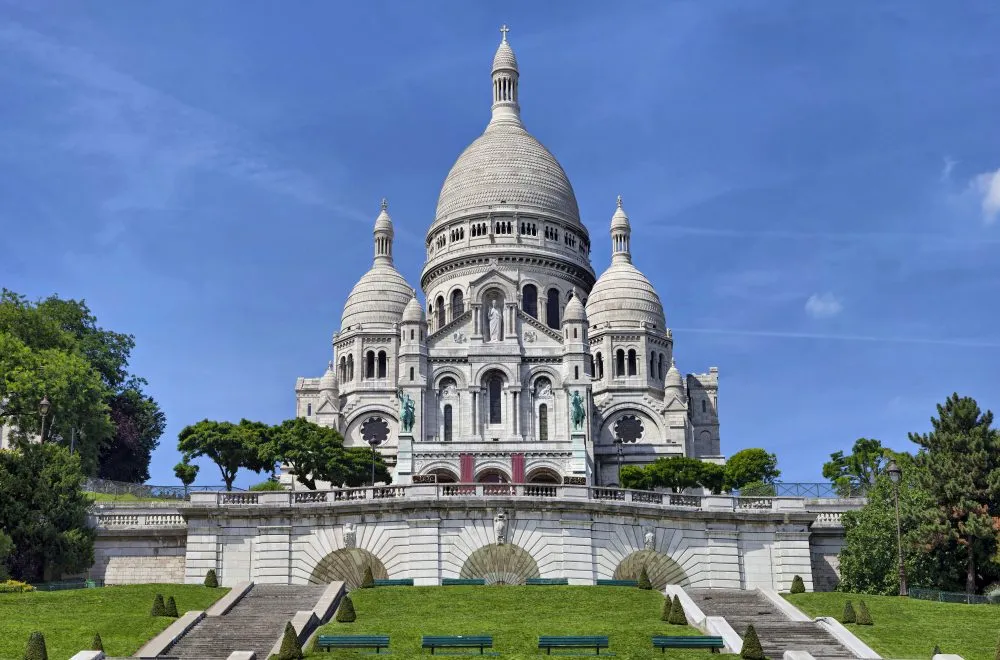
What you'll do
Come discover why Montmartre has inspired artists and dreamers for centuries on this immersive two-hour walking tour. As you walk, your guide will share about the history, food, culture, and art of this vibrant neighborhood where famous painters like Van Gogh once lived and worked.
We’ll begin at the Moulin Rouge , home of the can-can and the one-time haunt of artist Henri de Toulouse-Lautrec. Climb the winding streets and visit sites along the way: the Cafe des 2 Moulins filmed for “Amélie,” the ancient Rue des Abbesses, the last two windmills in Paris. You’ll even see the city’s only vineyard .
Our tour ends at the highest natural point in Paris, the summit of Montmartre. Here, we’ll pause to enjoy the views from the Sacré-Cœur Basilica . Your guide will tell you all about this 19th-century church as you admire its striking architecture. If it’s open, you’re welcome to continue inside and explore on your own. Admission is free.
At the end of our Montmartre Walking Tour, you’ll understand why locals and visitors are captivated by this corner of Paris. It’s truly enchanting.
Montmartre tour itinerary
Moulin rouge.
Home of the can-can, where Toulouse-Lautrec sat nightly and drew some of the best scenes of Paris nightlife
Café des 2 Moulins
Featured in the French film “Amélie”
Rue des Abbesses
One of the most picturesque streets in Montmartre, winding past quaint cafes and following in the footsteps of artists like Van Gogh and Pissaro
Place du Tertre
Famous plaza filled with art, artists, and scenic terraces, the perfect place for a souvenir
Sacré-Coeur
The hilltop basilica with extraordinary architecture inside and out
Make this tour private
Book this tour for just your group.
Plan your trip
Tour ending point.
The tour ends at the Sacré-Coeur Basilica.
Refund policy
We offer a 100% refund up to 24 hours before the start time.
Full Schedule
Montmartre tour reviews.
This tour exceeded our expectations. Audrey is easy going, polite and very knowledgeable. Her enthusiasm for French history and cultural heritage is infectious. Not only do you get to know about Montmartre and the Basilique du Sacré Coeur, but she delves deep in the less touristy details that you rarely can be aware of otherwise. Highly recommended!
Meeting point
Please meet us at 5 Place Blanche, in front of the Starbucks located across from the Moulin Rouge.
Your guide will be holding an orange sign that says “ ExperienceFirst .”
For easier navigation, you can paste this address into Google Maps: 5 Place Blanche, 75009 .
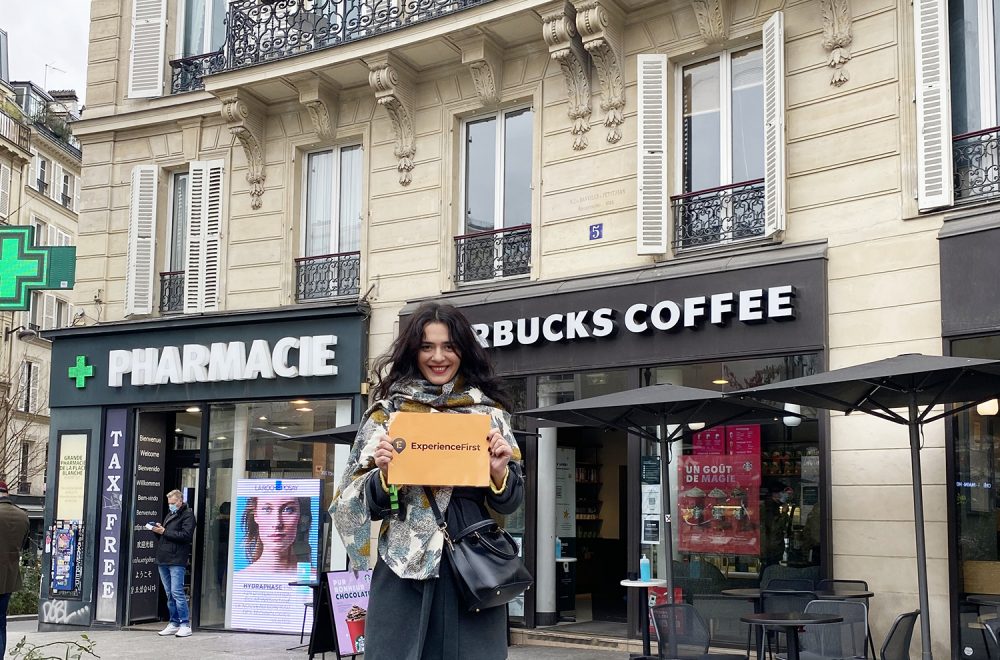
How much walking is there?
It’s about 2 miles of walking uphill at a leisurely pace. There may be short flights of stairs throughout the tour, both up and down. If mobility is an issue, please inquire about a private tour .
Is there food and drink available for purchase during the tour?
Montmartre is a great foodie neighborhood. About halfway through the tour, there’s a short break when you can purchase food or drinks, and when the tour ends, you will be near other cafes and vendors if you want to try something fresh.
Do you go inside the Sacré-Coeur Basilica?
No, the tour ends in front of the basilica. It’s free of charge to enter when open, and your guide will share tips on what to see during your self-guided visit.
What is the rescheduling policy?
We understand plans change. You can always change your tour 24 hours or more before you tour. We offer a 100% refund up to 24 hours prior to your tour start time. Within 24 hours of your tour, we would have incurred hard costs and therefore cannot allow rescheduling or cancellation without costs.
What if it rains?
Our tours run rain or shine, so please check the local forecast to plan. In rare cases when we have to cancel for extreme weather, we’ll offer you the chance to reschedule or give a full refund.
Are gratuities included?
Tips are always appreciated but never expected. They’re a great way to tell your guide they did an awesome job and show your appreciation.
Paris travel guides
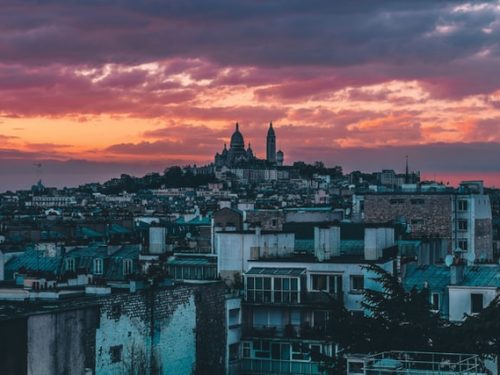
Paris on a Hill: Montmartre, the Sacré-Cœur, and Beyond
Montmartre is the Paris that you came to see. It’s the whimsical, charming neighborhood most often featured in international depictions of Paris. It…
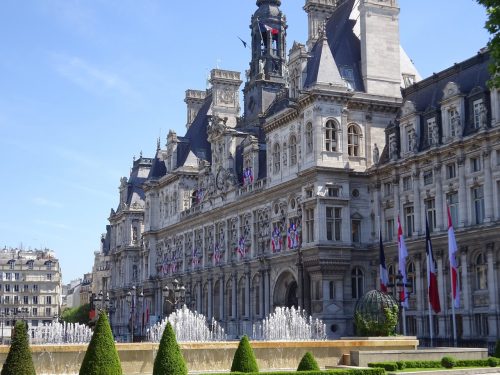
One Day in the Marais: A Paris Itinerary That Has It All
The Marais neighborhood in Paris is welcoming for all. It’s popular among locals, expats, and millennials. It has a vibrant LGBTQ+ culture. And…
More in Paris Previous Next
Notre dame outdoor walking tour with crypt entry.
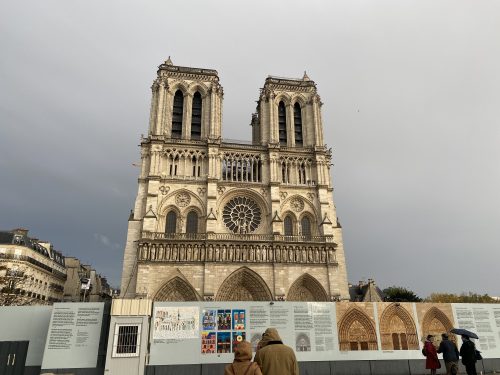
Eiffel Tower Guided Climb
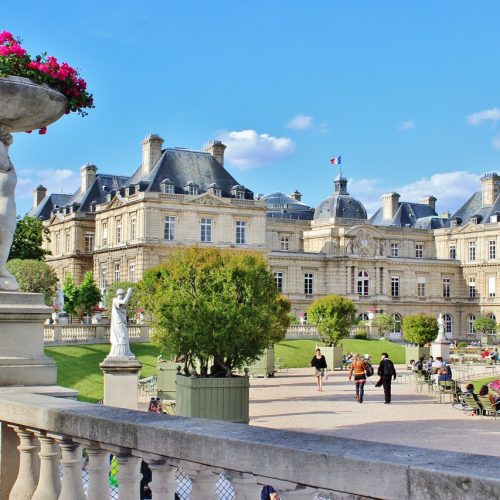
Latin Quarter Walking Tour

What To Do In Montmartre – Paris: Montmartre Itinerary!
By: Author Catrina
Posted on Last updated: February 4, 2024
Categories EUROPE , FRANCE
Heading to Paris – Montmartre in particular, and looking for the perfect itinerary and what to do in Montmartre? You’ve come to the right spot.
Montmartre if my absolute favourite area of Paris and I’ll share with you all the best things to do here!
Most people go to Paris to see the Eiffel Tower or the Louvre. But I go to Paris for Montmartre, Paris’ cutest district located in the 18th Arrondissement of Paris.
It is known as the artistic and bohemian district of Paris, and there is a lot of history in this district.
There are so many things to do and see in Montmartre that are very close to each other, so Montmartre is definitely best explored on foot.

Montmartre is absolutely a neighbourhood of Paris you HAVE to see – even if you only have 24 hours in Paris.
Head into the back streets behind the Moulin Rouge area and you literally step back in time in Montmartre with its small cafés, cobblestone streets and vintage stores.
It has lost none of it’s village charm, and it is hard to believe you are in the centre of Paris! It’s a great place to escape to if you want to get away from the crowds.
This gorgeous artsy hilltop neighbourhood, once covered in windmills (moulins) is like a dream! Full of picturesque streets, Montmartre was an area that inspired many artists such as Picasso, Van Gogh and Renoir.

What To Do In Montmartre – Paris: Montmartre Itinerary
Rue de l’abreuvoir.
The ivy-lined Rue de l’Abreuvoir is a beautiful street in Montmartre that is great for photography. Visit first thing if you want to get photos without people in!

Place Dalida
At the bottom of Rue de l’Abreuvoir is Place Dalida.
Place Dalida is possibly the prettiest square in Paris, where you will usually come across some artists at their easels painting, just like Van Gogh, Picasso, Renoir and Monet, who all lived and painted in Montmartre, would have done.
In Place Dalida you will also see the bronze bust statue of the icon Dalida here, who the square is named after.
Dalida moved from Egypt to Paris, and bought a home in Montmartre where she lived until her death in 1987. She was an important figure in the neighbourhood.
La Maison Rose Cafe
There are plenty of cosy Parisian cafés where you can sit and watch the world go by too. A beautiful place to stop is at the picturesque La Maison Rose at the top of Rue de l’Abreuvoir – a cafe restaurant Picasso frequently visited.
Make sure to visit it, it’s one of the most beautiful buildings in Montmartre and has barely changed at all in the last 100 years!

Le Passe-Muraille
Located on Place Marcel Aymé just around the corner from Rue de l’Abreuvoir is Le Passe-Muraille – a quirky statue of a man stuck in the wall.
The sculpture was inspired by the story written by Marcel Aymé – a writer who was from Montmartre. The story was based on a fictional character who could walk through walls, but after abusing his power he got stuck in a wall.

Square Suzanne Buisson
Opposite Le Passe-Muraille is the Square Suzanne Buisson. It’s a fairly hidden square but it is quite a popular place to visit as the statue of Saint-Denis – the first Bishop of Paris is here.
The statue depicts Saint-Denis beheaded, holding his own head. After being decapitated, it is said Saint-Denis walked kilometres around the area – and at the spot where the statue is, is where he stopped to clean his head.

Avenue Junot
One of the great things about Montmartre is that there are so many backstreets you can wander around and explore the real Paris – without the tourists and the tourist sights.
Avenue Junot, located off Square Suzanne Buisson, is definitely one of those places. Avenue Junot is a very discreet avenue that most tourists don’t even realise it exists, but it is one of the most expensive avenues in the whole of Paris.
Stroll around Avenue Junot and you will find the Hotel Particulier Montmartre – the former residence of the Hermes family that is now an exclusive hotel very popular with celebrities.
If you go for a meal or drink at the hotel, you can even visit Montmartre’s Witches Rock via the Passage de la Sorciere – a passage which is generally inaccessible to the general public.
Right next to Hotel Particulier Montmartre is Villa Leandre is a really beautiful street full of British style houses. Make sure to check out Number 10 – that bears a striking resemblance to No 10 Downing Street!
Sacre Coeur Basilica
The Basilique du Sacré-Coeur (Basilica Of The Sacred Heart) sits on top of Montmartre hill and provides a beautiful view of Paris. This is actually the highest point in Paris and it looks so impressive!
The Basilica Sacre Coeur is considered the symbol of Montmartre. Be sure to visit this stunning basilica, although head there early if you wish to avoid the crowds!
If you go inside the Basilica you can find the access to the dome, which is one of the best viewpoints in Paris!
To reach the dome you will need to climb 300 steps (!) and this is the second highest viewpoint in Paris after the Eiffel Tower.

Moulins (Windmills) Of Montmartre
There are two moulins in Montmartre very close to each other – one is Moulin Blute-Fin, built in 1662 and the other is Moulin de la Galette, built in 1717 – located on 83 Rue Lepic.
These two windmills (‘moulins’) are the only two remaining windmills of the 14 that once stood in Montmartre.
These windmills were originally used to grind flour, but then they became windmills where people came to eat bread with a glass of milk. I
n time, this glass of milk got replaced with a glass of wine and cabarets started happening here.

Van Gogh’s Home
Further down Rue Lepic, on the third floor of number 54 Rue Lepic is the apartment where Van Gogh lived from 1886-1888 with his brother.
From his window here, he painted many paintings of the Paris skyline, windmills, the Montmartre countryside, as well as his many self-portraits.
Vigne Du Clos Montmartre
You might be surprised to find that you can even find a vineyard in Montmartre! The Vigne Du Clos, as it is known, is just down the street from La Maison Rose.
It is one of the last remaining vineyards in Paris and they produce up to 2000 bottles of wine each year from their vines!
Le Clos is closed to the public except for 5 days in October each year – the Grape Harvest Festival, when the vineyard opens its door (make sure to book in advance to visit Le Clos as the Festival is very busy!).
Montmartre Cemetery
Known as The Cemetery Of The Artists, Montmartre Cemetery is the second largest cemetery in Paris and is certainly worth a visit. It is located opposite the Vigne Du Clos.
Montmartre Cemetery is very beautiful, and known for unique and impressive tombs, such as the tomb of Dalida – the singer.
Montmartre Museum
The Museum of Montmartre is a really good place to go to get a deeper understanding of Montmartre.
It is housed in one of the oldest buildings in Montmartre and contains many photographs, posters and paintings that depict how life was in Montmartre back in the day. There is also a scale model of Montmartre here.
You can also visit the Renoir Gardens here (dedicated to the famous French painter) for €5, and the view across the Vigne De Clos is spectacular. In this garden was where Renoir painted ‘ La balançoire ’.
Rue du Chevalier De La Barre
Rue du Chevalier De La Barre is another really picturesque street in Montmartre. It is located very close to Sacre Coeur and is definitely worth a venture down. Stop for a crepe at Au Petit Creux or do some souvenir shopping!

Place Du Tetre
Just around the corner from Rue du Chevalier De La Barre is a beautiful square known as La Place du Tetre.
It is also known as the ‘Artist’s Square’ as it is where many artists like to hang out and paint or draw caricatures, and it is a must-see when in Montmartre.
Many cafes line the historic cobbled square, and whilst it does get crowded, it is definitely worth seeing. If you wish to buy a painting, buy it from the artist and not from the souvenir shops here in the square.
Almost all the paintings in the shops are made in China, even if it says they are painted at La Place Du Tetre.
Le Consulat
Another really Instagrammable place in Montmartre is Le Consulat – a French restaurant known for it’s nostalgic vibe and classic French food. Le Consulat is located on 18 Rue Norvins.
Dali Paris Museum
Not far from Le Consulat is the Dali Paris Museum, located on Rue Poulbot. If you’re a fan of the surrealist Spanish artist, this museum is definitely worth a visit, with over 300 artworks, paintings and sculptures by Salvador Dali.
Visit Moulin Rouge
Head down the hill from Montmartre to the Moulin Rouge to watch the cabaret and famous can-can dance. Tickets are expensive at around €100 per person, but remember this is the birthplace of the French can-can and is probably the most famous cabaret in the world!
Shows are 365 days a year (two shows per night: one at 9pm and one at 11pm), but tickets do sell out extremely fast. The cabaret does feature many topless dancers but is said to be a spectacular show.
If you don’t fancy watching the cabaret, it’s still definitely worth it to come here and view the iconic red windmill from the outside!
The Moulin Rouge is actually located in Pigalle (Paris’ Red Light District) – at 82 Boulevard de Clichy.
The area around Moulin Rouge is a bit of a weird place and although not an unsafe area, it is a bit seedy with many sex shops around.
Of course, it is worth it to come here and see the famous Moulin Rouge even just from the outside, also because it is at the base of Montmartre hill, so you can go on to explore bohemian Montmartre from here.

Au Lapin Agile
If you are still keen to watch the cabaret but can’t afford Moulin Rouge prices, there is a much cheaper cabaret available to watch at Au Lapin Agile, which is located next to Vigne Du Clos at 22 Rue Des Saules.
The cabaret at Au Lapin Agile is actually far more authentic than the cabaret at Moulin Rouge. Opened in 1860 and still in operation today, it is the last 19th Century Cabaret in Paris that celebrates French music.

Free Montmartre Walking Tour from Moulin Rouge
If you want to do a guided tour of Montmartre, there is a really good company I can recommend.
The first time I visited Paris I did a guided tour of Montmartre with discoverwalks.com . The tour was brilliant, with 90 minute tours at 11am starting at Moulin Rouge and finishing at Sacre Coeur.
The tour visits many sights such as Chat Noir, windmills, the home of Dalida, Le Passe-Muraille and the best views of Sacre Coeur – all of which could be quite easy to miss without having a local guide show you around.
This is a free walking tour but the average tip per person is €12.
It is also strongly advised to book online beforehand as there is only a maximum of 16 spaces per day.

Alternatively, check out these tours below:
Best Time To Visit Montmartre
Montmartre is a great place to visit year round, however spring and winter and my favourite seasons to visit.
If you visit during the spring the streets will be covered in beautiful flowers which is really beautiful to see.
And if you visit during winter, Montmartre hosts it’s Christmas market so there is a really special vibe here, especially if it is snowing!
Bear in mind if you visit during August many of the restaurants and shops in Montmartre will be closed.
How To Get To Montmartre
The most convenient way to get to Montmartre is by Metro. Metro Station Blanche on Metro Line 2 takes you to Pigalle (right outside Moulin Rouge) so you can always start here and walk up the hill to Montmartre, or get off at Metro Station Abbesses on Metro Line 12.
Other Places Near Montmartre To Visit
Cafe des deux molins.
Within walking distance of Montmartre is the Cafe des Deux Molins – located at 15 Rue Lepic. Cafe des Deux Molins is another authentic cafe in Paris that is worth a visit.
Cafe des Deux Molins gained popularity for tourists to visit after the 2001 French movie ‘ Le Fabuleux destin d’Amélie Poulain ’ was released and this was the cafe the main character was working in.
This is a great movie to watch before or after your visit to Montmartre, as the majority of the movie is set in Montmartre!
Like this post on What To Do In Montmartre – Paris: Montmartre Itinerary? Pin it for later!
Catrina is a Travel Writer and ex-Flight Attendant based in Sydney, Australia. She has visited 85 countries and lived in several – including Italy, Australia, United Arab Emirates and England. Her work has been featured in a variety of popular travel publications including Fodors, Escape, Australian Traveller and Bear Grylls, as well as several international aviation and travel companies. She only writes about places she has personally visited, and aims to give real, honest advice to help her readers.

IMAGES
VIDEO
COMMENTS
Begin your self-guided walking tour of Paris at the Parvis du Sacré-Coeur, the gateway to Montmartre. You can reach the Parvis du Sacré-Coeur via a number of different routes. The nearest metro station is Anvers (line 2 blue) and you can walk up the numerous steps from the Carousel, up to the Sacré-Coeur. Just be sure to bring some water and ...
In this guide to Montmartre, I cover the history as well as the little villages/streets that make Montmartre truly special. The walking tour of Montmartre should take about 2 hours. The total distance covered is 4 kilometers (2.5 miles). Warning: Not all of these locations are public property, so ask permission before you go inside.
Read on for my recommendations - I have a great self-guided walking tour itinerary for you! With its cobblestone streets and artistic legacy, Montmartre, the hilltop neighborhood in the north part of Paris, almost feels like an escape from the city hustle and bustle. ... essentially functioning as a self-guided walking tour of Montmartre. 1 ...
A self-guided walking tour of Montmartre. Rue de l'Abreuvoir. Start your Montmartre self-guided walking tour at Blanche Métro station, which is on Line 2 (or you could also take the Métro to nearby Pigalle on Line 12 which is only a five-minute walk along the Boulevard de Clichy). From there, walk up Rue Lepic - you'll see the colourful ...
Walking Tour of Montmartre - Itinerary. 1. The Secret of Sacré-Coeur's Eternal Beauty. The Basilica of the Sacré-Coeur, located at the top of Montmartre Hill in Paris, is a major religious building built at the end of the 19th century. With more than ten million pilgrims and visitors per year (in 2006), it is the second most visited ...
This is the most expensive option in this section, but they also have the smallest group sizes and tend to attract a more mature clientele. Paris: Montmartre 2-Hour Walking Tour. Departs Wednesdays and Fridays at 10:00 am, and Sunday, Monday, and Thursday at 15:00 (3 pm) €25 per person.
1. Start: Anvers To Sacré-Cœur. Our walking tour of Montmartre starts at Anvers Metro station because it is the closest Metro to the most spectacular landmark in Montmartre, Sacré-Cœur. Anvers station has one of those classic Art Nouveau Metro entrances, so the first thing you do might be to admire that for a moment.
Self-Guided Walking Tour of Montmartre, Step-by-Step Itinerary. Begin at the Lamarck-Caulaincourt Metro. Begin walking up and pass the Saint-Vincent Cemetery on the way to Cabaret Au Lapin Agile, the oldest bar-cabaret in Paris. Continue on Rue des Saules to Vigne du Clos Montmartre, the last working vineyard in Paris.
Break away from the congestion of downtown Paris and enjoy a self-guided walking tour of Montmartre - which includes Sacre Coeur and Moulin Rouge. The trail outlined above is roughly three miles. It begins at the Anvers metro stop along the No. 2 line and stops back at the same metro stop. While three miles doesn't seem long, you'll still ...
14 La Rochelle. 15 Colmar. 16 Toulouse. 17 Grasse. 18 Epernay. 19 Dijon. 20 Giverny. Explore the Bohemian district of Paris on a small group guided walking trip in Montmartre. Check out the Sacré-Cœur basilica, stroll along winding streets, pass Place du Tertre and other landmarks.
Highlights. Experience the rich culture of Montmartre with your charming and entertaining English-speaking guide. Hear the colorful history of the famous and iconic Moulin Rouge. Walk the scenic, cobble-stoned streets where Van Gogh and Picasso lived and painted. Visit the world famous Sacre-Coeur Basilica and enjoy a panoramic view of Paris below.
Know before you go. You will be joining our general 'pay what you wish' tour (it is up to you to decide about the amount of payment to the guide). Price you pay now is only a small online booking fee. This tour will take place rain or shine, but in case it rains or gets cold, we find cover. From $24.09 per person.
Table of Contents. One Day in Montmartre: Map. One Day in Montmartre: The Complete Itinerary. Step 1- The Wall of Love (Le Mur des 'Je t'aime') Step 2- Place Emile Goudeau & Bateau Lavoir. Step 3- Café des Deux Moulins. Step 4- Montmartre Cemetery. Step 5- Van Gogh's House.
On our award-winning free walking tour of Montmartre, we show you the nooks and crannies of the most Bohemian and artistic district of Paris, the center of good-living and once the home of Renoir, Picasso, Edith Piaf and so many others. At Discover Walks, we take pride in giving you an authentic, intimate tour. This means your group will be ...
Self-Guided Montmartre Walking Tour Itinerary. Only have time for a short visit and want to enjoy as many of the best things to do in Montmartre as possible? Here's a quick Montmartre walking route that we have enjoyed variations of many times! Starting from the Anvers metro stop, head up Rue de Steinkerque until you reach Place Saint-Pierre ...
This tour runs everyday: Monday to Sunday. Clock. Start Time: 3:30 pm (1 Nov - 31 March) / 5:00 pm (1 April - 31 Oct) Info. Additional Information: Please note that Saint Pierre de Montmartre remains closed on Mondays. Map Marker.
Raised in Egypt by Italian parents, Dalida came to Paris during the 1950's to launch her career. In 1962, she purchased an apartment in Montmartre at 11 rue d'Orchampt. You can still view its little balcony today. Although Dalida is a celebrated musician and known for fun disco songs, she struggled personally.
Full description. Explore one of the most picturesque areas of Paris on a 2-hour walking tour through Montmartre, starting with the legendary cabaret theater of the Moulin Rouge, located in the city's Red Light District. Watch artists at work in charming Place du Tertre, a reminder of the time when Montmartre was a true artists' quarter.
Come discover why Montmartre has inspired artists and dreamers for centuries on this immersive two-hour walking tour. As you walk, your guide will share about the history, food, culture, and art of this vibrant neighborhood where famous painters like Van Gogh once lived and worked.. We'll begin at the Moulin Rouge, home of the can-can and the one-time haunt of artist Henri de Toulouse-Lautrec.
Free Montmartre Walking Tour from Moulin Rouge. If you want to do a guided tour of Montmartre, there is a really good company I can recommend. The first time I visited Paris I did a guided tour of Montmartre with discoverwalks.com. The tour was brilliant, with 90 minute tours at 11am starting at Moulin Rouge and finishing at Sacre Coeur.
Meeting Point + Tour Duration. Meeting Point Options: Rail or Bus Station, Monument/Building, Suggested by Guide: At the metro station "Blanche". Duration: 2 hours 30 min. Transportation. It is a walking tour. Put on your most comfortable pair of shoes :) What's Included. Guiding Services; Estimated Local Cash Needed. 40 euros - Food, drinks ...
Discover the bohemian charm of Montmartre on a guided walking tour. See the iconic Moulin Rouge, the Sacré-Cœur Basilica, and the Place du Tertre. Enjoy a delicious meal at a local bistro. ... Itinerary. Starting location: Blanche. Moulin Rouge. Photo stop, Visit, Guided tour (15 minutes) Main stop. For reference only. Itineraries are subject ...
Full description. GERMAN TOURS: Tuesday 4pm, Thursday 4pm, Saturday 3pm, Sunday 2pm and ENGLISH TOURS: Monday 3pm, Wednesday 3pm, Saturday 5pm, With your tour guide, explore the world-famous bohemian neighborhood of Paris: Montmartre. Situated at the highest point in the city, this district was home to countless famous artists throughout history.